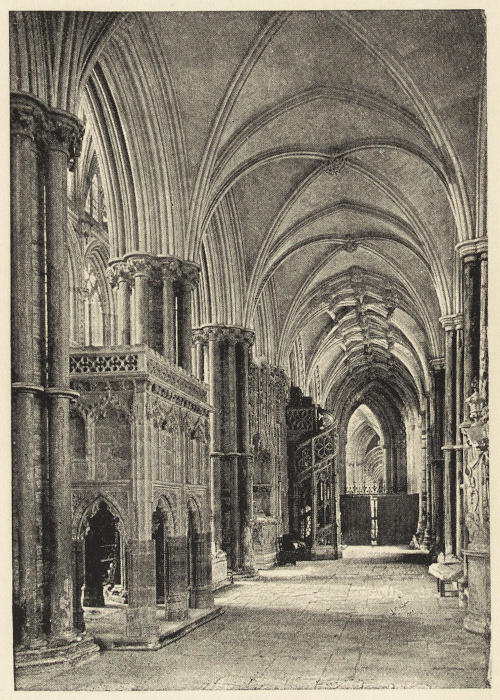
ELY: NORTH AISLE OF CHOIR.
Title: English Cathedrals Illustrated
Author: Francis Bond
Release date: November 14, 2020 [eBook #63739]
Most recently updated: October 18, 2024
Language: English
Credits: E-text prepared by Sonya Schermann and the Online Distributed Proofreading Team (https://www.pgdp.net) from page images generously made available by Internet Archive (https://archive.org)
The Project Gutenberg eBook, English Cathedrals Illustrated, by Francis Bond
| Note: | Images of the original pages are available through Internet Archive. See https://archive.org/details/gri_33125014518423 |

ELY: NORTH AISLE OF CHOIR.
BY
FRANCIS BOND
M.A., F.G.S., Hon. A.R.I.B.A.
SECOND AND REVISED EDITION
ONE HUNDRED AND EIGHTY ILLUSTRATIONS FROM PHOTOGRAPHS
London
GEORGE NEWNES, LIMITED
SOUTHAMPTON STREET, STRAND
1900
PRINTED BY
HAZELL, WATSON, AND VINEY, LD.,
LONDON AND AYLESBURY.
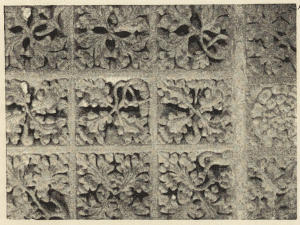
SOUTHWELL CHOIR SCREEN.
The following pages are an attempt to make the study of the English cathedrals more interesting. Every ancient building has a life-history of its own, and should be studied biographically. But open a guide-book, or visit the different portions of a cathedral (Winchester, for example,) in the regulation order, and what you read of or see will probably be, first, what was done in the nave in the latter part of the fourteenth and in the fifteenth century; then the work done in the crossing in the twelfth century; then work done in the transepts in the eleventh century; then the work in the choir in the first half of the fourteenth century; then the work done in the retro-choir early in the thirteenth century; finally, sixteenth-century work in the Lady chapel. To the reader this hop, skip, and jump method—if it deserves to be called a method—is simply maddening. For the visitor it has one merit, and one merit only: it saves his legs. I do not propose to save the visitor’s legs; I must candidly confess that the biographical method[vi] of studying a cathedral involves a certain amount of marching and countermarching. But I venture to hope that there are some visitors who will not be deterred by a little additional bodily fatigue from studying the cathedrals aright. With what horror a reader would study a biography of the Great Duke which commenced with the Peninsular War, then described his school-days at Eton, followed these up by the battle of Waterloo, digressed into a description of his childhood and ancestry, described his career as a Tory Prime Minister, and wound up with his campaigns in India! Yet that is how the English cathedrals are studied.
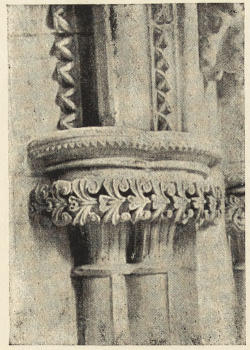
SOUTHWELL CHOIR.
But it is not sufficient to study the different parts of a cathedral in chronological order. It would be a dull biography of a man, and a dull history of a people, which put events correctly in chronological order, but did not point out the causal connection between them. It is just when we reach this point that the real interest begins. It does not interest one much to hear that an acquaintance whom we saw in London in the spring is now in the Australian bush: it does interest one when one hears that he had to leave the country because three months ago he was detected cheating at cards. So, in a cathedral, it is not enough to know that such a vault was put up or such a row of windows inserted in the fifteenth century. We want to know why the cathedral people constructed the vault or the windows just then; also, why they were[vii] not satisfied with what was there before; also, what was there before. And with the latter query comes in a fine field of action for what I believe is called the “constructive imagination.”
On the motives which influenced mediæval builders I have laid considerable stress throughout the book, simply because, if it has occurred at all to writers to ask why such and such a change was made, the answer usually has been—I quote from an article on one of the cathedrals—“simply a desire for what was thought a far superior kind of beauty led to the alteration of this work”: i.e., the Gothic builders were æsthetic dilettanti, striving after prettiness for prettiness’ sake; on a level with painters and poets and musicians. Now, some changes were due, I admit, to æsthetic considerations simply: e.g., the substitution of the present choir for the former Transitional choir at York; so also one of every pair of towers at the west end of a cathedral; and every spire in the country.
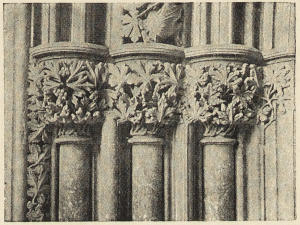
SOUTHWELL CHAPTER-HOUSE.
But the more the history of the cathedrals is studied, the more clearly it will be seen that the great majority of the alterations in the structure were forced on the ecclesiastical authorities of the day by practical considerations.
The monastery was large, as at Canterbury, and the church the seat of an archbishop; Lanfranc’s short choir had to be replaced by a longer one.
Saint-worship increased; pilgrimages increased; pilgrims[viii] came in thousands and tens of thousands. They could not be accommodated in the crypts as before: room had to be found on the floor of the choir for shrines transferred from the crypt; and aisles had to be constructed round the shrines, that there might be a free passage, and no dangerous block in the stream of pilgrims. For the local Saint—the St. Thomas of Canterbury, the St. Hugh of Lincoln—accommodation on a vast scale had to be provided. But beside the local saints, there were the great saints of the Church; for them special chapels, with altars, had to be provided, either in a new eastern transept or in aisles added to the central transept. There was, moreover, especially in the first half of the thirteenth century, a great outburst of Mariolatry. For these reasons, then—what we may call ritualistic reasons—vast eastern extensions were made in nearly every cathedral.
But the original Norman cathedrals were not only small and inconvenient to the east, but they were throughout very badly lighted; a very large amount of history, as I have tried to point out in speaking of Gloucester, Hereford, and Norwich, consists of attempts to improve the lighting of the cathedral. Sometimes, indeed, the improvement took the shape of total destruction of the old gloomy church, and its replacement by a brilliantly illuminated successor, as at York. Connected with this was the mania for an increased acreage of stained glass—an æsthetic motive which, however, had its practical side; the stained glass justifying itself to the monks and canons as providing a series of lessons in Scripture history or Church history.
Many changes were due to damage from fire or storm, or to jerry-building. The clerestory of Norwich had to be rebuilt because it had been crushed by the fall of the spire. The Norwich monks were driven to fireproof the whole church, because fires in 1463 and 1509 showed them the necessity of it, by burning down successively the wooden roofs, first of the nave and choir, then of the transept. I[ix] am sure that if our documentary evidence were not so deplorably incomplete, we should find that very many other alterations were due to the effect of fire and tempest: in which case the list of æsthetic changes would be yet further cut down—e.g., we might find after all that York choir had to be rebuilt for some purely matter-of-fact reason.
Add to these causes the frequent collapses due to mediæval jerry-building, both Norman and Gothic. Many central towers collapsed—e.g., at Winchester, Ripon, Wells, Ely, Peterborough, Lincoln; and doubtless there were collapses of many others, of which we have no record. Hence, for example, the fourteenth-century choir of Ely. Whole sections of a cathedral tumbled down—e.g., in St. Alban’s nave. The early masonry was but skin-deep; inside the thin casing of masonry the core of piers and walls alike had crumbled into powder; foundations were insufficient, or were simply omitted. The object was, but too often, not to build soundly, but to build a bigger church than the rival over the way, and to hurry it up as quickly as possible. Hence the shocking building done by the Peterborough people in their rivalry with Ely.
A considerable amount of space has been devoted to what is called the ichnography of the cathedrals—their ground-plans. It has not been possible to insert plans in the book; it seemed hardly desirable to do so. The Builder has published valuable plans, on a large scale, of all the cathedrals; they can be obtained separately, with the accompanying letterpress and illustrations. The student should never visit a cathedral without one of these plans. (I may add that he should always have a binocular to study the detail, much of which—e.g., the bosses—is quite out of the reach of the unaided eye.)
As regards the nomenclature of the parts of a cathedral, it may be useful to mention that the high altar is to the east; and that, facing the east, the visitor has the south[x] transept and south aisles on his right, and the north transept and north aisles on his left hand. Standing at the altar or the choir-screen, and looking down the nave to the great doors, he has the north transept and north aisle of the nave on his right, and the south transept and south aisle of the nave on his left.
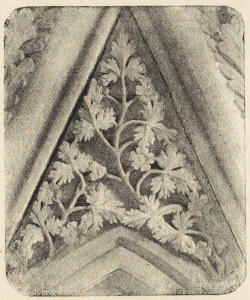
SOUTHWELL CHAPTER-HOUSE.
The western limb of the cathedral is called the nave. The term “choir” is sometimes loosely applied to the whole of the eastern limb. Strictly it applies just to that part of the church where the stalls are; and that part, as in St. Alban’s and Norwich, need not necessarily be in the eastern limb at all, but in the crossing and in the easternmost bays of the nave.
In a cathedral with a fully-developed plan,—e.g., St. Alban’s or Winchester—the following ritualistic divisions will be met with in passing from west to east:—(1) The nave; (2) the choir; (3) the sanctuary; (4) the retro-choir, containing (a) processional aisle, (b) Saint’s chapel, (c) ante-chapel or vestibule to the Lady chapel; (5) Lady chapel. Sometimes these ritualistic divisions correspond with the architectural divisions of the church; sometimes they do not: e.g., the ritualistic divisions of the eastern limbs of York and Lincoln were not shown in the structure, but merely marked off by screens, most of which have been destroyed.
Much time and trouble have been spent in the endeavour to correct the current chronology of the cathedrals. The subject is a difficult one; suffice it to say that I have relied[xi] rather on architectural than on documentary evidence. “In the earlier days of archæological study the tendency was to discredit the former and to accept the latter; in these days the results of strict analytical investigation and comparison of the minor details of the buildings of the Middle Ages dispose us to place much more reliance upon this species of internal evidence than on even the most unequivocal assertions of ecclesiastical historians.” The inductive reasoning based on the former is safer than the possibly hearsay or downright mendacious testimony of the latter. In all cases, however, where I have departed from an accepted chronology, I have given my reasons: e.g., in the chapters on Hereford and Wells.
As a rule, I have refrained from describing architectural detail. The visitor to the cathedral does not need the description; the reader does not need it, if he has an illustration before him; if he has not, no amount of verbiage will make clear to him what, for instance, a bay of the Angel triforium of Lincoln is like.
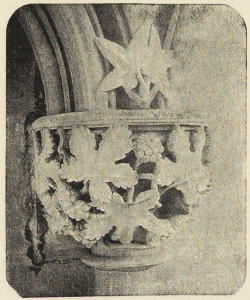
SOUTHWELL CHAPTER-HOUSE.
On the other hand, I have ventured on perilous ground in attempting to criticise design. Where the old builders seem to me to have done bad design, I have not scrupled to say so. Indiscriminate admiration of old work is as bad as indiscriminate censure of new work: both are fatal to the training of a right perceptive faculty. The student of design must compare and weigh and judge; he must not be misled by local enthusiasm to put[xii] St. Hugh’s choir at Lincoln on the level of Ely presbytery, or York nave on the level of that of Exeter. I may add that I have laid more stress than, perhaps, is usual, on proportion, as a leading factor in architectural effect.
I have followed the convenient custom of ascribing the design of different parts of the cathedrals to various bishops and abbots and priors. Such names, however, are merely convenient chronological fixtures, not intended to signify that the dignitaries of the church personally designed and erected them, but simply that they were in office when the work was done.
On the vexed question of architect v. master-mason, I may say that, just as I find it easier to believe in one Homer than in many Homers, so, in contemplating such a poem in stone as the west front of Peterborough or the retro-choir of Wells, I find it easier to believe in one inspired architect than in a crowd of inspired clerks of the works.
I have gratefully to acknowledge my obligations to the “Cathedral Handbooks” of Mr. John Murray, and to the Builder series of cathedrals; and to the brilliant word-painting of Mrs. Van Rensselaer in her “Handbook of Twelve English Cathedrals.”
All the English cathedrals have been studied on the spot; but I had the misfortune to lose the whole of my notes and the greater part of the completed MS., so that the work must be less accurate than I had hoped. Complete accuracy, however, is impossible in dealing with a subject so vast. It is impossible even to know a single cathedral. As has been finely said by Mr. Fergusson: “Not only is there built into a mediæval cathedral the accumulated thought of all the men who had occupied themselves with building during the preceding centuries, but you have the dream and aspiration of the bishop, abbot, or clergy for whom it was designed; the master-mason’s skilled construction; the work of the carver, the painter, the glazier, the host of men who, each in his own craft, knew all that had been done before them, and[xiii] had spent their lives in struggling to surpass the works of their forefathers. It is more than this: there is not one shaft, one moulding, one carving, not one chisel-mark in such a building, that was not designed specially for the place where it is found, and which was not the best that the experience of the age could invent for the purposes to which it is applied; nothing was borrowed; and nothing that was designed for one purpose was used for another. A thought or a motive peeps out through every joint; you may wander in such a building for weeks or for months together, and never know it all.”
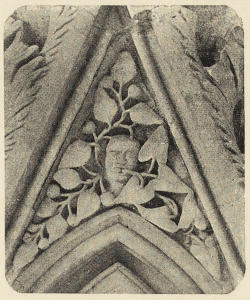
SOUTHWELL CHAPTER-HOUSE.
I trust that this attempt to open the way to understand and enjoy more fully the highest achievement of the English race in any branch of art—our mediæval architecture—may be helpful not only to English students, but to our American cousins also, who—so the vergers assure me—are the best-informed and most appreciative visitors to our cathedrals.
The initials which appear at the foot of the various illustrations indicate the names of the photographers whose negatives have been used. Thus:—B. and S.B. = S. B. Bolas & Co.; B. & Co. = J. Bulbeck & Co.; P. = The Photochrom Co.; W. = F. Wetherman & Co., Ltd.; R. = Rock Bros., Ltd.; A.F. = Mr. Arnold Fairbairns.
Thirteen Cathedrals of the Old Foundation (Pre-Conquest).—Bangor, Chichester, Exeter, Hereford, Lichfield, Lincoln, Llandaff, London, St. Asaph, St. David’s, Salisbury, Wells, York. These were served by secular canons. Not being served by monks, they required none of the monastic buildings, except the chapter-house. Some, however, have cloisters. The establishments of these cathedrals were not suppressed, as were other ecclesiastic colleges, at the Reformation.
Thirteen Cathedrals of the New Foundation.—
(a) Pre-Reformation Sees. Seven cathedrals attached to Benedictine monasteries—viz., Canterbury, Durham, Ely, Norwich, Rochester, Winchester, Worcester; one, Carlisle, attached to a house of Augustinian canons.
(b) Sees founded by Henry VIII., who converted into cathedrals three Benedictine churches—viz., Chester, Gloucester, and Peterborough; and two Augustinian churches—viz., Bristol and Oxford.
All the above thirteen churches ceased at the Reformation to be served by monks or regular canons, and received a new foundation of dean and secular canons.
Eight Victorian Cathedrals.—Liverpool, Manchester, Newcastle, Ripon, St. Albans, Southwell, Truro, Wakefield.
Eleven Churches of Benedictine Monks.—Canterbury, Chester, Durham, Ely, Gloucester, Norwich, Peterborough, Rochester, Winchester, Worcester, St. Albans.
Four Churches of Regular Canons of the Augustinian Order.—Bristol, Carlisle, Oxford, Ripon.
Two Collegiate Churches of Secular Canons.—Manchester, Southwell.
Four Parochial Churches.—Liverpool, Newcastle, Truro, Wakefield.
| PAGE | |
| Bristol | 1 |
| The Cathedral Church of the Holy Trinity. | |
| Canterbury | 10 |
| The Cathedral of Christ Church. | |
| Carlisle | 25 |
| The Cathedral Church of the Holy Trinity. | |
| Chester | 31 |
| The Cathedral Church of Christ and the Blessed Virgin. | |
| Chichester | 42 |
| The Cathedral Church of the Holy Trinity. | |
| Durham | 51 |
| The Cathedral Church of St. Cuthbert and St. Mary. | |
| Ely | 64 |
| The Cathedral Church of St. Ethelreda. | |
| Exeter | 76 |
| The Cathedral Church of St. Peter. | |
| Gloucester | 94 |
| The Cathedral Church of St. Peter.[xviii] | |
| Hereford | 109 |
| The Cathedral Church of St. Mary and St. Ethelbert. | |
| Lichfield | 120 |
| The Cathedral Church of St. Chad and St. Mary. | |
| Lincoln | 133 |
| The Cathedral Church of St. Mary. | |
| London | 148 |
| The Cathedral Church of St. Paul. | |
| Norwich | 159 |
| The Cathedral Church of the Holy Trinity. | |
| Oxford | 160 |
| The Cathedral Church of Christ. | |
| Peterborough | 178 |
| The Cathedral Church of St. Peter. | |
| Ripon | 189 |
| The Cathedral Church of St. Peter and St. Wilfrid. | |
| Rochester | 198 |
| The Cathedral Church of St. Andrew. | |
| St. Albans | 206 |
| The Cathedral Church of St. Alban. | |
| Salisbury | 218 |
| The Cathedral Church of St. Mary. | |
| Southwell | 234 |
| The Cathedral Church of St. Mary.[xix] | |
| Wells | 245 |
| The Cathedral Church of St. Andrew. | |
| Winchester | 260 |
| The Cathedral Church of the Holy and Indivisible Trinity. | |
| Worcester | 275 |
| The Cathedral Church of Christ and the Blessed Mary the Virgin of Worcester. | |
| York | 283 |
| The Cathedral Church of St. Peter. | |
| Victorian Cathedrals: Liverpool—Manchester—Newcastle—Truro—Wakefield | 296 |
| The Welsh Cathedrals: Bangor—Llandaff—St. Asaph’s—St. David’s | 301 |
| Glossary | 310 |
| 1. | Anglo-Saxon, 680-1100 | ⎞ | Primitive Romanesque. | ||
| 2. | Early Norman, 1060-1100 | ⎠ | |||
| 3. | Late Norman, 1100-1145 | ⎞ | Romanesque. | ||
| 4. | Transitional, 1145-1190 | ⎠ | |||
| 5. | Lancet, 1190-1245 | ⎞ | Early | ⎞ | Gothic. |
| 6. | Early Geometrical, 1245-1280 | ⎟ | ⎟ | ||
| 7. | Late Geometrical, 1280-1315 | ⎠ | ⎟ | ||
| 8. | Curvilinear, 1315-1360 | ⎞ | Late | ⎟ | |
| 9. | Perpendicular, 1360-1485 | ⎟ | ⎟ | ||
| 10. | Tudor, 1485-1660 | ⎠ | ⎠ |
The above classification is, in the main, that of Mr. Sharpe’s “Seven Periods of English Architecture.”
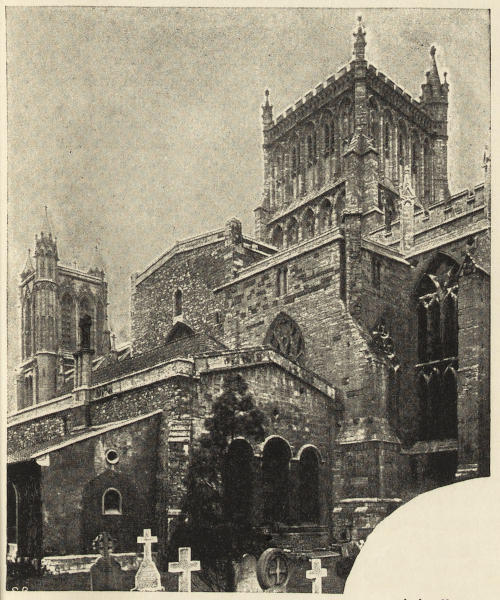
Bristol Cathedral was originally a church of the Regular Canons of the Augustinian Order, who settled at Bristol in 1142. In 1542, like the Augustinian[2] churches of Carlisle and Oxford, it became a cathedral. In 1836 the see was united to that of Gloucester: it has recently resumed its independent status.
I. Late Norman.—The choir and transepts of the cathedral were almost wholly rebuilt in the fourteenth century; but here and there the original work of the founder, Robert Fitzhardinge, survives. This includes (1) the end wall of the south transept, which contains a doorway, afterwards blocked up, when the south aisle of the Norman nave was constructed with a doorway into it from the north-east corner of the cloister. Inside the transept is a Norman cushion-corbel, supporting a later Perpendicular capital. (2) Outside the south transept are flat pilaster buttresses at the angles; the set-off of the ancient parapet; and a plain gable window, set in a rough wall, on which may be seen the weathering of the original steep roof. (3) The coursed masonry below the big window of the north transept. (4) The lower part of the tower-piers; for their Perpendicular mouldings, as in the earlier remodelling of Winchester nave, are such as could be developed out of a Norman compound pier. (5) The corbels in the staircase on the north side of the choir. (6) The gatehouse to the Abbot’s lodgings.
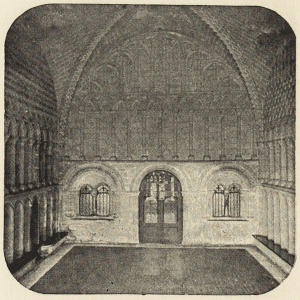
THE CHAPTER-HOUSE.
II. Transitional.—About 1145 innovations began to be made in Anglo-Norman Romanesque. Among other things the pointed arch was introduced; at first chiefly in arches supporting central towers or vaults. In 1155 the founder received a grant of the forfeited estates of Roger de Berkeley; and, owing to this vast accession of wealth, was able to finish his Norman and Transitional work with exceptional richness. (1) In the Vestibule to the Chapter-house, the bays being oblong, pointed arches were used on the short sides of each bay, so that their crowns might rise to the same height as those of the semicircular arches on the longer sides, as the builders thought was demanded by the requirements of vaulting. In the same way, beneath the central towers of Oxford Cathedral and Bolton Priory, pointed[3] arches were built over the narrow transepts; while over the broader nave and choir the semicircular arch was employed. (2) The Chapter-house, as in most monastic establishments, e.g., Gloucester, Canterbury, Oxford, Chester, was oblong; the more beautiful polygonal form being more in favour in cathedrals served by Secular Canons. It was originally 71 by 25 feet. The vast scale of these conventual arrangements, here and elsewhere, is exceedingly striking. The monks of St. Albans thought that their church required a nave 300 feet long; the six canons of Bristol must have been lost in a Chapter-house 71 feet long. The recessed arcades round the walls here and at Worcester are interesting; simple as they are, they are the germs of the beautiful arcades of canopied niches round the Chapter-houses of York and Wells and the Lady Chapel of Ely. Here is preserved a fine piece of archaic sculpture (see Chichester). (3) Exceedingly rich, too, is the lower part of the Great Gateway in College Green; “its courses, however, are nearly double the height of Norman masonry; the hood-moulds of all the arches are perpendicular, and at the crown of each arch are mitred into a perpendicular string-course; which, with the high finish of the ornament, points to the gateway having been wholly rebuilt in Perpendicular times”; in which case, like the eastern bay of the triforium of Rochester, it is an early[4] example of “architectural forgery.” Fitzhardinge’s nave and aisles seem to have been pulled down in the sixteenth century with a view to rebuilding; which, however, was not carried out till 1877.
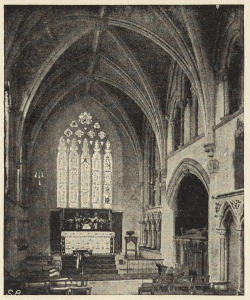
ELDER LADY CHAPEL.
III. Lancet.—Early in the thirteenth century a beautiful Lady chapel was built, projecting eastward from the north transept, and separated by a few feet from the north wall of the choir. The same position was adopted later for the Lady chapels of Peterborough and Ely. This chapel is the artistic gem of the cathedral; it is surrounded by arcades of the greatest beauty, with sculptured grotesques interspersed among the foliage that remind one of the rich sculptured work in the retro-choir of Worcester, which is possibly a few years earlier. Later on it received the name of the elder Lady chapel; another Lady chapel having been built in the more normal position at the extreme east of the choir.
IV. Fitzhardinge’s cathedral, supplemented by the Lady chapel, seems to have satisfied the Canons very well for the first half of the thirteenth century. But in the Early Geometrical period (1245-1280), preparations were made to improve the lighting of the north transept by the insertion of a big window in its north wall. The tracery of the present window is later; but its inner jambs, mouldings and shafts, and the external sill and string, as well as a great part of the[5] buttresses, seem to have been executed c. 1250. About this date is the fine doorway, with a cleverly-contrived lintel, at the south end of the east walk of the Cloister.
V. In the Middle of the Geometrical period, c. 1280, the east end of the Lady chapel was rebuilt, and a window with Geometrical tracery inserted; the tracery is of early character, containing nothing but foliated circles. At the same time it received a simple quadripartite vault; and to resist the thrust of this vault, the northern buttresses were reconstructed and weighted with pinnacles. Of these pinnacles only one, at the north-east corner, remains; the others seem to have been reconstructed at the time when the pinnacles of the choir were built.
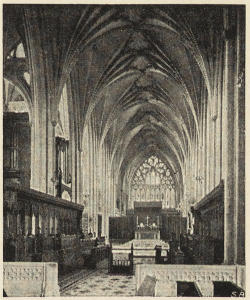
CHOIR.
VI. Curvilinear.—But the great building period at Bristol was between 1315 and 1349—that short but brilliant period when English mediæval design was at its best—which culminated in the Octagon and Lady chapel of Ely, the choir-screens of Southwell and Lincoln, and the Percy monument at Beverley. Everything east of the nave was pulled down and rebuilt de novo. And a very remarkable design it is; in fact, quite unique among our cathedrals. All other cathedral authorities had agreed long ago that the cardinal fault in all Romanesque design was its bad system of lighting, but that the remedy was to be found mainly in improving[6] the top-lighting—i.e., in increasing the dimensions of the clerestory. Beverley clerestory had taller windows than Durham; Salisbury clerestory had three windows for every one of Beverley; Exeter spread out its windows in increasing breadth till they touched the buttresses on either side; the clerestories of the choir of Gloucester, now in course of erection, were a vast, lofty, continuous sheet of glass. But there was an alternative system of improving the lighting, which in many large churches, such as Grantham, Ledbury, and Leominster, was the result of fortuitous growth, but which in the choir of the Temple Church, London, and in Patrington Church now in course of erection, was the result of deliberate design. It was to magnify the aisles at the expense of the nave, to lift them up so high that windows of vast height could be placed in their walls, to dispense with a clerestory altogether, and to give to the pier-arcade of the nave the additional height gained by the suppression of the clerestory. It was to substitute side-lighting for top-lighting; to rely exclusively on the flood of light passing from vast, lofty aisle windows into the nave through its elevated arches. Hence the big windows of Bristol choir, each representing a pair of windows; the lower half the usual small window of an aisle, the upper half the larger window stolen from the clerestory.
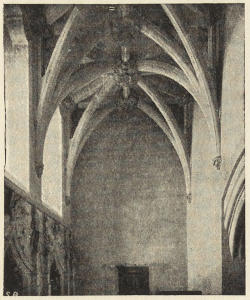
BERKELEY CHAPEL.
But the new design had another merit, which probably weighed still more with the Bristol builders. The cardinal difficulty of the mediæval builders was how to keep up on the top of lofty clerestory walls a heavy stone vault which was always striving to push them asunder. They succeeded at length in keeping the clerestory walls from being thrust out by propping them up with flying-buttresses, perilously exposed, however, to all the vicissitudes of English weather. But there was another solution of the problem, which had been worked out in the thirteenth century in the Temple Church, and in the twelfth century in many a church in central and southern France, such as the old cathedral of Carcassonne. It was to stop the outward thrusts of the nave vault not by the inert resistance of buttress, pinnacle, and flying-buttress, but by bringing into play opposing thrusts—i.e., the inward thrusts of vaults built over the aisles. But to make these outward and inward thrusts balance and neutralise one another, the aisle vaults must be of pretty much the same height and span as those of the nave. The nave must be lowered or the aisles must be raised, or both. At Bristol the architect has preferred to raise the aisles. Then, the stability of the nave vault being secured, all the builder has to do is to stop the outward thrusts of the vaults of the aisles. This it is easy enough to do by a row of buttresses weighted with pinnacles. So Bristol Cathedral, to eyes accustomed to[8] contemporary cathedrals, presents the strange solecism of having neither clerestory nor flying-buttresses. The whole design may well have been based on that of the English cathedral at Poitiers.
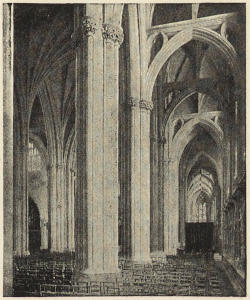
VAULT OF AISLE.
The Bristol architect was an architectural Radical. When it came, however, to the question of vaulting the aisles he had not the courage of his convictions. Having constructed aisles unusually lofty and impressive, he immediately sets to work to make them look low and ordinary by a complicated, costly and unnecessary system of skeleton vaulting. He seems to have thought that without some method of reducing the apparent height of the aisles, the church would look like no other church; it would look not as if it had the ordinary aisled nave, but as if it had three naves side by side. He ought to have been thankful to have the means of making it look unlike other churches; and, as a matter of fact, a design of parallel naves has a most noble effect, as may well be seen in the nave of Warwick Church, built in the most debased Gothic of the seventeenth century, but one of the most impressive designs in the country, full of light and atmosphere.
A little later, but still in the Curvilinear period, the Berkeley chapel was built, projecting southward from the easternmost bay of the south aisle of the choir, and a sacristy by which it is approached. Here is more skeleton-vault and much elaborate carving. The Newton chapel was also built, projecting eastward from the south transept; and perhaps at the same time the simple vault of the adjacent bay of the choir aisle was put up. A curious and by no means pleasing characteristic of the Bristol fourteenth-century architecture is the series of sepulchral recesses in the walls; they remind one of the cloister doorway at Norwich.
VII. Perpendicular.—Early in the fifteenth century a central tower was added. Here again one is struck by the originality of the Bristol people; it is as beautiful as it is original. Fifteenth-century tower design rather runs in[9] grooves. Gloucester, Evesham, Wrexham, Taunton, and the Somerset towers are cast very much in a mould. It is not so with the Bristol tower. The designer had noticed how beautiful is the effect of a close-packed range of tall clerestory windows, such as those of Leighton Buzzard Church. So, instead of restricting himself on each side of the tower to one or two windows, he inserts no less than three. The range of clerestory windows which the fourteenth-century builder refused to the choir becomes the special ornament and glory of the tower.
VIII. In 1888 the new nave and western towers were completed by Mr. Street. He can hardly be said to have made the most of his opportunities. The new work is copied closely from the old, and so is somewhat uninteresting. He had but to remedy some of the faults of the original design: to omit the ugly skeleton vaulting of the aisles, to simplify the vaulting of the choir, to discard the sepulchral recesses, to improve on the design of the windows of the choir—in which, as at Ely, flowing tracery is not seen at its best; and we should have had something original and interesting. The new nave might have been a criticism of the choir.
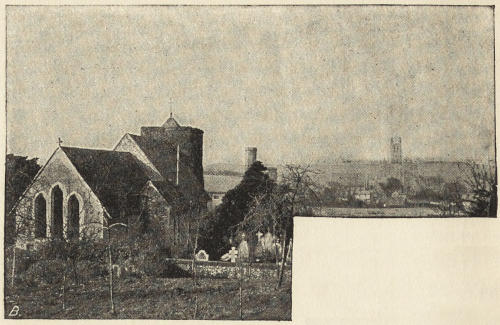
ST. MARTIN’S CHURCH.
The metropolitan cathedral of Canterbury owes its enthralling interest to its vastness of scale, its wealth of monuments, its treasures of early glass, the great historical scenes that have been enacted within its walls—above all, to that greatest of all historical tragedies to the mind of the mediæval Englishman, the murder of Becket. It does not owe its distinction to its architecture. Whole building periods are almost wholly unrepresented; for the century and a half when English design was at its best, the Canterbury authorities slumbered and slept. What we have is the result of two periods only, with some scraps incorporated from earlier Norman work. What is there is not of the best: the Perpendicular work can be bettered at Gloucester, Winchester, and York; the work in the choir, a foreign importation, is not equal to that of its prototype, the French cathedral of Sens. We have many heterogeneous cathedrals in England. In the rest there is ever an attempt, usually a successful attempt, as at Hereford, and Gloucester, and Wells, to weld the conflicting elements of the design into symmetry and harmony. Canterbury scornfully declines any attempt at composition. Transepts and turrets and pinnacles are plumped down anyhow[11] and anywhere; to the east it finishes abruptly in the ruined crags of a vast round tower; to the west the towers of its façade were, till lately, as incongruous in character as in date. Externally, the lofty central tower alone gives some unity to the scattered masses; internally it is an assemblage of distinct and discordant buildings.
I. Norman.—Of the pre-Conquest cathedrals of Canterbury nothing remains, unless it be fragments of rude masonry in crypt and cloister. Of Lanfranc’s cathedral, built, together with the Benedictine monastery, between 1070 and 1077, there remains the plinth of the walls of nave and transept. In the north transept some of his small square blocks of Caen stone are well seen just above the site of the martyrdom, as well as his turret in the north-west corner. His nave was allowed to stand till the fifteenth century. The present nave and central transept are built on Lanfranc’s foundations. The Norman work has had a most deleterious effect on the later design. To preserve the Norman north-west tower of the façade, the fifteenth century nave was built too short; to preserve the lines of his transept, it was rebuilt with a projection of only one bay to north and south, and without aisles, and appears woefully shrunken when compared with the vast transept of York, or even with the twelfth century transepts of Winchester and Ely. Lanfranc’s cathedral was an unambitious building, built in a hurry; closely copied, to save time probably, both in plan and dimensions, from William the Conqueror’s abbey-church at Caen, from which Lanfranc came to rule at Canterbury.
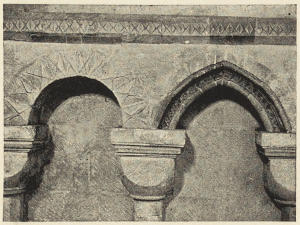
SOUTH CHOIR AISLE.
His choir consisted of but two bays and an apse. This was altogether inadequate for the church of a big monastery, and the seat of the Primate of all England. In 1096 it was pulled down and replaced by an enormous apsidal choir, some ten bays long, with a square Saint’s chapel to the east as at Rochester, with northern and southern towers flanking the main eastern apse, and crossed midway by a big eastern transept, from each arm of which two apsidal chapels projected[12] to the east. What was the object of this vast eastward extension? It was probably due to the increasing tendency towards sacerdotalism, to the increase of veneration for the sacrament of the Lord’s Supper, and to the increase of Saint-worship. (1) In the monastic churches the monks were accustomed to sit in the crossing and in the western bays of the nave, where their stalls still remain at Norwich, Gloucester, and St. Albans. They wanted to be segregated and screened off from the laity, the sheep from the goats; the very stones of the church must preach the dignity of the priestly function. So they removed to the east, and shut themselves up in a choir of their own. (2) Secondly, they wanted a clear space for the high altar, a sanctuary for it. (3) They wanted space for many chapels and altars; not only those of the greater saints of the church, St. Mary, St. Peter, and the rest, but those saints—and they were very numerous at Canterbury—whose bodies or relics of whom were among the treasures of the cathedral—such as St. Dunstan, the destroyer of Secular Canons, and the martyred Archbishop Alphege. Crowds of pilgrims flocked to Canterbury to these shrines; room had to be found for them to pass round, to gaze for a moment at the holy relics, to say one prayer. Whatever the object of the extension, it set a precedent which was followed in the great majority of the cathedrals of England. In the latter days of the twelfth century Hereford and Chichester extended their[13] choirs; in the thirteenth century the choirs of Lincoln, Lichfield, Worcester, Ely, and Exeter were rebuilt, and those of Winchester, Durham, and Lincoln were enlarged. In the fourteenth century those of Lichfield and Wells were enlarged, and that of York was rebuilt on a magnificent scale. Old St. Paul’s had a choir twelve bays long. Thus, till the end of the fourteenth century, the history of the English cathedrals was largely a history of the rebuilding or enlarging, or, as at Gloucester and Norwich, of the remodelling of choirs.
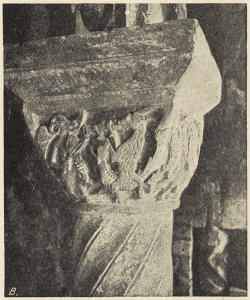
CAPITAL IN CRYPT.
Of “Conrad’s glorious choir” (it was commenced by Prior Ernulph c. 1096 and finished c. 1115 by Prior Conrad) a considerable amount remains. The round-arched work in the crypt is nearly all of this date, except the carving of many of the capitals, which was executed later; and from the extent of his crypt one can plot out the exact shape and dimensions of the Norman choir. Much of it is seen outside, especially in and near the south-east transept with its intersecting semicircular arcades, and the most charming little Norman tower imaginable. In the interior many Norman stones, “cross-hatched,” may be seen in the aisle-wall immediately after entering the choir-aisle by the flight of steps; the lower part of the vaulting-shaft in this wall, built of several stones and not of solid drums, as it is higher up, is also Norman. In the eastern transept the triforium occurs twice over; the upper[14] of the two was Conrad’s clerestory. Much of Conrad’s semicircular arcade also remains on the aisle-walls.
Conrad’s choir was not only far longer than Lanfranc’s, but it had the curious peculiarity (preserved in the French choir) that it was broader than the nave, and moreover widened out as it proceeded to the east. The double apses of each of his transepts were copied by St. Hugh at Lincoln a century later. A very noble feature of Canterbury choir is its elevation, necessitated by the construction of the crypt below it. The raising of the floor adds great dignity to the choir (one misses it painfully at Bristol); and was still further added to by the French architect, so that now at Canterbury one goes eastward from height to height. We climb from the nave to the choir, from the choir to the sanctuary, from the sanctuary to the eastern chapels. One gets a bathos at Durham and Worcester, where at the east one plunges into a hole.
II. Transitional.—But Conrad’s glorious choir was destroyed by a great fire in the year 1174, amid much mediæval cursing and swearing, and the tears of all the people of Canterbury. Then the monks did an abominable thing. Instead of being satisfied with our home-bred English architecture, of which such a beautiful example was just being completed at Ripon, they sent for a foreigner. The present choir of Canterbury, like that of Westminster, was “made in France.” The only consolation one has is the fact—which is a fact—that with that stolid insularity which from the twelfth century has insisted on working out its own salvation in its own way—English architects ignored them both. The new French choir was to be a rock on which the main current of English art struck and parted asunder only to meet again on the other side. English design passed on, as if Canterbury choir had never existed, from Ripon and Chichester and Abbey Dore and Wells to Lincoln Minster. The coupled columns, the French arch-moulds, the Corinthianesque capitals of Canterbury were[15] un-English; no one would have anything to do with them anywhere.
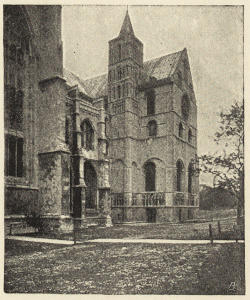
SOUTH-EAST TRANSEPT.
The choir, as rebuilt, was even longer than Conrad’s long choir. It has an elongated aisled apse beyond, and a curious circular chapel east of that. The former goes by the name of Trinity chapel, the latter of Becket’s corona. Becket’s first mass had been said in an older Trinity chapel; his body lay from 1170 to 1220 in the crypt below it; in 1220 he was translated to a magnificent shrine in the present Trinity chapel. The corona may perhaps have been erected to cover another shrine placed here and containing a fragment of Becket’s scalp. Sens seems to have had a similar corona.
The design of the choir is a close copy of the work at Sens, Noyon, Senlis, and the neighbouring cathedrals. Columns almost classical in proportion replace the heavy English cylinder. The coupled columns and Corinthianesque capitals of Sens are faithfully reproduced in the Trinity chapel. The choir, as at Sens, is arranged in coupled bays with sexpartite vaulting; while principal and intermediate piers, single and compound vaulting-shafts occur alternately in either choir. In unstable French fashion the vaulting-shaft is perched on the abacus. The abacus is square, except in the eastern part of the crypt. The capitals of the choir are foliated; the English moulded capital occurs only in the crypt. Each bay[16] of the triforium in both cathedrals contains a couple of arches, each arch subdivided by a central shaft. Both cathedrals have round transverse arches in the vaulting of the aisles. The windows are not the tall slender lancets of England, but the broad squat lancets of France. The pointed arches of the apse of Trinity chapel on their tall stilts have a thoroughly French look. French, too, is the wish to dispense with a hood-mould round the pier-arches. And, as at Noyon, flying-buttresses emerge from the gloom of the triforium into the open air.
But there is another factor besides the personality of William of Sens. Having engaged a foreigner to do the work, the next step of the monks probably was to distrust him. The choir, as it appears now, bears unmistakable marks that not only William of Sens was at work, but also a British building committee. Being a Frenchman, William of Sens must have been an iconoclast, and would have liked to clear away the ruins and start de novo. His British employers, here, as in nearly all our cathedrals, parsimonious in the extreme, insisted on retaining every inch of old wall or pillar that could be utilised. The towers of St. Anselm and St. Andrew still stood, more or less stable, to the east. William therefore had to constrict his choir to pass between them. The result is the awkward twisting of the arcade and clerestory of the choir. The choir starts with becoming wider as it advances from the east; then it suddenly contracts to pass between St. Anselm’s and St. Andrew’s chapels; then it expands once more into the Trinity chapel. No Frenchman, if he had had his way, would have permitted his cathedral to be so distorted. Again, the building committee insisted on utilising the piers of Conrad’s crypt as far as possible as supports to the arcade of the choir above. The result is that the piers of the choir are not equally spaced; and the narrow arches are pointed, while the broad ones are semicircular and stilted. William must have been ashamed, too, of all the zigzag and billet ornament. But the building committee had probably a large[17] stock of it collected from the debris after the fire, and wanted to work it off. One beautiful feature, however, is to be placed to English credit—viz., the profuse use of Purbeck marble shafts. On the whole we may take it that what we have is not William’s design as he would have wished it, but his design criticised, fettered, altered and ignored by a clerical building committee.
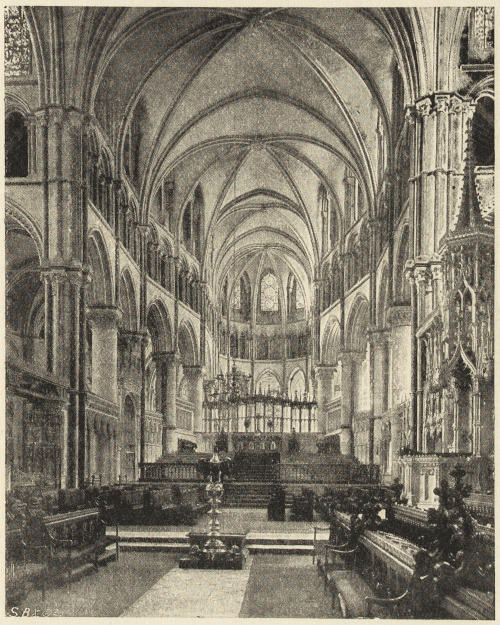
CHOIR.
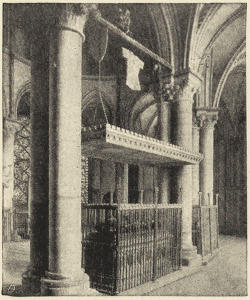
BLACK PRINCE’S TOMB.
At the beginning of the fifth year of his work, William of Sens was seriously injured by a fall from the scaffold, and soon after returned to France. An English William was appointed to succeed him. He completed Trinity chapel, Becket’s corona, and the crypt beneath the two. It is usual to attribute to the English William an important part in the design of the eastern chapels and crypt. The facts point the other way. These eastern portions are less English and more French than the western work. There is not a single trace of English influence in the design, except solely the rounding of the abacus and the moulding of the capitals in the crypt. With these two minor exceptions, everything was completed in strict conformity with the French design.
More important even than the architecture is the ancient glass. Canterbury and York are the great treasure-houses of stained-glass: Canterbury for early thirteenth-century glass, York for fourteenth-century glass. The student should take with him to Canterbury Mr. Lewis Day’s work on Stained Glass. Three of the windows in the Trinity chapel illustrate the miracles of St. Thomas. On the north side, in the lower group of the eastern window, is the story of a child (1) who falls into the Medway, (2) the other boys tell his parents, (3) the body is drawn out of the water, cætera desunt. In the next group is the story of a boy who was brought to life[19] by a draught of water mixed with the saint’s blood. But the father omitted to pay the offerings promised to the saint. In the central medallion another son lies dead, struck by the sword of St. Thomas, who is seen through the ceiling. In another group a woman is being flagellated by way of penance. Two other windows describe miracles of healing: in a medallion in the lower part of the western window a madman comes up, “amens accedit,” beaten with sticks and bound; in the next he is cured, “sanus recedit.” In one is the only representation extant of the later shrine; the martyr, in a mauve vestment, appears in a vision to Benedict below. On the shrine is the box, as described by Erasmus, which contained the archbishop’s sudary. In the east window of the corona is portrayed Christ’s Passion; in the two windows of the north aisle are types and antitypes from the Old and New Testaments; among them the three Magi, all asleep in one bed. The circular window in the north-east transept also contains the original glass; and many fragments are seen elsewhere.
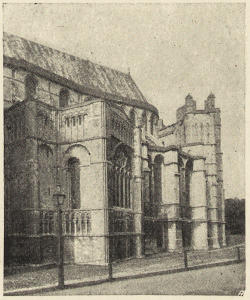
SOUTH OF CHOIR
III. Lancet.—For this period (1190-1245) there is nothing to show except the north wall of the Cloister, and a lovely doorway in the south-east corner of the Cloister, cruelly hacked about by the vandals who built the cloister-vault.
IV. To the Geometrical period (1245-1315) belongs the Chapter-house up to the sills of the windows, and the screens north and south[20] of the choir. A fine window with Kentish tracery was inserted in St. Anselm’s chapel.
V. Of Curvilinear work (1315-1360) there is no trace except some diaper-work in the choir, which may have adorned the shrine of St. Dunstan, who was buried at the south end of the high altar.
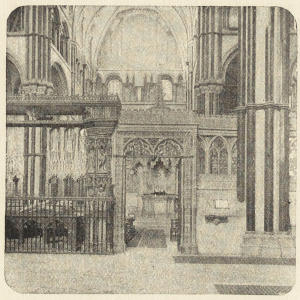
EAST TRANSEPT.
VI. Perpendicular (1360-1485).—At length Canterbury woke up, and removed Lanfranc’s nave and transept, which must have looked shockingly low and mean for the last two hundred years in juxtaposition with the stately choir. The new nave, built between 1379 and 1400, is very fine, but somehow no one seems to be a very ardent admirer of it. Its proportions are not good: Winchester nave is about the same height, but is 70 feet longer; York choir is loftier, and is 25 feet longer. But the gravest fault is in the internal elevation. The architect has recognised the value of tallness of pier-arch; but to get this exceptional height of pier and arch, he has sacrificed not only triforium, but clerestory as well. It is fatal to a Gothic design to minimise the clerestory. The choirs of Gloucester, Norwich, Cirencester, are the types to be followed; not the naves of Southwell or Lichfield.
To this period belong also the Black Prince’s chantry, and the screens and reredos of the Lady chapel, all in the crypt; the upper part of the chapter-house, from which all aspect of[21] antiquity has recently been removed; the cloisters; St. Michael’s, or the Warrior’s chapel, which replaced the eastern apse of Lanfranc’s southern transept, and which has a complicated lierne vault similar in character to that of the north transept of Gloucester cathedral; the tomb and chantry of Henry IV., with fan-vaulting, 1433; the western screen at the entrance of the choir; the south-west tower; Deans’ chapel (Lady chapel), which replaced the eastern apse of Lanfranc’s northern transept (1450), and which has fan-vaulting.
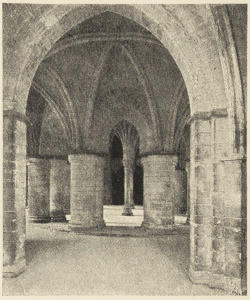
CRYPT.
VII. To the Tudor period belongs the Angel or Bell Harry Tower (1495-1503), and the buttressing and arches inserted between its piers. Also the Christ Church gateway. The great tower is remarkable for the unbroken verticality of its buttresses; it is as exceptional as it is successful in design.
The Chapter-house is rectangular, for a rectangular building fitted more easily into the east walk of a monastic cloister. Nearly all the monastic chapter-houses are therefore rectangular, but sometimes had apses; the exceptions being the Benedictine chapter-houses of Worcester, Westminster, Evesham, and Belvoir (which last was exceptional also in position, being placed in the very centre of the cloister), and the Cistercian chapter-houses of Morgam and Abbey Dore, sister designs. While the Secular Canons, having as a rule[22] no cloister, preferred a polygonal chapter-house, as at Lincoln, Beverley, Lichfield, Salisbury, Wells, Elgin, Southwell, York, Old St. Paul’s, Hereford, Howden, Manchester, Warwick. So did the Regular Canons at Alnwick, Cockersand, Thornton, Carlisle, Bridlington, and Bolton. This beautiful polygonal form seems not to occur in France.
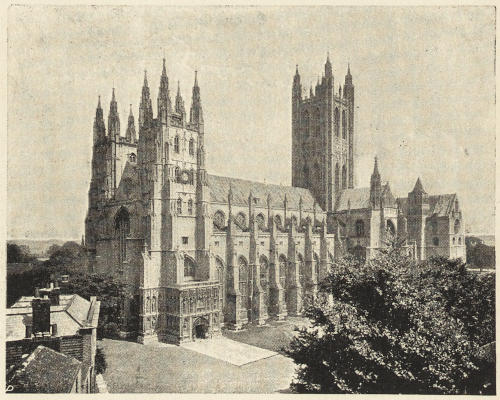
FROM SOUTH-WEST.
At the north-west corner of the cloister is the doorway through which Becket passed to the north-west transept, with his murderers in pursuit of him. Near here is a hole in the wall, the Buttery hatch. In the fifteenth century the south walk of the cloister was divided into “studies” for the monks by wooden partitions (at Gloucester they are of stone), and its windows were glazed.
From the cloister we pass to the West Front, and commence the tour of the exterior. The south-west tower (with the Deans’ chapel) was completed by Prior Goldstone (1449-1468);[23] the copy of it was put up in 1834: “it was an eyesore that the two towers did not match.” Very bad modern statues adorn the niches.
Later still (1517) is Christ Church Gateway, through which one first approaches the cathedral, with doors inserted in 1662. Originally it had two turrets. Outside it is a monument to the dramatist Marlowe.
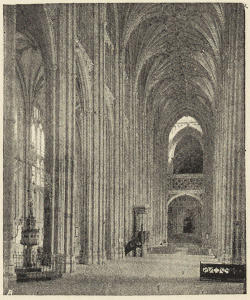
NAVE.
On the south side is seen the porch; the nave, a beautiful design; and the charming pinnacle of the south-west transept. East of the Warrior’s chapel is the projecting end of Stephen Langton’s tomb. East of this, the two lower rows of windows are those of Conrad’s choir; the upper row that of William of Sens. The middle windows in the S.E. transept were the clerestory windows of Conrad; the windows above them are those of William of Sens. The three upper stages of the tower on the south of this transept are late Norman work; one of the prettiest bits in Canterbury. Farther east we have French design, pure and simple; here, for the first time in English architecture, the flying-buttresses are openly displayed; notice how flat and plain they are; it had not yet occurred to architects to make them decorative. The grand sweep of apse and ambulatory seems to send one straight back to France. Then comes the broken, rocky outline of the corona—the great puzzle of Canterbury. North-east of[24] the corona are two groups of ruined Norman pillars and arches discoloured by fire; once they were continuous, forming one very long building, the Monks’ Infirmary, of which the west end was originally an open dormitory, open to the roof, and the east end, separated off by a screen, the Chapel; which has a late Geometrical window. A mediæval infirmary of this type is still in use at Chichester. The Canterbury infirmary had a north transept, called the Table Hall or Refectory (now part of the house of the Archdeacon of Maidstone), in which the inmates dined. On the north side of Trinity chapel is seen the Chantry of Henry IV.; then St. Andrew’s Tower and the barred Treasury; the lower part of the latter is late Norman work, largely rebuilt. The south alley of the Infirmary Cloister was built about 1236. Along this one passes to the Baptistery, which was originally nothing but a mediæval water-tower; late Norman below, Perpendicular above. Returning towards the Infirmary, we turn to the north up the east alley of the Infirmary Cloister, now called the “Dark Entry,” at the north end of which is the Prior’s Gateway. On the left are some Norman shafts and arches of beautiful design. It was the Dark Entry that was haunted by Nell Cook of the Ingoldsby Legends. West of the Prior’s gateway are the two columns from the Romano-British church at Reculvers. On the north side of the Prior’s or Green Court are the Brewery and Bakehouse; to the N.W. is the famous Norman staircase, which originally led to a great North Hall; perhaps a Casual Ward—for tramps too found accommodation at the monasteries.
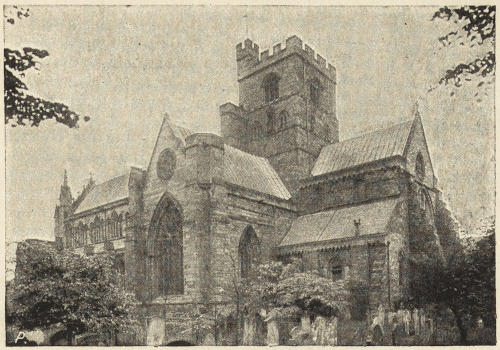
FROM NORTH-WEST.
Carlisle Cathedral, though but a torso, is of exceptional interest, both archæologically and artistically. It dates from the early years of the twelfth century. It was originally the church of the Austin or Black Canons, and also the seat of a bishopric. The Augustinian Cathedral was dedicated to the Blessed Virgin Mary; and it was re-dedicated to the Holy and undivided Trinity when placed on the New Foundation.
I. Late Norman.—The Augustinian house was founded by Henry I. in 1101, at the instigation of Queen Matilda. The Norman church consisted of an aisled nave of seven bays, a transept with eastern apses, and an aisled choir. The stones show the marks of the hatchet; the masonry is well-bonded—too good to be eleventh-century work. The corbel-tables of aisle and clerestory are particularly strong and vigorous. Norman aisles were usually vaulted; but the aisle-walls of Carlisle are so thin that they can never have supported a vault.
II. Lancet.—The lower parts of the northern and southern faces of the piers of the tower are flat: their shafts being stopped by corbels instead of descending to the ground. This was to allow the stalls of the Canons to be placed close up to the piers. Hence it is clear that in the Norman church the Canons sat, as at Norwich, in the crossing and the western bays of the nave. Like the Benedictine monks of Canterbury, they wanted to get into the choir. And so the Norman choir, being altogether inadequate to contain stalls and sanctuary, as at Canterbury, was pulled down; and a beautiful early Gothic choir of seven bays was built. Of this the vaulted aisles and the pier-arches still remain. The work is late in the Lancet period (1190-1245); for in the south aisle the Lancet windows are developing into plate-tracery, and the charming arcade on the wall is cinquefoiled. The new choir was not only far in advance of its Norman predecessor in length and height; but it was also 12 feet broader. The church could not be broadened to the south, because the cloister would prevent any removal of the wall of the south aisle, when the nave was rebuilt. So the south wall of the choir was rebuilt on the old foundations: the southern row of piers probably also rest on the foundations of the Norman piers. The central aisle of the choir was made much broader than that of the nave, with which, therefore, it is out of line; the same is the case with the north aisle of the choir.
At the same time the eastern apse of the south transept was rebuilt in the style of the day, with the crisply carved foliage of the later years of the Lancet period. The northern transept was to have been rebuilt on a more extensive scale, not being cramped as the south transept was, by monastic buildings adjacent. It was to have had an eastern aisle; but when one pier of the aisle had been built, and part of its eastern wall (a fragment of which, with string-course, survives), the work was suddenly stopped.
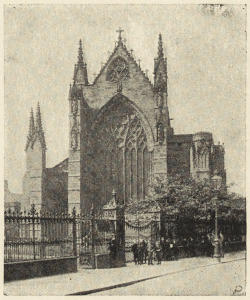
EAST END.
III. Curvilinear.—But hardly was the new choir completed when, together with belfry and bells, it was destroyed[27] by a great fire, with the exception of the aisles, which were protected by their stone vaults. The Canons, not a whit disheartened, resolved to rebuild the choir, and to rebuild it even longer and loftier than before. To its length they added an eastern bay, just wide enough to provide a processional path at the back of the high altar. They increased its height to 72 feet. But the piers and walls were too thin to bear the additional weight. They increased the thickness of the aisle-walls to 5 feet; the piers they rebuilt. The thirteenth-century arches, however, which were apparently not much damaged by the fire, they managed in some inexplicable way to retain. A modern contractor would take the arches down, and then rebuild them with the old stones. A mediæval builder would be more likely to underpin the arches, take the piers away and then rebuild them without disturbing the arches at all. The old builders revelled in such engineering feats. At Exeter they retained the clerestory wall while constructing new piers and arches below it; at York they transplanted two arches in the transept. The capitals of the new piers are exceedingly rich and interesting; they contain the best mediæval representation we possess of the Seasons; six capitals on the south side from east to west, six on the north side from west to east. The corbels also of the vaulting-shafts have rich naturalistic foliage. With that respect for good earlier work that is characteristic of[28] the Curvilinear period, and so rare at any other time, they carried the cinquefoiled arcading of the aisles round the east wall, introducing, however, the characteristic detail of the period, not to bewilder unfortunate antiquaries of later days.
Their chef-d’œuvre, however, was the east front. On this they lavished all their wealth and all their art. It is a very poem in stone. Its only rival is the contemporary east front of Selby. “The great window,” says Professor Freeman, “is the grandest of its kind in England.” It certainly has no rival, unless it be that of York. The four lateral lights on either side of the Carlisle windows are gathered up into two pointed arches; at York these two arches are ogees; the free swing of the ogee arches contrasting most effectively with the pointed arch which embraces them both. The glass in the tracery represents our Lord sitting in Judgment; the procession of the Blessed to the Palace of Heaven, shown in two silvery quatrefoils; and very realistic representations of Hell and of the General Resurrection. It contains a portrait of John of Gaunt; the window was probably glazed when he was Governor of Carlisle, 1380-84.
So far the Canons spared no expense; everything was of the best. But their resources were taxed too heavily; it was impossible to finish the choir with the magnificence with which it was commenced. Triforium and clerestory are thin and poor; the inner arcade of the latter of the barest character. The piers had been rebuilt and strengthened, apparently to support a vault; but a vault was found too expensive, and was abandoned. Then hammerbeams were constructed for a roof of the type of the magnificent roofs of March Church and Westminster Hall. This in its turn was abandoned, and the present wagon-roof of wood was put up. For similar economical reasons the south transept was rebuilt without the aisle commenced in the thirteenth century.
IV. Perpendicular (1360-1485).—But the misfortunes of the Canons were not over yet. Another fire destroyed the[29] new north transept. This was rebuilt between 1400 and 1419 by Bishop Strickland, who built the forty-six stalls of the choir. Then came the question of the central tower and the nave. The original plan had been that, when the choir was finished, a new central tower and a new nave should be built, both of the same width as the choir. But their troubles had been too much for them. The courage of the Canons gave way. They saw no prospect of ever being able to rebuild the Norman nave; so instead of pulling down the Norman tower and building one as broad as the choir, they left it standing merely adding a new upper story to it. It is, of course, far too small for its position; and while ranging with the nave, is quite lop-sided when seen in connection with the roof of the choir; though the awkwardness is lessened, and even made picturesque, by the addition of a staircase-turret on the north side of the tower. This was about 1401.
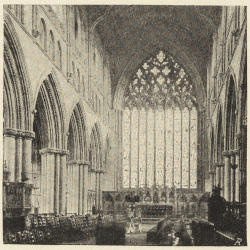
CHOIR.
V. Tudor.—Things seem to have improved towards the end of the fifteenth century. Prior Gondebour painted the ceiling of the choir and the backs of the stalls; and to him are due the beautiful screens in the south transept chapel. He also built a grand barn with a magnificent roof of beams nearly two feet thick: much of it is still standing. The refectory also is due to him; it has a pretty pulpit for the reader, as at Beaulieu and Chester. The Gate Tower or Abbey Gate House was rebuilt in 1528.
VI. Renaissance.—Launcelot Salkeld, the last Prior and the first Dean of Carlisle, added the charming Renaissance screen on the north side of the tower.
VII. In the seventeenth century the western bays of the Norman nave were pulled down, during the Civil War, to provide materials for the repair of the city walls and guardhouses.
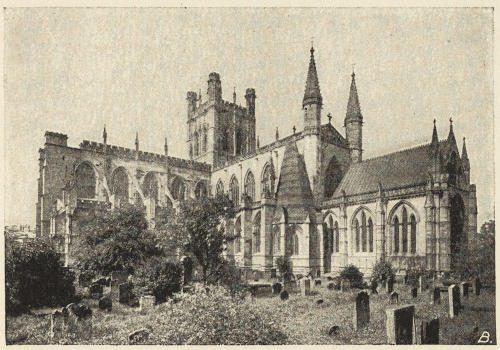
FROM SOUTH-EAST.
The cathedral of Chester had originally an establishment of Secular Canons (see Southwell and Wells.) Its patron saint was St. Werburgh, a kinswoman of St. Ethelreda of Ely. In the eleventh century it was refounded as a Benedictine monastery by that great noble Hugh Lupus, Earl of Chester, who ruled the Welsh Marshes with almost regal sway. Henry VIII. made it the seat of a bishopric, which, though but a part of the ancient Mercian diocese of Lichfield, extended northwards into Yorkshire and Westmorland. Nowadays the diocese and county of Chester are coextensive.
If we proceed to the west doors, we have before us a vista of exceptional beauty. The apparent length of the interior is greatly increased by the screen thrown across it, which, however, is not so solid and lofty as to block up the vista entirely, as at Canterbury and York, nor so exiguous as the metal screens at Lichfield and Ely.
Passing under the new organ screen, we come to the most ancient work to be found in the cathedral—viz., genuine early Norman work of the eleventh century. It is to be compared with that of the south transepts of St. Albans and Hereford. Below, in the east wall, is an arch, which once led into an apse. Above is a balustraded arcade, quite of the St. Albans and Hereford type. Above, there must have been small clerestory windows, such as those built up in the opposite wall. The whole transept must have been low and humble, and is invaluable as showing us what eleventh-century work was really like, and of enabling us to realise the vast progress that had taken place in design, in masonry, and in carving by the time that Durham, Romsey, and Peterborough were built. This early transept was of one bay only. Notice how small the stones are, the gaping joints, and the irregularity of the courses.
North-West Tower.—Bearing in mind the character of this masonry, pass out into the north aisle of the nave, and proceed to the Norman tower at the end of it. The work here is clumsy and massive, but far superior to that of the north transept, c. 1120. The north wall of the nave (now covered with mosaics) is also Norman. Other traces of the Norman cathedral will be found in the north aisle of the choir, to which we retrace our steps. On the right will be seen a great circular capital upside down, which has been used as a foundation for the north-east pier of the tower. A few feet farther is one of the original circular bases, proving that the Norman choir had vast circular piers like those of Gloucester, Durham, and St. John’s, Chester. Two bays farther east will be found in the pavement a semicircular band of dark marble. This marks foundations that have been found of the apsidal ending of this aisle; one of the stones of this Norman apse remains in the pavement. Moreover, it has been found that the central aisle of the choir, at the end of the second bay from the tower, ended in a semicircular range of columns, like St. Bartholomew’s, Smithfield. From these indications[33] we can restore the plan of the original Norman cathedral with some certainty. It had a nave and aisles of the same dimensions as the present ones; unaisled transepts, each of a single bay, and an eastern apse to each transept; perhaps a low central tower; a choir of two bays, ending in a semicircular range of columns and arches, and surrounded to the east by a semicircular ambulatory or processional path. On either side were aisles, three and a half bays long, each terminating in an eastern apse. So that the Norman cathedral had five eastern apses, and resembled in plan Gloucester and Norwich, except that the chapels of the choir-aisles of Chester point, not north-east and south-east, but due east.
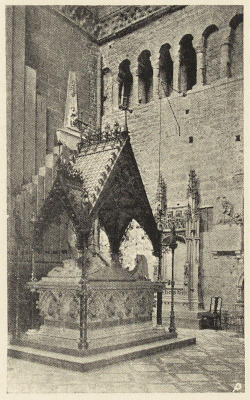
NORTH TRANSEPT.
Norman Cloisters.—Returning to the north aisle of the nave we pass through the doorway at the east end of the aisle into the cloister. This doorway, as seen from the cloister, is, from its ornamentation, of later date than the north transept, and may also be about 1120. The south wall of the cloister is now seen to be Norman; Norman abbots are buried in the recesses. Passing along the cloister westwards, we have in front another Norman door, and a very late Norman passage. Passing along the west walk of the cloister, a doorway on the left leads into a large Norman undercroft, with two aisles roofed with massive unribbed vaulting. Above, as the division in the vaulting shows, were a large and a small hall.[34] These buildings on the west of the cloisters may have been originally the cellars, refectory and dormitory of the lay brethren, as at Fountains and Kirkstall; and afterwards the cellar and halls of the Abbot’s house. To the south, above the late Norman passage, is the Episcopal chapel, also Norman, with good Jacobean work.
Vestry.—We now return through the north transept to the north aisle of the choir. The next work done in the cathedral is to be found in the vestry to the left. The Norman apse of the north transept was pulled down; the arch in the west wall is nearly all that is left of it; and a new chapel was built here in the Transitional period, between 1145 and 1190, to which period the vaulting belongs. Later on, the east end of it was remodelled, and the western arch built up. Part of the foundation of the original Norman apse may be seen in the pavement near the door.
Vestibule.—Now we come to the Lancet or Early Gothic work (1190-1245), including vestibule, chapter-house, fratery, refectory, Lady chapel, and the eastern bays of the choir. Passing through the north transept again, and out through its north door, we enter the vestibule, the architectural gem of the cathedral. The piers have bases, but no capitals—a feature common enough in late Gothic, but very unusual in such early work. Pass into the cloister to see the lovely trefoiled doorway of the vestibule. Then return to the Chapter-house, which is of the same date as the vestibule. It is rectangular, as were most of the monastic Chapter-houses originally: e.g., Exeter, Durham, Oxford, and Bristol. The windows have an inner arcade. Here is a bust of Canon Kingsley, by Mr. Belt. Returning to the vestibule, and passing out of it by the modern north doorway, we cross the Slype with its elaborate vault, and pass into a vaulted building of two aisles, each of four bays, laboriously restored at considerable expense, and then allowed to relapse into a coal-cellar: this is the so-called fratery. Rooms in similar positions occur at Fountains and Kirkstall; their use is not[35] known. Notice the day-stairs which led to the Monks’ dormitory, which was overhead, on the east side of the cloister, also the curious cusped windows adjacent. Along the whole of the north side of the cloister extended the Refectory, the Monks’ dining-hall; now the west end has been lopped off, and a passage driven through the east of it. Towards the west end will be found a fine doorway by which it was originally entered. To the right of the doorway is a recess marking the site of the lavatory. Inside, in the south wall, is the original staircase and pulpit of the refectory. Table talk was forbidden in all monasteries; a good book was read aloud to the monks during meals. Another equally fine pulpit remains in the refectory of Beaulieu, Hampshire; another, in the open air, opposite Shrewsbury Abbey. The upper part of the refectory has Perpendicular tracery inserted in the original windows.
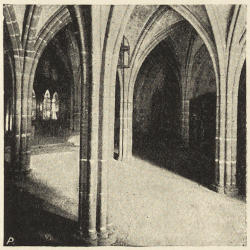
VESTIBULE OF CHAPTER-HOUSE.
Now we return to the cathedral, to the Lady chapel: much restored, of similar date and character to those of Hereford and Bristol. It was a remarkable specimen of mediæval “jerry-building,” built without foundations of any sort or kind. One of the bosses, figured in Dean Howson’s book on “The Dee,” depicts the murder of Thomas Becket. Originally the Lady chapel had three windows, each triplets, on either side.
Eastern choir.—To the same period belongs the east wall of the choir, and the two eastern bays. The east wall[36] is pierced by but one arch, as at Hereford and Chichester; an inferior ending to the triple eastern arches of the choirs of Wells and Salisbury. The mouldings of the southern arches are a cheap imitation of the better work on the north.
Western choir.—The remaining bays to the west have piers of altogether different section, and are Early Geometrical in character (1245-1280); and should be compared with Westminster choir and the Angel choir of Lincoln. In digging, the foundations of the east ends of the thirteenth-century aisles have been found. They turn out to have been polygonal. Sir G. G. Scott has been allowed to rebuild this aisle in apsidal form, and to crown his work with a hideous “extinguisher” roof. To put up this sham Gothic, he pulled down the Perpendicular choir-aisle, and expelled the monuments of three ancient county families in favour of an eminent contractor. This is what is called “restoration.”
All the above work stops at the top of the beautiful triforium, a trefoiled arcade. The clerestory is late Geometrical work; the tracery of the windows is thin and uninteresting (1280-1315). The proportions of the choir as thus completed are not at all satisfactory; the tall clerestory, with its big broad windows, is ruinous to the effect of the low pier-arcade and the diminutive triforium: it looks top-heavy. Compare the choir of Lichfield.
We have seen that by the end of the thirteenth century the monks had rebuilt all the work to the east and north of the cloister, as well as the Lady chapel and the whole of the choir. In the fourteenth century they set to work to rebuild the whole of the south transept, the central tower, and the nave. None of the upper parts of these, however, were finished till the following century. The South Transept is so vast that the old church of St. Oswald may have still remained in use while the transept was building around it. It has western as well as eastern aisles: which it is rare to find except in cathedrals of the first rank, such as Ely and York. Some of the aisle windows retain very beautiful Curvilinear tracery.[37] The springers of vaults remain, but no vaulting was executed, except one bay at the south end of the east aisle, till recently, when the remainder of this aisle was vaulted. The vast size of this transept—it is as large as the choir, and nearly as large as the nave—is in striking contrast to the diminutive North Transept, and is the most remarkable feature in the ground plan of the cathedral. Originally there stood here an independent church, belonging to the parish of St. Oswald. But in the fourteenth century, when the abbey was in possession of great wealth, the monks desired to enlarge their church. They could not enlarge it to the north, for on the north were their cloisters, chapter-house, refectory, and dormitory; on the south was the parish church of St. Oswald. They therefore came to terms with the parishioners, in accordance with which they built a new parish church for them, where now stands the Music Hall. But in the fifteenth century the parishioners were able to evade their bargain, and vindicated their claim to the whole of the new south transept, which the monks by this time had completed. “Sic vos non vobis.” And to get into it they cut the fifteenth-century doorway, which is still to be seen through the lower part of the window at the south end of the west aisle of the new transept. And here they remained in possession till the present century, using the transept as their parish church. In 1824 the transept was actually blocked from the cathedral by a solid wall. But in 1874 a new church, St. Thomas, was once more built for the parishioners, and they were again ejected from the site of the old church of St. Oswald. The dividing wall was pulled down, and the transept has been again thrown into the cathedral. Unfortunately, the congregation being gone, there is no one to fill it, and it remains a squalid and desolate solitude. Why not have replaced the dividing-wall by an open screen and have left the parishioners in peace?
Central Tower.—This was probably commenced in the fourteenth and finished in the fifteenth century. It has been found that the north-west pier rests upon some floriated[38] gravestones of the thirteenth century, which disposes of the idea that the piers of the tower have a Norman core. Notice the variation in the treatment of the tower-arches.
Nave.—Here also there is Curvilinear tracery in the windows of the south aisle. The piers and arches, also, on the south side are of fourteenth-century work, of simple but good design. The northern pier-arcade differs in some features; it may be a little later. On the other hand the initials of Abbot Simon Ripley (1485-1492) are found on the first pier from the west; and so this arcade may be really later work, assimilated in character to the earlier work on the south side.
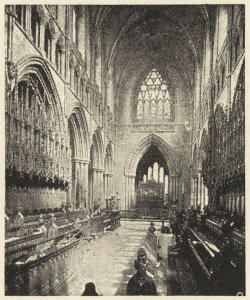
CHOIR.
South Transept.—The next thing seems to have been to complete the south transept in the Perpendicular style; and also the easternmost bay of the nave, which was needed to give abutment to the rising tower. To this period, perhaps the fifteenth century, may be assigned all those Perpendicular windows which are cusped, in the transepts, the nave, the refectory, and elsewhere.
Nave.—The final operations comprised all those windows which are without cusps—e.g., the clerestory windows and the north aisle windows of the nave; also the south porch and west front and the commencement of a south-west tower, and the fine wooden roof of the north transept. All this was done early in the sixteenth century. Perhaps piety had waxed cold,[39] and pilgrims’ offertories were less productive. At any rate, all the upper part of the interior of the nave is bare, bald, and poverty-stricken. For the beautiful triforium of the choir we have here a blank wall; unhappy, too, in proportions, the nave of Chester is one of the least satisfactory designs of the Middle Ages. In the south-west tower is the Consistory Court, with good Jacobean woodwork.
One other alteration had to be made. There was no access to the Lady chapel except through the one arch at the east end of the choir. When St. Werburgh’s shrine was placed at the entrance of the Lady chapel in the fourteenth century, it was awkward to have but a single approach to the Lady chapel; so the eastern apses of the two choir aisles were pulled down, and two Perpendicular aisles added, one on each side of the Lady chapel. (The one on the north is still allowed to exist; the one on the south was pulled down by Scott). Thus the west window on either side of the Lady chapel was converted into a doorway, and a convenient processional path was provided round St. Werburgh’s shrine.
To the late Perpendicular or Tudor period belong the eastern, northern, and western walks of the cloister, which should be visited next. In part of the west walk, and in the new south walk, there is a double arcade; dividing the walks into a series of separate compartments or studies for the monks. An analogous arrangement occurs in the cloisters of Gloucester. Notice, also, the insouciance with which these Tudor builders dropped the ribs of their vaults down on earlier doors and arches. Similar reckless disregard of the good work of preceding builders occurs at Canterbury, where the most beautiful doorway in the Cathedral is cut into by later vaulting.
North Aisle of Nave.—This has been recased, and provided with rich vaulting. It was to provide abutment for this new vault that the south walk of the cloister was rebuilt. The nave and choir have been vaulted in wood; following the precedents of York Minster and Selby Abbey.
The exterior is, to all intents and purposes, nineteenth-century work. The original design had almost wholly disappeared through the decay of the soft sandstone. It is, however, very handsome and effective; especially in contrast with the exterior, equally new, of Worcester.
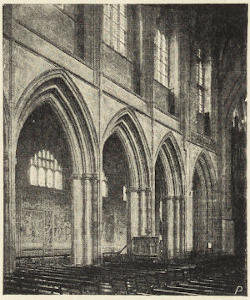
NAVE, NORTH SIDE.
Of minor work the chief objects of interest are the Byzantine font, perhaps of the eighth century; the remains of the fourteenth-century shrine of St. Werburgh and the contemporary sedilia; the fine misereres and stalls (Perpendicular); the Renaissance gates of Spanish ironwork, and the Renaissance candelabra (Italian); the epitaphs of John Lowe, tobacconist, John Paul, publican, and John Phillips, merchant, in the south transept; those of Mayor Green, and an American loyalist, on the south-west pier of the tower; the tablet of Randolph Caldecott and the pretentious monument of Bishop Pearson in the north transept; the tablet of Dean Arderne in the south aisle of the choir; and in the north aisle those of Subdean Bispham and Bishop Jacobson, and the epitaph on the gravestone of E. P. Gastrell. The new organ rests on[41] five Renaissance columns brought from Italy; the communion table is of wood from the Holy Land. On the wall near the west door is a tablet to Bishop Hall, and another
To the Memory of
JOHN MOORE NAPIER
Captain in Her Majesty’s 62nd Regiment
Who died of Asiatic Cholera
in Scinde
on the 7th of July, 1846,
Aged 29 years.
Surely one hears the trumpet on the dusty field of Meeanee, and the word of command of the stern old general. The inscription can be by none other but Sir Charles Napier. There is not much in verse that rings like these few lines of prose.
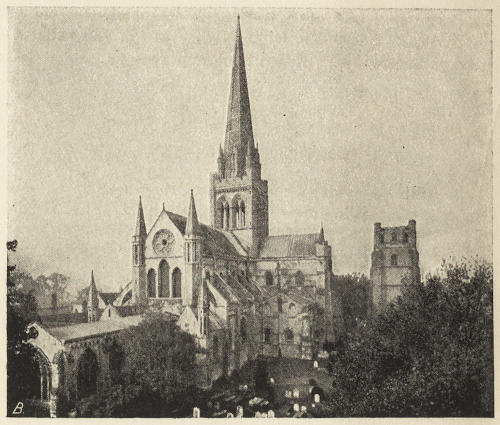
FROM NORTH-EAST.
Chichester cathedral, though one of the smallest, is to the student of mediæval architecture one of the most interesting and important of our Cathedrals. At Salisbury one or two styles of architectures are represented; at Canterbury two or three; at Chichester every single style is to be seen without a break from the eleventh to the sixteenth century. It is an epitome of English architectural history for 500 years. Early Norman, late Norman, late Transitional, early Lancet, late Lancet, early Geometrical, late Geometrical, Curvilinear, Perpendicular and Tudor work all appear in the structure side by side. We have many other heterogeneous and composite cathedrals, but nowhere, except perhaps at[43] Hereford, can the whole sequence of the mediæval styles be read so well as at Chichester.
The last kingdom, says Canon Bright, that remained outside the Church, was that of the South Saxons, hemmed in by a thick line of well-nigh impenetrable forest, and so barbarous as to be at once ignorant of one of the simplest arts, and furious against the incoming of foreigners. It was reserved for the great Wilfrid, of Hexham, Ripon and York, in one of his exiles (611)—caused originally by the high-handed partition of his overlarge diocese of York—to do what no one as yet had done for these poor rude heathen—what some Irish monks had tried to do and had failed. They were desperate with famine; he taught them to fish in the sea; for he was as ready in homely crafts of this kind as in adorning churches or educating young nobles; and as Bede says, “by this kind act he turned their hearts to love him; and they began the more willingly to hope for heavenly blessings under his preaching, when by his assistance they had received earthly good.”
The first seat of the diocese was on the coast at Selsea; it was transferred to Chichester by Stigand in 1082, when other Norman prelates removed to fortified towns such as Lincoln, Exeter, and Norwich. In the south aisle of the choir are two Saxon slabs representing the meeting of Christ with Mary and Martha and the raising of Lazarus. The figures are the tall, emaciated, but dignified figures of archaic Byzantine art; their stature carefully proportionate to their importance; the slabs may well have come from Selsea. Stigand was followed by Gosfried, who for some unknown sin sought and obtained absolution from the Pope. The original document in lead may be seen in the library. “We, representing St. Peter, the chief of the Apostles, to whom God gave the power of binding and loosing, absolve thee, Bishop Godfrey, so far as thy accusation requests and the right of remission belongs to us. God the Redeemer be thy salvation and graciously forgive thee all thy sins. Amen. On the seventh[44] of the Calends of April, on the festival of St. Firmin, bishop and martyr, died Godfrey, bishop of Chichester; it was then the fifth day of the moon.”
I. Norman.—Godfrey was succeeded in 1091 by Ralph, whose stone coffin, marked “Radulphus” may be seen in the Lady chapel. Godfrey built the present Norman cathedral, or at any rate enough of it to allow a consecration in 1108. Before his death in 1123, or soon after, the whole cathedral must have been complete except the west front, where only the two lower stories of the south-west tower are Norman. The voluted capital of eleventh-century Norman work—an attempt at Ionic—which appears also on the east side of Ely transept—occurs in the triforium of the choir. The work in the four eastern bays of the nave is a little later; the four western bays, in which the triforium is treated differently, were possibly not built till after the fire in 1114. The Norman Church had the same ground-plan as that of Norwich, commenced c. 1096, and Gloucester, commenced c. 1089. It had an aisled nave, aisleless transept with eastern apses, aisled choir, apse and ambulatory, and a chevet of three radiating chapels, of which the side chapels were semicircular, the central or eastern chapel oblong, as at Canterbury and Rochester. Externally, on the south wall of the choir, in the second bay from the east, may be seen traces of the curve of the wall of the ancient apse, and also a triforium window which originally was in the centre of one of the narrowed bays of the apse, but has now ceased to be central. In the chamber above the library the curve of the wall of the apse of the north transept is well seen. The piers, as in most eleventh-century work, are monstrously and unnecessarily heavy, and the arches constricted. It is rather a monotonous interior, with the same design from choir to west end. It is a pity that they did not give us a different and improved design in the nave, as was done at Tewkesbury and Gloucester. Matters have been made worse by the removal of a superb Perpendicular stone rood-screen, crowned, as at Exeter, by a[45] Renaissance organ. The removal of this has impaired the general effect of the interior, much lessening the apparent length of the cathedral. As usual, only the aisles and apses of the Norman cathedral were vaulted; the aisles here, as at Southwell, are vaulted in oblong compartments. It was dedicated to St. Peter, and served by secular Canons, of whom in 1520 there were thirty-one. In the triforium of the choir were semicircular transverse arches, precisely as in the choir of Durham.

PRESBYTERY.
II. Late Transitional and Early Lancet, from the fire of 1186 to the consecration of 1199, when the cathedral was re-dedicated to the Holy Trinity. About 1180 some work was going on in the western part of the Lady chapel, but in a great fire in 1186 the roofs and fittings of the whole cathedral were burnt, and the clerestories were no doubt damaged by falling timbers. The destruction, however, was by no means so great as at Canterbury in the fire of 1182, and no such drastic process of rebuilding was necessary. Bishop Siegfried confined himself to four objects: (1) To fireproof the cathedral by covering it with a stone vault, provided with the necessary buttresses and flying-buttresses. And as the clerestory which had to support the vault was much damaged, its inner arcade had to be rebuilt. (2) To replace the apse and ambulatory and chevet by a rectangular retro-choir with square eastern chapels. (3) To replace the transeptal apses by similar chapels. (4) To get rid of some of the rough and heavy appearance of the[46] ground-story of the whole church. He did not touch the triforium.
Siegfried probably commenced with the choir, which was most wanted. The masonry of the ground-story had probably been calcined by the roof-timbers blazing on the floor; the inner face of this was cased with good Caen stone. As at Canterbury, great use was made of Purbeck marble, in which were built angle-shafts and capitals to the piers, hood-moulds for the pier-arches, string-courses below and above the triforium, and arcading to the clerestory. In front of each pier a triple vaulting-shaft was run up, with a marble capital, supporting the new quadripartite vault. Externally, the clerestory wall was supported by flying-buttresses of heavy archaic type, similar to those of the choirs of Canterbury and Boxgrove. Later on, the same treatment was extended by Siegfried and his successors to the nave and transepts.
His next step was to remove the Norman apse and to build an aisled retro-choir of two bays. This is the architectural gem of the cathedral. The idea of it probably came from Hereford, where the retro-choir is a few years earlier. At Hereford, however, the retro-choir projects picturesquely, and forms an eastern transept. The central piers of the Chichester retro-choir are remarkably beautiful. They consist of a central column surrounded by four shafts very widely detached; column and shafts are of Purbeck marble. The capitals are Corinthianesque; their height is proportioned to the diameters of the column and shafts. This beautiful capital was reproduced a few years later by St. Hugh at Lincoln, and the pier at Boxgrove. The triforium is of quite exceptional beauty, as indeed is the whole design. Semicircular arches occur in the pier-arcade and triforium, and some of the abaci are square; otherwise the design is pure Gothic. Here, as at Abbey Dore, St. Thomas’, Portsmouth, Boxgrove, and Wells, we see the transition from the Transition to the “pure and undefiled Gothic” of St. Hugh’s choir at Lincoln. In these beautiful churches the ancient Romanesque style breathed its last.
The aisles of the new retro-choir were continued on either side of the first bay of the Norman Lady chapel, whose three bays had probably been remodelled before the fire in Transitional fashion. The capitals of the Lady chapel are of exceptional interest and importance, as showing experimental foliation which had not yet settled down into the conventional leafage of early Gothic. The apse also of the south transept was replaced by a square chapel; and that of the north transept by a double chapel, now used as a library, in the vaulting of which the Norman zigzag occurs.
III. A little later in the Lancet period was built (1199-1245) the lovely south porch, with small, exquisite mouldings, and charming foliated capitals and corbels. The difference between early Transitional, late Transitional, and Lancet foliation may be well seen by examining successively the capitals of the Lady chapel, the triforium of the retro-choir, and the south porch. The north porch is almost equally fine. The vaulting-ribs, square in section, show that the two porches both belong to the very first years of the thirteenth century. Rather later, the sacristy was built on to the south porch, with a massive vault supported by foliated corbels.
IV. In the Early Geometrical period (1245-1280) building still went on unremittently. The south-west tower was raised to its present height; the low Norman central tower was replaced by a higher one: it is curious that this tower is oblong on plan; the transept, contrary to custom, being wider than nave or choir. A pretty circular window, with cusped circles and tooth ornament, was inserted in the eastern gable of the retro-choir, and a fine Galilee porch was added to the west front, as at Ely.
But the great change that was destined to alter the whole character of the nave was the addition of chapels. In our parish churches it is common enough to find that pious and wealthy parishioners have been allowed to tack family chapels on to the aisles or nave. In Dorchester Priory Church there is a south aisle running the whole length of the church, made[48] up of nothing but a series of chantry-chapels. This was common enough, too, in the French cathedrals—e.g., Paris and Amiens. But the naves of the English cathedrals were not as a rule tampered with in this way. At Chichester, however, there were built, one after another, four sets of chapels—of St. George and St. Clement on the south of the south aisle, and of St. Thomas, St. Anne, and St. Edmund on the north of the north aisle. The windows should be studied in the above order; they form quite an excellent object-lesson of the evolution of bar-tracery from plate-tracery, itself a derivative from such designs as that of the east window of the south transept chapel. When the chapels were completed, the Norman aisle-walls were pierced, and arches were inserted where Norman windows had been; and the Lancet buttresses, which had been added when the nave-vault was erected, now found themselves inside the church, buttressing piers instead of walls. The new windows on the south side were built so high that the vaulting of the chapels had to be tilted up to allow room for their heads; externally they were originally crowned with gables, the weatherings of which may be seen outside. In St. Thomas’ chapel is a charming example of a simple thirteenth-century reredos.
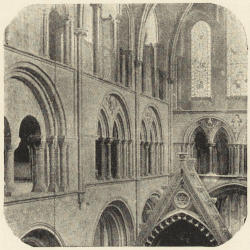
PRESBYTERY.
The addition of these outer aisles makes Chichester unique among the English cathedrals, though it may be paralleled in[49] Elgin cathedral and many a parish church. Artistically, the contrast of the gloomy and heavy Norman nave with the lightness and brightness of the chapels behind is most delightful; the nave looks infinitely larger and more spacious than it is; it is never all seen at a glance like the empty nave of York, and is full of changing vistas and delightful perspectives. Accidentally, the thirteenth-century builders had hit on a new source of picturesqueness.
V. Late Geometrical.—Between 1288 and 1304 the Lady chapel was lengthened by two bays, and the end bay of the former chapel was re-vaulted. So that what we see is a Norman chapel transmogrified into a Transitional one, and that once more altered and extended. The new work was done just when people had tired of conventional foliage, and hurried into naturalism. The capitals are another object-lesson in Gothic foliation. The window-tracery, with long-lobed trefoils, occurs also in the beautiful chapel of the mediæval hospital, which should by all means be visited.
It may be asked, where did the Chichester people get the money for all these great works? It was from pilgrims. They had had the great luck to get a saint of their own, Bishop Richard. He was consecrated in 1245, died in 1253, was canonised in 1261.
VI. Curvilinear (1315-1360).—Next the Canons set themselves to work to improve the lighting of the cathedral, which was bad; all the windows, except those in the new chapels, being small single lights. A fine window of flowing tracery was inserted in the eastern chapel of the south choir aisle (now filled with admirable glass by Mr. Kempe). And the south wall of the transept was taken down altogether and rebuilt. Here is another fine circular window. Bishop Langton, who gave the money for this work, is buried below. The drainage, too, of the roofs was improved; gutters and parapets being substituted for dripping eaves. To this period, also, belong the stalls with ogee arches and compound cusping, and good misereres.
VII. In the Perpendicular period (1360-1485) the improvements in lighting were continued, the north wall of the transept being treated in similar fashion to that opposite. But settlements were the result, and a flying-buttress had to be added to steady the north wall. And at length the tower was crowned with a beautiful spire, not quite so slender and graceful as those of Salisbury and Louth; more on the lines of the Lichfield spires. An upper story and buttresses were added to the sacristy, and the Canons’ Gateway was built.
VIII. In the Tudor period an irregular three-sided cloister was built in a quite abnormal position encircling the south transept. The object of it was to provide a covered way to the cathedral for the Canons, as well as for the Vicars, whose Close is hard by. The central tower seems to have shown signs of weakness under the weight of the new spire; and so a detached Campanile was built, as at Salisbury. Bishop Sherborne built a grand stone screen (1508-1536) occupying the whole of the crossing, and containing chantries; much of it exists, in fragments, under the Campanile. To the time of Henry VII. belongs the Poultry Cross.
IX. In 1859 the central tower was found to be in danger, owing, it is said, to the removal of the Arundel screen. Underpinning was resorted to, but matters got worse. “At noon, on February 21st, 1861, the workmen were ordered out of the building, and the people living in the neighbouring houses were warned of their danger; about an hour and a half later the spire was seen to incline slightly to the south-west and then to sink perpendicularly through the roof. Thus was fulfilled literally the old Sussex saying:
In 1866 the tower and spire were rebuilt; the tower raised slightly so that the belfry windows might clear the roofs.
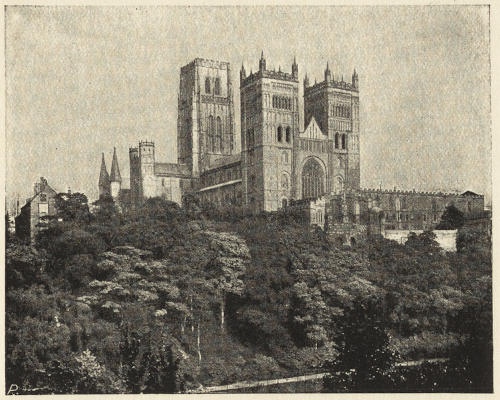
WEST FRONT.
The bishopric of Durham has a long history, though the cathedral was not at Durham till 1018. The conversion of the Anglo-Saxon kingdoms, north of the Thames, had been brought about by the missionaries of the Irish and Scottish church. Augustine’s mission in Kent, and that of Paulinus in the north—both sent from Rome—had for their object, not so much the conversion of England, as to induce the English Christians to transfer their allegiance from the Celtic to the Roman Church. The success of Augustine’s mission had been but short-lived. He landed in England A.D. 597; his death occurred in 605; and in 616 the Kentish kingdom relapsed into paganism. Paulinus landed in 601; proceeded to Northumbria in 625, but left it in 633, when, like Kent, most[52] of Northumbria relapsed into paganism. The real “apostle of the north” was not Paulinus, but Aidan, who was sent at the request of King Oswald from Iona, and in the year 635 became the first bishop of the north of England.
(1) For thirty years the see was at Lindisfarne (Holy Island), but the jurisdiction of the bishop extended over all England north of the Humber, and over the south of Scotland (635-665). (2) In 678, Archbishop Theodore of Canterbury split up the vast Northumbrian diocese into the four bishoprics of York, Lindisfarne, Hexham, and Whitherne in Galloway. Twelve bishops ruled the now curtailed see from 678 to 900, the cathedral still remaining at Lindisfarne. The second of these was the famous St. Cuthbert (685-688). (3) In fear of the Danes, the body of St. Cuthbert was removed to Chester-le-Street, seven miles north of Durham, and eight bishops had their cathedral at Chester-le-Street (900-995). (4) Once more, in fear of the Northmen, the see was removed—this for the last time—to Durham. Including Aldhun, the last bishop of Chester-le-Street and the first bishop of Durham, there have been, up to 1898, sixty-one bishops of Durham.
In the earliest days, we always read of monks as carrying about the relics of St. Cuthbert and serving the cathedral. Later on, but still in Anglo-Saxon days, the monks gave way to Secular Canons. These in turn were replaced by Benedictine monks by the Norman bishop, William of St. Carilef (1081-1096). In 1540 the monastic establishment was suppressed, and the cathedral was placed on the New Foundation, like the Benedictine cathedrals of Canterbury, Winchester, Ely, Norwich, Rochester, and Worcester, with an establishment once more of Secular Canons.
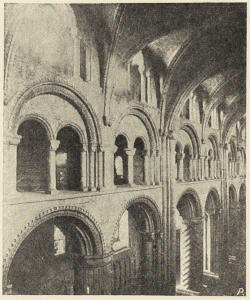
NAVE.
In Anglo-Saxon days England was divided into provinces, whose earls exercised quite as much power as the Viceroy of the Empress exercises nowadays in India. These powerful and dangerous viceroyalties the Norman sovereigns abolished, with two exceptions. To guard the Marches against the Welsh, they left the old Earldom or Viceroyalty of Chester,[53] putting it in the hands of a layman. To guard the Scottish border, they united with the Bishopric of Durham the Earldom of Northumberland. Between Tees and Tyne, and in some external districts, the Bishop of Durham had palatine jurisdiction. Here the King’s writ did not run; but the writs were drawn in the name of the bishop. As feudal lord, his seat was Durham Castle; as bishop, Durham Cathedral. Hence that wonderful group, castle and cathedral, which one sees from the Wear bridge towering overhead; unique in England, but not rare in the cities of the Prince-Bishops of the Holy Roman Empire: Lausanne, Chur, or Sitten. With the Bishop of Durham rested the power of life and death in case of murder, or even of treason itself. The most magnificent of all these powerful prelates was Anthony Bek (1283-1310). His own personal followers, when he marched with Edward I. against the Scots, included 26 standard-bearers, 140 knights, 1000 foot, and 500 horse. “Surrounded by his officers of state, or marching at the head of his troops, in peace or in war, he appeared as the military chief of a powerful and independent franchise. The court of Durham exhibited all the appendages of royalty; nobles addressed the palatine sovereign kneeling; and instead of menial servants, knights waited in his presence-chamber and at his table, bareheaded and standing.” But in 1536, Henry VIII. swept away the most important of the powers of the Counts Palatine. The ancient form of indictment “contra[54] pacem Episcopi” was altered to “against the King’s peace,” and the King’s writ ran in Durham see. Still, the palatinate county of Durham was not fully an integral part of the realm, and up to 1675 did not send members to Parliament. It was not till 1836 that the privileges of the County Palatine were fully and finally vested in the Crown. Even now, the towers of Durham have a stern military air, such as no other English cathedral possesses; for a parallel to which we must go to the fortress-cathedrals of Albi and the south-west of France. Durham cathedral is “half House of God, half castle ’gainst the Scot.”
Of the Anglo-Saxon cathedrals in wood or stone nothing remains. The architectural history of the present cathedral commences with the accession of the second Norman prelate, William of St. Carilef, or St. Calais on the southern border of Maine, who was bishop from 1081 to 1095, and is said to have laid the foundations of the Norman cathedral in 1093 on August 11th. The building operations of the Norman cathedral admit of a threefold division: (1) The choir and choir aisles; the arcade and triforium of the eastern aisles of both transepts; the crossing; the first bay of the nave and the first arch of the nave-triforium; and the whole of the outer walls of the nave up to the top of the aisle-arcade of intersecting arches. All this is supposed to have been built by William of St. Carilef between August 11th, 1093, and January 6th, 1096; i.e., in two and a half years; which seems impossible. (2) In the interval of three years between Carilef’s death and the appointment of Ralph Flambard, the monks are said to have finished the transepts. (3) Between 1099 and his death in 1128, Ralph Flambard finished the nave. These three divisions are architecturally correct; they are borne out by differences of detail; and they follow the same order of building which was observed elsewhere. But it does not follow that the exact dates given above, on mediæval authority, are correct.
The most important matter is the date of the high vaults.[55] From architectural evidence it is pretty clear that the vaulting was executed in the following order: (1) the vaults of the aisles of the choir and transepts, said to be not later than 1099; (2) the high vault of the choir, now destroyed, said to be not later than 1104; (3) the vaults of the aisles of the nave, said to be not later than 1128; (4) the high vaults of the transepts and nave, said to be not later than 1133. The chronology of the high vaults is a very important question in the history of mediæval architecture, especially as affecting the reputation of English architects. If the above dates are correct, it was the Durham architect, and not a Frenchman, who was the first to solve the great problem of mediæval architecture: how to construct and keep up a ribbed vault, oblong in plan, over a central aisle. With it goes the question of priority in the use of flying-buttresses to take the thrust of a high vault. If the dates given above are correct, Durham was a generation ahead of the whole world in the construction of a high vault and in the use of flying-buttresses.
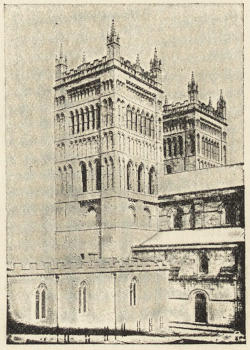
WEST TOWERS.
But the transverse arches of the vault of the nave are pointed; a feature which occurs nowhere else in England at so early a date. Besides, it seems impossible that if the Durham people had solved the problem of problems of mediæval architecture—the construction of a high oblong vault—nobody else should have copied it in England for more than fifty years.
Another theory is that the high vaults were constructed by Bishop Farnham in 1242, making them contemporary with the Chapel of the Nine Altars—which is impossible.[56] It seems to me that they belong to the episcopate of Hugh Pudsey, c. 1160.
The bays of Durham are coupled, Lombard-fashion—i.e., large and small piers alternate: with what object, is uncertain. There were three parallel eastern apses. The central apse had no ambulatory. The lateral apses were square externally, as at Romsey and Cerisy-la-Forêt, and S. Maria in Cosmedin, Rome (c. 780). The central was separated from the lateral apses by solid walls, as at Cerisy-la-Forêt, whose clerestory also seems to have been copied in the original western clerestory of the south transept.
Durham anticipates Gothic not only in vaulting its central aisles in oblongs—for the high oblong vaults of Durham, if not so early as 1133, are still the earliest in England—but in the employment of flying-buttresses. These, I think, were built long before the vaults, their object originally not being to withstand the thrust of vaults. In the triforium of the choir they appear in the form of semicircular arches, with a wall on them, which provided a support for the longitudinal timbers of the aisle-roof. In the choir these flying-buttresses are semicircular arches, and therefore, strictly speaking, are not flying-buttresses at all. But in the triforium of the nave they consist of segments of circles tilted up on end. Here they are genuine flying-buttresses, which oppose resistance to any outward inclination of the clerestory wall. The only constructional difference between those of the nave and Gothic flying-buttresses is that the former are placed underneath the roof of the triforium, sheltered from the weather, while the latter are placed outside and above the aisle-roof, and are thus liable to disintegration by wind, rain and frost. But even in Gothic, flying-buttresses are not always displayed; they still remained concealed under the triforium in the early work at Salisbury; and even in the fourteenth-century work of Winchester nave.
At the west end the towers project beyond the line of the nave, but only slightly. Still we may well see in this the germ[57] of the grand western transepts of Ely, Wells and Peterborough.
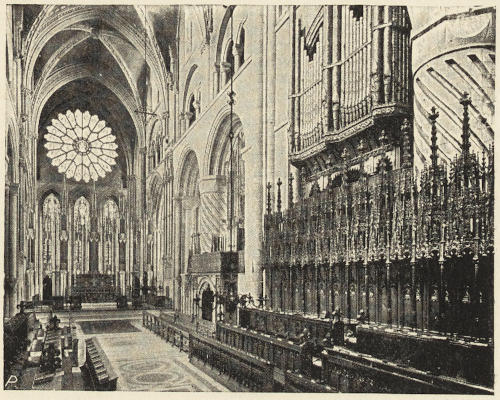
CHOIR.
Internally, the one fault of Durham is its shortness in proportion to its great breadth. The nave ought to be two or three bays longer. Ely nave has twelve bays, Peterborough ten, Norwich fourteen, Durham only eight. But the architect could not build much further to the west, for close at hand is the precipice rising above the river; nor did he like to build further to the east, for the ground there is bad.
The internal elevation, however, is unsurpassed by that of any Romanesque church in Europe. At Winchester, Norwich, Peterborough, Ely, Malvern, Leominster, Chepstow, the three stories—pier-arcade, triforium, and clerestory—are about equal in height: a very unsatisfactory proportion. The architects of Gloucester and Tewkesbury saw this: unfortunately they rushed into the opposite extreme, and carried up their piers to such a vast height that the triforium and clerestory were dwarfed out of all proportion. But at Durham the[58] proportions are absolutely right. The vault, too, is not so much later in date as to interrupt the solid monumental effect of the interior. It is as much preferable to the florid vaults of Gloucester, Tewkesbury, and Oxford as it is to the unworthy wooden ceilings of Peterborough, Selby, Waltham, and Ely. Durham gives one still the impression which it gave Dr. Johnson—one of “rocky solidity and indeterminate duration”: the very reverse of the unsubstantial tenuity of Salisbury and Beauvais.
The doorway of the Chapter-house is recorded to have been built by Bishop Galfrid Rufus (1133-1140). The north and south doorways of the nave (facing one another) are so similar to that of the Chapter-house that they must also be his work.
To Bishop Pudsey, to whom we have attributed the high vaults, belongs also the Galilee, c. 1175. He commenced to erect a Lady chapel in the usual position to the east of the choir. But St. Cuthbert, who had an ultra-monastic hatred of womankind, and would not brook to have the chapel even of Our Lady in the neighbourhood of his shrine, showed his displeasure openly by the fissures and cracks and settlements which kept constantly occurring. In despair the bishop had to build in the cramped space between the west end and the precipice, thus blocking up the west end of the church. From the first this Lady chapel seems to have been called the Galilee; nobody knows why. In details it is not unlike the chapel in the keep of Newcastle. Built in the last years of the Transitional period (1145-1190), it is remarkable for the paucity of Gothic detail: the arches are all semicircular; they are not moulded, but ornamented with bands of the old-fashioned zigzag. The bases, indeed, are Transitional in character; and so is the flat voluted leaf of the capitals. But, spite of semicircular arch and Norman ornament, the spirit of the whole—its lightness, grace, and elegance—is Gothic. A building may have every arch pointed and moulded, and yet in its heaviness be Romanesque at heart: e.g., the Cistercian churches of Fountains and Kirkstall, the Augustinian church[59] of Llanthony. In Durham Galilee, on the other hand, one feels that one is in a Gothic building, as truly as one does in presence of the semicircular arcades of Pisa or Lucca. Still more Gothic must have been the effect of the coupled shafts of Purbeck marble before Cardinal Langley added two more shafts of stone. The cardinal is buried in front of the west door of the nave. Here also was the shrine of the remains of the Venerable Bede, stolen from the monks of Jarrow by the sacrist Elfred, one of the most successful of mediæval “body-snatchers.” Pudsey’s work is to be seen also in the external part of the Prior’s doorway opening from the cloister into the east end of the south aisle of the nave.

FROM NORTH.
To the Lancet period (1190-1245) belong the western towers, carried up in the early years of the thirteenth century. At one time they had tall wooden spires. The present battlements were added about 1780.
To the early part of the Geometrical period belongs the noble eastern transept. Its position repeats that of Fountains[60] Abbey, which was finished in 1247, and which also is known as the “Chapel of the Nine Altars.” The object of the eastern extension at Durham was partly to provide nine more chapels, partly to provide a clear space all round the shrine of St. Cuthbert, which, like those of St. Swithun and St. Birinus at Winchester, and that of St. Alban at St. Albans, stood to the east of the high altar, and contained the body of St. Cuthbert and the head of St. Oswald. The idea of the eastern transept seems to come from Hereford and Abbey Dore. It is curious that the floor of the Durham transept is lower than that of the choir. It has been suggested that the height of the vault being fixed by that of the vault of the choir, sufficient height could be gained only by lowering the floor. But I doubt if mediæval architects were in the habit of designing merely for effect in this way: probably some humble practical reason is at the bottom of it. The fact that the ground falls away to the east, or that it is bad ground, and that much of it had to be excavated and carted away, would be quite sufficient for this objectionable drop in level (cf. “Worcester”). The vaulting is, perhaps unavoidably, awkward and clumsy.
The work was not commenced till 1242 (Bishop Farnham), and not completed till about 1280. When it was begun, Lancet windows were still in fashion; when it was completed, they had given way to traceried windows with cusped circles in their heads. Later on, Perpendicular tracery was inserted in the lancets: it is surprising that it has not been hacked out, as in Ripon façade, by architectural “purists.” The circular window, 90 feet across, was rebuilt by Wyatt. The architect was a layman, Richard Farnham, “architector novæ fabricæ Dunelm”; the master-mason “Thomas Moises posuit hanc petram.” The foliated capitals, both here and in the eastern bay of the choir, are of unrivalled beauty. No less remarkable is the perfection of the masonry. The walls are nearly eight feet thick, with huge piers at the angles forming buttresses and weighted by pinnacles; they rise straight from the ground[61] unaided by aisles or flying-buttresses, “yet they have borne the lofty vault (80 feet high) for more than three centuries without the slightest sign of settlement or flaw.” Such was the reverence for St. Cuthbert that not a single person was buried in the cathedral till 1311, when that magnificent prelate Anthony Bek was brought into the Chapel of Nine Altars for interment, through a door on the north of the chapel (now blocked up), not through the cathedral; and even he was not allowed a monument. One sees why there is such a paucity of monuments in this cathedral.
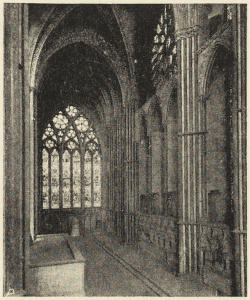
CHAPEL OF NINE ALTARS.
The next thing was to pull down the old Norman apse; to join the transept on to the choir; and to break the transition from Romanesque choir to Gothic transept by remodelling the eastern bays of the choir in the fashion of the day. Also a new Gothic vault was put over the choir; its eastern bay is sexpartite. Here also the details are of exceptional beauty.
For a long time little was done at Durham; the cathedral was structurally complete. In the Curvilinear period (1315-1360) several large windows with flowing tracery were inserted: e.g., the west window of the nave and the north window of the north transept; and four windows (restored) in the south aisle of the choir. The three westernmost windows in the north aisle of the choir were copied in 1848 from the fourteenth-century windows at Sleaford, Holbeach and[62] Boughton Aluph. To this period belongs the tomb of Bishop Hatfield, built in his lifetime (1345-1381), one of the best bits of design in England. The episcopal throne above it looks a little later, and seems to have been designed for some other position, as it does not fit the space between the piers.
In the Perpendicular period the great work was the central tower, which replaced a thirteenth-century tower, c. 1470. It is 218 feet high; in spite of its vast weight, the Norman piers which support it show no signs of strain. There are massive squinches at the angles, showing that it was intended to be finished by a spire, as the western towers actually were finished. What an astounding spectacle Durham would have presented, capped with three spires! Imagine Lichfield cathedral set on a hill 200 feet high! The Neville screen, built, like that at St. Albans, of clunch, is rather thin and spiky. It is continued to right and left, forming sedilia on both sides of the sanctuary (1372-1380). In the nave is a series of Neville monuments. In the third bay from the west is the Women’s Boundary Cross. The great window of the south transept was inserted about 1400.
Between 1660 and 1672 Bishop Cousin did much to repair the damage done by the Scottish prisoners who had been confined in the cathedral after the battle of Dunbar in 1650. His stalls and font cover are of exceptional interest, as specimens of what is rare—seventeenth-century Gothic. It should be compared with the woodwork of St. John’s Church, Leeds. The bishop’s fine oak choir-screen has been destroyed, by way of restoration; the new open screen, and the loss of the organ, give the “unbroken vista” for which so many of our interiors have been ruined.
Exterior.—On the north doorway of the nave is the famous sanctuary knocker. Durham and Beverley, owing to the high reputation of the relics of St. Cuthbert and St. John of Beverley, both had large privileges of sanctuary. Beverley retains the Sanctuary chair, the Frithstool; Durham the knocker. It is thirteenth-century work. “Upon knocking[63] at the ring affixed to the north door of Durham the culprit was admitted without delay; and after full confession, reduced to writing before witnesses, a bell in the Galilee tower ringing all the time to give notice to the town that some one had taken refuge in the church, there was put on him a black gown with a yellow cross on its right shoulder, as the badge of St. Cuthbert, whose peace he had claimed. When thirty-seven days had elapsed, if a pardon could not be obtained, the malefactor, after certain ceremonies before the shrine, solemnly abjured his native land for ever; and was straightway, by the agency of the intervening parish constables, conveyed to the coast, bearing in his hand a white wooden cross, and was sent out of the kingdom by the first ship which sailed after his arrival.” During their stay in the church the culprits lived on the lower floors of the western towers. The atrocious setting of the doorway is modern; as also the pinnacles of the Chapel of the Nine Altars, where the famous Dun Cow is to be seen in a niche in the north-west turret. All the design of this side of the cathedral has been utterly ruined; having been pared away to the depth of three or four inches. Originally each bay of the aisle had a transverse roof ending in a gable, as originally on the south side of Chichester nave.
The monastic buildings are numerous and important; the library contains precious MSS., touching relics of St. Cuthbert, and a wonderful collection of Pre-conquest crosses and “hogbacks.” For all these the visitor should consult Canon Greenwell’s admirable handbook.
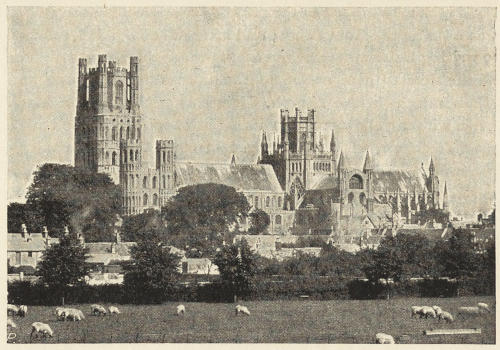
ELY, SOUTH-WEST.
“The vast and magnificent cathedral of Ely,” says Mrs. Van Rensselaer, “looms up on the horizon, as we come westward from Norwich, like a great solitary ship at sea. As we draw nearer it preserves its isolated clearness of outline, lifted visibly above the plain, yet so little lifted that its bulk seems all the greater from being nearer the eye. As we enter the little town from the south-west we realise its enormous length, the grace of its octagon, and the stern majesty of the tall tower, which rises like a great cliff in a land where men might well build cliffs, since Nature had built none. But there is in truth no spot whence the great monarch of the fenlands may not be admirably seen, until we get so far off that it drops behind the horizon’s rim. Wherever it may reveal itself it is always immense, imposing, majestic: only upon the plains of Egypt or Mesopotamia has Nature assisted the effect of man’s work by such entire suppression of herself.”
Ely, like Peterborough, Ramsey, Thorney, and Crowland, and like Glastonbury, the greatest of all the English monasteries, goes back to early Anglo-Saxon days, when communities of monks and nuns sought solitude and safety in the recesses of far-spreading marshes and fens. In the beginning the monastery was founded as a nunnery, in 673, by Ethelreda, who became the first abbess and Ely’s patron saint. From the nuns it passed to secular canons, and in Dunstan’s time to Benedictine monks. In 1109 the abbot gave way to a bishop, and the Benedictine church became a Benedictine cathedral.
The Bishop of Ely in his island, like the Bishop of Durham in his hill-fortress, possessed powers which no other English ecclesiastic was allowed to share. His territorial possessions included the whole Isle of Ely: and this, “the Liberty of the Bishops of Ely,” was subject to the exclusive jurisdiction of the bishop. It is in these two facts—the possession of a local saint, St. Ethelreda or St. Audrey, of high repute through all England; and in the enormous revenues derived from the Isle of Ely—that the explanation lies of the vast scale on which the abbey-church was planned in the eleventh century, of the unparalleled richness of its thirteenth-century presbytery, and of the enormous works undertaken and rapidly carried out in the fourteenth century.
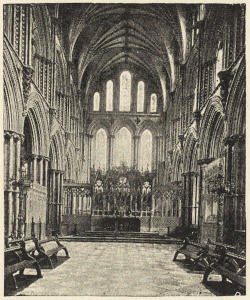
CHOIR
I. Norman.—The present cathedral was commenced in 1083 by Abbot Simeon, brother of Bishop Walkelin of Winchester, where Simeon himself had been a monk. Earlier still he had been a monk at St. Ouen, Rouen; so that he would be well acquainted with the contemporary architecture of Normandy. As was to be expected from the relationship of the founders of the two cathedrals, Ely and Winchester have many points of resemblance. Both are vast in scale, far surpassing the Abbaye-aux-hommes at Caen, or Lanfranc’s copy of it at Canterbury. Both indulge in the luxury of aisles to the west as well as to the east of their transepts. Both had return aisles in the transepts—a feature borrowed from[66] the Abbaye-aux-hommes. Those of Winchester remain; those of Ely have been pushed back to the walls. The nave of Ely had no less than thirteen bays, its transepts three, its choir five. The choir-aisles had square ends; the choir ended in a semicircular apse. The stalls were placed in the crossing and in the two eastern bays of the nave up to 1770, when Essex removed them to the presbytery; Scott placed them in their present position in 1847. There was a central tower; and, instead of two western towers, there was one tower with four flanking turrets. From the lower stories of these turrets, of which only the southern one is left, apses projected eastward. Externally the western transept gave the church great breadth and dignity; and the plan of Bury and Ely was speedily copied at Peterborough, Lincoln, and Wells. Internally it is the most picturesque bit of Norman work in the country. The two towers “riding tandem” may be paralleled at Wymondham and Wimborne, and formerly at Bury and Hereford. Of Abbot Simeon’s eleventh-century work little is left now except the vaulting-shafts in front of his apse, to the east of the organ; the exterior of the west windows of the south transept, which alone have the nail-head moulding; and the lower part of the eastern walls of the transepts, which have the Ionic capital. “The masonry is rude and tooled with a large cross-stroke: the abaci and the soffits of the arches are square and[67] unmoulded.” The choir and the lower part of the transepts are said to have been completed in 1106.
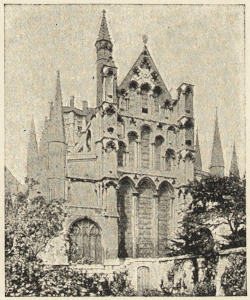
EAST END.
All the rest of the work as far as the west end was designed towards the end of the Norman period: c. 1130. The lateness of the work is seen in the tall, slender, graceful shafts of the triforium and clerestory, and in the substitution of mouldings for carved ornament in the orders of all the arches. It is much nearer Gothic than the contemporary work at Peterborough and Norwich. The proportions are unusually good, both the pier-arches and clerestory being taller than usual in proportion to such a lofty triforium. Accordingly, the proportions of the Norman choir, then standing, were copied in the presbytery added to the choir in the thirteenth century; and the proportions of the presbytery were reproduced in the fourteenth-century choir. It is this, doubtless, which gives such a feeling of unity in Ely, as at Worcester, in spite of the fact that the present cathedral consists of three blocks built in three different centuries in entirely different styles. At Canterbury, Rochester, Ripon, Chester, nave and choir quarrel; at Winchester and York, nave and transept; Ely has evolved harmony out of discord. The work seems to have been done in four sections: first, the completion of the transepts and the crossing and the eastern bays of the nave; second, the western bays; third, the three lower stories of the west transept; fourth, the monks’ and prior’s doorways.
II. Transitional.—The upper stories of the western transept, the western turrets, and the upper arches of the crossing, were not completed till about 1170. About the same date are the Infirmary chapel and the Refectory; the former east, the latter south of the cloisters.
III. Lancet (1190-1245).—Early in the thirteenth century the Galilee porch was added, in the same position as at Durham. Externally the design is commonplace; internally, “with its rich outer and inner portals, its capitals carved with delicate curling leafage, its side arcades in double rows of trefoiled arches, and the profuse dog-tooth enrichment of its mouldings, it is one of the loveliest things ever built, and one of the most English in its loveliness.” The early date of 1200 is assigned to this and to the equally beautiful western porches of St. Alban’s. If so, Gothic must have advanced with lightning speed from the jejune work of Lincoln choir and Winchester retro-choir.
Next, about 1234, the Norman apse was pulled down—partly, perhaps, because it had become unsafe, its foundations not having been carried down to the solid rock, but, much more from the need to provide more accommodation for the crowds of pilgrims to St. Audrey’s shrine. The apse was replaced by a presbytery of six bays: a presbytery of inexpressible loveliness. “Nowhere,” says Mr. Freeman, “can we better study the boldly clustered marble pier with its detached shafts, the richly floriated capitals, the yet richer corbels which bear up the marble vaulting shafts, the bold and deftly cut mouldings of every arch, great and small. Lovelier detail was surely never wrought by the hand of man.” The piers are closely spaced; and the arches, therefore, as at Beverley, are sharply pointed—in beautiful harmony with the Lancet windows. On the other hand, the trefoiling of the triforium arches contrasts delightfully with the pointed arches of pier-arcade and clerestory. Only at Beverley can the beauty of Ely presbytery be paralleled; but at Beverley the design owes everything to the architect; at Ely the[69] sculptor may claim half the credit. Worcester choir may be placed next in order; its proportions, indeed, are very similar to those of the Ely work. The presbytery was completed in thirteen years, and cost what is equivalent to £120,000 of our money—£20,000 per bay.
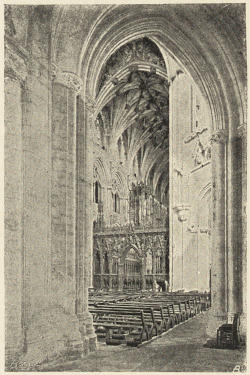
OCTAGON AND CHOIR.
IV. Geometrical.—With this superb eastern extension the monks remained satisfied for some seventy years. Nothing was done in the cathedral except the insertion of large Geometrical windows to give more light to the chapels in the eastern aisle of the south transept.
V. Curvilinear (1315-1360).—But in the fourteenth century a most wonderful series of great works was carried out in Ely; the noblest works of that or perhaps of any period of mediæval building in England. First of all, it was resolved to give the Blessed Virgin the honour so long withheld from her at Ely. At Ely her rightful position in the presbytery had been usurped by St. Ethelreda, as at Durham by St. Cuthbert. Following the precedent of Bristol and Peterborough, a vast Lady chapel was now built for her on the north side of the choir between 1321 and 1349. Later on, Ely Lady chapel in turn gave birth to King’s College chapel at Cambridge. It is a wonderful[70] piece of mediæval engineering; the vault—a very flat one—being upheld by the mathematical minimum of wall and buttress. But it was more than engineering. It was the product of a time when “Catholic purity in the best natures was still allied to the tenderness of chivalry”—
It is said that when Pugin saw the ruins of its arcade, once so glorious in its beauty—wherein are carved, in the spandrils above each canopy, incidents in the scriptural and legendary history of the Blessed Virgin—he burst into tears. He estimated the cost of the restoration of the Lady chapel at £100,000, but said that no workmen could be found competent to do the work.
The year after the Lady chapel was commenced, the central tower fell; and falling eastward, ruined the three western bays of the Norman choir which still remained. Nevertheless, though the monks had suddenly cast on them the vast task of rebuilding both tower and choir, they did not abandon or intermit their work in the Lady chapel. Side by side the different sets of works went on: the Lady chapel, the central tower, and the choir. The tower was finished in 1342, the Lady chapel c. 1349, the choir probably not much later. How vast the resources of Ely must have been!
In 1322 Alan of Walsingham, then sacrist at Ely and afterwards Prior, set to work to clear away the débris of the piers of the tower. We may believe that when he saw the great open space in the centre of the cathedral, it may well have occurred to him what a pity it would be ever to close it up again to construct the usual circumscribed square central tower, the width only of the nave, under which one feels as if looking up from the bottom of a well. What was left, when he had cleared away the four tower-piers, was an area three times as large as that of the original crossing. This area was an octagon, with four long and four short[71] sides: four long sides opening into nave, choir, and transepts; four short sides opening diagonally into the aisles. Why not throw four wide and four narrow arches over the piers of the octagon, and on these arches erect, not a small square tower, but a vast octagonal tower? Octagonal central towers were unknown in the English cathedrals; but there are plenty abroad—e.g., magnificent examples at Coutances and Siena. The difficulty was how to roof a tower so vast. The noblest course would have been to cover it with a vault of stone. But no English architect ever dared a vault 77 ft. wide. In Spain they might have done it: the vault of the nave of Gerona is 73 ft. in span. In England not so; the York people did not even venture to vault a nave 45 ft. broad.
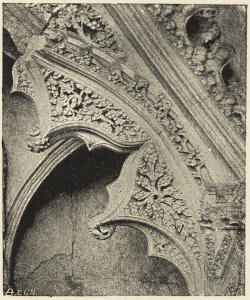
LADY CHAPEL.
Some sort of wooden roof, therefore, had to be adopted. That roof could not be a flat wooden ceiling; no beams of the length of 77 ft. could be had; and if put up they would have been unsafe. Instead, then, of a flat ceiling, Alan determined on a conical vault of wood like that of York Chapter-house. But what he wanted was not merely a roof, but a lantern. A roof like the York one would have darkened the whole central area, besides being ugly in appearance and difficult to construct. Instead, therefore, of taking the whole of the York cone, he cut the top off, replacing its sharp spike with an octagonal lantern. In[72] this, or in some such way, Alan got at his design: one of the most original and poetic conceptions of the middle ages; but arising, like all the best things in Gothic architecture, out of nothing but the exigencies of building construction.
The problem was solved on paper, but it proved immensely difficult in execution. Alan finished the stone piers and arches in six years, but the timber-work occupied twelve years more. He had to search all over England before he could find oaks big and straight and sound enough for the eight vertical angle-posts of his lantern. They are 63 feet long, with a sapless scantling of 3 ft. 4 in. by 2 ft. 8 in. Oaks like those do not grow now in England. The eight angle-posts are tied together at top and bottom by collars of horizontal beams, and the whole skeleton lantern rests on the tips of inclined beams, whose lower ends rest on corbels behind the capitals of the great piers below.
And as the inclined beams spread to right and left from the great piers below, it follows that the eight sides of the lantern are not placed above the eight arches below. This engineering necessity, also, is wrought into a new source of beauty. For advantage is taken of it to pierce the wall-space above the narrow low arches with four tall windows, so that the central area, so gloomy at Winchester, Lincoln, and Wells, is irradiated with a flood of light from twelve vast windows; four below, eight above. There is not such a lantern church in the world, and certainly there is no such interior as Ely in England. To the west, dark nave; to the east, darker choir; the centre all light and atmosphere. The views from the aisles across the octagon into the choir are veritable glimpses into fairyland. Externally, too, the octagonal lantern groups marvellously with the great western tower; in height, in bulk, in shape they are in perfect ratio.
Side by side with the octagon went up the choir, as was necessary, that the octagon might have abutment to the east. The choir is “a little over-developed and attenuated in detail”; the windows are squat and ungraceful in proportion,[73] and their flowing tracery wiry and unlovely. Window tracery is the one weak point in the Curvilinear work at Ely. Nevertheless, this choir is one of those works whose delicate loveliness disarms criticism. It even disarmed Mr. Fergusson, who says that the proportions of the presbytery are reproduced in the choir, “with such exquisite taste that there is perhaps no single portion of any Gothic building in the world which can vie with it in poetry of design or beauty of detail.”
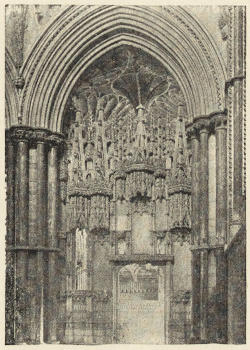
ALCOCK’S CHAPEL.
But the monks had not finished even now. They were dissatisfied with the lighting of the older part of the cathedral. So they took out the thirteenth-century lancets, not only those of the aisles but those of the outer wall of the triforium of the presbytery, and replaced them by broad windows of flowing tracery. Even this was insufficient, and so they substituted a flat roof for the steep sloping roof of the two western bays of the presbytery aisles, and glazed the openings of these two bays of the triforium. Thus more light was obtained for St. Ethelreda’s shrine, which then stood between these two bays; its exact position is marked by the elaborate boss in the vault of the choir. Externally, the result is hideous, a big hole being left in the choir aisles, where the lean-to roof formerly extended continuously. All this piercing of the walls with bigger windows weakened the supports of the vaults, and the builders therefore took the precaution to weight the buttresses with heavy pinnacles, and to add flying-buttresses.
Beautiful stalls were then put up under the octagon—the panels are modern—and above the ancient white marble tomb of St. Ethelreda a stone canopy and watching-loft were erected. It now stands between the south piers of the presbytery, in the fourth bay from the west. On this was placed the Norman silver reliquary, “embossed with many figures, with a golden majesty blazing in its centre, with countless jewels of crystal and pearl, onyx and beryl, and amethyst and chalcedony.”
Nor was this all. Alan designed for his friend Prior Crauden a little chapel which would be the cynosure of any other cathedral, but which passes almost unnoticed amid the glories of Ely.
VI. Perpendicular (1360-1485).—In this period the monks continued their improvements in the lighting of the cathedral, treating the Norman nave very much as they had treated the Lancet choir—i.e., putting bigger windows in the aisles, and also raising the aisle-walls so as to get space for an upper range of windows, in the hope that some light might filter through across the triforium into the nave.
Moreover, they added another storey to the great west tower, making it octagonal, in order to bring it more into harmony with Alan’s lantern. The additional storey threw more weight on the Norman arches below, under which new strengthening arches had to be built. This saved the tower; but the northern half of the western transept collapsed, and has never been rebuilt.
The great east and west windows of the new Lady chapel also soon showed signs of weakness, and Perpendicular was substituted for flowing tracery.
To this period also belong the hammer-beam roofs of the transepts, the cloisters, and the Ely Porta or Walpole Gate.
VII. Tudor.—In 1488 was erected the chantry of Bishop Alcock at the east end of the north aisle of the choir; and in 1534 that of Bishop West in a similar position in the south aisle. They are perhaps the two most superb chantries in[75] England, of marvellous richness and delicacy and vigour. That of Bishop West is of exceptional interest for its Renaissance vaulting and scroll-work. One so rarely sees in an English cathedral the delicate art of the early Italian Renaissance.
VIII. In 1539 the monks were expelled; secular canons took their place. In 1699 Sir Christopher Wren contributed a classical doorway to the north transept. The roofs of the nave and the lantern were painted c. 1862 by Mr. Le Strange and Mr. Gambier Parry. To Sir Gilbert Scott is due the gorgeous reredos.
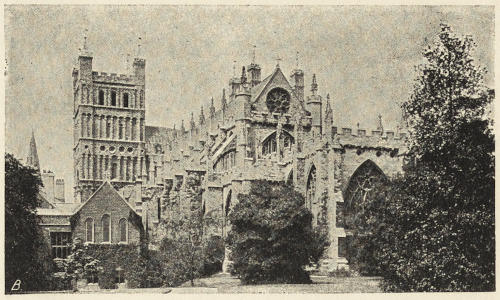
FROM SOUTH-EAST.
In the days of the so-called Heptarchy, the divisions of the Church followed those of the State. The diocese of Lichfield was conterminous with the kingdom of Mercia. In the same way the diocese of Winchester was coextensive with the kingdom of Wessex. Thus Devonshire, so far as it had been colonised by Anglo-Saxons before the eighth century, formed part of the diocese of Winchester. But these vast dioceses were too cumbrous to work. They had to be subdivided. So a western diocese was lopped off from Winchester, and a Bishop of Sherborne was appointed as its head. Then, as the far west grew in population and importance, two more bishoprics were created—those of Crediton and Cornwall. These two, however, were soon amalgamated; and Cornwall has had no bishop of its own from the Conquest till the recent formation of the Bishopric of Truro.
Just before the Norman Conquest Bishop Leofric removed the see from the open town of Crediton to the walled city of Exeter, largely in consequence of attacks of Scandinavian pirates. At Exeter Leofric found a Benedictine monastery,[77] dedicated to St. Mary and St. Peter. This conventual church he made his cathedral. “He was installed in the episcopal chair by Edward the Confessor, who supported his right arm, and Queen Eadgytha his left”; representations of which were inserted in the fourteenth-century sedilia. The Benedictine monks were removed by the Confessor to his new abbey at Westminster, and Leofric supplied their place by a body of secular canons, who lived together, however, and to some extent observed monastic discipline. Leofric was left undisturbed in his bishopric till his death, 1072. His successor, also, though a Norman, was English and conservative by training; the venerable Anglo-Saxon church was good enough for him. But William Warelwast (1107-1128) was a great building prelate, and it was he who commenced the existing cathedral. Exeter Cathedral, therefore, was commenced much later than most of the Norman cathedrals. This Norman cathedral of Warelwast seems to have been partly remodelled in the early years of the Lancet period (1194-1206) by Bishop Marshall. Later, but still in the Lancet period, Bishop Bruere (1224-1244) settled the cathedral establishment, and provided for his dignitaries a chapter-house, as well as stalls in the cathedral. In the Geometrical period Bishop Bronescombe (1257-1280) seems to have made a few changes at the east end of the choir. Then came the great builder of all, Bishop Quivil, who formed the bold idea of remodelling the whole cathedral, as left by Bishop Marshall. The work which Bishop Quivil commenced was carried out, and precisely in accordance with the original plans, by Bishops Bitton, Stapledon, and Grandisson, who completed the transformation of the cathedral about 1350. Other great prelates did good work later—especially Brantyngham, Stafford, Lacy, Bothe, Courtenay, Fox, King, and Oldham. The Bishops of Exeter were in nearly all cases men of the highest ability, rank, and importance.
Up to 1551 Exeter was one of the greatest prizes in the Church of England. It possessed thirty-two manors, fourteen[78] palaces—two in Cornwall, nine in Devonshire, one in Surrey, one in London, of which Essex Street, Strand, is a reminder. The present value of the income of the see would be at least £100,000. The first of the Protestant bishops was Miles Coverdale, who with Tyndale translated the Bible. Seth Ward (1662-1667) “cast out the buyers and sellers who had usurped the cathedral, and therein kept distinct shops to vend their wares.” In the evil days of the Puritans the cathedral had been divided into two churches by a vast whitewashed wall, built on the choir-screen and separating choir from nave. The Independents worshipped in the nave, the Presbyterians in the choir. Here they had what they called “great quiet and comfort,” till Seth Ward pulled the wall down. Seth Ward’s restoration of the cathedral cost him £25,000—representing a far greater sum nowadays. He put the cathedral in substantial repair; and the restoration by Sir G. G. Scott, in 1870, did little damage.
Nothing remains of the church of the Anglo-Saxon monastery; nor is there any Early Norman work, for, as we have seen, that church was allowed to remain standing till the year 1107. But in the first half of the twelfth century a Norman cathedral was commenced, and possibly finished, by William Warelwast and his successors. That cathedral included both the existing towers; it also included an aisled nave of the same dimensions as the present one. The narrowed span of the westernmost arches of the pier arcade is to be accounted for only on the supposition of the existence, to the west, of the wall of a pre-existing west front (cf. Lincoln nave). Also traces of Norman buttresses and pilasters, and one base, have been found in the walls of the north and south aisles of the nave. And traces of an apse have been found at the end of the third bay of the choir. So it is plain that the twelfth-century cathedral had west front, nave and aisles,[79] transeptal towers, a choir of three bays, an apse at the end of the choir, and probably some minor apses.
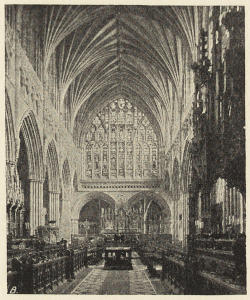
CHOIR.
Great works were commenced between 1194 and 1206; they extend over a large part of the cathedral. First, there is the doorway, early Lancet, leading from the south aisle of the nave to the cloister, near the north-west corner of the south tower; and near here, on the south wall of the nave, are several consecration crosses of Marshall’s date. Then, passing round or through the cathedral to the north side, there will be found buttresses of very early character, heavy, low, and of few stages: (1) at St. Edmund’s chapel, to the north-west of the nave; (2) to the north porch; (3) on the north side of the nave. We may conclude then, that the works included the addition to the nave of a south-east doorway, St. Edmund’s chapel, and a north porch, and possibly the remodelling of the clerestory of the whole nave. But what is more important, the choir, instead of being three bays long plus an apse, was now made eight bays long. The Norman apse was pulled down, the three bays of the Norman choir seem to have been allowed to remain. This work, especially the eastward extension of[80] the choir, represented a great amount of building. The new eastern bays of the choir were finished, at any rate as far as the springers of the vault; for it has been found that the present vault of the choir incorporates the lower part of the ribs of Marshall’s vault; this, of course, would be of simpler character, and was designed to be four or five feet lower than the present one. Similar great eastward extensions were going on all over England in the thirteenth century; especially the building of Lady chapels: there seems to have been quite an outburst of Mariolatry at this time.
Proceeding to the chapter-house, it will be found that the lower part was built in the later years of the Lancet period. To the same date belong the misereres of the choir. This bishop gave the cathedral body its present constitution: dean, precentor, chancellor, treasurer, and canons; it is natural that he should have constructed for them their chapter-house, with its fine arcade; and their stalls. The misereres, with their stiff trefoiled foliage, are the earliest set in the kingdom, and of exceptional interest. Bishop Bruere had travelled in the East, and designs in tapestry brought back by him may have been copied: e.g., there is the earliest representation of an elephant; a later one occurs at Boston; there are mermen and mermaids, and an illustration of the Romaunt of the Chevalier au Cygne; also Nebuchadnezzar saddled—unless this is the favourite subject of the weakness of philosophers before the charms of women, as exemplified in the temptation and fall of Aristotle.
The windows north and south of the retro-choir probably belong to this period. The roll-moulding appears on the principal curves only of the tracery; ever after it spreads over[81] the whole of the tracery. The lower lights of these windows are lancets; the circles in the head are cusped. The chapels of St. Mary Magdalene and St. Gabriel, on either side of the Lady chapel, seem also to have been remodelled at this time; for the side windows of these two chapels have geometrical tracery earlier than that of the Lady chapel.
And now we come to the rebuilding of the whole cathedral. In spite of the great changes that took place in Gothic architecture during the next seventy years, the original design—that of Quivil—was adhered to almost to the very last. With the exception of a few Curvilinear windows in the western bays of the nave, all the main features of the building are as they were designed in the closing years of the thirteenth century. It is, of course, this exceptional unity and harmony of design that makes Exeter what it is—one of the most satisfactory mediæval interiors in this country. In cathedrals such as Rochester and Ely a Norman nave jars on a Gothic choir; or, as at Lincoln and York, two styles of Gothic mingle and conflict. But at Exeter, looking forward from west to east, hardly anything obtrudes on the original design. In no other cathedral, except Salisbury, do we find similar unity of design; but in the design of Salisbury simplicity becomes bareness and poverty. It cannot be compared for one moment with the richness of the lovely decorated work of Exeter. Yet greater unity and harmony is gained by the way in which the battlements and pinnacles, flying-buttresses, and cresting weld together the exterior; and the high vaults the interior, as at Norwich. The adherence, too, for so long a time to Bishop Quivil’s design is interesting, because it shows that in the early years of the fourteenth century there was at Exeter, as at Beverley, Westminster, Ely, and St. Albans, a strong current in the direction of conservation of good design. Piers and vaulting and bosses and corbels and[82] triforium and windows of the nave, built long after he was dead and gone, are all but reproductions of Quivil’s early work. Most remarkable of all, perhaps, is the adherence to Quivil’s window tracery—the rose, the lily, and the wheel. Even the great west window, one of the last works, is but Quivil’s straight-spoked wheel translated into flowing lines.
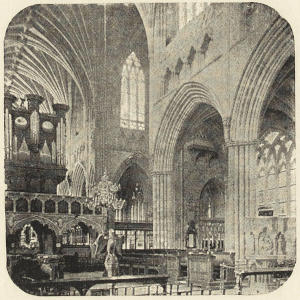
CHOIR AND TRANSEPT.
Quivil commenced his work in the two Norman towers, in which he inserted tall arches, thus making them an integral part of the church. He also built the arches of the crossing, and provided abutment to the west by building one new bay on either side of the nave. All that one sees here—the first bay of the nave, and the alterations in the transepts, the window tracery, the piers and arches, the pierced balconies hung up on the walls of the towers, the substitution of Purbeck marble for stone shafts—is Quivil’s work. As to the easternmost bay of the nave on either side, it differs from the rest of the nave in having a wider arch; while its clerestory windows have the same straight-spoked wheel as Quivil’s windows in the transept; the mouldings of the capitals of the first two piers correspond with those of the transeptal arches; the bases are lower than those elsewhere in the nave; the bosses of the aisles are flatter; even the flying-buttresses differ.
Now that he had remodelled the centre of the church,[83] Quivil set to work to recast the eastern parts of the church, commencing at the far east end, so as to interfere with the services as little as possible. He first transformed the Lady chapel; to him are due the shafts, sedilia, double piscina, and the vaulting, the rib-mouldings of which are of earlier character than those of the choir; and the windows, which closely resemble those of Merton College, Oxford, which we know was commenced in 1277. In the centre of the Lady chapel Bishop Quivil is buried; he died in 1291. The chapels on either side may have been remodelled or partly remodelled by Bronescombe; but the east windows are later in style, and are Quivil’s.
The piers hereabout are very interesting. Those of the Lady chapel looking into the side chapels are composed of four columns. The north-east and south-east piers of the choir have clusters of eight shafts instead of four; while in the pier between them the cluster of eight is developed into a cluster of sixteen columns. Finally, notice that these piers are set diamond-wise, with four flat faces, and the angles to the north, west, south, and east.
Bishop Quivil had only touched the fringe of the choir, but he must have collected much material for its transformation; for his successor completed it, even the vaulting, in fifteen years—the last fifteen years of Edward I. It seems to have been done in two sections; first, the four eastern bays of Bishop Marshall’s work, then the older bays to the west. It is clear that the builders took away both piers and arches from underneath Bishop Marshall’s clerestory wall, and put in new ones, without bringing the wall down—a kind of engineering feat which the mediæval builders undertook with a light heart. The new piers all consist of “vast horizontal slices of Purbeck marble, from nine to fifteen inches thick”; the arches of native sandstone. These immense marble piers[84] give the interior of Exeter a magnificence rare in England, only to be paralleled by the marble churches of Italy. The colour-contrast, too, between the blue-grey marble of the piers, the yellow sandstone of the arches, and the white Caen stone above, is delightful. The mouldings of Bitton’s work are clearly distinguishable from those of Quivil, and were retained, with little variation, to the west end of the cathedral. Bitton got himself into some curious difficulties by retaining instead of pulling down the twelfth and thirteenth-century clerestory walls. The first of the two, the western, was the thicker wall. Hence the piers to support it had to be thicker: they exceed the eastern piers in diameter by nine inches. But by bringing both eastern and western piers to the same line facing the central aisle of the choir the difference of nine inches appears only in the side-aisles, where it is less noticeable. Again, the length of the western bays was 2½ feet greater than that of the four eastern ones. When, therefore, Bitton set out the seven eastern pier-arches there remained an awkward gap of 2½ feet between the last arch and the great pier of the crossing. This he bridged over by the tiny arch which appears at the extreme west of each arcade of the choir, the incongruity of which was largely masked later by the great choir-screen. He seems to have worked to the middle of the choir—first from the east, then from the crossing. When, however, the two sets of arches met, they did not fit, and the clumsy junction had to be botched over by the aid of a stilt.
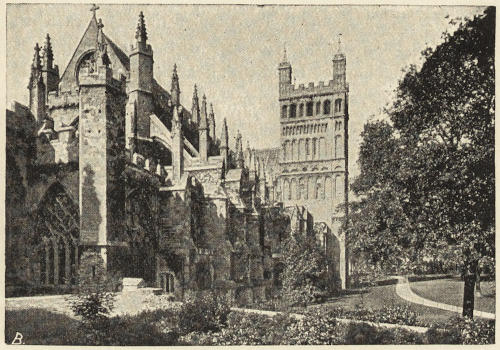
FROM NORTH-EAST.
But though the remodelling was complete, even to the vaulted roof above, the choir was all naked and bare; and the next bishop set himself, not to carry the work into the nave, but to complete the equipment of the choir. In one respect Bitton’s choir was weak in design: it had a triforium in the choir bays (the four to the west) but not in the bays of[85] the sanctuary. Bitton’s eastern clerestory windows were splayed down till they rested on the summits of the new pier-arches; to the same line were continued downward the shafts in the jambs of his windows. This diversity of treatment of the two halves of the choir must have had a most discordant effect; and Stapledon corrected it very cleverly by adding a triforium to the east in such a way that though the eastern arcading is not so deep as the western, yet in perspective the difference is hardly noticed. Probably the next thing was to glaze the remainder of the sixty choir windows, only eighteen of which were filled with stained glass at Stapledon’s accession. It seems likely that nearly all the stained glass for the choir and the transepts came from abroad—from Rouen. For the nave, later on, the place of the laity, English glass, cheaper and not so good, was thought sufficient. The glass was inserted by Walter le Verrouer (he has descendants still living in Exeter), at the moderate price of 6s. for a fortnight’s work, of himself and “two boys,” for one pair of clerestory windows. Hitherto the clergy had sat in the transept and the western bays of the nave; now, as in many other cathedrals,[86] the stalls were moved into the western bays of the choir. (The present canopies of these stalls are modern.) Next came the Bishop’s throne (A.D. 1316), intended for his Lordship with a chaplain on either side; “a magnificent sheaf of carved oak, put together without a single nail, and rising to a height of 57 feet. The lightness of its ascending stages almost rivals the famous ‘sheaf of fountains’ of the Nuremberg tabernacle. The cost of this vast and exquisitely carved canopy (about twelve guineas) is surprisingly small, even for those days. The carved work consists chiefly of foliage, with finials of great beauty, surmounting tabernacled niches, with a sadly untenanted look, however, for lack of their statuettes. The pinnacle corners are enriched with heads of oxen, sheep, dogs, pigs, and monkeys.” Next came what is perhaps the most exquisite work in stone in England, as the throne is unparalleled in woodwork—the sedilia; the seats of the priest to the east, and to the west of him, those of the Gospeller and Epistoler. These sedilia have been preferred even to the shrine of Beverley and the Lady chapel of Ely. “The canopy of the seat nearest the altar,” says Mr. Garland, “deserves particular attention. It is adorned with a wreath of vine leaves on each side, which meet at the point and there form a finial; and never did Greek sculptor, of the best age, trace a more exact portrait of the leaf of the vine, nor design a more graceful wreath, nor execute his design with a more masterly finish.” It is regrettable that the carving of the sedilia is attributed to a Frenchman. Then came the great work of all—the high altar, with its reredos, perhaps the most magnificent in Europe; the cost of it would amount now to £7,500. Of this not a fragment remains. Finally, the choir was closed in with a great screen to the west, from which was read the Epistle and Gospel, as in the two ambos of the early Christian basilicas. And on it was placed an organ; the ancient and best position for a cathedral organ. The accounts show that 500 lbs. of iron bars were used to hold the screen together. This concluded Bishop Stapledon’s work, except that he[87] built a cloistered walk as far as the doorway of the chapter-house. “The cathedral of Exeter,” as Stapledon’s successor wrote to the Pope, “now finished up to the nave, is marvellous in beauty, and when completed, will surpass every Gothic church in England or in France.” Stapledon died in 1327. The completed choir was consecrated by Bishop Grandisson in 1328.
Grandisson was “the most magnificent prelate who ever filled the see of Exeter.” He had been nuncio to the Pope at the courts of all the noblest princes of Christendom. He was even strong enough to bar the way to Archbishop Meopham, of Canterbury, when he attempted to enforce a Visitation of the cathedral. Great as were his riches and magnificence, he was a strict economist. He lived forty years Bishop of Exeter; finished his cathedral, did many great works elsewhere, and yet died wealthy. Quivil, we have seen, had built one bay of the nave. It remained for Grandisson to complete the remaining seven bays. The piers of the nave were erected by 1334; the whole work was complete in 1350. Stapledon had commenced the Cloister; Grandisson built the north walk, running, in curious fashion, under a second and outer range of flying-buttresses, as does the cloister of Westminster. The west front (except the west screen) was now built, but not the fan-vaulting of the north porch, which is later. And the curious Chapel of St. Radegunde in the thickness of the west wall he remodelled, to form his mortuary chapel, expecting there ever to lie, looking towards the nave where his great work had been done. But his tomb was destroyed by Elizabeth’s Visitors, and his ashes were scattered to the winds.
As we stand near his empty grave, we see before us the whole of the great mediæval design, that was due in inception to Quivil, and was realised and consummated by Bitton, Stapledon, and Grandisson, in the seventy years between 1280 and 1350. What strikes one, first, is that with revenues[88] so immense, the bishops should have been satisfied with a cathedral so small—its area is less than half that of York. On the other hand, at York, owing to the vast dimensions of the new cathedral, commenced simultaneously with the new work at Exeter, the builders were unable to roof it in stone.
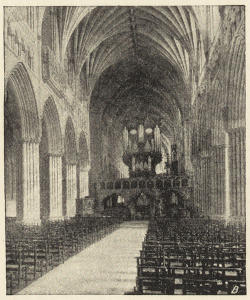
NAVE.
Secondly, one wonders that they allowed their hands to be fettered, their design to be cramped, by the preservation not only of the aisle walls, but of the clerestories of Warelwast and Marshall’s cathedral. But it is just in the subjugation of these limitations, in converting them into the special glory and distinction of the Exeter design, that the genius of Quivil’s architect shines forth most vividly. He was limited by the area of the old cathedral, east to west, north to south: not even the tiny transepts might be enlarged. But what was more serious, he was limited as to height. He was unable to raise the vaulting or the pier-arches more than five feet. His internal elevation, then, for a Gothic church of 1280, had to be exceptionally low. He determined, therefore—it was an intuition of genius—to see what could be done in architecture with lowness and breadth. Everything should be broad and low, outside as well as inside. Look at the east end of the choir—its two arches broad and low; above it, the great window—broad and low. Nowhere but at Exeter do you find these squat windows with their[89] truncated jambs; here they are everywhere—in the aisles, in the clerestory, in choir, chapels, transepts, and nave; even in the great window of the western front: broad and low windows everywhere.
Still more original is the external realisation of the design; central tower and spire, western towers and spires, alike are absent. Long and low, massive and stable, stretches out uninterruptedly the long horizontal line of nave and choir. Breadth gives in itself the satisfactory feeling of massiveness, steadfastness and solidity; and this is just what is wanting in the all-too aerial work of Salisbury and Beauvais; vaulted roofs at a dizzy height resting on unsubstantial supports and sheets of glass. But the Exeter architect has emphasised this satisfactory feeling of stability still further. The window tracery is heavy and strong; the vault is barred all over with massive ribs; in the piers there are no pretty, fragile, detached shafts; the massive clustered columns look as if they were designed, as they were, to carry the weight of a Norman wall.
But an interior may easily be made too massive; if it is not to be a Salisbury cathedral, it need not be a Newgate Gaol. How was the prison-like appearance of an interior but 68 feet high, with a stone vault of exceptionally heavy appearance weighing it down, to be avoided? How was oppressive heaviness to be counteracted? Triumphantly, by transparency. By stretching out the windows from buttress to buttress, aisle and clerestory became practically one continuous sheet of glass; the church was flooded with light and atmosphere; the heavy vault seemed to float in the air, borne up but by the lilies and roses and wheels of the window tracery, and rows of painted saints in tabernacles of silver or of gold. There is no heaviness even now in the interior of Exeter; though the silvery panes of the choir, the golden glass of the nave, have perished long ago.
Another distinctive feature in Exeter, as in Salisbury, is that the architect produces his effect mainly by architectural[90] means—is not driven to rely on sculpture. All the principal capitals have mouldings, not foliage. Only in the great corbels of the vaulting-shafts and in the bosses of the vault, does he permit himself foliage and sculpture. Wonderful carving it is; the finest work of the best period, when the naturalistic treatment of foliage was fresh and young. Very remarkable these corbels are, with their lifelike treatment of vine and grape, oak and acorn, hazel leaf and nut. Unfortunately the corbels, and still more the bosses, are so high up that their lovely detail is thrown away; and they are out of scale.
And the patterns of the window tracery are wonderfully diverse. It is not, as in Lichfield nave or King’s College Chapel, where every window is like its neighbour; when you have seen one, you have seen all. Here, all down each side of the church, every window differs. In dimensions, in general character, they agree; in details they differ; each window is a fresh delight; we have what even in Gothic architecture we rarely get—diversity within similarity.
Another striking feature of the design is its perfect bilateral symmetry. Gothic churches are, as a rule, most irregular, most unsymmetrical in outline; as a consequence, very picturesque. It is a mistake, however, to believe that they are intentionally unsymmetrical and picturesque. A Gothic architect no more aimed at irregularity than did the architect of the Parthenon. Only he was not a purist on the subject. If practical requirements—e.g., the needs of ritual—made it necessary to break in on the lines of a symmetrical design, he broke in on them without the slightest hesitation; the building had to conform to its destination. But where a single design was carried through from end to end, it was as symmetrical as a Classical temple. So it is at Salisbury; so it is at Exeter. Every window has its exact counterpart on the other side of nave and choir. Transept answers to transept, screen to screen, St. John the Baptist’s chapel to St. Paul’s, St. Andrew’s chapel to St. James’, St. George’s[91] chapel to St. Saviour’s, St. Mary Magdalene’s chapel to St. Gabriel’s. But the architect was not so infatuated with the idea of symmetry as to place a porch on the south side because there was one on the north, or a chapter-house on the north because there was one on the south; which is just what the academic professors of Classical architecture would have done.
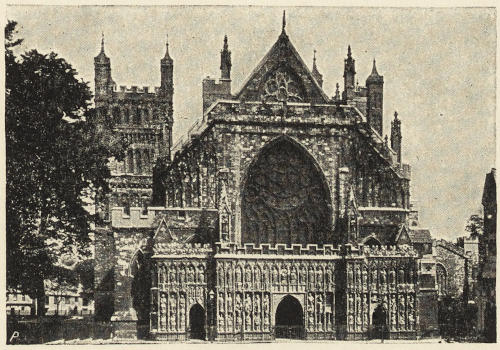
WEST FRONT.
We have seen how the design gained special distinction from the very limitations imposed by the lowness of the early cathedral, the upper parts of which it was desired to preserve. It was again to the early design that Exeter owes another distinction among English interiors. In the early design the towers were just those which we still see; there was no central tower. The very fact that Quivil’s architect did not rush off at once to build a central tower, and be like everybody else, shows what backbone and insight the man had. Cathedrals without central towers were as rare in mediæval England as cathedrals with central towers are rare in the Île de France. Yet he advised his employers—or was it they who instructed him?—not to build a central tower. Central[92] towers, standing as they do on four thin legs, are dangerous: many have fallen; others are always threatening to fall—e.g., Salisbury. But they are objectionable on another ground. The great piers on which they stand are an enormous block in the lengthened vista, which is the one great charm of an English cathedral, as compared with the lofty but short cathedrals of France. The fact that there is no tower over the crossing, and no tower-piers in the way, produces the most open, uninterrupted, and impressive vista of any cathedral in England. The screen being low, one sees the whole noble design in one glance from far west to far east. We have nothing like it: though it finds its counterpart in the great French cathedral of Bourges.
Another point should be noticed. Although the nave is in nearly all important respects of late Geometrical design—the exception being some Curvilinear windows with flowing tracery in the westernmost bays of the nave—yet the architects were not such purists as to carry out their minor work in anything but the style of their own day. Even in the choir, the architecture of which is Geometrical both in character and in date, all the minor work is developed Curvilinear—e.g., the great screen with its depressed ogee arches, the throne of the bishop, the sedilia.
Perpendicular Work (1360-1485).—Much minor work remained to do. In the remaining years of the fourteenth century the west front, which seems to have been heeling over, was buttressed by the erection of the western screen. The west and south walks of the cloisters were added. The great east window was substituted for an earlier Geometrical one which seems to have fallen into decay. In the fifteenth century the towers were crowned with battlements and turrets, as we see them now. The upper part of the chapter-house was rebuilt. Bishop Stafford erected canopies over monuments in the Lady chapel.
Tudor Work (1485-1519).—The Tudor work is exceptional in importance. It includes the north entrance and[93] other late portions of the western screen, two exquisite chapels, both built by Bishop Oldham—his own chantry (St. Saviour’s) on the south side of the retro-choir, the Speke chantry (St. George’s) on the north—and in addition, Prior Sylke’s chantry in the north transept. All this work is admirable in design and execution. In Oldham’s chantry is a charming series of owls, with the scroll DAM, a rebus on his name, proceeding from the beak of each little owl. To Bishop Oldham also (1504-1519) is due the grand set of stone screens—one of the glories of the cathedral—no less than ten, which veil all the nine chapels and Prior Sylke’s chantry, and add fresh beauty to the beautiful choir.
Whatever else, then, the student and lover of Gothic architecture omits, he must not omit to visit Exeter. He will find it fresh and different from anything he has seen before. Its unique plan, without central or western towers, the absence of obstructive piers at the crossing, the consequently uninterrupted vista, the singleness and unity of the whole design, the remarkable system of proportions, based on breadth rather than height, the satisfying massiveness and solidity of the building, inside and outside, and at the same time the airiness and lightness of the interior, the magnificence of its piers of marble, the delightful colour-contrast of marble column and sandstone arch, the amazing diversity of the window tracery, the exquisite carving of the corbels and bosses, the abundant and admirable Tudor work, the wealth of chantries and monuments, the superb sedilia, screen, and throne, the misereres, the vaults, the extraordinary engineering feats from which its present form results, the originality of the west front and of the whole interior and exterior, place Exeter in the very forefront of the triumphs of the mediæval architecture of our country.

NAVE.
The foundation of Gloucester, like that of Ely, has gone through many changes. In 681 it was founded as a nunnery, and remained so till 767. About 821 it was refounded for secular priests; who, in the time of Canute, through the influence of Dunstan, were replaced by Benedictine monks. It remained a Benedictine monastery till 1541, when it was placed on the New Foundation, thus reverting to secular priests once more. The abbey-church then became a cathedral, with a diocese carved out of that of Worcester.
The present cathedral is recorded to have been commenced by Abbot Serlo in 1088, and to have been completed and consecrated in 1100. This statement seems to be generally accepted; but the chief evidence for it, as for the architectural history of the cathedral generally, is the chronicle of Abbot[95] Froucester. Froucester, however, lived two hundred years after the foundation of the Norman cathedral, and his authority on this point can hardly be considered decisive. The plain architectural facts tell a very different tale. In the first place, the design of the nave and presbytery is totally different; the presbytery is archaic and rude, the nave highly advanced in design and elaborate and rich in ornament. The former may well belong to the last decade of the eleventh century; the latter is a whole generation later. In the presbytery the piers are low and of enormous bulk—such vast wasteful blocks of masonry as are to be seen in the nave of St. Alban’s, the choirs of Hereford and Chichester and Norwich: all of them commenced in the eleventh century. In the nave of Gloucester the piers rise to the exceptional height of 30 feet; for a parallel one must go to Tewkesbury, which was not consecrated till 1121; and even that consecration does not necessarily include the nave, where alone these towering cylinders are found. Again, in the presbytery of Gloucester the pier-arcade and triforium are about equal in height. So they are also in the eleventh-century work of Winchester, Norwich, and elsewhere. The diminutive triforiums of the naves of Gloucester and Tewkesbury are without a parallel in English work, though the Abbaye-aux-dames at Caen may be quoted on the other side. Again, the pier-arches of the presbytery are in two square orders, and the vault of the aisle is unribbed. In the nave the orders of the pier-arches are enriched with pairs of rolls and zigzag; the vault of the north aisle has diagonal ribs of late Norman character; and the string-course of the clerestory is a twisted cable elaborately enriched. The aisles, too, are very broad and very lofty.
Indeed, everything in the presbytery has an early look, except its plan and the shape of its apses. The plan is exceedingly complicated; with apse, ambulatory, and radiating chapels. But all three features appear in the ancient church of Vignory, which cannot well be later than the middle of the eleventh century. The radiating chapels, indeed, go[96] back to the very earliest days of Christian architecture; for they formed part of the Basilican church of the Holy Sepulchre at Jerusalem, as built, A.D. 326, by the Emperor Constantine; and have survived all the transformations which that church has undergone. That the apses, indeed, should not be semicircular—as they are even in St. Hugh’s choir of Lincoln—but polygonal, is certainly startling; though here also there are precedents as far back as the sixth century, in such Byzantine churches as that of S. Apollinare in Classe, near Ravenna. In the nave, on the other hand, everything points to a date well advanced—certainly not earlier than 1122. Not only the loftiness of the columns, but the fact that they are columns, is a mark of twelfth-century work. The column does not occur in Normandy, the mother of our Romanesque; but everywhere the compound pier. Capital and abacus, too, are circular on plan; this is usually a sign of late Norman work. The nave of Southwell, which also has circular capitals and abaci, was not built before 1120. But the ornamentation of the nave is decisive: the zigzag and the cables could not have been executed in the days of Prior Conrad of Canterbury, before the chisel had come into use.
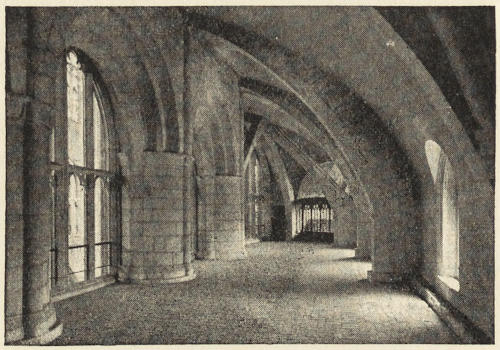
TRIFORIUM OF APSE.
Something, however, was consecrated at Gloucester in 1100;[97] and that was probably the eastern arm of the church—not necessarily the chapels—and as much of the rest of the church as was necessary to complete the enclosure of the monastery: viz., part of the north transept and the wall of the north aisle of the nave as high as the sills of the windows. Then the monks probably turned their attention to the domestic buildings of the monastery, which till now may have been temporary buildings of wood, and only some twenty years later resumed work in the church, which they then completely finished.
Perhaps the first thing to do would be to add the top storey to the presbytery; for a church seems not unfrequently to have been consecrated before its clerestory was built, a temporary roof being erected at the level of the triforium. The presbytery being at last really completed, the monks would then proceed to complete the transepts and the crossing, to build the lower stage of the tower, and the nave and west front. When they did reach the nave, they altered the design altogether; as did the Tewkesbury monks also. They put up naves of the worst possible proportions; with piers so lofty that triforium and clerestory were almost squeezed out of existence.
Both have, of course, been credited with some artistic motive. To me it seems that they had found the choir, with its squat pier-arches, intolerably dark; and when they reached the nave, they saw that if they adhered to the early design, the nave would be even darker than the choir. For on the north side the cloister abutted on the aisle-wall, whose windows therefore had to be placed very high up in the wall: giving hardly any light to aisle and nave. To remedy this, therefore, regardless of appearances—for mediæval architects were practical builders first, artists only afterwards—they put up these colossal columns 30 feet high, raising the arches nearly 40 feet above the pavement. In that way the light from the high windows of the north aisle was enabled to penetrate into the church.
Another very remarkable feature in the design of the eastern[98] limb is the utilisation of the triforium. In many churches—e.g., in Beverley and Lincoln minsters—the triforium seems not to have been intended to be used. At Beverley it is walled off from the nave; at Lincoln it has no floor. But in the earlier churches some ritualistic use must have been made of it. At Winchester, Ely, and the Abbaye-aux-hommes at Caen, return-aisles were constructed at the ends of the transepts to provide a broad path by which processions might pass along the triforium from the choir, round the transept, to the nave.
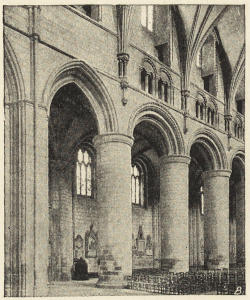
NAVE.
At Gloucester one step further is taken. All the five apses are built two stories high, the upper story of each opening into the triforium: so that five additional chapels are gained for the church. Moreover, since the crypt passes beneath all five apses, another set of five apsidal chapels is obtained underground; so that, without taking into account chapels otherwise arranged for, Gloucester possesses in the minor apses alone no less than fifteen chapels. In fact, leaving out of account the central aisle, Gloucester presbytery is really three churches—an upper, middle, and lower church. The amount of accommodation gained by this ingenious planning is immense.
One wonders that the plan of radiating chapels and practicable triforium was not adopted more frequently. It occurred at Tewkesbury and at Leominster; but in the end it was superseded by the eastern transept thrown across the choir centrally,[99] as at Lincoln, or at its eastern termination, as at Fountains. In Lincoln choir, St. Hugh’s architect, hesitating between two opinions, built eastern transepts as well as return-aisles and apsidal chapels.
For nearly a century the architectural history is a blank. Early in the thirteenth century the wooden ceiling of the nave was replaced by the present quadripartite vault. This involved the demolition of the Norman clerestory, except the jambs of its outer arches, which may still be seen, enriched with zigzag. The north chapel of the crypt also was vaulted, and two windows were inserted in the eastern chapel of the crypt. About the middle of the century were built the north doorways of the cloister, and the vaulted passage in its north-east corner; also part of the west front of the nave was reconstructed. A little later was built, now moved to the north transept, the reliquary (or perhaps it is a gateway), one of the most lovely designs of the thirteenth century, worthy to be put in comparison with the Beverley staircase and the western porches of Ely and St. Albans. Of the time of Henry III. is the oak effigy of Robert Courthose, Duke of Normandy, eldest son of the Conqueror (d. 1135), which lies on a wheeled chest of the fifteenth century, and was formerly placed in the centre of the choir. On the whole, there was not much to show at Gloucester, with the exception of the nave-vault, for the long period 1150 to 1318.
But about the latter year the Norman south aisle of the nave had got into a very dangerous condition. The north aisle was safe, its wall being propped up by the cloister roof. But the vault of the south aisle had thrust the wall eleven inches out of the perpendicular. To save the vault, Abbot Thokey built on to the Norman pilasters the present beautiful buttresses. But the new buttresses also swung over four inches, and the Norman vaulting had to be taken out; the aisle received a new vault, and its eastern bays were enriched with ball-flower. The beautiful windows are of late Geometrical character, and are smothered in ball-flower. The profuse employment of[100] ball-flower is quite a characteristic of the fourteenth-century Gothic of the West country; it is equally remarkable in the grand windows of Leominster, and at Ledbury and Hereford. “A horizontal line drawn just below the spring of the arch of each window at Gloucester cuts through thirty-two bands of ball-flower.” There are no less than 1400 ball-flowers in each window.
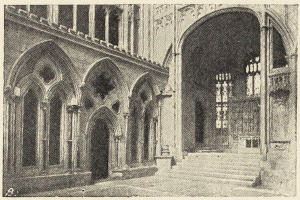
RELIQUARY.
In 1327 Abbot Thokey made the fortune of Gloucester abbey. On September 21st Edward II. had been murdered at Berkeley castle. Bristol, Kingswood, and Malmesbury monasteries were appealed to, but none dared receive his body for interment, fearing the anger of the Queen and her party. Abbot Thokey brought the body to Gloucester in his own carriage, and caused it to be solemnly buried in the presbytery. Soon miracles were wrought at the tomb, pilgrimages set in, immense sums were contributed in offerings; Gloucester, like Hereford, had got a saint, and, like Hereford, used the vast income that accrued—enough, it is said, to have erected a brand-new cathedral—in improvements in their abbey-church. The tomb of the murdered king, erected by his son, Edward III., still exists, and the leaden coffin below, in which, when opened in 1855, the body was found “in a wonderful state of preservation.” (We wonder what would be said if our antiquaries exhumed the bodies of George III. and Archbishop Benson, and stole their rings and vestments to put them in a show-case in the vestry.) On one side of the monument, facing the aisle, is the bracket on which offerings were laid; above is one of the loveliest Curvilinear canopies in existence, but much restored. To the[101] same period belong various windows inserted in the aisles and chapels and triforium of the presbytery.
The monks, no doubt, with the rich revenues now at their disposal, would have liked to rebuild the presbytery de novo. But it was crowded every day and all day with the pilgrims from whom the money came. They had therefore to confine themselves to such improvements as could be effected without interfering with the flow of pilgrims and of cash. The first thing needful was to provide more light: above all, in the presbytery, where the centre of attraction was; and in the crossing, where their daily services were held. Secondly, the church had suffered severely from fire in 1088, 1102, 1122, 1179, and 1190. The nave had already been safeguarded against fire by vaulting; it was desirable to extend the same protection to the transepts and presbytery by covering these also with stone vaults. Thirdly, if the money held out, it might be spent in prettinesses.
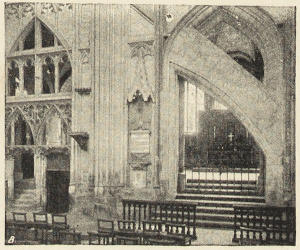
TRANSEPT.
First, there was the lighting problem. Abbot Thokey had done a good deal in improving the lighting of the south aisle of the nave, and the aisles and chapels and triforium of the presbytery. Abbot Wygmore commenced operations in the south transept. The north transept was in daily use, as the cloister was on the north side of the nave, and the monks passed through the north transept to their daily services in the crossing. The improvements in the presbytery were postponed for a time, so as not to interfere with the pilgrims. In six years, before 1337,[102] Wygmore is recorded by Froucester (who was himself Abbot from 1381 to 1412) to have cased, lighted and vaulted the south transept.
If Froucester is correct—and his evidence is almost that of a contemporary—we have in the south transept of Gloucester one of the greatest puzzles in the history of mediæval architecture. The whole of this work in the south transept is in the Perpendicular style—early Perpendicular, but still Perpendicular in principle. Yet we have to believe that it is contemporaneous with the utterly different Curvilinear work that was being done everywhere else in England; that it was contemporaneous with the Curvilinear monument of Edward II. in Gloucester itself; with the Percy shrine at Beverley, with the Lady chapel, octagon, and choir of Ely. It seems incredible. But Gloucester presbytery was not taken in hand till after the south transept, and it was finished not later than 1350, if that be the true date of the glass of the great east window. No other Perpendicular work occurs in the kingdom till that of Edingdon church (1352-1361), and the work done by Bishop Edingdon in the western part of Winchester nave. So that, if we accept Froucester’s statement, we have to believe that while the rest of the world was executing Curvilinear designs, the Gloucester masons, not later than 1330, had worked out the Perpendicular style.
We have to believe, also, that though this style ultimately became universally popular in England, overspread the whole country, and maintained its hold on English architecture for three centuries, at the outset it smouldered at Gloucester, unnoticed, unappreciated by anybody, till Edingdon took it up twenty years later in rebuilding the church of his native village. All the other improvements in mediæval building were caught up instantaneously—passing from one end of the kingdom to the other with the rapidity of the fashion of a Paris bonnet or mantle. England hesitated long before it could consent to exchange the richness of Curvilinear for the baldness of Perpendicular design. However, the new[103] design of Gloucester, blazoned abroad everywhere as it was by admiring pilgrims, showed the capacities of the new style. It was seen to be sound and strong from a building point of view—and cheap. That turned the scale. Perpendicular came in with a rush. So,
the Royal and Ancient game of golf smouldered on for[104] centuries at Blackheath, till the psychological moment came, and it passed on to Westward Ho, and then swept like wildfire over all England.
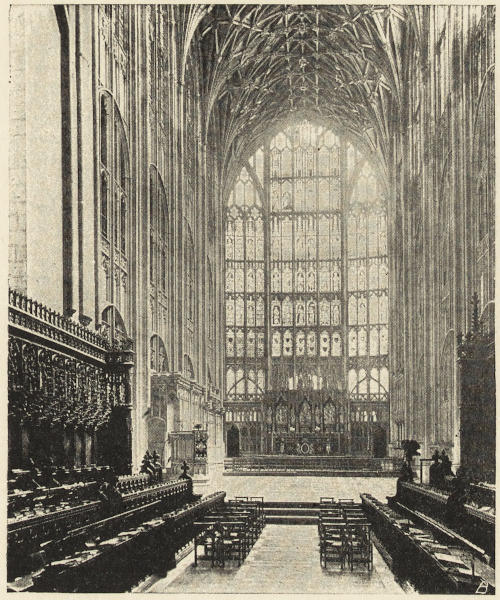
CHOIR.
The first question the monks had to decide was that of lighting. Their answer was a momentous one. They decided to get additional light by raising the walls of transept and presbytery, and inserting immense clerestory windows. The nave was internally 67½ feet high. To get a big clerestory, they raised the south transept and presbytery to the height of 86 feet. Similar tall clerestory windows were being built, but in the Curvilinear style, in the choirs of Lichfield and Wells. But as yet clerestory windows were, as a rule, rather small; and some big churches of the Curvilinear period, such as Grantham and Patrington, had no clerestory at all. For what was to be the glory of the closing days of English Gothic architecture—the Lantern type of church—we must give the credit to the masons of Gloucester. And also for the new type of window. The new big window, occupying the whole breadth and nearly the whole height of the end wall of the south transept, had to be strengthened by cross-bars or transoms; and the tracery of the head had to be strengthened by the substitution of vertical straight lines, as far as possible, for curves. Here, then, we have the genesis of the Perpendicular or Rectilinear window.
Then there was the question of the vault. If we can believe Abbot Froucester, so early as 1337 the monks put over the south transept not only one of the earliest lierne vaults in the kingdom, but one so accurately worked that the junctions of the ribs did not require to be masked by bosses: they mortised the ribs together with as much precision as if they were dealing with joints in cabinet work. And over the choir and under the tower they put up the most amazingly complicated lierne vault that was ever constructed: this, too, not later than 1351.
Thirdly, they appear to have intended to separate the presbytery from its aisles by the usual stone screens—designed[105] to correspond with the tracery of the clerestory windows. This would have left an ugly cavernous arch—that of the eleventh-century triforium—in each bay, between the screen below and the clerestory above. The pattern of the tracery of the clerestory window had been repeated once in the screen below: what more natural than to repeat it a second time in the shape of a screen set in front of the open arch of the triforium? It remained merely to join up the mullions of all three—lower screen, triforium screen, and clerestory window—and the three members were welded together into one composition; harmony and unity reigned from pavement to vault. Here again we have at Gloucester not only the commencement, but the full development of what became the leading principle in later English Gothic—the desire to impose unity on the elevations of their churches by repeats of window tracery. It is but a short step from Gloucester choir to St. George’s, Windsor. The only improvement that was made on the design of the Gloucester choir was that in the next century, when fan-vaulting came into vogue, this also was covered all over with the patterns of the window tracery.
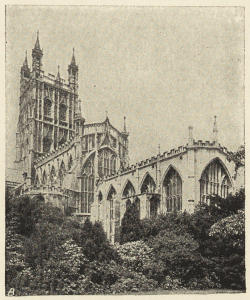
FROM SOUTH-EAST.
One question still remained unsolved: how to treat the east end of the church. At Norwich, where the Gloucester precedent was largely followed a century later, the apse and[106] ambulatory and chevet of chapels were all retained—with most beautiful effect. At Gloucester—unfortunately, as it seems to me—they pulled down the apse; and on the wall of the three eastern bays of the ambulatory they erected three gigantic windows, so welded together as to compose one window. And, to bring the whole into view, they made the new easternmost bays of the presbytery, which had now to be built, wider to the east than the west. Thus they got one of the biggest windows in the world, and one of the ugliest. However, no one looks at the tracery of the window, but at the painted glass which it still retains. This glass is decidedly Perpendicular in character, but the armorial bearings in it show that it was completed before 1350. All the characteristics of late Gothic glass are there. Thus the canopies and the figures alike are silvery white, and yellow stain is introduced here and there. The drawing, however, is shockingly bad; and the colour is got in a very artless way by inserting backgrounds of vertical stripes of red and blue.
At the same time—between 1337 and 1377—the monks were provided with new choir-stalls. But while stone-work and glass alike are Perpendicular in character, the stalls have bowing ogee canopies, and are quite Curvilinear.
Next the north transept was remodelled (1368-1373). It is very much like its brother, but is eight feet higher, and the vault has bosses.
The next work was the rebuilding of the cloister. This was built between 1351 and 1412. It is covered with a fan-vault, supposed to be the earliest example of the kind. But the supports look as if designed for a lierne vault. It is possible, therefore, that the earliest fan-vaults are those of two monuments in the neighbouring Abbey-Church of Tewkesbury. In the south walk are twenty “carols” or “studies” for the monks; in the north walk a lavatory and a recess for towels.
Between 1421 and 1437 Abbot Morment was guilty of the west front and the two western bays of the nave. He intended to rebuild the whole nave, but could not make up his mind[107] how to do it. The two bays he did build are quite different in height and span and general design. With his big west window, and with the insertion of Perpendicular windows in the north aisle and in the clerestories of the nave, the improvement of the lighting of the church may be said to have been effectually completed.
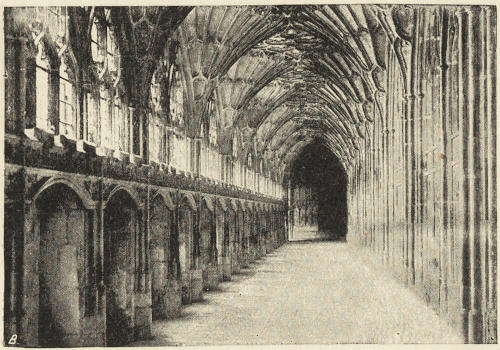
CLOISTER.
Instead of going on with Abbot Morment’s rebuilding of the nave, the monks now turned their attention to the central tower. The tower was of no use as a lantern, for the lierne vault of the choir had been carried beneath it. So it long remained unaltered. But in the days of Abbot Seabrooke (1460-1482) it was rebuilt under the superintendence of a monk named Sully, to be in character with the new exterior of choir and transepts. A very imposing tower it is; fully able, from its massiveness as well as from its height, to gather together the masses of the building—all the more so because the transepts are so short. It succeeds where the central towers of Worcester and Hereford fail; in fact, it is as effective in its way as Salisbury spire. The pinnacles, again, bear[108] witness to the love of these later artists for harmony and unity: each pinnacle, with its two ranges of windows, is a repeat of the two stages of the tower below.
Then—after the tower had been erected—it was decided to rebuild the Lady chapel. So an immense detached building was constructed to the east of the great window of the presbytery; without aisles, but with little transepts; almost one continuous sheet of glass, and with a superb vault. This Lady chapel had to be joined up to the presbytery, but the great east window was in the way. However, the difficulty was got over by a series of ingenious shifts and dodges, which must be seen to be appreciated (1457-1499).
And so ended this great building-period at Gloucester (1330-1499), which turned the course of English architecture; so that the Curvilinear style of 1315 to 1360 did not find its natural development in Flamboyant, as on the Continent, but was switched off to Perpendicular and Tudor design.
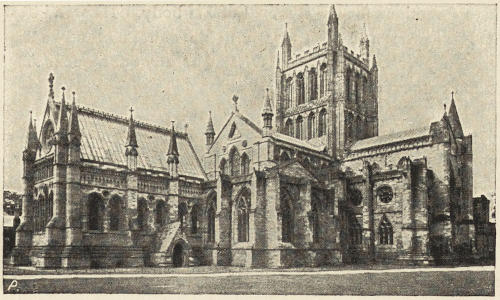
FROM NORTH-EAST.
Hereford boasts a cathedral which, though one of the smallest, is, both externally and internally, one of the most picturesque in the country. To the archæologist and the architectural student, its mélange of styles makes it a perfect treasure-house of mediæval design: early and late Norman, Transitional, Lancet, early, middle, and late Geometrical, Curvilinear, Perpendicular and Tudor work are all well represented in the structure, to say nothing of the Gothic of Wyatt, Cottingham and Scott.
Hereford is one of the oldest of all the sees, going back, at any rate, to the year 601, when St. Augustine had a conference with the Welsh bishops. It owed its riches and reputation mainly to two saints, King Ethelbert and Bishop Thomas Cantilupe. In the year 792 the great King of Mercia, Offa, inveigled Ethelbert, King of East Anglia, to the west of England, where he was treacherously murdered. “On the night of his burial, a column of light, brighter than the sun, rose to heaven;” three days later his ghost appeared and[110] gave directions for the removal of his body. He was interred at Hereford; and in 825 “a noble church of stone” was erected over his remains. Of this or any subsequent Anglo-Saxon cathedral nothing survives.
I. Early Norman.—In 1079 the present cathedral was commenced by Robert de Losinga. Like the founder of Norwich cathedral, he was probably from Lorraine. He held the see till 1091. It is asserted by Sir Gilbert Scott that none of his work remains. It seems certain that the east wall of the south transept, the pier-arcade of the choir, and perhaps the triforium also, are eleventh-century work. The design of the transept is curiously artless and archaic. The tall arches of its wall arcade are reminiscences of many a church in Lombardy; the squat little balustraded triforium is just what one finds in the eleventh-century transepts of St. Albans and Chester and Pershore. Proceeding into the choir aisles, probability rises into certainty. The masonry is of the roughest, and coursed in the most casual way; the strings and the bases have the rudest caricatures of mouldings. The piers, too, are just the heavy masses of wall which one finds at St. Albans and Chichester: it is impossible that these piers and the light cylinders of the nave can both have been erected in the twelfth century. What has deceived archæologists is that, though the skeleton of the choir is of the eleventh century, it was smartened up immensely in the following century. In fact, it has gone through a similar process to that which took place in Romsey choir, where the early Norman caps have been recarved by a late Norman sculptor; only at Hereford the renovation has been much more drastic. Looking at the east wall of the south transept, it is impossible to believe that the noble bay of the triforium above the arch of the aisle is of the same date as the balustraded triforium to the right. The Norman choir and its aisles originally ended in three parallel eastern apses, after the fashion of the ninth-century choir of St. Ambrogio, Milan,[111] with probably a rectangular chapel east of the central apse, such as is found at Aix-la-Chapelle. From the south transept projected eastward a rectangular sacristy, with crude, unribbed vault, which still remains, but was enlarged to the east in the fifteenth century.
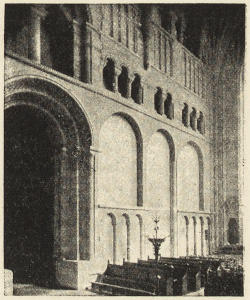
SOUTH TRANSEPT.
II. Late Norman, 1100-1145.—To this period belong the nave and the renovation of the choir. The capitals of the nave, near which the stalls of the canons stood, are richly carved, and, like all pre-Gothic carving, are full of classical survivals, acanthus, honeysuckle, etc. The Norman work is far richer than that of Ely, Peterborough, Durham, Gloucester or Tewkesbury; these capitals and those of Southwell nave and Romsey lead up to the rich transitional capitals of Oxford Cathedral. The design of the nave, and still more the choir, was probably the most solid and satisfactory in the country, not even excepting Durham. The triforium is especially magnificent; a copy of it was executed in the transept of Romsey. The bays of the choir are separated by broad pilasters, apparently to carry broad transverse arches. But whether these arches were intended to carry some form of wooden roof (their spandrils being built up), or a vault, cannot be determined.
III. Transitional.—Then, c. 1186, following the precedent of Romsey, the three Norman apses were pulled down in order to provide (1) a processional aisle, of four bays,[112] connecting together the side-aisles of the Norman choir; (2) a double chapel, a prolongation of the Norman eastern chapel. The new processional aisle had probably two eastern chapels, two to the north, two to the south. The processional aisle with the double chapel was altogether six bays in length, and therefore formed an eastern transept—one of the earliest eastern transepts in England. The side walls of the old Norman eastern chapel were pierced with windows, unglazed, to improve the lighting of the new aisle-chapel on either side. In the jambs of these windows are shafts with conventional stalky foliage; while the arch of the window-head is enriched with the Norman diamond ornament. The vaulting-ribs are enriched with zigzag. The central piers have, one conventional foliage, the other a scalloped capital. In the south-east transept there are remains of the doorway, and a plinth which seems to have supported a pier between the two eastern chapels. Some five or six years later a similar processional aisle with five eastern chapels was built at Abbey Dore, where, however, it does not form an eastern transept. The piers of the processional aisle are so arranged that two of them are in a line with the centre of the semicircular arch which led from the choir into the former Norman central apse. The intention of the builder evidently was to reconstruct the east end of the choir, or perhaps to rebuild the whole choir, substituting for the single semicircular arch a pair of pointed arches, as at Exeter. This was never done, however; and so, quite fortuitously, Hereford gets the most charming vistas from the choir across to the eastern transept and the Lady chapel.
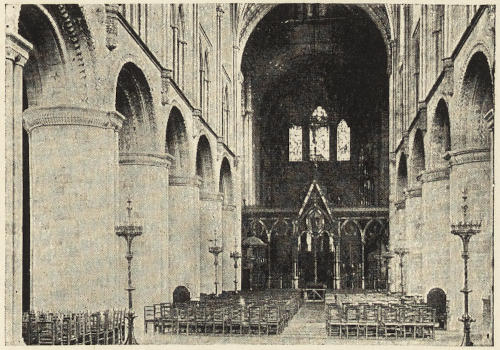
NAVE.
IV. Lancet.—About 1220 the upper and eastern parts of the Lady chapel were completed. It is a work of great beauty, especially in the rich clustering of shafts in the window-jambs and in the fine composition of the east end, with its quintet of lancets. The chapel is curiously low internally. The builder was an exceptionally cautious person.[113] He not only provided for the thrusts of the vault by heavy buttresses and pinnacles, but, to get the thrusts as low down as possible, he made the vault spring below the window-heads. Moreover, down below he constructed a lofty crypt, thus raising considerably the floor of the Lady chapel. Thus encroached on from below and from above, the interior of the Lady chapel contrasts remarkably with its lofty and imposing exterior. Externally, moreover, as the window-heads could not rise high, owing to the low spring of the vault, a large amount of wall-surface was left, and had to be decorated. This was done in a remarkable way; the arcade which runs round it being the old-fashioned Norman arcade of intersecting semicircular arches—probably the last appearance of this design on the stage. Another puzzle is that the external doorway leading to this crypt contains Transitional details. Probably the whole of the lower part of the Lady chapel was built in the Transitional period. The crypt-worship of the eleventh century had gone out of fashion; and the Hereford crypt, like[114] that at Norwich, was probably built as a golgotha or charnel-house.
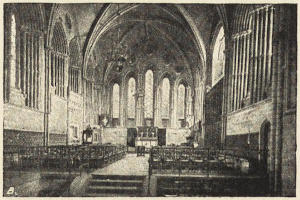
LADY CHAPEL.
V. Early Geometrical.—The history of the cathedral now resolved itself for the next hundred years into a series of attempts to get rid of the “dim, religious light,” so dear to the modern, so abhorrent to the mediæval ecclesiastic. Hereford choir was even worse lighted than Norman churches generally, being blocked to east and west by transepts, and having enormously bulky piers. So the Norman clerestory was taken down, and a Gothic clerestory with an inner arcade—an early and interesting example of plate-tracery—was substituted. Moreover, the choir was made fireproof by being vaulted in stone, c. 1250.
VI. Middle Geometrical.—About 1260 more drastic measures were taken with the Norman north transept. It was pulled down bodily, and rebuilt on a design which is perhaps the most original, as it certainly is one of the most beautiful, in the history of English Gothic architecture. To the north and west were built enormous windows, with tracery of cusped circles, quite exceptional in their elongation, more like late German than English work. On the east side was built an aisle of exquisite beauty. Its arches, almost straight-sided—its triforium windows, a ring of cusped circles set under a semicircular arch—its clerestory windows, spherical triangles enclosing a cusped circular window—the composition of the triforium—the north and west windows—are quite unique, except so far as they were copied in later work in the city and neighbourhood. At the south end of the aisle is the exquisite[115] tomb of Bishop Peter Aquablanca (d. 1268); no doubt built in his lifetime. The tomb is as unique as the transept, and closely resembles it in design. The inference is that Bishop Aquablanca built the transept. The credit of it, however, is constantly given to his successors, apparently on account of his private vices. But sinners as well as saints have liked to leave memorials behind them in stone; and, moreover, Aquablanca had his good points. To this day four thousand loaves are distributed every year out of funds which he bequeathed. It is recorded, too, that, of a fine which was imposed on the citizens for encroachments on his episcopal rights, he remitted one half, and handed over the other for works on the cathedral. Moreover, he was a foreigner, from Chambery; and has probably received no more favourable judgment from the English chroniclers than they were wont to give to foreign favourites of the king who swallowed up the best things in the English Church.
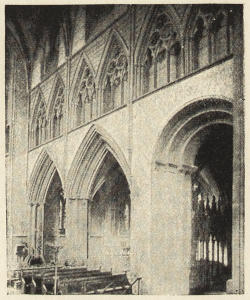
NORTH TRANSEPT
VII. Late Geometrical.—Then came a turning-point in the history of Hereford. The reputation of King Ethelbert as a miracle-worker may well by this time have worn a little thin. In 1287 Hereford found that it had obtained a new saint. This was Bishop Thomas Cantilupe, a man of saintly life, and one of the greatest churchmen of the day. “He was a pluralist of the first dimension—Chancellor of England and of the University of Oxford, Provincial Grand Master of the Knights Templars in England, Canon of York, Archdeacon and Canon of Lichfield and Coventry, Archdeacon of Stafford,[116] Canon and Bishop of Hereford.” In 1282, with his chaplain, Swinfield, he visited Rome, and died on the journey home. Swinfield, following a not uncommon mediæval practice, had the flesh of the body separated from the bones by boiling. The flesh was buried in the church of St. Severus, near Orvieto; the heart and bones he conveyed to England. The heart was interred at Ashridge, the bones in Hereford cathedral. Five years afterwards miracles commenced: “There were raised from death to life threescore several persons, one-and-twenty lepers healed, and three-and-twenty blind and dumb men received their sight and speech. Twice King Edward I. sent sick falcons to be cured at his tomb.” In 1320, by the expenditure of vast sums of money, Swinfield procured his canonisation. Ever since, the see of Hereford has borne the arms of Cantilupe. He was the last English saint; and, being the newest, was for a considerable time the most fashionable. The fame of St. Wulfstan of Worcester and St. Swithin of Winchester paled before that of St. Thomas of Hereford. Till Gloucester secured in 1327 still fresher relics in the murdered body of King Edward II., Hereford held the greatest attraction for pilgrims in all the West-country. For forty years—from 1287 to 1327—the pilgrims resorted to the new shrine in vast numbers. Swinfield’s foresight was justified by the huge sums which poured into the cathedral treasury.
Swinfield succeeded Cantilupe as bishop in 1283, and occupied the see till 1316. With the vast resources now at his disposal he set about a series of great works. His first pious act was to construct for his benefactor and predecessor a noble shrine, the pedestal of which now stands once more, after many vicissitudes, in the aisle of the north transept. It is a work of the rarest beauty, executed just at the time when, tired of conventional foliage, the mediæval carver, with ever fresh delight, was making the most exquisite transcripts in stone of the leaves of the trees and the flowers of the field.
Secondly, he constructed a north porch—the present inner porch—the design of which is plainly taken from the shrine.
Thirdly, he rebuilt the central tower on the Norman piers and arches. To lessen the weight as much as possible it was built in two skins, the inner skin consisting of a framework of upright stone girders, as in the towers of Wells and Lincoln. Externally it is smothered in ball-flower. Originally it carried a tall timber spire; the loss of which greatly injures the external elevation of the cathedral.
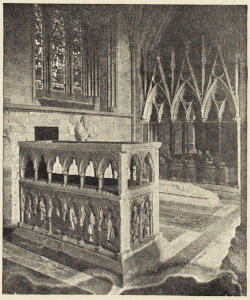
NORTH TRANSEPT AISLE.
Fourthly, he went on with the improvement of the lighting of the cathedral. Beginning probably at the north-east transept, which was rebuilt, together with its eastern aisle, and working along the choir and nave to the west end, and then vice versa on the south side of the cathedral, he took down all but the lower part of the walls of the Norman aisles, rebuilt the upper part higher, and inserted very large windows. This lighted the nave, at any rate, very satisfactorily. The design of these windows is unusual and effective, owing to the largeness of the trefoils employed in the tracery.
VIII. Curvilinear (1315-1360).—By the time of Swinfield’s death it may be conjectured that the pilgrim-revenue had begun to fall off; for the rebuilding of the south-east transept, together with its eastern aisle, in completion of the reconstructions commenced by Swinfield, was executed in a cheap and inferior way, even the clumsy Transitional plinth being retained for the new central column of the transept. The windows have flowing tracery.
To the same period belong the stalls and the beautiful chapter-house, now in ruins. The lead of its roof was cast into bullets in the Civil War; sacrilegious bishops used its stones as a quarry for their palace.
There are monuments of Bishop Swinfield (d. 1316) and Bishop Charleton (d. 1343).
It is probable that all this work was done before 1349, when the Black Death made its appearance at Hereford, and again in 1360.
IX. Perpendicular (1360-1485).—The lighting improvements were now completed by the insertion of two huge windows in the south transept, the southern of which has recently been filled with magnificent glass by Mr. Kempe. On the north side of the choir Bishop Stanbury (1455-1474) built for himself a pretty little chantry-chapel, like those at Lincoln. It has fan-vaulting.
X. Tudor.—Bishop Audley (1492-1502) built himself a pentagonal chantry-chapel, two stories high, projecting from the south side of the Lady chapel. But, as he was translated to Salisbury, he had the trouble of building another chantry-chapel there. To this period belong the Bishop’s cloister—three-sided, as at Chichester—and probably the Vicars’ cloister, with picturesque timber roof, and a fan-vault over the entrance to the Vicars’ college. Bishop Booth (1516-1535) built the outer north porch—an admirable specimen of late Gothic design.
XI.—In 1786 the western tower collapsed, and Wyatt pulled down the westernmost bay of the nave and the whole of the triforium and clerestory, whether damaged or sound, and rebuilt both, together with the west front, in the Gothic of his day. About 1843 Cottingham did much work; rebuilding the east end of the Lady chapel and the upper part of that of the choir, and also securing the central tower. He found that the Norman piers which support it consisted of a thin ashlar casing, the interior of which was filled with a rubble core, composed of broken stones, loam and lime grouting.[119] The ashlar facing and the engaged columns on the face of the pier, not being well bonded and deeply headed into the rubble cores, had split and bulged, and the cores, for want of a proper proportion of lime, had diminished and crushed to pieces. The gaudy choir-screen and coronal were designed by Sir Gilbert Scott, and executed by Skidmore of Coventry.
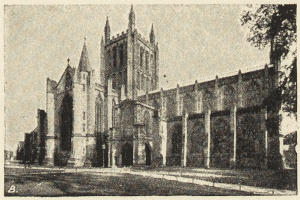
FROM NORTH-WEST
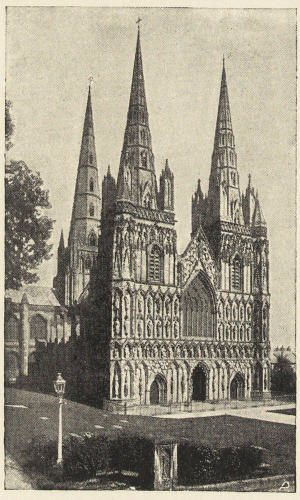
WEST FRONT.
This is how Lichfield presented itself to Mrs. Van Rensselaer. “Approaching it from one street or another, we see it suddenly across the silver stretches of its Pool, and it is hard to determine whether the shining water at Lichfield or the green lake of turf at Salisbury makes the lovelier foreground. Standing on the causeway which leads towards the western entrance of the Close, it is not merely a fine view that we have before us; it is a picture so perfect that no artist would ask a change in one detail. Perhaps accident has had more to do than design with the planting of the trees and shrubs which border the lake, and above which spring the daring spires. But a landscape-gardener might study this planting to his profit; and when we see or think of Lichfield from this point of view, we wish that the tall poplar[121] may be as long-lived as the tree Yggdrasil—so pretty a measure does it give of the loftiness of the spires, so exquisite is the completing accent which it brings into the scene. If we come from the south-east, we cross another causeway, on either side of which the lake spreads out widely; and we see not only the spires, but the apse and the long stretch of the southern side. Enormously long it looks—longer almost, owing to its peculiar lowness, than those cathedrals which are actually greater. To the north of the church the ground rises quickly into a broad, terrace-like walk flanked by rows of large and ancient, yet graceful lindens; and beyond the trees, behind low walls and verdurous gardens, lies a range of canons’ dwellings. And in any and every aspect, but more especially when foliage comes near it, Lichfield’s colour assists its other beauties. Red stone is warm and mellow in itself; and Lichfield is red with a beautiful soft ruddiness that could hardly be matched by any sandstone of any land.”
The ancient kingdom of Mercia was converted to Christianity, like the rest of England north of the Thames, by missionaries of the Irish Church from Lindisfarne, c. 653; and the first two Mercian bishops were Irishmen. Of the early bishops, by far the most famous was St. Chad (669-672). St. Chad, or Ceadda, was a good and saintly man. He is first heard of as Abbot of Lastingham, a sequestered abbey hidden away in a fold of the Cleveland moors. Then Abbot Chad became Bishop of York; and he set to work on a visitation of his vast, wild diocese—not in a carriage and pair, but on foot. Plainly these early bishops were what we should now call Missionary Bishops, such as that Missionary of the South Seas who lies in Lichfield’s Lady chapel, his face irradiated by the southern light. Archbishop Chad visited town and country, village and hamlet, cottage and castle; and preached everywhere. It was another Progress of St. Paul. But in 669 the famous Greek Archbishop of Canterbury, Theodore, pronounced his consecration faulty, and deposed him from York. Soon afterwards, however, finding[122] him a saintly man and an excellent preacher, he appointed him to the bishopric of Mercia, to the see of Lichfield. What was York’s loss was Lichfield’s gain. At Lichfield he lived, tradition says, in a cell with his missioners, at the upper end of the Pool, where now stands St. Chad’s Church. It behoves all who come to Lichfield to visit St. Chad’s Church and to drink the water of St. Chad’s Well—water which still retains somewhat of efficacy and repute, for a line of pipes has been laid from the Stowe Pool to Burton, and an immense volume of Lichfield’s hallowed water is annually converted into beer. Two years and a half only Bishop Chad had left of life; but that was enough for him to win the reverence of his own and many successive generations. Beautiful stories are told of him by Bede. One of the eight monks who lived with him declared that he one day heard a joyful melody of some persons sweetly singing, which descended from heaven into the Bishop’s oratory, and filled the same for about half an hour, and then rose again to heaven; and that on the seventh day thereafter, having received the Body and Blood of our Lord, he departed unto Bliss, to which he was invited by the happy soul of his brother, St. Cedd, and a company of angels with heavenly music.
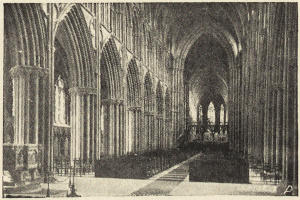
NAVE.
Thus the diocese of Lichfield preserves the memory of the by-gone kingdom of Mercia; and its cathedral is largely built of the offerings at St. Chad’s shrine. How big the ancient diocese was is seen from the fact that the present dioceses of Hereford and Worcester, as well as the suppressed ones of Sidnacester, Lindsey, and Leicester, were all carved out of it by Archbishop Theodore, the great organiser of the early English Church, A.D. 673. For a time even greater honour came to Lichfield. From 755 to 794 a great and mighty king reigned in Mercia: this was Offa. In one direction he defeated Kent; in the other he drove back the Welsh. It was Offa who settled once for all the Welsh frontier: Shrewsbury became an English town. Offa’s Dyke, which still exists, from the mouth of the Wye to the mouth of the Dee,[123] became the effectual bulwark of England to the West. A king so mighty disdained to owe allegiance to an archbishop of defeated Kentishmen, and got from the Pope of the day an archbishop of his own, to be head-bishop of all Mercia and East Anglia. But Offa died, and the pope died; and this was the first and only archbishop that Lichfield ever had. Lichfield was never so important again. Indeed, she had a narrow escape of losing her bishop altogether, just after the Norman conquest. The new Norman prelates did not feel safe, and probably were not safe, in open towns amidst an alien and disaffected population. The Bishop of Dorchester set up his pastoral staff under the shadow of the new Norman castle at Lincoln; Exeter castle attracted the Bishop of Crediton; in similar fashion the Norman Bishop of Lichfield transferred himself to Chester, where also was a castle of strength. The next bishop migrated again—this time to Coventry, which possessed a famous monastery, founded by famous people, Earl Leofric and Lady Godiva, the church whereof was so wealthy that “its walls were all too strait for the treasures that were therein.” Finally the bishops returned once more to Lichfield, retaining, however, their hold on Coventry; and till the Reformation they styled themselves “Bishops of Lichfield and Coventry.” Lichfield, however, was and is a cathedral of the old foundation; it had no monks, but secular canons. It may well be imagined, therefore, that there was not much peace and good will between the canons of Lichfield and the monks of[124] Coventry. They quarrelled scandalously; above all when they had to meet for joint election of a bishop. There was even a desperate free fight in Coventry cathedral in 1190, when Bishop Hugh ejected the monks. The holy bishop himself was wounded at the altar.
In the thirteenth century there must have been a series of great building bishops; but little is known of them. Bishop Langton, however, was a very great personage, Keeper of the Great Seal, Treasurer of England, and executor to Edward I. He built a new episcopal palace at Lichfield, and other castles and manor-houses elsewhere, also a magnificent new shrine for the relics of St. Chad; and he surrounded the cathedral with a wall and foss, thus making of it a moated fortress, such as one sees to this day at Wells. Robert Stretton (1360-1385) had the distinction of not being able to read. Then we pass on to the great Civil War, when Bishop Langton’s fortifications proved a heritage of woe. Being fortified, and being Loyalist, Lichfield Cathedral was besieged by the Parliamentary forces under Lord Brooke, who prayed aloud that God would by some special token manifest unto them His approbation. The special token came on St. Chad’s Day, March 2nd, and is commemorated by a tablet on a house in Dam Street, which the visitor should look for: “March 2nd, 1643.—Lord Brooke, a general of the Parliament forces, preparing to besiege the Close of Lichfield, then garrisoned for King Charles the First, received his death-wound on the spot beneath this inscription, by a shot in the forehead, from Mr. Dyott,” a deaf and dumb man, “who had placed himself on the battlements of the great steeple to annoy the besiegers.” It may interest some to know that the distance of the shot was 185 yards 1 foot 3 inches. In the end the garrison was starved out. Six weeks later Lichfield Close was recaptured by Prince Rupert. In 1646 it was retaken by the Parliamentarians. In the first siege the Parliamentary cannon brought down the central tower and most of the vault of the choir. This was not all. The Puritans smashed the[125] stained windows, battered down the statues, stripped the lead from the roof and the brasses from the tombs, burned the registers, and broke up the bells and organs. They are said to have each day hunted a cat down the aisles, and to have draped a calf and given it a mock baptism at the font. “I confess,” says an apologist for her Puritan ancestors, “there were moments in my English journey when I hated the Puritan with a godly hatred, and wished that he had never shown his surly face to the world: a rude destroyer of things ancient, and therefore to be respected; a vandal devastator of things rare and beautiful, and too precious ever to be replaced; a brutal scoffer, drinking at the altar, firing his musket at the figure of Christ, parading in priest’s vestments through the market-place, stabling his horses in the house of God.” Then came the Restoration, and with the Restoration Bishop Hacket, best of good bishops. The very next morning after his arrival he set his coach horses to work at clearing away the ruins of the fallen spire and roof. For nine years he gave himself and his substance to the work; his contributions in money amounted to £10,000; the King gave “one hundred fair timber trees”; the prebendaries and canons subscribed half their income; every town, every village in the diocese aided the good work; the central tower was re-erected; most of the clerestory of the choir was rebuilt; his last task was to put in a peal of bells. “He went out of his bedchamber to hear it, and blessed God who had favoured him with life to hear it, but that it was his own passing-bell; whereupon he retired to his chamber and never left it till he was carried to his grave.” Next to St. Chad, one likes to think of good Bishop Hacket in connexion with Lichfield. In 1788 James Wyatt arrived, but did less mischief than at Salisbury, Hereford and Durham. Even more terrible vandals followed Wyatt, with a mania for Roman cement, in which beautiful material they reconstructed the statuary of the west front. All this is now swept away, and this fairest of façades is seen in its pristine beauty.
At Lichfield there was as usual a Norman cathedral; and as usual the authorities set to work to improve it. Elsewhere the improvements were of a very conservative character. At Lichfield and at Wells they were drastic: the Norman cathedral was improved by being swept off the face of the earth, not a scrap of it being left above ground. Beginning at the east end, it was pulled down and rebuilt, the work occupying a century. The most astounding thing about Lichfield is that when the new thirteenth-century cathedral was finished, they set to work once more at rebuilding, and in the first half of the fourteenth century reconstructed the whole of the eastern limb of the cathedral. But though for convenience we divide the work into two great periods, that of the thirteenth and that of the fourteenth century, and each of these into shorter building-periods, it is not to be understood that there were any breaks or cessations in the works: the cathedral was never out of the builders’ hands from 1190 to 1350.
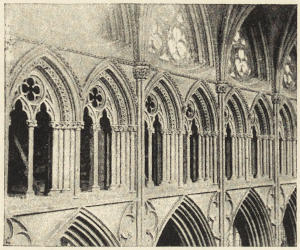
NAVE.
I. First, the Norman choir, of three bays with apse and ambulatory, was pulled down, a broader and longer rectangular choir taking its place. The outer wall of the new choir was built outside that of the old one, so that the latter probably was retained in use for some time, as in Selby choir, while the new works were going on around it. This is borne out by the[127] fact that, contrary to custom, the new work was not commenced at the east, but at the west, for the detail is earlier to the west than to the east. The date 1200 is usually assigned to it. But the entrance arch of the north choir aisle has the Norman diamond pattern; the square alternates with the rounded abacus; the piers are heavy, the arches low, the mouldings large and vigorous, and the foliated capitals at the east end of both aisles are so archaic in character that it seems decidedly to have been commenced in the latter years of the Transitional period, c. 1080: it compares with the work at Wells, Chichester Lady chapel, Boxgrove Priory, St. Thomas’, Portsmouth, and Abbey Dore. Of this work only the piers and arches of the three western bays, and the sacristy and treasury, survive.
II. Some twenty or thirty years later the south transept was commenced, and a little later the north transept. The builders of the choir had planned it for an aisleless transept. When, therefore, the transepts were built with eastern aisles, the easternmost windows of the choir aisles looked into the transept aisles, and no longer into the open air. As the transepts have no triforium above their aisles, we may conjecture that neither had the choir.
III. About the same date as the north transept, a chapter-house and vestibule were built on the north side of the choir, as at Beverley, Lincoln, and York. This had not been contemplated by the builders of the choir; consequently the doorway of the vestibule had to be placed where before was a Lancet window. The vestibule is a bold and vigorous piece of design, with a good vault and a remarkable range of thirteen arcaded seats on its western side. The chapter-house is unique in plan, being an octagon with two long and six short sides: this plan was transplanted to the Lady chapel of Wells. The doorway has bold tooth-ornament; the wall is surrounded by a trefoiled arcade. There is much beautiful glass by Kempe.
IV. About 1250, soon after Westminster choir, the nave was[128] commenced. Its remarkable clerestory windows—spherical triangles enclosing cusped circles—occur in the Westminster triforium, and, rather later, in the clerestory of Hereford north transept. The spherical triangles fit perfectly into the wall-arches of the vaulting, and, as Mr. Fergusson says, “give a stability and propriety to the whole arrangement which has never been surpassed.” The result, however, is to diminish the height of the clerestory, with the inevitable result that the aspiringness that one expects in an Early Gothic elevation is lost; the nave, instead of looking taller, looks lower than it really is. As at Westminster and Beverley, the ground-story occupies one-half of the total height; but in these the triforium occupies about one-sixth only, the clerestory one-third. At Lichfield the triforium and clerestory occupy each one-fourth. Mr. Fergusson makes the striking suggestion that the defect might have been remedied to some extent by glazing the triforium, as in Amiens choir, thus practically bringing the clerestory down to the pier-arches. The vault, too, is most satisfactory—not simple to bareness, like that of Amiens and so many French cathedrals, nor over-elaborated, like those of Winchester and Norwich. The whole design, indeed, of the nave is one of the loveliest in Christendom. It derives great impressiveness, too, from the fact that the vault ranges the whole length of the cathedral in almost undiminished height; and from the fact that the church is not cut up, as at Canterbury, into two distinct buildings. Indeed, small as the cathedral is, the vista from west to east is one of the longest of all the English cathedrals. And its termination in the beautiful polygon of the Lady chapel, so unusual to English eyes, and so beautiful, glimmering in the distance “like some great casket of jewels at the end of the long dusk perspective,” makes an impression never forgotten. By this one remembers the interior of Lichfield, as its exterior by that glorious triple coronal of spires. Nave, transept, and choir are all of the same length. The same scheme of proportions was adopted a little later at York. The axis of the choir is[129] not in a line with that of the nave, but swings to the north five feet.
V. Next the west front was built, c. 1275, except the central gable and the spires. It is a sort of open-air reredos; but marks a great improvement in design on those of Lincoln, Wells, and Salisbury.
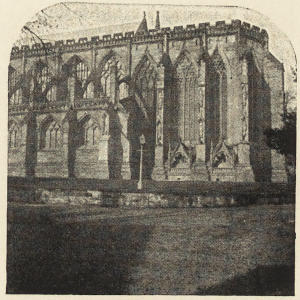
LADY CHAPEL.
VI. Then at the very end of the Geometrical period the Lady chapel was built; at first detached from the east end of the choir, so as not to interfere with the services. Being exceedingly lofty and without aisles, it was possible to have exceptionally lofty windows of the type of those of the north transept of Hereford. These elongated windows, the absence of aisles, and the polygonal plan, give the exterior a curiously German appearance. The window tracery is Geometrical, being composed of groups of trefoils. But the ogee-dripstones of the windows show that the work overlaps into the Curvilinear period; indeed, it was not finished at Bishop Langton’s death in 1321. Under the three eastern windows are chapels, the central of which contains the monument of Bishop Selwyn, of New Zealand and Lichfield. But the glory of the Lady chapel and the cathedral is the magnificent painted glass of the sixteenth century—similar in character to the beautiful glass of Margaret of Austria’s church at Brou-en-Bresse, Burgundy. The first window on each side was inserted recently. The remaining seven windows are also Flemish[130] glass, of the date 1530 to 1540, bought by Sir Brooke Boothby, in 1803, from the Cistercian nunnery of Herckenrode, near Liége, for £200. The second window on the north is particularly interesting, as it contains portraits of patrons and benefactors of Herckenrode, kneeling at altars, with their patron saints behind them. The third window also has portraits of great nobles of the Netherlands. The remaining five windows contain Scriptural subjects.
VII. The next step, c. 1325, was to build another bay to the choir, thus joining it up to the Lady chapel. In this bay was placed a new shrine of St. Chad. But even this was not enough for the canons. They were seized with the mania for floods of light and acres of stained glass which raged like an epidemic through the fourteenth and fifteenth and sixteenth centuries. They pulled down all the choir except the piers and arches of the three westernmost bays—they would have removed these also but for fear of bringing down the central tower—built new piers and arches in the eastern bays, and a new clerestory along the whole length of the choir with huge windows of flowing tracery, two only of which are left. At the same time they replaced all the lancets of the aisles by big Curvilinear windows. The jambs of the clerestory windows they enriched with bands of quatrefoils; one of the windows of the south aisle of the choir, opposite to which the tomb of Bishop Langton formerly stood, and beneath which good Bishop Hacket’s tomb is now placed, has big crumpled leaves running up the jambs. The junction of the early Lancet piers and capitals with those of the fourteenth century is well seen in the vaulting and in the third pier from the central tower. Between the bays were placed statued niches, as in the contemporary church of St. Mary’s, Beverley, from which rose the vaulting-shaft. The whole design should be compared with the presbyteries of Wells and Chester, which were in course of “restoration” at the same time and in the same ruthless fashion. In the choir aisles is a delightful arcade of bowing ogee arches.
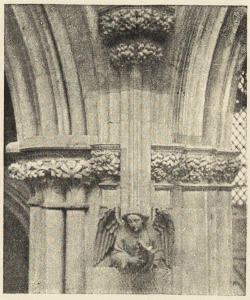
CHOIR.
About the same time, or a little later, were built the central gable of the west front and the south-western spire.
VIII. Perpendicular and Tudor.—The equipment of the presbytery was completed, c. 1390, by the erection of a magnificent altar-screen after the fashion of those at Winchester and St. Albans. Six of its canopies are used up in the present sedilia. The northern spire also was copied from the southern one. More big windows were inserted in the transepts and the west end of the nave. The latter has been replaced by a modern geometrical window; that of the north transept by a fine quintet of lancets, largely composed of fragments of the original thirteenth-century window. Finally, the whole cathedral was rendered fireproof by the erection of vaults under both transepts and the central tower. The south transept, however, would seem to have had a vault before—but it may have been of wood—for a little lower than the Perpendicular abacus of the vaulting-shaft is one of the thirteenth century. To this period belongs the gallery of St. Chad’s chapel.
IX. In the two sieges the clerestory and aisle windows and the vault of the choir suffered greatly, and the central spire was destroyed. The latter was rebuilt under the direction of Sir Christopher Wren; and Perpendicular windows replaced those which had been injured here and in the Lady chapel. So that the choir now is a curious hybrid: the most eastern[132] bay is Curvilinear from top to bottom; the next bays are Curvilinear with Perpendicular tracery in the clerestory windows; the three westernmost bays are Transitional or early Lancet below, Curvilinear above, but with Perpendicular tracery in the windows. The present vault of the choir is chiefly of lath and plaster, by Wyatt.
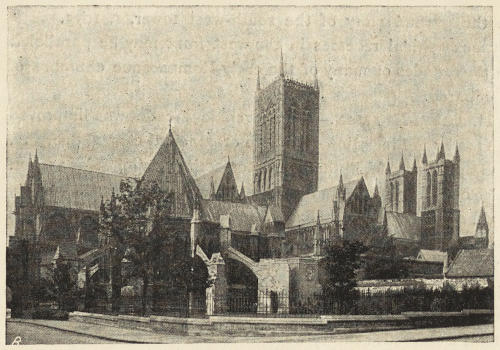
FROM NORTH-EAST.
The cathedrals of Lincoln, York, and Southwell were ever served by secular canons and not by monks; but each cathedral has been styled a minster from time immemorial, as if it were or had been a monastic church (monasterium).
I. The history of the cathedral only commences in 1074, when the first Norman bishop, Remi or Remigius, made Lincoln the seat of the see instead of Dorchester on the Thames. As Canon Venables puts it: “He refused the tabernacle of Birinus, and chose not the tribe of the South Angles; but chose the tribe of Lindsey, even the hill of Lindum which he loved; and there he built his temple on high, and laid the foundation of it like the ground which hath been established for ever.” The blank wall which forms the centre of the west front is Remi’s work. So are the Ionic capitals, square-edged arches, and wide-jointed masonry[134] in the ground story of the south-west tower, c. 1075. The curious apsidal recesses in the west front may be paralleled in the façades of many of the early Romanesque churches of Lombardy.
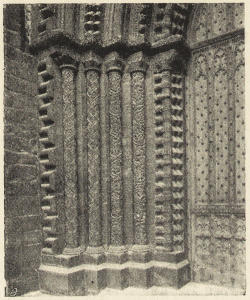
WESTERN DOORWAY.
II. Late Norman.—This archaic façade was improved c. 1140 by the insertion of a more ornamental central doorway, and by the arcade, high up, of intersecting semicircular arches. Also curious plaques, in rather high relief, were stuck along the wall, as at St. Michael, Pavia. They are not in chronological sequence, and so may have been transferred from some other church. Moreover, two low western towers were carried up, with rich and beautiful gables; of which those to the north and south survive. The south-western tower should be ascended to see Remi’s eleventh-century work, the twelfth-century gables, the “elastic beam,” and especially the superb view of the interior of nave, choir, and presbytery. The font, too, like that of Winchester, probably belongs to this period.
III. Transitional.—The north and south doorways of the west front, clumsily restored, were probably inserted c. 1150. Their capitals are reminiscences of Byzantine design. They may be compared with the large capitals of St. Hugh’s choir and Canterbury choir.
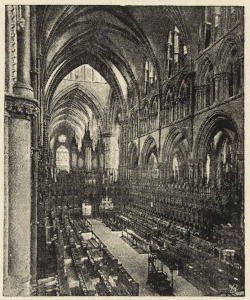
ST. HUGH’S CHOIR.
IV. In 1190 a Carthusian monk, Hugh of Avalon, near Grenoble, became bishop. Like Fitz-Jocelyn of Wells, and like the Lichfield builders, he determined not to try to improve[135] the Norman cathedral, but to sweep it away and build an entirely new one. The Wells and Lichfield people succeeded in getting rid altogether of the older building; but Remi’s successors had to leave a considerable amount of Norman work in the western façade and towers. Bishop Hugh commenced work in 1192: first building probably his central apse and eastern transept, and then the walls of his choir, before taking down the short Norman aisleless choir of two bays, outside which in all probability, as at Lichfield, the new walls were erected. It will be noticed that the foliated capitals of the aisle-walls of the choir are earlier in character than those of the pier-arcade. Then he pulled down the old choir, erected the pier-arcade, triforium, and clerestory of the new one, and built the south-east corner of the north transept and the north-east corner of the south transept, where it will be seen that his double arcade along the aisle-wall abruptly ceases. The whole of this work (1192-1200) is very advanced for its date, and is full of originality and eccentricity; the work of an architect (Geoffrey de Noyers) who was more of an artist than an engineer. Externally the design is one characterised by great elegance of proportions. It is remarkable, too, to find the windows grouped at this early date, even in the clerestory. The intermediate buttresses of the aisles are later additions, to resist the thrusts of the[136] quinquepartite vault of the aisles. Internally, it is disappointing. Its proportions are bad, owing to the exceptional lowness of the vault; the vault itself is contorted and ugly; the trefoils and quatrefoils are of all shapes and sizes; the obtuse pier-arches are out of harmony with the acute Lancet windows. Unfortunately, also, the effect of all the piers, except the third piers from the west, has been injured by cutting away the vaulting-shafts, which formerly descended to the floor, but which were stopped by corbels when the stalls were erected.
The north-east transept is quite exceptional. Its northern bay forms an internal tower, formerly divided into stories by wooden floors. The lowest story may have been designed as a return-aisle for processions, as at Winchester, if the triforiums also had floors—there are none now. The upper stories were described in 1641 as “watching chambers”; used, no doubt, by those who remained all night in the cathedral to watch the shrines and treasures, and to guard against fire. It is quite possible that these towers—there was originally a similar tower in the south transept—were intended to be carried up externally; in which case Lincoln would have had a glorious coronal of five towers.
The westward march of the twin towers of the mediæval cathedrals is curious. In the tenth-century churches, such as S. Ambrogio, Milan, and the later cathedral of S. Abbondio, Como, they flanked the choir; so they did at Canterbury, and in the twelfth-century choir of York; so they may have been meant to do at Lincoln. At Exeter they have marched on, and there occupy the ends of the transepts. Finally, they become the twin western towers which form such a characteristic feature of the façades of the mediæval churches of Northern Europe, but not of Lombardy.
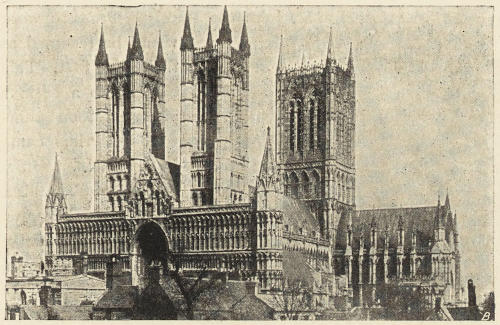
FROM SOUTH-WEST.
On the west side of the north-east transept is a unique example of a cathedral dispensary, with triangular recesses in the walls for the drugs. Afterwards a floor was inserted dimway; and to light the darkened lower chambers, windows[137] were cut through the west wall. The shutters of these windows are original, as also the ironwork of the dispensary doorway. The choir ended to the east in a remarkable fashion in a three-sided aisled apse with radiating chapels. This may be due to Hugh’s foreign extraction, or it may be regarded as the legitimate development of such east ends as Gloucester and Tewkesbury. The apsidal termination is shown by incised lines in the pavement of the retro-choir and the south choir aisle. Across the openings of the eastern transepts beams were left from pier to pier, because the fosse of the Roman wall here crossed the choir. The whole choir is full of freaks; the apsidal termination of the choir, the double apses of the eastern transepts, the transeptal towers, the ribbing of the vault, the extraordinary crocketed piers at the entrance of the eastern transepts, the fluted hexagonal shafts, and in the clerestory the miniature arcades and pigeon-holes. The whole design has been claimed as French by M. Corroyer, but M. Viollet-le-Duc’s opinion is decisive on that point: “it is English in its method of construction, in its mouldings, in its ornament, and in execution.” But though English, it is[138] going too far to call it “pure and undefiled Gothic.” The semicircular apses of the eastern transepts are not Gothic; and in Romanesque fashion, the triforium is spanned by transverse stone arches, regardless of the fact that the work they were supposed to do was done in reality by flying-buttresses outside.
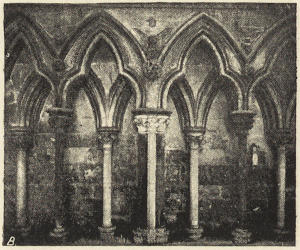
ST. HUGH’S ARCADE.
V. The works were probably suspended but for a short time by the death of St. Hugh. He had planned, if not commenced, the apses of the eastern transepts, and left directions that he was to be buried in the north apse of the north-east transept—the chapel of St. John the Baptist. Probably work would be resumed at this point first. This chapel has a curious history. Soon afterwards pilgrims came in crowds to St. Hugh’s tomb, and a larger oblong chapel was built in place of the apse, to accommodate them. In later days this fell into ruin, and in 1769 Essex rebuilt the chapel in its original apsidal form. The work is contemporary with that of the great transept, which also has a string continuing the abaci. After the apsidal chapels were completed there followed the completion of the great transept, the erection of a central tower, and of so much of the western part of the nave as was necessary to give abutment to the tower on the west. It will be noticed that the arcading at the east end of the north aisle of the nave belongs to this period. All this may well have been designed by Geoffrey de Noyers, for the tower was badly built and collapsed in 1239; the west wall of the transept is full of blunders, and the vault of the north transept cuts off[139] the head of the circular window, the Dean’s Eye. But externally the design of this north end is superb. The vaulting, as in the eastern transepts, is sexpartite, with the addition of a new longitudinal rib, which wobbles up and down in a distressing manner. The vault is copied—wobbling included—in Southwell choir. Magnificent contemporary glass remains in the Dean’s Eye and the lancets below it.
VI. The next work was the completion of the first five eastern bays of the nave. Whoever the architect was, or the architects—for there may have been two of them, the arcading of the aisles and the height of the bases differing widely on the north and south sides of the nave—it was not Geoffrey de Noyers, but some one who was both a good artist and a good engineer—so good an engineer that in the interior he sacrificed art to engineering. The piers he set as far apart as possible, and made them as thin as possible; but they are beautifully built, and rest on foundations which are continuous underground from pier to pier. These obtuse arches, however, and attenuated piers are most unsatisfactory to the eye. The nave is practically an improved version of the choir—improved in the vaulting, the buttresses and pinnacles, and in height. To the vault he added intermediate ribs—an early example of their use. The northern exterior of the nave, with its knife-edge buttresses and tall gablets and strong base-courses, is one of the best designs in all Gothic; it is of almost Greek severity. The height of the nave he raised from 74 to 82 feet. A Frenchman would have given a nave so broad (42 feet) a height of 120 feet. However, he was thinking—as all the Lincoln architects were always thinking—of how it would look outside, how it would affect the sky-line of the cathedral to have a nave far higher than the choir. Never was an English cathedral built so much for external effect as Lincoln; in every part of it the exterior is finer than the interior.
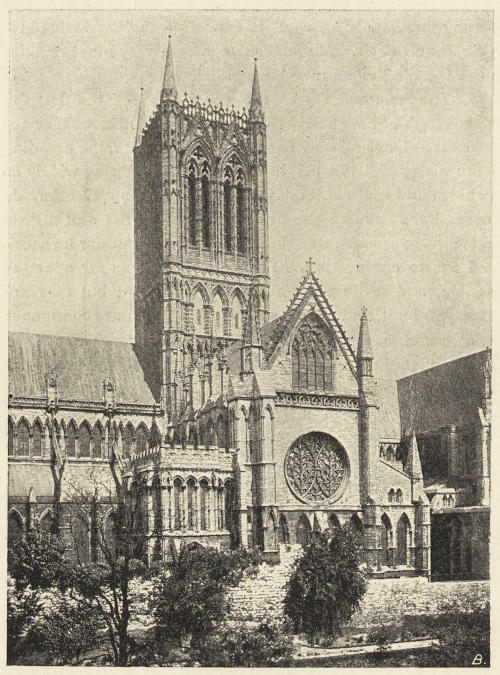
SOUTH TRANSEPT.
VII. From 1235 to 1253 the see was occupied by a man of the highest vigour and ability—Bishop Grosstête—who signalised his rule by many great works. Luckily St. Hugh had[140] been canonised in 1220, and money, no doubt, flowed in abundantly from the pilgrims. But in 1239 the central tower fell. It seems to have fallen to the south-east, and to have damaged seriously the adjacent parts of the transept and choir, and in particular the south side of the choir and the south-east transept. Everything else had to be laid aside to[141] get the mischief repaired. The repairs seem to have been executed with the greatest haste and carelessness. The new mouldings on the western side of the westernmost arches of the choir did not fit the old, and a ring of stone was worked to hide the awkward junction. Every arch in the south triforium is out of centre, and the trefoils and quatrefoils are cut most clumsily. In the end bays of the triforium of the choir and transept the central stalks “were replaced by ugly moulded blocks resembling nothing so much as a pound of candles.” The reconstructed arches may be recognised by having hood-moulds. The canons wanted to get back into their choir as soon as possible, and may well have regarded the whole affair as merely a makeshift till the nave should be finished, and they could transfer their services to it, and then pull down and rebuild St. Hugh’s choir more stably and in greater height. In the south-east transept the inner wall of the tower was taken down, and the upper part of the end wall was rebuilt. This work was done more carefully, there being no need to hurry over it, as it did not interfere with the use of the choir.
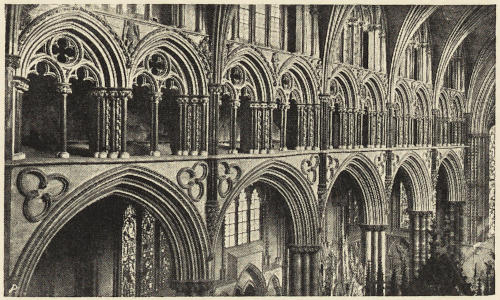
ANGEL TRIFORIUM.
The canons could now resume their work in the nave. But their resources had been heavily taxed by the unexpected demands made on them by the fall of the central tower. They took counsel, unfortunately, with economy. The original design had been, probably, to make the nave very much longer than it is now, and then to build a brand-new west front, as at Wells and Lichfield. The nave needs much greater length, being of the exceptional breadth of forty-two feet. Now it was decided not to sweep away, but to utilise the Norman west front and western towers as far as possible, and to curtail the nave accordingly. Unfortunately, the new cathedral had not been built at right angles to the Norman façade. The axis, therefore, of the remaining bays of the nave had to deviate so as to strike the façade as centrally as possible. Moreover, the western vault of the nave was too lofty for the façade, so it was suddenly dropped two feet at the end of the five eastern bays; and the distance between the completed bays and the façade being insufficient for two arches of the span of the eastern ones, the two western bays had to be built narrower than the rest. A different vault, too, was built in the aisles of these two bays.
All this is regrettable; but though Lincoln minster is shorter than it should be, its vast spaces, dimly lighted with scanty beams filtering through narrow lancets, are wonderfully impressive; the distances, yet further enhanced by the interposition of organ and screen, seem really infinite. It is not, like Ely, a study in contrasts, but in harmonies. The design of the nave leads without a break to that of the transepts; the design of the transepts to that of the choir; the design of the choir, aided by the rich stalls and screens, to the splendour of the presbytery, where the light breaks forth at length to irradiate the loveliness of moulding and foliage and sculptured imagery.
Though the length of the nave was now curtailed in the altered design, some compensation was found in throwing out a flanking chapel on either side of the two westernmost bays.[143] The position of these chapels may be founded on those of Ely; it was repeated by Wren in St. Paul’s. In all three cathedrals it gives a noble air of spaciousness on entering by the western doors. The vault of the northern chapel is supported, as if it were a chapter-house, by a beautiful central pier. This pier consists of eight shafts of Purbeck marble, very acutely pointed, once so highly polished, like the rest of the Purbeck shafts, says a mediæval versifier, that they positively dazzled the eyes.
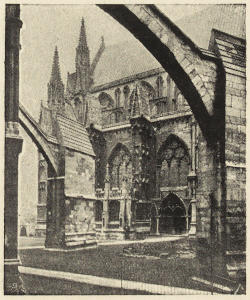
FROM NORTH-WEST.
Then came the west front. We may not like it; but given the conditions—the retention of an enormous oblong area of Norman wall with two Norman towers behind—it is not easy to see how anything better could have been done. Its vast height and breadth are astonishingly impressive from the little narrow courtyard which coops it in.
To the same bishop, Grosstête, are to be attributed the beautiful Galilee porch, attached to the south transept as a state-entrance for the bishop from his palace over the way; the sacristy; and the chapter-house—the first polygonal chapter-house after that of Abbey Dore. “The strong flying-buttresses, like colossal arms stretched out to bear up the huge fabric,” were added later.
VIII. The cathedral was now completed from east to west. But the canons had at once to start again. St. John the Baptist’s chapel, though enlarged, was all too small for the[144] pilgrims who crowded to Lincoln, attracted by the miracles wrought at St. Hugh’s shrine. The apse of his choir was therefore pulled down, and in its stead was built an eastern presbytery of five bays (1256-1280). This is the famous Angel choir, really the memorial chapel and tomb-house of St. Hugh. His shrine was solemnly translated to it in 1280. A little too crowded with ornament, it is yet the most lovely work of the age—one of the masterpieces of English Gothic. To the same period, probably, belong the superb arches inserted at the west end of the choir aisles with the idea of buttressing the eastern piers of the new tower; also the north, south and east screens of the choir, parts of which are old, the rest built by Essex in 1769.
IX. About 1290 were built the Easter Sepulchre and so-called tomb of Remigius, on the north side of the choir, with naturalistic foliage of oak, fig, and vine. Here the consecrated Host was watched from Maundy Thursday to Easter Sunday. Still finer Easter sepulchres may be seen at Hawton and Heckington. The upper stage of the central tower was erected in 1307. The tower is 271 feet high; and anxious, as usual, for external effect, the canons actually added a timber spire, raising it to the vast height of 525 feet, a height which exceeds even that of the new spires of Cologne cathedral. The effective cut battlements are by Essex. The tower is not built solid, but, to save weight, is “constructed of two thin walls, tied at intervals, with a vacuum between them” (cf. Hereford and Wells). It is gathered in 2½ inches near the top, so as not to look top-heavy. The remains of the shrine of Little St. Hugh (in the south choir aisle) seem to be c. 1310. In the cloisters, built c. 1296, is a great curiosity—an incised slab with a portrait of a Gothic architect, Richard of Gainsborough, the builder of the Angel choir. A replica has been made of it.
X. Curvilinear.—In 1320 died good Bishop Dalderby. He was worshipped as a saint, though Rome refused his canonisation. His remains were placed in a silver shrine on the[145] west side of the south transept: some of the pedestals of it may be seen there still. Miracles were wrought at his shrine; and from the offerings the gable of this transept was in all probability reconstructed, including the “Bishop’s Eye,” which is as strong constructionally as it is beautiful. The lovely pierced parapet of this transept should be noticed, and the fine window in the gable. The parapet was carried westward all along the south side of the nave and across the west front; and handsome pinnacles were erected, with niches once peopled with statues.
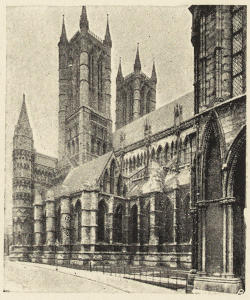
FROM SOUTH-EAST.
Now also was erected the choir-screen, of charming design, very similar to that of the west side of Southwell screen.
A little later are the screen of the choir boys’ vestry in the south choir aisle, diapered with lilies; and in the north-east of the Angel choir, St. Catharine’s shrine, and the Burghersh monuments. The period closes with the charming ogee doorways and arcading at the west end of the nave.
XI. The Perpendicular period commences with the choir-stalls, so much eulogised by Pugin; and, but little later, the miserable statues of English kings over the west door, and the west windows of the nave and its aisles. The western towers were also raised to their present height, and all three towers were vaulted. All this work belongs to the last forty years of the fourteenth century.
The west front now consists of an oblong area of Early Norman work, which is decorated above by a Late Norman arcade of semicircular intersecting arches, and midway by a row of Late Norman sculptured plaques, and by the Perpendicular niches with the kings: the windows are also Perpendicular; but the central doorway is Late Norman and the side doorways Transitional. The central arch of the Early Norman work has been replaced by a pointed one; and the whole of the Early Norman work is surrounded by Lancet work, which in turn is crested with a Curvilinear parapet. The lower stages of the towers are Late Norman; the upper stages Early Perpendicular. The west front has been constantly censured for hiding the western towers, “like prisoners looking over the bars of their cage.” But any one who has seen the western towers of St. Stephen’s, Caen, will recognise that, but for the west front, the Lincoln towers would look top-heavy.
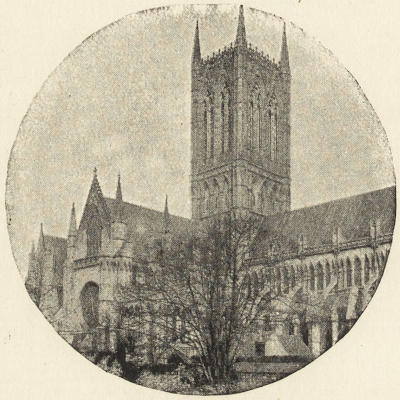
FROM THE SOUTH.
XII. To the fifteenth century belong the battlemented parapet of the Galilee porch; Bishop Fleming’s chantry; the[147] screens of the chapels in the north and south transept; and Bishop Russell’s chantry.
XIII. In Tudor days was built Bishop Longland’s chantry (1521-1547), the niches of which have Renaissance detail. The three chantries are so low that they do not interfere with the main lines of the cathedral; and, being low, give scale to it.
XIV. The date of the brass Eagle is 1667. In 1674 Wren built the Library in the Cloister. The brass chandelier is of 1698. The supporting arches of the western towers were inserted in 1727.
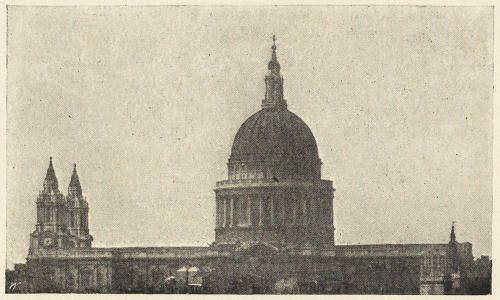
FROM THE SOUTH.
From Lincoln and Lichfield to St. Paul’s, the transition is vast and abrupt. It is a transition from the archaic, mediæval, feudal world to modern England. Mediæval religion, mediæval art is dead—killed by the printed book. Mediæval architecture also succumbs before the printed book. The master-masons of the old cathedrals, whose very names for the most part are unknown, give place to architects of European fame—men who read books, write books, and work to book. The mediæval architect was a builder and nothing else. The Renaissance architect was first of all a scholar, and secondly an artist; and only incidentally an architect. He learnt the art of architectural design, not in the builder’s yard, but by preference at the goldsmith’s bench. From jewellery he turned with equal facility to painting and sculpture, to civil engineering or to the art of fortification, to water-colours, to stage mechanism, to landscape gardening, to poetry, politics or diplomacy. Among the men of this versatile genius Christopher Wren holds a worthy place. He[149] proceeded to Oxford at the early age of fourteen; and obtained a fellowship at All Souls’. Physical science and astronomy were his first love. At the age of twenty-five “he was known in scientific circles all over Europe,” and was Professor of Astronomy. He wrote on comets, and gnomonicks, and diplographic pens. In his twenty-ninth year he was honoured with the degrees of D.C.L. and LL.D. at Oxford and Cambridge. He helped to found the Royal Society, and was twice its President. He was even a Member of the House of Commons in two Parliaments. In his thirty-first year he turned his attention to architecture—attracted, no doubt, largely by the physical and mathematical problems involved. Two years later he set out to the Continent to see for himself the great works of the Revival of Classical Architecture. Unfortunately he went no farther than Paris: those masterpieces of the Renaissance, Brunelleschi’s dome at Florence, Michael Angelo’s dome at Rome, he was fated never to see. For the rest of a life unusually prolonged he was to be occupied in imitating models which he had never seen. The result is perhaps not to be regretted. He left behind him not the close copy of Italian Renaissance work which we might have had, under more favourable circumstances, from Inigo Jones, but an English Renaissance style of marked individuality and originality, and therefore of great interest. He had to think out all his problems—problems of construction and problems of planning—for himself.
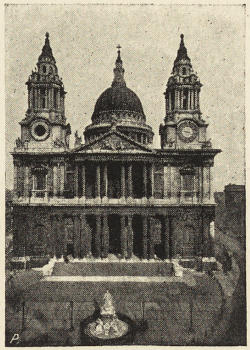
WEST FRONT.
Wren, like his employers, the citizens of the City of London was a sound Protestant; and when he was commissioned to[150] rebuild St. Paul’s after the Great Fire, his intention was to give London a Protestant cathedral. He was less concerned to provide processional aisles and altared chapels than a vast unencumbered central area for preaching. The new cathedral was to be a gigantic preaching-house. To provide the vast central area demanded, the narrow crossing beneath the central tower of a Gothic cathedral was abandoned. Instead of a central tower he resolved to employ a dome—the only form of roof which would cover so vast a span. One mediæval cathedral in England, and one only, had such a crossing. It was the superb cathedral of Ely, where Wren’s uncle was Bishop. But it was no doubt of St. Peter’s, Rome, that Wren was thinking, rather than of Ely. Just as St. Peter’s, Rome, had been built to rival and surpass the Florence Duomo, so Wren designed that his own new cathedral should be an improvement on St. Peter’s, Rome. In the supports of his dome he chose to follow the unhappy precedents of Florence and Ely rather than the nobler type of St. Peter’s and Santa Sophia; he blocked up his central area with eight piers, instead of poising his dome on four supports, as in the metropolitan cathedrals of the East and West.
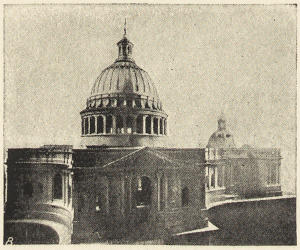
AS FIRST PROJECTED.
In Wren’s favourite design, as shown in the model still preserved in the cathedral, the dome was to be abutted to the west by an aisleless vestibule or nave, itself crowned by a minor dome; while to the north, east, and south, it was intended to give it the support of a surrounding ring of domical chapels, opening into the central area[151] by a series of fairy-like vistas and ever-changing contrasts of light and shadow. But the Anglican clergy rose in revolt at the position assigned to them in the cathedral—a position contrary to any precedent of the Anglican Church; and refused to sit in a ring all round the central area beneath the dome. On the other hand, the Court party, almost openly expecting, and with good reason, the restoration of the old religion, wanted an aisled nave with room for the pageantry of processions and with provision of chapels for the saint-worship soon to be restored. Romanisers and Anglicans alike united to condemn a plan which failed to provide for the ritualistic needs of either. Wren had to start again; and London had to put up with a Renaissance cathedral which in plan is as mediæval as that of Ely, with aisled nave, aisled choir, aisled transepts, and even with a western transept, as again at Ely. St. Paul’s then, is primarily, an aisled (i.e. a basilican) church, with, incidentally, a dome thrown in. And therein lies the fault of the design. Internally, the church predominates over the dome. Unless you stand beneath or almost beneath the dome, you can hardly see that a dome is there at all. Narrow nave, narrower aisles, the multiplied obstructive masses of the various piers, hide the dome away from view. Rightly designed, a great central dome ought to be all in all; everything should lead up[152] to it; everything should be suppressed that does not lend it strength or grace. Its thrusts are great, and cannot be resisted by the piers of aisles, unless the piers are positive mountains of masonry; aisles, then, should be omitted. The dome should rest on four arches, and their thrusts should be resisted by the solid walls of the unaisled nave and choir and the two transepts. And these four great limbs of the church should be kept short, to give the dome full value.
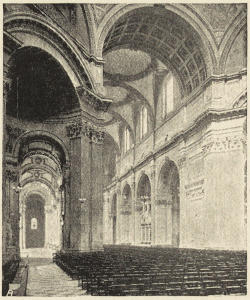
NAVE.
Again, just as the central dome dictates the plan of the church, so it should dictate the form of the vaulted roof. There were three types of vault at Wren’s disposal. One was the intersecting vault, a second the domical vault, a third the waggon or tunnel vault. The first is altogether out of harmony with a central dome, though Wren has employed it in some of his City churches. What he adopted was the second: he vaulted the nave with a row of four domes, the choir with a row of three. Thus, it might be thought, with seven domes leading up to a central dome, Wren had secured harmony and success. It is not so. Nothing can be more distressing to the eye than to follow the up and down line of the little domes till it suddenly plunges into the central abyss. The only tolerable form of vault in connection with a central dome is the tunnel vault, as it is employed in St. Peter’s, Rome; or, still better, in S. Annunziata, Genoa. Such a tunnel vault, however, should start direct from the cornice, and not, as at St. Paul’s, from a meaningless attic interposed between cornice and vault.
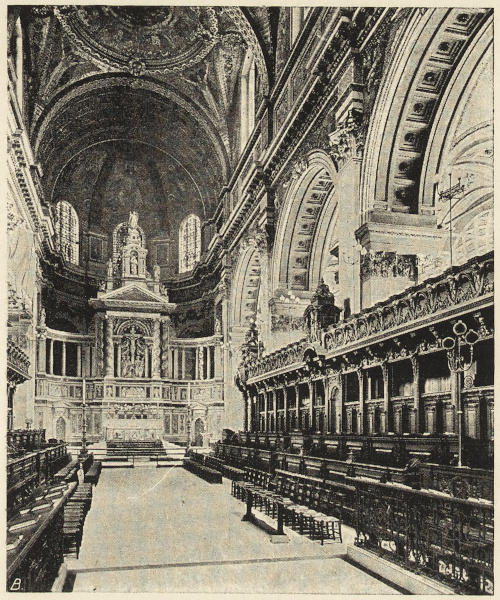
CHOIR.
As it stands, in the internal elevation of the cathedral Wren has given us a hybrid design. It reminds one of Gothic, for there is a travesty of a clerestory; it is Classic, for beneath is a gigantic Order. Wren has hesitated between two opinions. He might have given us a three-storied interior—pier-arcade, triforium and clerestory—of course with Classical detail, as is done with charming effect in the noble cathedral at Pavia; or a one-storied interior, as at St. Peter’s. As his patrons insisted on having aisles, he might well have adopted the[153] former alternative, and have presented us with what might have been very beautiful—a Classical triforium. If he wanted the majesty of the single gigantic Order of St. Peter’s, he should have omitted the attic, run up the Order twenty feet higher, and lighted the nave by lunettes cut through a tunnel vault. As it is, the miserable attic is of no value in itself, and at the same time diminishes the importance of the pier arcade. However, as we have seen, Wren is not responsible at all for[154] the plan, and only partially for the proportions of the interior of St. Paul’s. He has not given us of his best, because the world of his day would not have it. Most of the defects that one laments are absent from his earlier and favourite design: e.g., the ugly subsidiary arches under the oblique arches of the octagon of the dome, and the bad lighting of the dome itself.
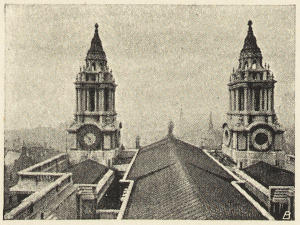
LOOKING WEST.
Externally everything is different. No ritual, Anglican or other, interfered. Wren had free play: all his success and any faults are his own. What it fails to do internally the great dome does externally with colossal success: it dominates everything—not only the church, but London. Every part of the vast building gathers up into the all-compelling unity of the central dome. Inside, St. Paul’s is all church; outside, it is all dome. Into this exterior has grown in concrete embodiment all Wren’s aspirations: his aspirations for grandeur, massiveness, and power; for monumental stability, for unity, for harmony, for symmetry and proportion, for beauty of curve and line. St. Paul’s has none of the airy lightness of Salisbury and Lincoln; it possesses in compensation the rock-hewn solidity and majesty of Durham. In Lincoln and Salisbury, and in Exeter and York, the windows are counted by hundreds; along the flanks of St. Paul’s windows are few and far apart, and they are confined to the aisles; the great screen-wall above rises sheer like a precipice, almost unbroken by an opening. Simple and grand, too, is the handling of the masses. At the re-entering angles of the[155] transepts square masses project to form a stable platform for the mighty dome; towers project to the flanks of the western bays of the nave, giving breadth and dignity to the main façade. Otherwise the design is symmetry itself. Everything is in the “grand manner.” Perhaps the side-elevation is a little monotonous, and the western chapels block off the towers at their spring, but they were forced on Wren against his better judgment: internally the nave gains greatly; externally they are a mistake. One would perhaps have liked also that the screen-wall of the side aisles of the choir and transepts, instead of ending square, should have circled round in one vast majestic sweep, in harmony with the curving dome above, after the fashion of the fine cathedral of Como. The flatness, moreover, of the side-elevations gives but little room for play of light and shade. There are none of the pits of darkness that lurk between the buttresses and transepts of Beverley or Lincoln. Only in the recessed west front and behind the colonnade of the dome the shadows brood. Nature, however, or rather London smoke, has given St. Paul’s a chiaroscuro of its own—not to be washed off, as has been foolishly proposed, by Vandal fire-engines. Where the rain lashes the building, especially its angles and projections, the good Portland stone is white and clean; where sheltered by projecting cornices it is black as Erebus.
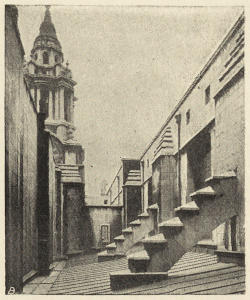
FLYING-BUTTRESSES AND SCREEN-WALL.
Externally, it is a building of two stories. Wren designed it originally for one story, but was unable to get big enough blocks of stone to carry a single gigantic Order, as at St. Peter’s, up to the cornice; for which we may be thankful. The façade also is composed of two Orders of columns, and they are necessarily comparatively small columns. But all appearance of weakness is admirably removed by arranging them in couples; indeed, one would be sorry to have instead of this noble design Wren’s own one-story façade as shown in his model,—still more to have that of Inigo Jones.
The harmony, too, of the noble design is delightful. The two stories of the columns of the façade become two stories of pilasters on the flanks of the nave; at the ends of the transepts they sweep round into lovely semicircular colonnades; colonnades form the central stages of the western steeples; the drum of the dome is encircled by a superb colonnade; the dome itself culminates in a colonnaded lantern. See, too, how the lantern, domical above and colonnaded below, sums up the composition of the dome beneath; and how the western steeples prepare the eye for the transition from the rectilinear colonnades of the great façade to the swelling curve of the dome,—itself reproduced in the north and south circular porches and in the apsidal choir. St. Paul’s is “a house at one with itself.”
It is true that the dead wall from aisle windows to cornice is perhaps the “most unmitigated building sham upon the face of the earth.” It has absolutely nothing to do at all except to hide away some flying-buttresses—the very ugliest eye ever saw—which Sir Christopher might well be reluctant to expose to the jeers of the man in the street. It is true, too, that there is built up in this dead wall enough good stone to construct half a dozen parish churches. It has been urged that it was built to weight the foot of each flying-buttress after the manner of a Gothic pinnacle. But not even a Gothic baby would have provided continuous abutment for intermittent thrusts. The dead wall may perhaps be[157] defended on artistic, but certainly not on constructional grounds.
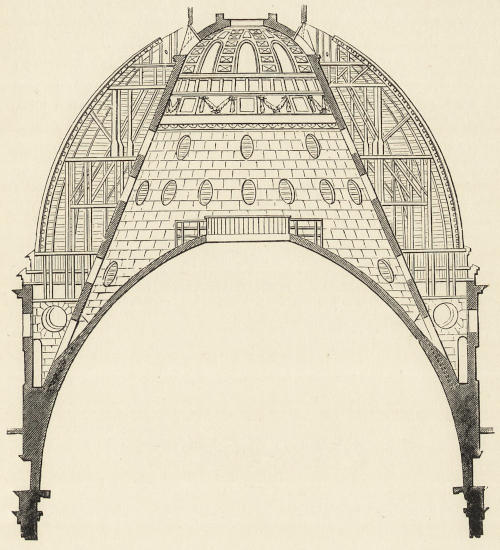
INNER DOME, CONE, AND OUTER DOME.
In the dome, Wren had three conflicting ideals to realise: (1) to make the dome so lofty that it should be visible externally from base to summit; (2) to make it so low internally that it should range with the vaulting of nave, choir, and transepts; (3) to finish it with a stone lantern as lofty and heavy as an ordinary church spire. At St. Peter’s the dome externally squats down so low that from most directions one must walk a mile away to get a complete view of it; the internal dome[158] is so lofty as to be invisible from most parts of the church; the lantern is much smaller and lighter than is required by so mighty a dome; and is in a condition of very unstable equilibrium, badly supported, cracked, and tied together in all directions. All these difficulties Wren triumphantly disposed of; nevertheless, for his triumph he has received little but censure and abuse. He made two domes; and brought the inner dome, which is of brick (see diagram), far lower than the outer one—though not low enough. Secondly, he mounted the outer dome, which is of wood covered with lead, on a lofty colonnaded drum, visible of all men even from the narrow street below. Thirdly, between the two domes (see diagram) he built a cone of brick, and on this cone he poised the lantern—which is as heavy as an ordinary church-spire—in perfect security. If the outer dome were removed—e.g., if it were burnt, as it may some day, being of wood—the lantern would still stand perfectly safe on its conical support. In the dome of St. Paul’s Wren’s engineering capacities culminate. But it is more than a piece of engineering. No tower, no spire, no group of towers or spires, impresses itself on the imagination like the dome of St. Paul’s. Lincoln and Salisbury, Lichfield and Durham, retire before the claims of this overwhelming younger pile,
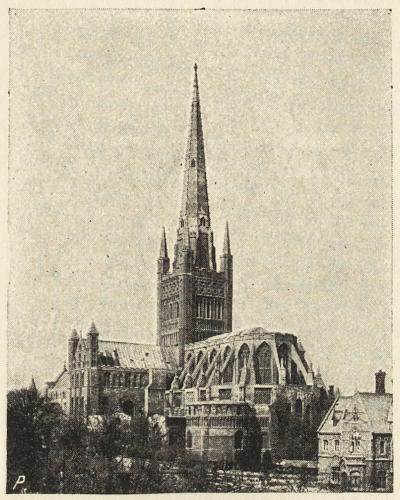
FROM SOUTH-EAST.
The ancient kingdom of East Anglia was converted to Christianity by a Burgundian monk, Felix, who became the first bishop of East Anglia—the diocese, as usual, being coextensive with the kingdom—and fixed his see at Dunwich in 630. The see was subdivided by the Archbishop Theodore, the great organiser of the English Church, in 669. It was again reunited, and the cathedral was at Elmham, till the bishop migrated in 1070 to Thetford, and in 1094 to Norwich.
The present cathedral was commenced in 1096 by Herbert de Losinga, who is usually described as a Lorrainer. He is recorded to have finished the whole cathedral before his death in 1119 as far as the altar of the Holy Cross, which would stand in front of the choir-screen. His successor finished the nave and west front, and carried up the central tower (1121-1145). The plan is that of Gloucester and Leominster; the rudiments of it appear in the ancient church[160] at Bethlehem and in St. Sepulchre at Jerusalem. There was an enormously long aisled nave of fourteen bays, aisleless transepts of three bays, an aisled presbytery of five bays, a semicircular apse, a processional aisle or ambulatory encircling the apse, and three segmental chapels radiating from the ambulatory; also eastern apses to the transepts. All this remains, except the easternmost apsidal chapel, which was replaced in the thirteenth century by an oblong Lady chapel, itself pulled down in the sixteenth century; and the apse of the south transept, which was replaced by an oblong chapel in the thirteenth century.
The history of Norwich cathedral, therefore, differs toto cœlo from that of every other English cathedral, except that of Gloucester. With the exception that both Gloucester and Norwich ultimately increased the dimensions of their eastern Lady chapels, no eastward extensions of any moment took place. This was not because the Norfolk people were more conservative than other people, or, in a remote corner of England, were behind the times; but because the plan of the Norwich cathedral was convenient for mediæval ritual, and the plan of the other cathedrals was not. Other cathedrals had to build a processional aisle at the back of the High Altar; at Norwich it was there already. Other cathedrals had to throw out eastern transepts to provide chapels for the great saints of the Church, St. James, St. John, St. Peter and the rest; Norwich cathedral from the first had five apsidal chapels. Other cathedrals had a local saint of the first water, and had to build a special saint’s chapel or feretory for his shrine: Canterbury for St. Thomas, Chester for St. Werburgh, Durham for St. Cuthbert, Ely for St. Audrey, Hereford for St. Ethelbert, Lichfield for St. Chad, Lincoln for St. Hugh, Oxford for St. Frideswide, Rochester for St. William, St. Albans for St. Alban, Winchester for St. Swithin, Worcester for St. Wolfstan. Norwich had no local saint of any great repute, except a poor little boy who was alleged to have been crucified by the Jews. Nor, again, did sacerdotalism much[161] affect the growth of Norwich cathedral. The nave was so vast that, even when the monks had appropriated five bays of it for their ritual choir, as they did at first, there still remained nine bays for processions, and for the laity to worship at the nave-altar of the Holy Cross. There was no need to crowd the stalls into the eastern limb of the church as the Canterbury monks had to do because of the shortness of their Norman nave. It is true that, later on, the Norwich monks moved eastward a little, placing their sixty stalls under the tower and in the two easternmost bays of the nave, where they are at present; but this was probably done merely to get better light, partly from the lantern-tower above, partly from the enlarged windows of the transepts. The original position of the choir is marked by the cylindrical piers, the fifth from the tower; by a hole in the vault, inside a boss, from which hung down a light or a censer; and by the corbelling of the eastern vaulting-shafts to leave room for the stalls.
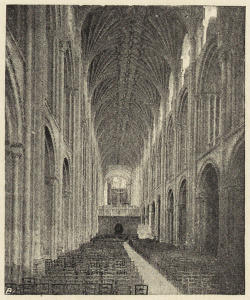
NAVE.
With these exceptions, the history of the cathedral mainly reduces itself to three sets of building operations: first, repairs necessitated by fire or storm; secondly, attempts to improve the lighting of the building; and, thirdly, to make it fireproof.
Taking these works in the above order, we first have to note the mischief done by fire and storm. In 1297 the tower[162] seems to have had a wooden spire. This was blown down in 1361; and, falling eastward, damaged the clerestory of the Norman presbytery. Both the spire and clerestory had to be rebuilt; and in rebuilding the clerestory the monks took the opportunity to remedy what was the gravest defect in all the Norman cathedrals—viz., their extreme darkness. Now, it happened that, only some ten years before, the magnificent clerestory of Gloucester presbytery had been built; and the report of the brilliant illumination and gorgeous glass of this grand work was bruited, no doubt, all over England by pilgrims returning from the shrine of the murdered Edward II. at Gloucester. Therefore, just as at Gloucester, they determined to raise the new presbytery higher than the nave—they raised it ten feet—and to make the clerestory practically a continuous sheet of glass. In one thing, fortunately, they did not copy Gloucester, as Edington did in Winchester nave—which is of the same date as the Norwich work—they did not think it necessary to discard altogether the beautiful flowing tracery of the Curvilinear period; and so here, as in many Norfolk churches, we find inserted, side by side, at the same time, Curvilinear and Perpendicular windows. Another charming feature of Curvilinear work was the ogee niche, such as those of the arcade of Ely Lady chapel. These niches, too, were utilised at Norwich cleverly and beautifully, being used instead of corbels to support the ribs of the roof. This fourteenth-century roof seems to have been one of wood.
But, earlier than this, a determined attempt had been made to get rid of the darkness of the nave by inserting (1315-1360) a range of windows with flowing tracery all along the north aisle of the nave. In the Perpendicular period (1360-1485) the monks took the same course as at Ely: they raised the triforium walls, closed the external windows of the triforium, flattened the roof of the triforium, and thus managed to get in a range of tall windows, each of four lights, in the hope that the light from them might find its way into the nave across the triforium; and that the more easily as the openings[163] of the inner arcade of the triforium were not obstructed by central shafts. The result is extraordinary, as seen from the garth. The south side of the cathedral, instead of the usual three or four stories, seems six stories high. First there are the openings of the cloister; then the upper story of the cloister; then the blind arcade of the triforium; then the Norman triforium windows; then the Perpendicular ditto; then the Norman clerestory.
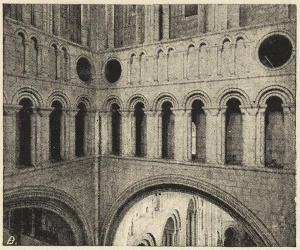
CENTRAL TOWER.
Even this was insufficient. The eastern bays of the nave, where the stalls were placed, and where, most of all, light was needed, were the darkest of all, being obstructed by the stalls and by the cloister roof. So in the exterior of the two easternmost bays of the nave the Perpendicular triforium windows and the Norman clerestory windows were thrown into one, to give as much light as possible to the stalls below. For the same reason large Perpendicular windows were inserted in the transepts. Several of these, however, have recently been replaced by Norman windows: “genuine Perpendicular by sham Norman.” In the middle of the south aisle of the nave Bishop Nix (1501-1536) built himself a gorgeous chantry, to light which he inserted two large windows, high up so as to clear the cloister roof. Large square-headed windows were inserted in the triforium of the presbytery also; and an enormous Perpendicular window was inserted in the west front, still further to light the nave. These measures were fairly successful in nave and[164] transept; but, fortunately for us, less successful than in the presbytery.
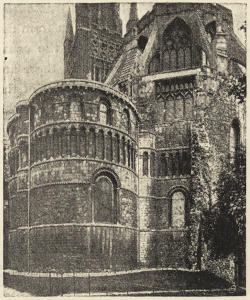
SOUTH-EAST APSE.
Now we come to the measures taken to make the building fireproof. These took the form of costly stone vaults, and they seem to have been undertaken by the monks most reluctantly. All the high vaults are the direct outcome of some great fire, and but for the fire they would not have been undertaken. There were conflagrations in 1170 and 1271, and in the fearful riots of 1272 the cathedral was set on fire by the citizens. Still, when the presbytery was repaired in 1362, it seems to have been roofed again in wood. In 1463 the wooden spire was struck by lightning, and set fire to the roofs both of nave and presbytery. At last the monks had to bestir themselves. To secure the spire against fire they rebuilt it in stone instead of wood; and, to make the nave and presbytery fireproof, they made up their minds to vault both in stone. Between 1463 and 1472 Bishop Lyhart put up over the nave the present magnificent lierne vault, and at his death bequeathed two thousand marks to his successor to continue the work. Bishop Goldwell vaulted the presbytery between 1472 and 1499. It seems to have been very difficult to get the funds for this costly work. Bishop Goldwell, however, was a personal friend of the Pope, who had consecrated him with his own hands; and he had not much difficulty in persuading the Pope to grant a perpetual indulgence in the terms that[165] “all who came to the cathedral on Trinity Sunday and Lady Day, and made an offering towards the fabric, should be entitled to an indulgence of twelve years and forty days.” The transepts had still wooden roofs. It required another fire—in 1509—in which these roofs were consumed, to compel the monks to complete the vaulting of the cathedral. This was done in the time of Bishop Nix. At the end of four hundred years Norwich cathedral was at length fireproof.
And did they do nothing merely for prettiness’ sake? Well, here, as at Gloucester, they set to work to do what was quite unnecessary—to harmonise the Norman ground-story of the presbytery with the clerestory of 1631. By one of those marvellous pieces of engineering, of which the mediæval architects were so fond—we saw a conspicuous example at Carlisle—while retaining the Norman triforium and the Perpendicular clerestory above, they managed to remodel the Norman piers on either side of the presbytery, and to take out the semicircular arches bodily and replace them by the fashionable arch of the period—a depressed four-centered arch. This was done by Bishop Goldwell—no doubt before he put up the vault above (c. 1475).
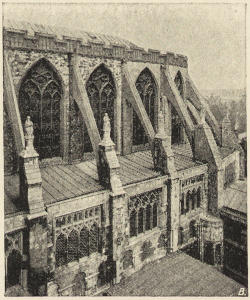
CHOIR.
The only other great work was the rebuilding of the cloisters, also forced on the monks by a great fire—that of 1272. This work was executed exceedingly slowly, the window tracery[166] ranging from Geometrical, through Curvilinear, to Perpendicular work.
One word more about the superb interior. It is hardly too much to say that the interior of this cathedral—but second-rate in point of dimensions—is unequalled in all England. One reason is that it is vaulted throughout. Ely, Peterborough St. Albans, Rochester, Romsey, Waltham, Southwell—with their paltry wooden ceilings—are not to be compared for a moment with Norwich. Gloucester and Chichester naves are vaulted, but the vaults are too slight and flimsy for the stern and massive work below. Durham vault is strong and satisfactory. But the lierne vault of Norwich is a far more glorious crown and finish than the rude work of Durham. It might be thought that the richness and magnificence of the lierne vault of Norwich would be out of harmony with the simplicity and heaviness of Norman piers and triforium and clerestory. It is not so. A tower, like that of Magdalen College, Oxford, may be ever so plain below, and yet terminate fitly with a glorious coronal of battlements, parapet and pinnacles. So it is with this interior.
Its rivals are to be found in Winchester and Tewkesbury. But at Winchester the vaults of nave and presbytery are cut in two by the unvaulted transept. Norwich and Tewkesbury are vaulted everywhere—from east to west and from north to south. And in both, the vaults being uniform in character, and not changing character half-way as at Gloucester, weld together the spreading limbs of the church into a marvellous unity.
But there is another fine feature about the interior of Norwich, as in that of Gloucester: it is the striking contrast of light and shade, of shadowy nave and brilliant choir. Hereford presents us with the reverse effect—bright nave and gloomy choir. Both effects are dramatic; both, doubtless, are unintentional. If they had known how, or could have afforded it, the Hereford people would have flooded their choir with sunshine, Norwich and Gloucester their naves.[167] The mediæval builders wanted none of these dramatic contrasts of light and shade; they were always working to get rid of the dim religious light that nowadays we venerate; they would have liked their churches lighted thoroughly well throughout. What they wanted was the light, uniformly good, of Lichfield and Exeter: or Salisbury, bright and gay as a ball-room.
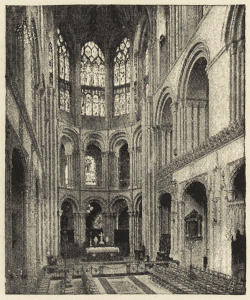
APSE OF CHOIR.
But the most subtle and most important element in the beauty of the interior of Norwich is to be found in its proportions. The nave is of an immense length, but it is very narrow. York, Canterbury, Lincoln, Durham, all have naves far too short for their breadth. And what is more important still is the ratio of the height of Norwich nave to its span. In most English cathedrals it is 2 to 1; but in Norwich nave the ratio rises to 2⁴⁄₇, and in the presbytery it is 3 to 1. In Norwich presbytery, then, we have just those proportions which we find in the great Gothic cathedrals of France, but in England hardly anywhere except in Westminster Abbey. People[168] admire Norwich presbytery and Westminster presbytery for the same reason, and, no doubt, in most cases, without knowing what the reason is.
One thing more remains to be said in praise of Norwich, as of Gloucester. It is that all the glory of the church is concentrated at one spot, and that the most important spot in the church. It is in approaching the high altar that vaults and clerestory soar aloft, that loveliest vistas open out into ambulatory and chapels, while the noble windows above fill all with light and atmosphere. “I would back it,” says Dean Goulburn, “against any similar effect in almost any cathedral in Christendom.”
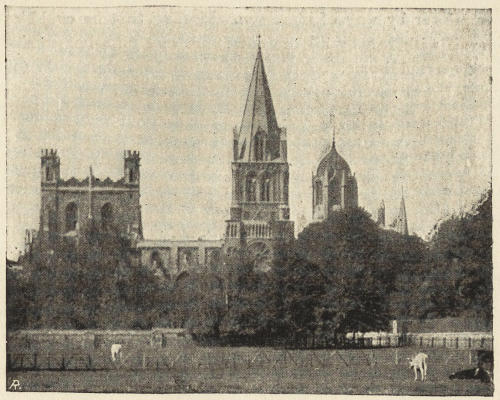
FROM THE FIELDS.
“About the year of our Lord 727, there lived in Oxford a Saxon prince named Didan, who had an only child, Frideswide (‘bond of peace’). Seeing that he had large possessions and inheritances, and that she was likely to enjoy most of them after his decease, Frideswide told her father that he could not do better than bestow them upon some religious fabric where she and her spiritual sisters might spend their days in prayers and in singing psalms and hymns to God. Wherefore the good old man built a church, and committed it wholly to the use of his daughter, purposely to exercise her devotion therein; and other edifices adjoining to the church, to serve as lodging-rooms for Frideswide and twelve virgins of noble extraction. There she became famous for her piety and for those excellent parts that nature had endowed her withal; and Algar, King of Leicester, became[170] her adorer by way of marriage. Finding that he could not prevail with her by all the entreaties and gifts imaginable, he departed home, but sent to her ambassadors with this special and sovereign caution, that if she did not concede, to watch their opportunity and carry her away by force. Frideswide was inexorable. Wherefore at the dawning of the day the ambassadors clambered the fences of the house, and by degrees approaching her private lodging, promised to themselves nothing but surety of their prize. But she, awakening suddenly and discovering them, and finding it vain to make an escape, being so closely besieged, fervently prayed to the Almighty that He would preserve her from the violence of those wicked persons, and that He would show some special token of revenge upon them for this their bold attempt. Wherefore the ambassadors were miraculously struck blind, and like madmen ran headlong yelling about the city. But Algar was filled with rage, and intended for Oxford, breathing out nothing but fire and sword. Which thing being told to Frideswide in a dream, with her sisters the nuns Katherine and Cicely, she fled to the riverside, where there awaited her a young man with a beautiful countenance and clothed in white, who, mitigating their fear with pleasant speech, rowed them up the river to a wood ten miles distant. There the nuns sheltered in a hut, which ivy and other sprouts quickly overgrew, hiding them from sight of man. Three years Frideswide lived in Benton wood, when she came back to Binsey and afterwards to Oxford, in which place this maiden, having gained the triumph of her virginity, worked many miracles; and when her days were over and her Spouse called her, she there died.” Such is the account of her which Anthony-a-Wood drew from William of Malmesbury and Prior Philip of Oxford, both of whom unfortunately lived long after the events which they narrate.
I. In the east walls of the north choir-aisle and the Lady chapel three small rude arches have recently been found,[171] and outside, in the gardens, the foundations of the walls of three apses. Hence it has been concluded that we have here the eastern termination of Frideswide’s eighth-century church. It may be so, but the central arch seems very small for the chancel-arch of an aisled church. It is indeed a foot wider than the chancel-arch of the Saxon church at Bradford-on-Avon, but that tiny church has no aisles. Moreover, if the side-arches led into aisles, they would be likely to be of the same height, whereas the southern arch is considerably the higher of the two.
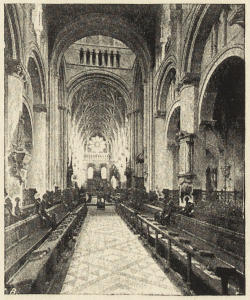
NAVE.
II. At some later period—perhaps in the eighth or ninth century—the foundation was converted into one of secular canons, married priests taking the place of the nuns (cf. Ely). The secular canons themselves in turn gave way to monks, and these in 1111 to regular canons—i.e., canons living in monastic fashion under the rule (regula) of St. Augustine, as at Bristol, Ripon, and Carlisle.
The first business, probably, of the secular canons was to house themselves—i.e., to build themselves the usual cloister, with its appanages of chapter-house, refectory, dormitory, etc. Of the chapter-house which they built, c. 1125, the doorway still remains.
In 1004 King Ethelred had rebuilt the Saxon church; and probably it was found possible to put this church into such[172] repair as would allow the services to be held in it for the time being. At any rate, it was not till 1158 that they commenced the present cathedral, which they finished in 1180, leaving not a stone standing of Ethelred’s cathedral. Of the theory that the present cathedral is in the main the one built in 1004, I would prefer to say nothing, had it not been adopted in a recent history of the cathedral; suffice to say that, like the sister theory that Waltham Abbey was built in 1060, it is an absolute impossibility. The hands of the archæological clock cannot be turned 160 years back in this preposterous fashion.
The twelfth-century church was very remarkable in plan. Not only had it an aisled nave and an aisled choir, but it had the architectural luxury, unparalleled in our Norman architecture except in the vast churches of Winchester and Ely, of eastern and western aisles to its transepts. The site, however, was cramped to the south, and so the southern transept was shorter than the northern one; moreover, this short transept later on lost its west aisle, which was lopped off to allow the cloister to be extended. For the same reason—lack of room—the slype, or vaulted passage, which in all monastic institutions connected the cloister with the cemetery, instead of being built between the transept and the cloister, was built inside the church, as at Hexham, curtailing still further the floor area of the north transept. It was therefore because the church was so cramped to the south, that the other transept was given aisles on both sides. Instead of an eastern aisle, the south transept had merely a square chapel projecting eastward.
But the canons wanted also a Lady chapel, for the church seems to have been dedicated originally to the Holy Trinity, St. Mary and St. Frideswide. The normal position of a Lady chapel was to the east of the sanctuary. But here also the canons were cramped; for quite close to the east end of the church ran the city wall. To get in a Lady chapel, therefore, they had to build an additional aisle north of the north aisle[173] of the choir. This was three bays long. It was probably walled off from the transept, but opened into the north choir-aisle by three Norman arches, reconstructed later on. The same arrangement is found at Ripon. There was also a short chapel projecting eastward from the northernmost bay of the east aisle of the north transept.
The east end, as at Rochester and Ripon, was square. The present east end is a fine composition by Scott, more or less conjectural. The work commenced, as usual, at the east, as is shown by the gradual improvement westward in the design of the capitals. The evidence of the vaulting, too, points in the same direction. In the choir-aisle the ribs are massive and heavy; in the western aisle of the north transept they are lighter; in the south aisle of the nave they are pointed and filleted.
The transepts are narrower than the nave and choir; the tower, therefore, is oblong, and, as at Bolton Priory, its narrow sides have pointed arches: semicircular arches would have been too low. The faces of the piers of the towers are flat, because the stalls of the canons were placed against them and in the eastern bays of the nave, leaving the whole eastern limb as sanctuary.
The clerestory walls are only 41½ feet high; therefore, to have adopted the usual Norman design—viz., triforium on the top of pier-arcade—would have made the interior look very squat: so, instead of building the triforium above the pier-arcade, it was built beneath it. The lofty pier-arches, thus gained, add greatly to the apparent height and dignity of the interior. The lower arches, however, which carry the vault of the aisle behind, are corbelled into the piers in very clumsy fashion. The design is not original; it was worked out at Romsey in a single bay of the nave, but, being thought ugly, was promptly abandoned. It is worked out more successfully in Dunstable Priory church and Jedburgh Abbey. The clerestory windows of the nave would be built not much before 1180; naturally, therefore, they are pointed. The capitals of all the[174] twelfth-century work are full of interest. Indeed, Transitional capitals—each an experiment, and all differing—partly conventional, partly naturalistic, with a dash of Classic—are to me much more interesting than any of the Gothic capitals, except perhaps the naturalistic capitals of the later Geometrical period. There is a great sameness about the foliated capitals of the Early English, Curvilinear, and Perpendicular periods. I need hardly say that no one of these capitals came from Ethelred’s church.
The whole church is exceedingly interesting. It fills a niche in the history of English architecture all by itself. It is not the plain and austere Transitional work of the Cistercians. On the other hand, it has not yet the lightness and grace of Ripon; still less the charm of Canterbury choir, Chichester presbytery, Wells and Abbey Dore—Gothic in all but name. In spite of its foliated capitals, in spite of a pointed arch here and there, it is a Romanesque design; yet not so Romanesque as Fountains, Kirkstall, Furness.
III. In the Lancet period (1190-1245) the works went on apace. An upper stage was added to the tower, and on that the spire was built—the first large stone spire in England. It is a Broach spire: i.e., the cardinal sides of the spire are built right out to the eaves, so that there is no parapet. On the other hand, instead of having broaches at the angle, it has pinnacles. Moreover, to bring down the thrusts more vertically, heavy dormer-windows are inserted at the foot of each of the cardinal sides of the spire: altogether a very logical and scientific piece of engineering, much more common in the early spires of Northern France than in England.
The chapter-house also was rebuilt (c. 1240); rectangular, to fit the cloister. Also, the canons rebuilt both the Lady chapel and the adjoining transeptal chapel. Lancet work will be seen in all the piers on the south side of the Lady chapel, and in the second and third piers from the west, on its north side. The cult of the Virgin, much fostered by the Pope, Innocent III., was at its height in the thirteenth century.[175] The Lady chapels of Bristol, Hereford, Salisbury, Winchester and Norwich were contemporaries of that of Oxford.
IV. To the latter half of the Geometrical period belong the fragments of the pedestal of St. Frideswide’s shrine, which has beautiful naturalistic foliage like that of the contemporary pedestal of St. Thomas of Hereford, A.D. 1289. Some twenty years later is the fine canopied tomb of Prior Sutton.
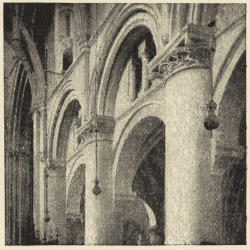
CHOIR.
V. In the Curvilinear period (1315-1360) the eastern chapel of the north transept was pulled down, and in its place was built a chapel of four bays, with four side windows of singularly beautiful tracery, and all different. They contain fourteenth-century glass, which should be compared with that in St. Lucy’s chapel and in Merton College chapel. The bosses are very beautiful: one of them has a representation of the water-lilies of the adjacent Cherwell. Hard by is the tomb of Lady Montacute, who gave the canons about half the Christ Church meadows to found a chantry. The chapel goes by various names: St. Katharine’s chapel, the Latin chapel, and the Divinity chapel. It contains good poppy-heads of Cardinal Wolsey’s time.
About the same time the eastern chapel of the south transept—St. Lucy’s chapel—was enlarged. The tracery of its east window starts in an unusual fashion below the spring of the arch.
Also the Norman windows were replaced here and there by large windows with flowing tracery, to improve the lighting of the church.
VI. There is little to show for the long Perpendicular period (1360-1485), except the insertion of a few large Perpendicular windows, and the so-called “Watching-chamber,” the lower part of which is the tomb of a merchant and his wife, the upper part probably, the chantry belonging to it, c. 1480.
VII. In the Tudor period, however, the canons were exceedingly busy. They set to work to make the whole church fireproof by covering choir, transepts, and nave with stone vaults. The choir vault is rather overdone with prettinesses. It is a copy—and an inferior one—of the massive vault of the Divinity School, which was completed c. 1478. Canon Zouch, who died in 1503, left money to proceed with the vault of the north transept, beneath which is his tomb. Only a small portion of this was completed. In the clerestory of the nave also corbels were inserted to support a stone vault; but the resources of the canons seem to have failed, and the rest of the church received roofs of wood. Another considerable work was the rebuilding of the cloisters.
VIII. Finally, the whole establishment was granted in 1524 to Cardinal Wolsey, who pulled down the three western bays of the nave, as obstructing his new quadrangle: one bay has been recently rebuilt.
IX. In 1542 Henry VIII. founded the new diocese of Oxford. Till 1546 the seat of the bishopric was at Osney Abbey. On the suppression of the abbey it was transferred to Wolsey’s confiscated foundation; and the ancient Priory church became a cathedral, while at the same time it is the chapel of the college of Christ Church. There is an interesting contemporary window in the south choir aisle, showing the first bishop of Oxford, King, with Osney Abbey on one side. The “merry Christ Church bells” came from the tower shown in this window.
X. At the entrance to the Great Hall is the last bit of good Gothic done in England, a sort of chapter-house in fan-tracery.
XI. The cathedral possesses a charming Jacobean pulpit,[177] and a large amount of fine Flemish glass of the seventeenth century—all of it taken out and stowed away in some lumber-room at a recent restoration, except one window at the west end of the north aisle of the nave, in order to insert some sham mediæval windows.
XII. There are also five windows from designs by Sir Edward Burne-Jones—three of them of great beauty; good windows by Clayton and Bell in the end walls of the transepts; and a charming reredos by Mr. Bodley, who also has the credit of the bell tower.
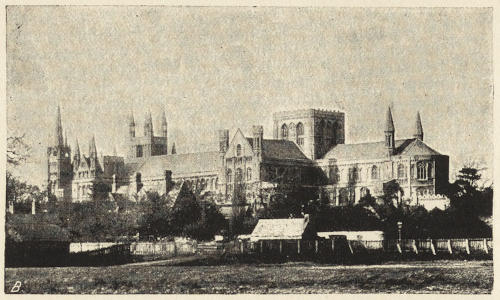
FROM THE SOUTH.
St. Augustine landed in Kent A.D. 597. In the next year Peada and Wolfhere, successive kings of Mercia, founded a monastery at Peterborough, then called Medeshamstead (“the homestead in the meadow”), and consecrated the church in the names of St. Peter, St. Paul, and St. Andrew. Then said King Wulfhere with a loud voice: “This day do I freely give to St. Peter and to the abbot and to the monks of this monastery these lands and waters and meres and fens and weirs; neither shall tribute or tax be taken therefrom. Moreover I do make this monastery free, that it be subject to Rome alone; and I will that all who may not be able to journey to Rome should repair hither to St. Peter.” This consecration took place in 664. In 870 this, the first church, was destroyed by the Danes. It was not fully rebuilt till 972. Abbot Elsinus (1006-1055) collected many curios: pieces of the swaddling clothes, of the manger of the cross, and of the sepulchre of Christ; of the garments of the Virgin, of Aaron’s[179] rod, a bone of one of the Innocents, bits of St. John the Baptist, St. Peter, and St. Paul, the body of St. Florentinus, for which he gave 100 lbs. of silver, and, most precious of all, the incorruptible arm of the Northumbrian king, Oswald, believed by half the population of England to be an effectual cure for diseases which defied the material power of drugs. Here is Bede’s account of it: “When Oswald was once sitting at dinner with Bishop Aidan, on the holy day of Easter, and a silver dish of dainties was before him, the servant, whom he had appointed to relieve the poor, came in on a sudden, and told the king that a great multitude of needy persons were sitting in the streets begging alms of the king. He immediately ordered the meat set before him to be carried to the poor, and the dish also to be cut in pieces and divided among them. At which sight the Bishop laid hold of the King’s right hand, and said, ‘May this hand never perish,’ which fell out according to his prayer; for his arm and hand being cut off from his body, when he was slain in battle, remain entire and incorrupted to this day, and are kept in a silver case as revered relics in St. Peter’s church in the royal city.” Even King Stephen came to see it; and, what is more, remitted to the monks forty marks which they owed him. Benedict was a monk at Canterbury when Becket was murdered; and when he became Abbot of Peterborough in 1177, he brought with him the slabs of the pavement which were stained with the blood of the martyr, fragments of his shirt and surplice, and two vases of his blood. So that the monastery was called “Peterborough the Proud,” and waxed rich and mighty, and church and close were holy ground, and all pilgrims, even though of royal blood, put off their shoes before passing through the western gateway of the close.
I. The second Saxon church of 972 seems to have lasted till 1116, when it was destroyed by fire, and the present church, the third, was commenced. The foundations of part of this Saxon cathedral have been recently disinterred beneath the present south transept. It was cruciform, with a square[180] east end. The east limb was 23 feet each way; the transept was 88 feet long. Its walls were under three feet thick, so that it cannot have been intended for a vault. There is no proof that the nave was ever built.
II. In 1116 the Saxon cathedral was seriously injured by a great fire, and next year Abbot John of Sais (Seez) commenced the present Norman cathedral. In 1140 the monks entered on the new choir, which was now complete, together with the eastern aisles and eastern wall of the transepts. It is possible that the monks patched up the damaged Saxon church sufficiently to allow service to be held in it from 1116 to 1140.
When they entered into their new Norman choir, the first thing they did, probably, was to pull down the choir and transept of the Saxon church, and on the site to erect the rest of the present south transept.
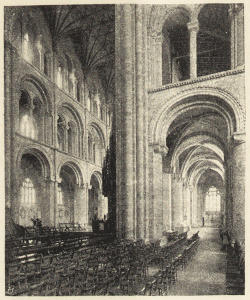
CHOIR AND TRANSEPT.
Then they built the rest of the north transept. It will be noticed that it is superior in design to the south transept, its windows are splayed, and their ornamentation of later character. This north transept is illustrated by M. Viollet-le-Duc as a specially fine example of English Romanesque.
Next would be built the remaining piers and arches of the crossing, and a low lantern tower of one story only. But the western piers would not stand without abutment, and so a certain amount of[181] the eastern bays of the nave must have been built at the same time. This comprised two bays of the triforium, for the tympana of the two eastern bays of the triforium have rude ornaments not found elsewhere in the nave. Below, it probably comprised four piers and four arches, for the four eastern piers on the north side have different bases from those to the west.
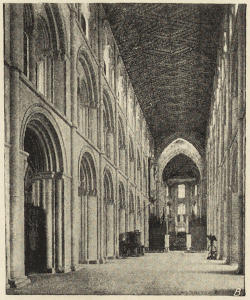
NAVE.
Hitherto the north wall of the Saxon nave, if built, may have been retained to shut in the cloister on the north. Now it would be pulled down and replaced by the wall of the present south aisle of the nave. Then would come the wall of the north aisle, and finally the pier-arcade and triforium, but not yet the clerestory of the nave. The nave was to be in plan precisely like that of Durham: it was to be a short nave; the central aisle to have eight bays; the side aisles were to have only seven bays, the end of each aisle being occupied by a tower, as at Durham. The ground stories of these towers now form the third bays from the west on either side of the nave. It will be noticed that the third piers from the west are exceptionally massive and strong, and that in this bay the aisle-walls are thickened. The wide arches of these bays were intended to open up the towers into the nave.
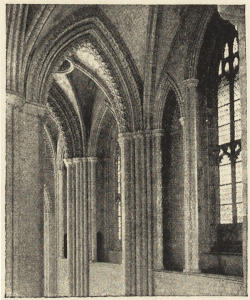
VAULTING UNDER SOUTH-WEST TOWER.
But the towers were not built. The Ely monks over the way were building a nave with no less than twelve bays, and[182] with a western transept as well. The Peterborough monks would not like to be outdone by Ely; so they determined also to have a long nave and a western transept as well. They built only ten bays to the twelve of Ely; on the other hand, their nave, excluding western transept, was 211 feet long, while that of Ely was only 208 feet. About the same time, or probably a little earlier, the clerestory of the nave—in which pointed arches occur—was built. All this work may be assigned to Abbot Benedict (1175-1193), who is said by Swapham and John to have built the whole nave as far as—but not including—the present west front. The statements of Swapham, however, must be wrong here. He was still living c. 1240; so that he was only a boy when the nave was finished. He may possibly in his boyhood have seen the clerestory of the nave built, and, in writing half a century after, have thought that Benedict who built the clerestory, had built the triforium and ground-story also. But the documentary evidence at Peterborough must be received with the utmost scepticism. All that we know for certain is that the choir and the eastern portions of the central transepts were built between 1118 and 1140; and that the central transept, central tower, nave and western transept were built between 1140 and 1190.
III. Lancet (1190-1245).—The east end of the church[183] consisted of three parallel apses. The apses of the aisles were now replaced by narrow oblong bays: those next to the New Building.
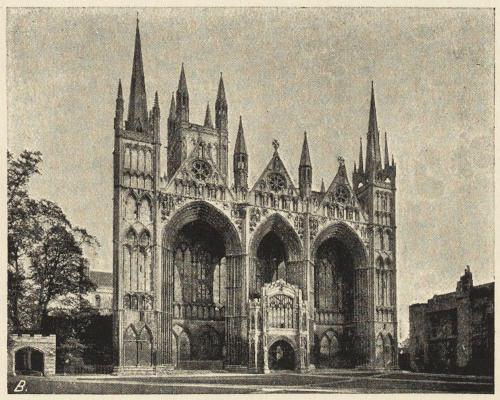
WEST FRONT.
In the middle of the Lancet period was erected the grand façade in front of the Transitional western transept. It is not so much a façade, however, as an open portico or piazza. Several interesting engineering problems were involved. One was, how to keep up the three gigantic arches. If they had spread to north or south, the whole façade would have collapsed. To prevent their spreading, therefore, flanking towers were built to north and south; which in later days were weighted with spires. But there was a more serious danger. The two great isolated piers might be pushed outwards by the western thrust of the arches of the nave. These thrusts the builders stopped by building two towers; one over the westernmost bay of each aisle of the nave. The northern of these towers was soon after heightened; the other—the[184] Bell Tower—remains low. The central gable had to be narrow, because it is the termination of the nave roof. The side-arches and side-gables had to be wide, to span the space from the nave to the sides of the Transitional façade behind. Though much narrower, however, the central gable rises as high as the lateral gables, being made to spring at a higher level; and it is made to look as important as the broad side-gables by being given the company of two powerful pinnacles. Thus the main features of this magnificent design are due to difficulties of planning and construction. The design is said to be drawn from Lincoln; it is more likely that it is an amplification of John de Cella’s lovely design for the west front of St. Albans. Abbot Acharius, who may well have commenced the work (1200-1210) had been Prior of St. Albans under John de Cella. Judging from the billet and nebula ornament on the gables, and from the arcading, in which semicircular arches and round-headed trefoils occur, the façade was designed in the very beginning of the thirteenth century.
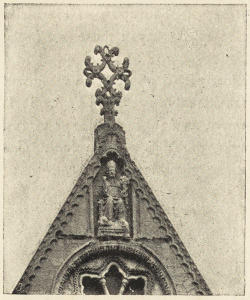
GABLE.
The west front of Peterborough has been severely criticised, especially by Mr. Pugin. To many it will ever seem the highest effort of English art, and to be at once the most original and most successful façade either in English or in Continental Gothic. Yet, magnificent and poetic as it is, we have not the full effect contemplated by the mediæval builders. They meant to have four towers, not three. The north-west tower was once crowned by a wooden spire; we[185] may be sure that there would have been a spire also on the south-west tower. Add, too, in the background, the tall spire which was to be added to the central tower, and you have a group before which even Lichfield and Lincoln would pale into insignificance. But, even curtailed as it is, the design attains the sublime. When first its Titanic arches rose into the blue sky, its builders may well have repeated the psalmist’s words: “Lift up your heads, O ye gates; and be ye lift up, ye everlasting doors; and the King of Glory shall come in.” They had built a worthy portal to the House of the Almighty.
IV. Geometrical (1245-1315).—In this period the bell tower was carried up; and a magnificent Lady chapel was built (c. 1290), like that at Bristol, to the north of the choir, but detached from it. It could not be built east of the choir, as a high road passed close to the apse. This Lady chapel was pulled down in the seventeenth century for the sake of its materials.

FROM SOUTH-EAST.
V. Curvilinear.—In this period the weight of the Norman tower, which had of course very thick walls, and was three or four stories high, was found to be too much for the exceptionally weak piers on which it stood. Warned, perhaps, by the fate of the central towers of Ely and Wells, both of which collapsed about this time, they took down the Norman tower, and built a new one (which has recently[186] been rebuilt), much lighter and much lower. And they strengthened its eastern and western semicircular arches by inserting pointed arches beneath them. The south-west spire was also built—a design of exquisite beauty.
VI. Perpendicular.—The monks wanted to have a Galilee porch, and they inserted one between the piers of the west front, where it was constructionally useful by keeping the piers from bulging in. The wooden screens were now inserted in the central transept.
Peterborough, after 1116, seems to have had a singular immunity from fire; so, very unlike Norwich, the monks did not take the slightest trouble to make their church fireproof. The whole of the high roofs are of wood. That of the nave may possibly be the original twelfth-century ceiling. A twelfth-century wooden roof still covers the Bishop’s Palace at Hereford. The choir has a wooden vault of the fifteenth century.
VIII. In another respect the history of the church is uneventful. The eastern limb must have been exceedingly inconvenient, for there was no processional aisle or ambulatory round the apse. Every other large church pulled down or altered its eastern limb to suit the ritual: the Peterborough monks, always conservative and always behind the times, did not provide a processional aisle till the latter days of Gothic. And even then they took a very long time about it. The works seems to have been suspended in 1471, and not resumed till 1496. Even then, good conservatives that they were, they did not pull down the apse, but erected the New Building round it. It is a rich specimen of Tudor work, with a fan vault.
IX. In the matter, too, of the roof-drainage the Peterborough monks were slow to move. Instead of dripping eaves they constructed gutters and parapets to the aisles in the early years of the thirteenth century, and to the apse a little later. It was not till c. 1330 that they provided the high roofs of nave and choir with gutters and parapets; and,[187] with their wonted conservatism, they retained the Norman corbel-table.
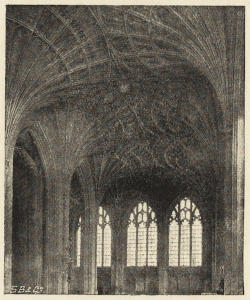
RETRO-CHOIR
X. What the monks cared most about was the lighting of the church. This they were always trying to improve. In the thirteenth century they inserted large geometrical windows in the western transept, and c. 1290 others in the aisles of the central transepts to light the altars placed there. Moreover, the Norman windows in the aisles of the nave were replaced by wide windows of five lights. In the Curvilinear period the triforium windows were transformed, and charming flowing tracery, with rear-arches, was inserted in the windows of the apse, which then looked into the open air, but now look into the New Building. In the Perpendicular period some seventy-five windows were either enlarged or filled with rectilinear tracery. The builders certainly achieved their object. The cathedral is well lighted. We may be thankful that they did[188] not stick a great Perpendicular window in each end of the central transept.
XI. In 1541 the church was made a cathedral on the new foundation. Henry VIII. is said to have preserved it as a mausoleum to his first wife, Catharine of Arragon, who is buried in the choir. It is wretchedly built—the west front and the New Building as badly as the Norman work—and practically without foundations. Much underpinning has been done, and more is required. The west front has been saved for the present by judicious treatment.
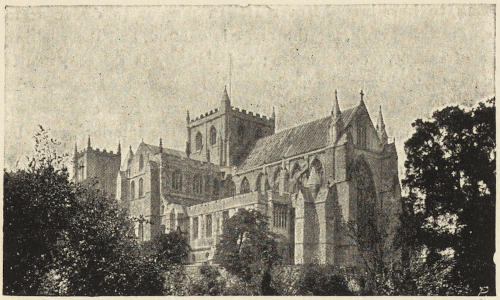
Ripon minster has passed through strange vicissitudes. It was founded c. 660 as a monasterium or minster for Scottish monks attached to the Celtic church. Soon afterwards it was taken away from them and granted to the famous St. Wilfrid. In 678 the church became a cathedral, but only during the lifetime of Bishop Eadhed. Ultimately it passed into the hands of regular canons of the Augustinian Order. It was dissolved with the other collegiate churches by Edward VI. It was made collegiate once more by James I., but with dean and prebendaries instead of Augustinian canons. In 1836, for the second time, it became a cathedral.
I. Both the minsters built by St. Wilfrid—Ripon and Hexham—retain their crypts. He was a Romaniser in architecture as in ritual, and well acquainted with Italy. So his seventh-century church at Ripon was modelled after the early Christian basilicas which he had seen at Rome. Like them, it had a confessionary or crypt, which still exists, beneath the central tower; like them, it was orientated to the west. He seems[190] even to have brought over Italian masons to direct or to execute the work, for the crypt is vaulted, and the vaulting is of excellent construction; the masonry is smooth, and is covered “with a fine and very hard plaster which takes a polish.” At its west end was the altar, at its east end an aperture through which a glimpse of the interior might be obtained from the Saxon nave. Round the walls are little niches in which lights were placed. “St. Wilfrid’s Needle” is merely a niche with the back knocked through. Similar Saxon crypts remain at Hexham and Wing, and a Norman crypt at St. Peter-in-the-East, Oxford. They usually consisted of a small central chamber, with a passage all round it. There were two staircases descending from either side of the nave; pilgrims went down one flight of steps, proceeded along the passage, getting a glimpse of the relics through openings in the wall of the central chamber, and then returned up the other flight of steps into the nave.
IV. Norman.—Early in the twelfth century a Norman cathedral seems to have been built, wholly or in part, by Archbishop Thurstan. Of this there remains only an apsidal building, with crypt beneath, on the south side of the south aisle of the present choir. An eleventh-century chapel formerly existed, with crypt beneath it, in precisely the same situation at Worcester; there is a twelfth-century chapel in the same position in Oxford cathedral. In Oxford this chapel was the Lady chapel. It may be that the Ripon chapel also may have been a Lady chapel. For if the Norman choir was of the same length eastward as at present, it would have been impossible to build a Lady chapel of the type of that, the crypt of which still exists at Winchester, to the east of the choir; the ground falls far too steeply eastward. Moreover, the so-called Lady loft now existing would seem, from its name, to be merely an upper story added to a Lady chapel. This Norman chapel formerly opened into the Norman church; traces of the arches may be seen in the walls. In the buttress is a curious room which may have been a[191] sacristy, a lavatory, a prison, or an anchorite’s cell, like the one in the east end of Ludlow church.
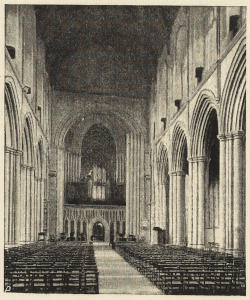
NAVE.
V. Transitional.—From 1154 to 1181 there ruled at York a man of the greatest energy and power—Archbishop Roger. He condemned his two Norman churches at York and Ripon; made no attempt, as at Peterborough and Ely, to improve them; simply pulled them down, and started again de novo. The two new minsters seem to have been somewhat similar: both had square east ends, both had exceptionally broad naves. But Ripon minster was merely the church of Augustinian canons, therefore it was not planned in cathedral fashion. Our ancient collegiate and parish churches seem to have followed some other model than the early Christian basilicas which furnished the plans of the cathedrals. Most of our parish churches originally were without aisles; and even large churches of the regular canons frequently had no aisles to the nave. This was the case in Roger’s new church at Ripon, and at Bolton Priory (also Augustinian). Later on, indeed, the Ripon canons added north and south aisles to their nave, and the Bolton canons a north aisle to their nave—they could not add a south aisle also, as they had a cloister[192] to the south. But originally both churches had aisleless naves. That of Ripon was 40 feet broad—broader than any nave in England, except York, which is of the breadth of 45 feet. The combination of unaisled nave and aisled choir must have produced a very remarkable interior; quite unlike anything now existing in England, but to be paralleled by the Spanish cathedral at Gerona (illustrated in Street’s “Gothic Architecture of Spain”).
Of this Transitional nave nothing is now left except two fragments, one at the east, and one at the west end on either side. All the rest has been replaced by sixteenth-century piers, arches, and clerestory. But if in imagination the two ends of the Transitional nave are joined together—it is well to do so in an actual drawing—the design of the whole of the original nave can be recovered with exactitude. A very remarkable design it was. It consisted of three stories; the lower story was simply a blank wall. The second, the triforium, was merely a passage in the thickness of the wall, ornamented in front by a tall pointed arcade. The clerestory had three tall slender lancet windows in each bay, all of the same height, separated by two detached piers. The strangest feature of the nave was that neither in the ground-story nor in the triforium were there any windows. Everywhere else people were trying to get all the windows possible into their churches; here alone a “dim, religious light” was preferred. And filtering in, as it did, through small lancet windows at a great height, as in Pugin’s cathedral at Killarney, the effect must have been most dramatic. The destruction of this unique nave is one of the heaviest losses that English architecture has sustained.
Of the central tower, the south-east pier has been rebuilt; the north-east and south-west piers have been cased. The north and west arches of the tower survive; the south and east arches have been rebuilt. The nave was considerably wider than the central aisle of the choir; the tower was therefore not built square; the northern arch being set obliquely,[193] and not parallel to the southern one. Outside, however, the north side of the tower is corbelled out till the tower becomes square.
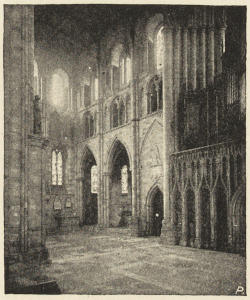
NORTH TRANSEPT.
The design of the choir is best seen in the east side of the north transept, which retains the original round-headed windows. In the choir the western windows of the north aisle were converted into lancets in the thirteenth century. The design of transept and choir is almost Greek in its severity. Very effective is the contrast of broad wall-surface and plain splayed window with the light and slender shafted arcades of triforium and clerestory. In proportions, too, it is superior to nearly all later designs. The pier-arches are tall and narrow, and the triforium thoroughly subordinated to the tall clerestory; the proportions approximate closely to those of Westminster Abbey and Beverley Minster. It is remarkable, too, for the studied absence of foliated ornament. Not that the builders could not design a foliated capital; they have left one or two, in unnoticed corners of the north transept, to show their powers. All the capitals of the choir are moulded capitals, as at Roche Abbey—perhaps occurring here for the first time. Being a first attempt, they can hardly be considered a success; they were soon to be improved upon in the French crypt of Canterbury. The designer relied on architectural effects pure and simple, and was followed in his[194] ascetic self-restraint sixty years later in the eastern transept of Fountains and at Salisbury. Even more remarkable is the complete abolition of Norman ornament. The billet, the zigzag, the whole barbaric congeries of Norman ornament is contemptuously cast aside. In this respect, indeed, Ripon is much more advanced than Canterbury choir, which was not commenced till 1174. The clerestory, however, is of a familiar Norman type, being an adaptation of that of Romsey and Waltham Abbey, and Peterborough and Oxford cathedrals; it was reproduced a little later in Hexham choir.
The vaulting-shafts rest on the abaci, French fashion. In the choir there are five vaulting-shafts, which in the clerestory diminish to one. The effect is not satisfactory, and a different treatment is adopted in the transept. It is noteworthy that the vaulting of the north transept aisle contains an exceptionally early example of ridge-ribs, both longitudinal and transverse.
In spite of round-headed windows and round-headed arches here and there, the whole design of the interior is light and graceful, thoroughly Gothic. Externally it is just the reverse; but for a pointed arcade in the clerestory one might imagine one was back again in the early days of the twelfth century. But when one compares the interior with that of Oxford Cathedral, which is precisely contemporary, and in which the spirit of Gothic is wholly absent, suspicion rises to certainty: Ripon Minster must have been designed under French influence. The tall, acute, pointed pier-arches of Notre Dame, Chalons-sur-Marne, and Sens (commenced c. 1140) reappear in Ripon choir, and the undoubtedly French choir of Canterbury. The Chalons triforium reappears in the north wall of Ripon transept; the Chalons clerestory in that of Ripon nave. The clerestory of Ripon choir is practically that of the French choir of Canterbury, itself probably suggested by that of Sens. French too, are the vaulting-shafts of the choir, insecurely balancing on the abaci; and the broadness and plain splays of the windows.
IV. Lancet.—To this period belong the vaulting and piers of the present chapter-house; and the west front, which, like York transept and Southwell choir, is attributed to Archbishop Gray (ob. 1255). The west front is too flat; deficient in play of light and shade; correct and uninteresting. It is ruined by the loss of its wooden spires, removed in 1664; and by the miserable little pinnacles put up in 1797. Before the aisles were built, these towers projected clear of the nave, their inner walls are Transitional; but the Transitional arch has been taken out and replaced by one of the Lancet period.
V. Geometrical.—The lower row of lancets in the west front once had charming tracery, inserted early in the Geometrical period. This was destroyed by Scott.
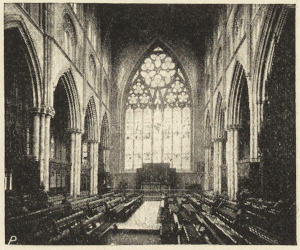
CHOIR, LOOKING EAST.
About 1280 the east end of the choir seems to have collapsed—partly, perhaps, in consequence of the steep fall of the ground eastwards. It was rebuilt, with the damaged portions of the choir, with exceptional strength in consequence. The east end is a vigorous, massive design, something like that of Guisborough or Selby. Only the eastern portion of the choir has flying buttresses. The clerestory windows have an inner arcade. Ripon choir alone, of English cathedrals, possesses a glazed triforium, the lean-to roof of the aisles having been replaced by a flat roof (see Ely).
VI. To the Curvilinear period (1315-1360) belong the Lady loft and the sedilia. The latter originally stood one bay more to the west. In the Tudor period the arches of the sedilia seem to have received the present clumsy shafts.
VII. Perpendicular (1360-1485).—In 1458 the southern and eastern sides of the central tower collapsed, greatly damaging the adjacent parts of the choir and transept, as well as the stalls. The eastern aisle of the south transept and much of the south side of the choir, as well as part of the tower, had to be rebuilt; and about 1490 the present choir-stalls were put up. In the choir the builders, with a conservatism which does them credit, both in the work of 1280 and in that of 1458, preserved all they could of the twelfth-century work, and both in the Geometrical and the Perpendicular bays of the triforium retained the semicircular arch of the older design. The result is a curious blend of styles. Starting from the east, the first pier on the north side is Geometrical, the rest Transitional. On the south side the first pier is Geometrical, the second Transitional, the third and fourth Perpendicular. To give more support to the tower, the north-east and south-west piers were cased; the south-east pier was rebuilt, and the southern and eastern arches were rebuilt. To strengthen the eastern piers of the tower, the two western bays of the arcade of the choir were blocked up, and a massive choir-screen was inserted c. 1480.
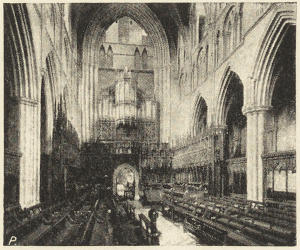
CHOIR, LOOKING WEST.
VIII. Tudor.—Early in the sixteenth century the canons unhappily determined to give their unique church more of the look of a cathedral by adding aisles to the nave. It is pleasant to add that they were unsuccessful. The nave is exceedingly low in proportion to its exceptional span, and being, moreover, unprovided with a triforium, does not look[197] in the least like a cathedral, but like a very inferior parish church. Externally, the buttresses are of fine composition, and if the pinnacles were completed, the nave would be very handsome externally.
In 1593 the central spire—of timber and lead—was struck by lightning, and in 1660 it was removed. It was 120 feet high. In 1664, for fear of a similar catastrophe, the western spires also were removed. The result is that, seen from a distance, minus spires and minus pinnacles, Ripon Minster is stunted and squat.
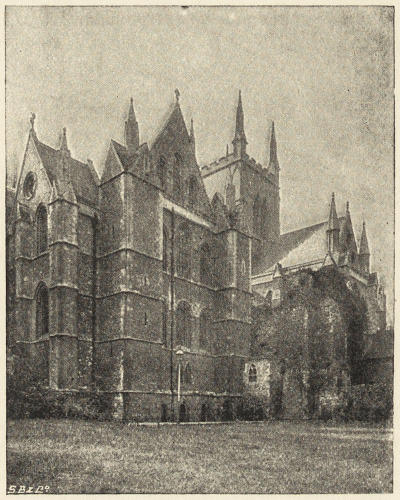
FROM NORTH-EAST.
Rochester and London, next to Canterbury, are the oldest of all the English bishoprics, unless, indeed, we are prepared to accept a pre-Augustine bishopric of Hereford. St. Augustine, soon after his landing in 597, came to preach at Rochester. His reception was not encouraging; the rude people hung fish-tails to his coat. Wherefore in anger the saint prayed “that the Lord would smite them in posteriora to their everlasting ignominy. So that not only on their own but on their successors’ persons similar tails grew ever after.” The worst of it was that the story spread, and not only Rochester people but all English folk were believed on the[199] Continent to be caudati (tailed). So that even in the sixteenth century “an Englishman now cannot travel in another land by way of merchandise or any other honest occupying, but it is most contumeliously thrown in his teeth that all Englishmen have tails.”
Among St. Augustine’s Italian missioners were St. Justus and St. Paulinus. St. Justus became first bishop of Rochester in 604. St. Paulinus, after eight years of mission work in Northumbria, became bishop of Rochester in 633. The first English bishop was St. Ythamar (644-655). These three were the chief local saints of Rochester in early days.
St. Augustine and his missioners had come from the monastery of St. Andrew, Rome. To St. Andrew, therefore, they dedicated the first Saxon cathedral. In 1542 the cathedral was re-dedicated to Christ and the Blessed Virgin Mary of Rochester. Till 1077 the cathedral was served by secular canons; Gundulph replaced them by Benedictine monks.
I. In 1888 the foundations of an early church were found. It had an apse, but neither aisles nor transepts; walls only 2 feet 4 inches thick; 42 feet long, 28 feet broad. From the resemblance of its plan to that of St. Pancras, Canterbury, and the presence of Roman brick in the walls, it seems as likely to be a Romano-British as an Anglo Saxon church.
II. Between 1080 and 1089 Bishop Gundulph completed a Norman cathedral, except the western part of the nave. In plan it was entirely different from any Norman cathedral of the day: one can hardly help believing that it must have been designed by an Englishman. The plan of it is given in the Builder. It was a long oblong aisled cathedral, with nave and aisles running on without a break from the west end of the nave to the east end of the choir. But in the choir the side-aisles were cut off from the central aisle by a solid wall, as in the contemporary choir of St. Albans and in the Premonstratensian abbey of St. Radigund, near Dover. There was probably no crossing, and therefore no central tower.[200] There were no transepts proper; but, as in such Anglo-Saxon churches as Worth, low porch-like transepts projected north and south, with a breadth of only 14 feet. The east end, as in most Anglo-Saxon churches, was square; and there projected from it eastward a small square chapel. Beneath was a crypt, the western part of which remains. There were two towers, both abnormal in position. The southern tower was set in the angle of the choir and the south transept, and may have been the belfry. The other tower, fragments of which still remain, was set in a similar position, but entirely detached. Being detached, and having walls six feet thick, it was no doubt a military keep. Gundulph was fond of building keeps; those of the Tower of London and Malling still exist. Rochester was exposed to and had suffered from attacks of the Danes, sailing up the Medway, in 840, 884, and 999. There was a striking memento of them on the great west doors of the cathedral, which Pepys, as late as 1661, found “covered with the skins of Danes.” We may conjecture that it was as a refuge against similar attacks that Gundulph built the northern keep.
All this work of Gundulph’s is now gone except portions of the crypt, the keep, and the nave. The original monastery was built in the normal position, south of the nave. To enclose the cloister, therefore, on the north, the south side of the nave was proceeded with next. The south aisle-wall is very thin—as was customary in Anglo-Saxon architecture—and we may conjecture that English influence stopped at this point; for the piers and arches of the nave are quite Norman in character. Of Gundulph’s nave there remain on the south side five arches, together with the lower parts of the walls of both aisles. It is very doubtful whether he built any part of the triforium or clerestory. At present his work can only be seen in its original condition from the side of the aisles. The pier arches had originally two square orders, which remain unaltered on the side of the aisle (cf. Winchester transept). Gundulph’s masonry was in rough tufa.
III. Late Norman.—The works on the church were now probably suspended for a considerable time, while the monks, as at Gloucester, replaced the temporary buildings of the monastery by permanent ones. These temporary wooden buildings seem to have been situated in the usual position—viz., south of the nave. It was probably not to interfere with these that the permanent monastic buildings were placed in an abnormal position, south of the choir. Much of this work was done by Bishop Ernulph (1115-1124), who had been a great builder at Canterbury, while prior, and at Peterborough, as abbot. Parts of the cloister, refectory, and chapter-house remain.
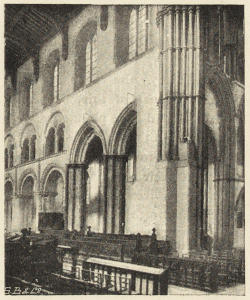
NAVE, NORTH SIDE.
When at length the builders returned to the nave of the cathedral (c. 1120), fashions had changed. Gundulph’s eleventh-century design and his rough tufa masonry seemed archaic and barbaric. His tufa was therefore cased with good Caen stone, as was done later in the century at Chichester; his piers and capitals were remodelled, and on the side of the nave the outer square order of the pier-arch was covered with zigzag ornament. The aisles, as at Hereford, where a precisely similar transformation of eleventh-into twelfth-century work was taking place at the same time, were left unaltered. Gundulph had placed pilasters along the inner face of the aisle-walls, evidently intending that the aisles[202] should be vaulted; but his successors apparently thought the walls too thin, as at Carlisle, to support a vault; so, instead of vaulting the aisles and obtaining thus a continuous passage the whole length of the church, they constructed a passage in the thickness of the wall of the triforium. Thus Rochester, like Vignory, has the distinction of possessing a sham triforium. Waltham Abbey also has a triforium arcade, but no triforium floor; but that is because the vaults which originally covered the aisles had subsequently to be taken down.
Still later—about the middle of the twelfth century—is the west front, with its magnificent doorway, and the diaper of the triforium.
IV. In 1179 the cathedral was greatly damaged by fire. Either because of this, or because the eastern half of the cathedral had been planned so inconveniently, or because the plan was not the fashionable one of Norman times, the monks set to work to rebuild the whole cathedral. As usual, they arranged their building operations so as to avoid interfering with the services in the choir as long as possible. First, they rebuilt the north aisle of the choir, but not so high as it is at present. The aisle remained narrow, because Gundulph’s tower was in the way. But the south aisle of the choir they doubled in width. Next, they set to work at the east end, planning it, as at Hereford, as an eastern transept with an eastern aisle, and projecting eastward an oblong sanctuary (cf. Southwell). The new transept was lofty and broad; and it is quite possible that it was built over the top of Gundulph’s east end without disturbing daily services within it. Then, when all was finished, Gundulph’s east end was pulled down. Unlike the Worcester monks they preserved the level of the eleventh-century choir, and consequently had to continue Gundulph’s crypt eastward. In the new presbytery is seen the same curious mixture of quadripartite and sexpartite vaulting as in St. Hugh’s eastern transept at Lincoln. All this work was finished in 1227.
Next they pulled down Gundulph’s narrow north transept and rebuilt it as broad as the central aisle of the nave. The new transept has a sexpartite vault with a longitudinal ridge rib, as in the great transept of Lincoln (c. 1245).
Then came the rebuilding of the south transept (c. 1280). They resolved also to have a central tower and to rebuild the nave. Of the nave they rebuilt the two easternmost bays, and then completed the piers and arches of the crossing; but not yet the tower.
Up to this point the works had gone on continuously for a century. What enabled the monks to undertake such a great work as the rebuilding of the whole cathedral, and why, after doing so much, they suddenly stopped, has now to be explained. The secret of the flush of money at Rochester was that in 1201 the monks acquired a new saint, St. William. “He was by birth a Scot, of Perth; by trade, a baker; in charity so abundant that he gave to the poor the tenth loaf of his workmanship; in zeal so fervent that in vow he promised, and in deed attempted, to visit the places where Christ was conversant on earth; in which journey, he made Rochester his way, where, after that he had rested two or three days, he departed toward Canterbury. But ere he had gone far from the city, his servant—a foundling who had been brought up by him out of charity—led him of purpose out of the highway, and spoiled him both of his money and his life. The servant escaped, but his master (because he died in so holy a purpose of mind) was by the monks conveyed to St. Andrew’s and laid in the choir. And soon he wrought miracles plentifully.” It was, then, from offerings at the shrine of St. Thomas of Perth, left by countless pilgrims on their way to the shrine of a yet greater Thomas at Canterbury, that the expenses of the new choir were paid. And it was simply because in the course of eighty years the repute of the murdered baker had paled and waned before the ever-growing fame of the murdered archbishop, that the monks had to renounce, once for all, their ambitious project of rebuilding[204] the whole of the nave. It seems, however, that they were for a considerable time unwilling to give up hope; for one bay of the Norman triforium was pulled down, leaving a gap, which was not filled up till the fourteenth century; when, oddly enough, it was rebuilt in the same Norman style as before, but in greensand—a rare mediæval example of “architectural forgery” (cf. Durham Galilee).
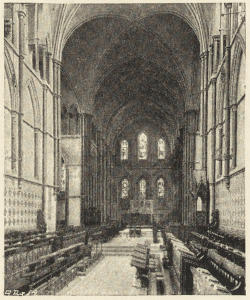
CHOIR.
V. But though the rebuilding of the nave was definitely abandoned, a good deal of work was done in the Curvilinear period (1315-1360). The central tower was at length erected; it was removed in 1749. A solid stone screen was built between the piers, as at Ripon; the south aisle of the choir was brought into its present form by the absorption of Gundulph’s southern tower; a grand doorway to the chapter-house was built, and monuments were erected to Bishop Hamo de Hythe (d. 1352), and Bishop John de Sheppey (d. 1360).
The monks now also provided a Lady chapel. This they got in a very inexpensive way—a proof that their resources had greatly fallen off—by appropriating for the purpose the southern transept, the two eastern bays of which they threw into one to form a recess for the altar of the Virgin.
VI. After this little was done at Rochester, except to build[205] out a chapel of three bays westward from the south transept, giving a sort of nave to the Lady chapel.
VII. The windows, however, were, as usual, in the builders’ hands throughout the whole of the fourteenth century—especially those of the dark Norman nave.
In the Curvilinear period flowing tracery was inserted in the lower range of lights in the sanctuary, and improvements were made in the clerestory of the south transept, now that it was to be used as a Lady chapel.
In the Perpendicular period the narrow north aisle of the choir, darkened by Gundulph’s tower on one side and on the other by the solid wall of the choir, was raised, lighted, and vaulted. Then the nave was taken in hand; Perpendicular windows were inserted in the aisles, and a great window in the west end; the whole of the Norman clerestory was taken off, a new clerestory and a new wooden roof were put up. Thus the nave got plenty of light.
VIII. In 1664 the south aisle of the nave was recased; and in 1670 the third, fourth and fifth bays, counting from the west, in the north aisle of the choir, were rebuilt.
IX. In 1830 Cottingham put up the present central tower. In 1871 the cathedral was restored by Scott.
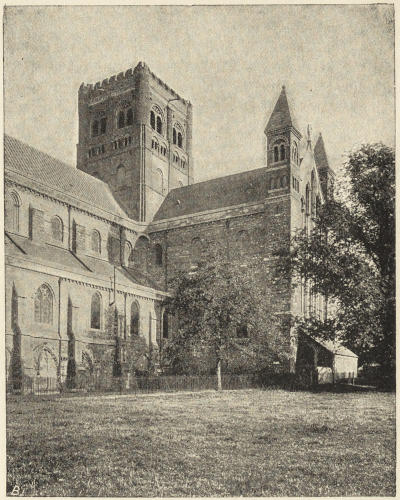
FROM SOUTH-WEST.
Of all our cathedrals none is so composite and heterogeneous as the ancient church of the Benedictine abbey of St. Alban. It is mainly built—even the fourteenth-century Lady chapel—of Roman tiles. Saxon balusters appear in the triforium of the transepts. In the nave and transepts and tower is Early Norman work, unequalled in extent and grandeur; in the south transept are built up the fragments[207] of a Late Norman doorway, to which period, or to the first days of the Transitional period (1145-1190), belongs the interlacing arcade now placed above it. In the west front and the western bays of the nave is Lancet work of two periods (1190-1245). In the sanctuary is seen Early Geometrical work (1245-1280); the ante-chapel, commenced in the Early, was finished in the Late Geometrical period (1280-1315). The Lady chapel (1291-1326) is a most interesting example of the transition from the Late Geometrical to the Curvilinear style. The latter is represented by the five eastern bays on the south side of the nave, by the remains of the cloisters, by the shrines of St. Alban and St. Amphibalus, and by the Holy Rood screen (1315-1360). Perpendicular work is represented by the alterations to the cloisters, by the abbey gatehouse, by the triforium windows on the north side of the nave and choir, inserted when the aisle roofs were lowered, by the watching-loft, by the chantries of the Duke of Gloucester and Abbot Wheathampstead, and by the reredos and painted ceiling. Tudor work appears in the chapel of the Transfiguration, and in the admirable chantry of Abbot Ramryge; while the “Gothic revival” is stamped on every feature of Lord Grimthorpe’s façades to the west, north and south. There is not a single hiatus in the series. St. Alban’s is a veritable architectural handbook, written in brick and stone. The student should remember, however, that at St. Alban’s there is a good deal of what is called assimilation. The Lancet bays and the Curvilinear bays in the nave are not typical and characteristic of their respective periods. The architects of these bays had not a free hand. They were not able to compose the design simply to suit the fashion of the day. Their bays were to be Lancet and Curvilinear only so far as might be without ruining the general design and proportions of the nave as a whole. With these reservations, the tyro in architecture is recommended to select St. Alban’s as his “Introduction to Mediæval Architecture.” If he comes from London, he should choose the longer route, by[208] the London & North-Western Railway: he will have less distance to walk on arriving, and will see the cathedral from the most picturesque point of view. If time permits, he should proceed direct from the railway station to Verulamium, and see the Roman walls and fosse, and the interesting church of St. Michael’s, with the famous monument of Lord Bacon, before visiting the cathedral.
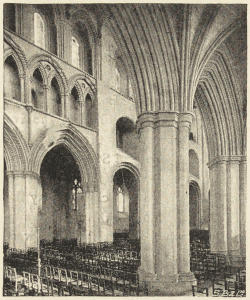
NAVE, NORTH SIDE.
In Roman times the town was on the other side of the little river, the Ver, a tributary of the Colne, and hence was called Verulamium. In the revolt of Boadicea it was burnt, but was soon rebuilt. In the year 303, “there was gret persecution of Christen pepell by the tyrant Diocletian”; and Alban, a citizen of Verulamium, who had given shelter to a Welsh priest, Amphibalus, was scourged, and then dragged along the ancient British causeway, which still exists, across the Ver, and up the lane to the top of the hill afterwards called Holmhurst, and there put to death. Amphibalus suffered the same fate. On the west wall of the north transept of the cathedral, just under a round-headed window, is a small black cross cut in stone. “This marks the traditional site of the martyrdom of St. Alban, when there was neither town nor abbey in this place, but only a flowery slope planted with trees.” In the fifth century the English conquered the district. They abandoned Verulamium, and[209] built the present town on the hill of Holmhurst, calling it Watlingceaster, as Watling Street ran through it. In the year 793, Offa, king of Mercia, treacherously murdered Ethelbert, king of East Anglia (see Hereford). It was revealed to him in a vision that, by way of penance, he should seek out the body of St. Alban, and there erect a monastery. King, archbishop, bishops, priests, and a great multitude of common people, searched the hill of Holmhurst, and found the relics of the martyr. A church was built, and richly endowed, and was entrusted to Benedictine monks. It remained a Benedictine abbey-church till the Dissolution, in 1539. Then it became a parish church, and in 1875 a cathedral.

TRIFORIUM OF TRANSEPT.
The relics of St. Alban had an eventful history. First they were carried off by pirates to Denmark, but were afterwards restored. Then, in expectation of another Danish raid, they were sent for safety to Ely. When the Danes had gone, the monks of Ely, being desirous to keep the precious bones in their possession, palmed on the monks of St. Alban’s some suppositious relics. Whereupon the monks of St. Alban’s asserted that neither had they sent to Ely the genuine relics, but only sham ones, to draw attention away from the fact that they had hidden the authentic bones of the martyr in a hole in the wall of their own church! “Credat Judæus Apelles.”
Towards the end of the eleventh century Nicholas Breakspear was born at Abbots Langley, in Hertfordshire. He applied to the abbey of St. Alban to be admitted a monk, but was scornfully rejected, and rebuked for his impudence, being, as he was, son of one of the menials of the convent. This same man became Pope in 1154—the only Englishman who ever became Pope. And when he became Pope, under the title of Adrian IV., he forgot not the monks of St. Alban’s, but forgave them, and made their monastery free of episcopal jurisdiction for ever, and subject only to the see of Rome. And to the abbot he gave precedence over all other English abbots; which precedency, after much dispute with Westminster, St. Alban’s retained till the Dissolution.
In 1455 was fought the first battle of St. Albans, when Henry VI. was wounded in the neck by an arrow, and made prisoner by the Yorkists under the Earl of Warwick. The forces met in Holywell Street (where we entered the town), between the Key and the Chequer. In the second battle, 1461, the Earl of Warwick was defeated by Queen Margaret.
St. Alban’s was an exceedingly wealthy abbey; it had estates in almost every county in England, and at the present value of money its income would amount to at least a million. Its conventual buildings must have been immense. One of the guest-halls, in addition to parlours and bedrooms, had stables for three hundred horses. Of all these vast structures nothing remains but one of the gatehouses, built in 1380. In it were detained the French prisoners in the Napoleonic wars; afterwards it became a common gaol, now it houses the Grammar School.
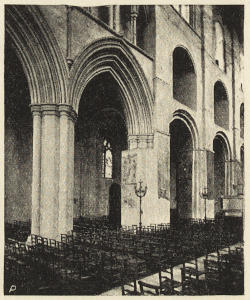
NAVE, NORTH SIDE.
Internally, the church is divided from west to east, in ancient monastic fashion, into (1) nave, (2) choir, (3) sanctuary, (4) Saints’ chapel, (5) retro-choir or ante-chapel, (6) Lady chapel. (1) The ritual nave occupies the ten western bays only of the architectural nave, and terminates at the Holy Rood screen. (2) The ritual choir is not placed in the eastern limb; but, following a far more ancient precedent, in the[211] three eastern bays of the architectural nave, and in the crossing (that part of the transept which is beneath the central tower). This was the place of the choir in the primitive basilicas, and in the early monastic churches. The “Coro” of the Spanish cathedrals is still placed in the nave. The same arrangement survives in this country in Westminster Abbey and Norwich, and has lately been restored at Peterborough. (3) The sanctuary extends from the tower to the great reredos, and provided a free and unencumbered space in front of the high altar, which “dwelt apart.” (4) The Saint’s chapel was occupied, like the feretory at Winchester, by magnificent shrines which towered behind and above the high altar, visible far down the nave, at least before the great reredos was erected. (5) The retro-choir or ante-chapel provided a processional path, or ambulatory, or eastern choir aisle at the back of the shrines. Romsey and Hereford possess the earliest of these processional paths, Winchester the largest. (6) The Lady chapel occupies its normal position, to the extreme east. But where there was no room for farther eastward extension of the cathedral, the Lady chapel may be found on the north or south side of the choir, as at Bristol and Oxford. Here, as at Salisbury and Winchester, the high roofs do not extend over retro-choir and Lady chapel, which are only one story high; at York[212] and Lincoln and Ely, the church retains its full height uninterruptedly to the extreme east end; the ritualistic divisions of the church being marked by screens only.
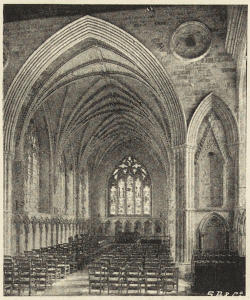
LADY-CHAPEL LOOKING EAST.
In Norman times the church did not extend so far eastward. The sanctuary ended in three semicircular apses, of which those of the aisles were semicircular inside but square outside, as at Romsey. And, in lieu of eastern aisles, the transepts had each a pair of little semicircular chapels, the arches leading into which may still be seen in their eastern walls.
“In 1077, Paul, a monk of St. Stephen’s, Caen (the Abbaye-aux-hommes), was elected Abbot, through the influence of Archbishop Lanfranc, whose kinsman he was.” In these words we have the origin of St. Alban’s Cathedral; and not of St. Alban’s only, but of all the mediæval architecture of our land, whether Romanesque or Gothic. Before the Norman conquest we had a native style of our own; a kind of primitive Romanesque, of which remains survive at Jarrow, Wing, Worth, Deerhurst, and elsewhere, as well as in the crypts of Ripon, Hexham, and Repton. But the invasion of the Normans changed all this. The primitive indigenous Romanesque of England was thrown aside in favour of the far more advanced Romanesque of Normandy. From the great monastery of St. Stephen, Caen, came Lanfranc, the first, and Anselm, the second Norman Archbishop of Canterbury.[213] When Lanfranc set to work to rebuild Canterbury Cathedral, he made it in length and breadth and height an exact copy of the church of St. Stephen, Caen. What Lanfranc did at Canterbury, the Walkelins did at Winchester and Ely, and Abbot Paul at St. Alban’s. They set to work to rebuild their churches on the vast scale, and with all the improvements, of the Romanesque architecture of Caen and Normandy. St. Stephen’s, Caen, is therefore the link between the architecture of Normandy and that of England; it is the mother-church of all the cathedrals of our land. More than this: Lanfranc and Anselm were by birth, not Normans, but Italians; Lanfranc was born at Pavia, Anselm at Aosta. Paul was a kinsman of Lanfranc. All three, then, came from the great plain of Lombardy; and it was through such scholars and theologians as these that the architecture of Lombardy found its way into Normandy. For the architecture of Normandy is in character mainly Lombardic. Therefore, just as Canterbury and Winchester and St. Alban’s are the offspring of St. Stephen’s, Caen; so St. Stephen’s itself is the child of S. Ambrogio and S. Eustorgio, Milan; S. Stephen, Verona; S. Sophia, Padua; and other ninth- and tenth-century churches of Lombardy and the neighbourhood.
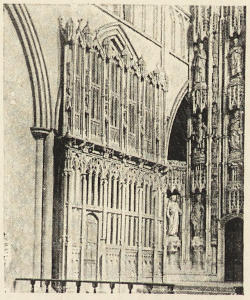
RAMRYGE’S CHANTRY.
But though in origin Winchester, Ely, and St. Alban’s hail from Caen, they all far surpass their model in vastness of scale. Winchester and Ely even committed the magnificent extravagance of having a western as well as an eastern aisle to the transepts; and though St. Alban’s, like Canterbury, had an aisleless transept, yet it surpassed them all in the stupendous length of its nave. Still more[214] does it surpass the Caen church and Lanfranc’s Canterbury. Caen and Canterbury had nine bays in the nave, two in the choir, and two in each transept; St. Alban’s had thirteen in the nave, five in the choir, and three in each transept. Caen and Canterbury had naves 193 feet long, transepts 145 feet long, and a total length of 290 feet; St. Alban’s a nave 292 feet long (as long as the whole churches at Caen and Canterbury), transepts 177 feet long, and a total length of about 430 feet. In the fourteenth century, owing to the eastward extensions, St. Alban’s became longer still—520 feet inside, 550 feet outside. Winchester is even longer still: 2 yards longer than St. Alban’s; 3 yards longer than Ely; 4 yards longer than Canterbury.
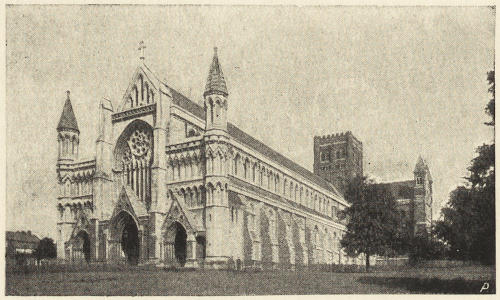
WEST FRONT.
I. Early Norman.—Of the work of Paul of Caen (1077-1093), we have the central tower and transept practically complete, and large portions of the nave and sanctuary. The design is strictly conditioned by the material, Roman brick; in consequence of the employment of which the architect was driven to rely for his effects, not on ornament or detail, but on what is nobler far, vastness of scale. It is worth while to compare the brick transept of St. Alban’s with the contemporary[215] transept of Winchester, where the design is conditioned by the use of stone.
II. Late Norman.—A fine arcade and doorway have been removed from the slype to the south wall of the south transept by Lord Grimthorpe. He is good enough to tell us that the new work which he has interpolated is so artful that no archæologist in future shall be able to ascertain which portions are old and which are new.
III. Lancet.—The vast and imposing church completed in the twelfth century found little favour in Gothic eyes. It was apparently regarded not only as ugly, but as incapable of being improved into something better. The only thing was to pull it down. In the end the monks did pull down and rebuild a large part of it, occupying at least a hundred years in the work. Fortunately for us, they wearied of their self-imposed task.
They began at the west end of the nave, so as not to interfere with the monastic services. First, John de Celia (1195-1214) proceeded to rebuild the west front on a lovely design, and with a wealth of costly marble and carving. Of this work there remain portions in the north-west and central porches of the façade.
His successor, William de Trumpington, was more economical, and produced more work. He completed the porches, and built in the western end of the nave four bays on the north and five bays on the south side. It can still be seen how he economised, not only on John de Celia’s design, in the arch that was to have led into a south-western tower, but on the design of his own bases, piers and vaulting-shafts; he even renounced the idea of vaulting his work at all—a very ungothic procedure.
IV. Geometrical.—His successors went further still; they abandoned all hope of rebuilding the rest of the nave, and turned their attention to the eastern limb. Retaining their stalls, as at present, in the crossing and the three western bays of the nave, they were able to go on with[216] works to the east without any interruption to the services. The works dragged on very slowly. For some reason or other this wealthy abbey—with estates in almost every county of England—never had money to spend on its church.
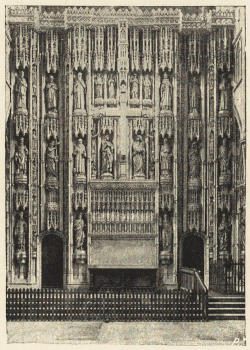
THE REREDOS.
First, the Norman sanctuary and apses were demolished, except that a length of Norman wall was retained on either side of the sanctuary. If this had been removed the tower might have collapsed. The chief feature of the new sanctuary is the clerestory windows, with tracery of early type, c. 1250.
Soon after, the lower parts of the Saint’s chapel and the ante-chapel were built; these were not completely finished till c. 1315. There, too, “vaulting ambition had o’erleapt itself”: the monks made preparations for vaults both within and without the ante-chapel, but in the end put up an unworthy flat ceiling.
About 1295 they commenced a new Lady chapel. This was not finished till about 1326. Thus it was built in the last years of the Geometrical and the early years of the Curvilinear style, and, like Selby choir, illustrates charmingly the transition from the one to the other.
V. Curvilinear.—The monks had now done all they meant to do. The eastern limb was rebuilt. They meant to do no more in the nave. But their hands were forced. Five[217] Norman bays collapsed on the south side of the nave in 1323, and the monks had perforce to rebuild them. The design is closely assimilated to that of the Lancet bays to the west; the clerestory actually having lancet windows without tracery. To this period belong the shrines of St. Alban and St. Amphibalus, the Rood-screen, the doorway and arcade of the cloister.
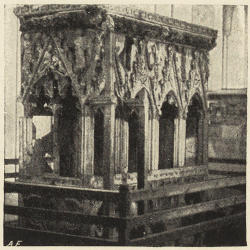
THE SHRINE.
VI. Perpendicular.—The great gateway was built c. 1380. The nave and choir were better lighted on the north side by the insertion of windows in the triforium. The watching-loft was constructed c. 1420; the choir was ceiled, and the great reredos was erected c. 1480. To the same period belong the brass of Abbot de la Mare, c. 1390; and the grand chantries of Abbot Wheathampstead and Duke Humphrey of Gloucester, c. 1440.
VII. Tudor.—The grandest chantry of all is that of Abbot Ramryge, c. 1520.
VIII. In recent times vast sums have been spent in underpinning and securing the walls and tower: and we have had the amazing west front and transept-ends designed by Lord Grimthorpe.
The “Annals of an Abbey,” in Froude’s “Short Studies,” should be read.
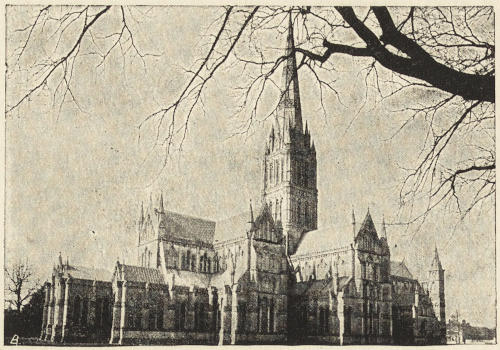
Two English cathedrals surpass all others in external effect: Lincoln and Salisbury; each of them being at its best as seen from the north-east. But Lincoln lacks “the quiet tranquillity of the close of Salisbury, the half-hidden houses, covered with vines and creepers, that nestle among the trees, the sense of being shut off from the work-a-day world. If Durham seems the petrified interpretation of the Church militant, Salisbury is the very type and picture of the Church of the Prince of Peace. Unworldliness and peace brood over church and close.”
The ancient Norman cathedral stood within the fortifications of Old Sarum. The site was cramped, and extension was impossible; there was far too much wind and far too little water; moreover the soldiers who garrisoned the castle were most objectionable neighbours. So, by permission of the Pope, Bishop Richard Poore in 1220 commenced a new cathedral on the present site.
It was a virgin site; and from this fact resulted a cathedral different from any other that we possess, and as a study in design more important than any other we possess. In other cathedrals we study the mediæval architect designing under difficulties; what we see in such a composite cathedral as Hereford or Chichester or Rochester is not one design, but a dozen designs trying to blend into one design; sometimes, as at Canterbury and Rochester, rather ineffectually, sometimes, as at Hereford, with remarkable success. At Salisbury it is not so: the design is one design, all sprang from a single brain, except the west front and possibly the upper part of tower and spire. We have no such homogeneous design in our mediæval cathedrals. The French were less conservative, perhaps less penurious; their Gothic architects were iconoclasts; no French architect could have allowed such frightful solecisms to remain as disfigure our cathedrals to the purist eye, and endear them to the artist.
Bishop Poore’s architect, Elias de Dereham, one of the canons of the cathedral, who a little later designed the eastern transept of Durham, had—what no other of our Gothic architects had—a free hand. Salisbury, then, tells us what no other cathedral does—what an English architect thought a cathedral ought to be like, when not hampered by having to preserve or assimilate pre-existing work or to build on pre-existing foundations. Canterbury nave is not the best the architect could do: it is the best he could do subject to the restriction that his nave must be neither longer nor broader than Lanfranc’s ancient nave. Elias de Dereham had no such restrictions; the cathedral was to be built in the green pastures, he could take as much space as he liked.
Begun in 1220, the whole cathedral, except west front, tower and spire, was complete in 1266, having cost, it is said, what is equivalent to half a million of our money. It has, therefore, the distinction among our cathedrals of having a design which is practically uniform. It is said, indeed, and with perfect truth, that the homogeneity and uniformity[220] of the design of Salisbury makes it less interesting than the usual composite cathedral of England, with its design changing, as in Selby nave, almost in every bay. When we have seen one bay of Salisbury nave, we have seen the other nine, and we know that we shall find practically the same design in the choir. Yet we can afford very well, in England, to have one great design, the product not of a dozen minds, but of one mind; a work completed in less than half a century, and not spread out, like Canterbury, over four centuries, or like Hereford, over seven.
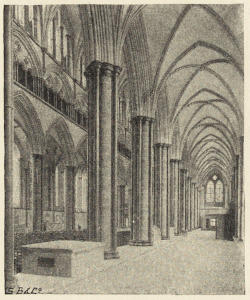
NAVE.
Again, building on a virgin site, Elias de Dereham did what all great builders have always wished to do—he made his building symmetrical. It is the fashion to contrast the symmetry of Greek with the picturesqueness of Gothic architecture. The comparison may be carried too far. The Erechtheium is as unsymmetrical and picturesque as any Gothic building. The great cathedrals of northern France, and Salisbury and Exeter, are quite classical in their symmetry. But they are not pedantic in their symmetry. Because nave balances choir, the north transept the south transept, and the north-east transept the south-east transept, the builder was not so foolish as to construct on the south a big porch to balance that on the north side of the nave. Instead of that, he built to the south an octagonal chapter-house, and this he placed unsymmetrically—i.e., picturesquely—because, so[221] placed, it was more to the convenience of those who would have to use it. In other words, he did not purposefully aim at the picturesque and the irregular. Gothic cathedrals are picturesque, either of accident, as at Canterbury, owing to the casual collocation of work of different design in the course of several centuries, or because the different parts of the cathedral, being intended for different functions, have been designed different in plan, in dimensions, and in details. The latter is the case with Salisbury.
Two chief types of cathedral plan were at the architect’s disposal: what we may call the York type, and the Wells type. In the latter, the cathedral continues at its fullest height from the western doors to the far east of the sanctuary, then the retro-choir or ante-chapel (sometimes divided into Saint’s chapel and processional path or ambulatory) is roofed at a far lower height, and east of them is a Lady chapel, similarly on a low level. And, of course, as the upper wall of the east end of the sanctuary requires to be supported, arches have to be built beneath it opening from the sanctuary into the retro-choir. The plan is a beautiful one—it is our English equivalent for the French ‘chevet.’ Externally, the different portions of the eastern limb tell distinctly the purposes for which they are built: standing to the east of Winchester, or Wells, or Hereford, you say at once, “This building is the Lady chapel; there is the processional path and probably the shrine of the local saint, there is the east end of the sanctuary, and the light from that east window at the early morning services streams down on the high altar below.” Internally, too, the effect is delightful; the upper story of the cathedral is of course really greatly curtailed in length, but the cathedral is not shortened to the eye: the mysterious vistas through the east arches of the cathedral more than restore the height lost above; the glimpses of Lady chapel behind ambulatory, and ambulatory behind Saints’ chapel, as seen from far west in the nave, make the termination of the Lady chapel, invisible from many points of view, seem infinitely distant. Of these[222] mysterious distances, shadowy recesses and changing vistas, there is nothing in Lincoln and York; the whole eastern limb is seen at a single glance, and, unfortunately, is foreshortened by the eye. Wells and Salisbury internally look longer than they are, Lincoln and York much shorter. In mediæval days, however, the ritualistic divisions of the church were marked off by a series of screens, each adding apparent length to the interior. So many of these screens, however, have been swept away by Wyatt, Scott and the like, or replaced by paltry open-work, as at Lichfield and Durham, that many of the cathedrals of this type are now mere open barns; all sense of mystery, all sense of magnitude gone. Externally, York and Lincoln and Beverley have the best of it. The sweep of a sky-line, five hundred feet in length, at a height so vast, is sublimely impressive. The cost of an exterior kept at an unbroken height for such a distance is very great, but it is worth the cost.
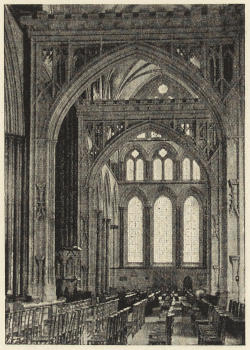
TRANSEPT
Cathedrals of the latter type, such as Ely, York, and Southwell, are quite presentable with a central tower of moderate height, provided that it is reinforced by more[223] important towers to the west. An exterior of the former type, that of Wells and Salisbury, demands a very important central tower. Accordingly, every cathedral of this type has a big central tower—viz., St. Alban’s, Hereford, Wells; or a spire as well as a tower—viz., Chichester. (Winchester alone is an exception, an exception which proves how very much a central tower is needed in such elevations.) In such exteriors, looked at from the east, hills rise beyond hills, alps beyond alps, and the eye instinctively looks up to see the highest ranges aspire into the pyramidal outline of a Matterhorn. And this is what is given us at Salisbury.
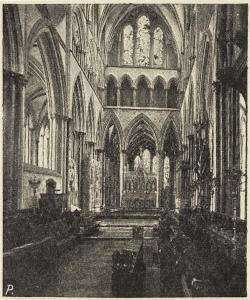
CHOIR.
It is not, however, what Elias de Dereham, the original architect, meant. No spire, or even upper tower, says Sir Christopher Wren, was originally contemplated. The unique slenderness of the piers of the crossing is certain evidence of that. The diameter of the piers on which the central tower of Canterbury rests is twelve feet; those at York and Winchester have a diameter of ten feet; those at Worcester nine feet; those of Peterborough tower (which collapsed) and of Salisbury, seven feet only. It is almost terrible to stand between these four thin piers of Salisbury and think how many hundred tons of stone in tower and spire above they have been made to bear. They were never meant to bear any such weight, especially planted as they are, like the whole cathedral, on the insecure foundation of a spongy bog. Indeed, not merely[224] the tower and spire, but the whole cathedral, ought never to have been built where they are. Recklessness is by no means a strong enough word to use of the mediæval builders’ wanton carelessness about foundations. Peterborough cathedral was built practically without foundations on waterlogged peat; beneath the central tower of Carlisle cathedral were two running springs; Wells is reared on the boggy shores of a ring of pools. At Salisbury continuous bases had to be built from pier to pier.
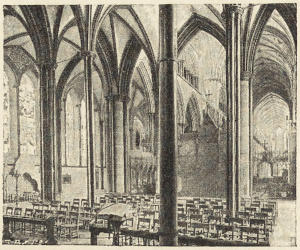
RETRO-CHOIR, LOOKING WEST.
Elias de Dereham’s design, no doubt, was to give us an exterior something like that of Beverley Minster or Westminster Abbey. The whole elevation of the cathedral, however, clamoured for a tall tower and spire. The original design was abandoned, and the foolhardy enterprise was taken in hand (c. 1330) of adding to the existing tower, which only just rose above the roofs, two more stages, and on these a spire, and that not of wood, but of stone. To abut this perilous steeple as much as possible, great flying-buttresses were added, both externally and running through the clerestory and triforium of the interior of the church. Moreover, to lessen the weight, the tower-walls were built in thin shells, while the spire is but nine inches thick. That the builders left their timber scaffolding in the spire, where it still is, to give its sides a little additional support, shows that they were alive themselves to the fragility and insecurity of their work. Later on, in the fifteenth century, stone girders were put across the piers of the central and eastern transepts,[225] as at Canterbury and Wells, by way of struts, to keep the piers from bulging inwardly, though, as a matter of fact, what was wanted was rather ties to keep them from bulging outwardly.
Externally, however, the madness of this engineering feat does not trouble one. The addition of the tower and spire gives to the whole composition that pyramidal outline which always presents such a satisfactory appearance of stability to the eye—and in architectural design it is the eye that has to be reckoned with. In Wren’s masterpiece, St. Paul’s, one has the same central pyramidal outline of all the masses, but in a still higher degree.
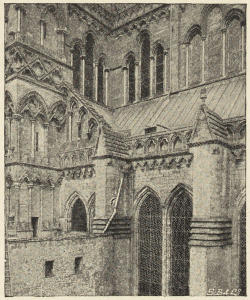
NAVE AND WEST FRONT.
In both cases, in St. Paul’s and in Salisbury, unity is secured. Salisbury spire is tall enough, St. Paul’s dome is tall and broad enough, to impose unity on all the diverging masses of the building. The low towers of Worcester and Hereford have no such supreme dominance.
Next to the abiding presence of the spire, unity is secured by scoring strong, horizontal lines round the building, welding its masses into one composition. Most cathedrals are contented, like Wells, with one strong horizontal line—a broad parapet. But at Salisbury there is not only a horizontal parapet, but a horizontal corbel-table as well; and there are no less than three horizontal strings—one running round the[226] base of the walls, a second running along beneath the windows, and a third running round the buttresses; moreover, each of these horizontal lines is scored far more heavily than anywhere else. Especially remarkable is it to find the upper flow of the buttresses stopped by a heavy string. Usually, in Gothic, if a horizontal meets a vertical line, the former gives way; here, as in Greek architecture, the vertical gives way to the horizontal line. This architect saw, what few others of his day saw, that you may make too much of the “aspiring principle” of Gothic; that if you suppress the horizontal lines, you weaken the unity of the building, by failing to tie all its parts together.
As we have seen, the appearance of stability was enhanced by the pyramidal outline which the whole building ultimately assumed. But the eye instinctively looks downwards also to see that the pyramidal outline is continued there, it instinctively demands an emphatic spreading base. It likes to see a rock-like foundation. At Salisbury all below is but greensward. All the more carefully, therefore, has the builder spread out and broadened and emphasised his base-courses, till art gives the appearance of stability which nature has denied.
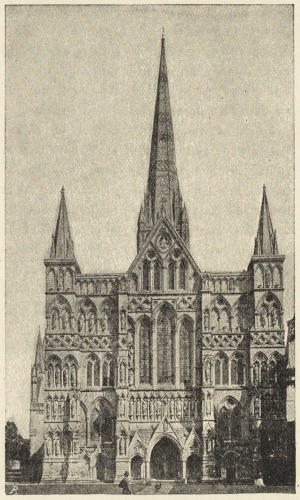
WEST FRONT
Stable, therefore, below and above, the exterior of Salisbury has much of that “monumental appearance”—of what Dr. Johnson called “stability and indeterminate duration”—which is the noble attribute of a great architecture, which one desiderates in a building “built not for time, but for eternity, whose walls will long be washed by the passing waves of humanity.” Such a building gravity and simplicity befit; its design should be solid and monumental, sober and restrained; it is not a field for the frippery of ornament, its best decoration is the stain of time. Built for eternity, it should suggest infinity—an infinite length which the eye cannot measure, an infinite height which the eye cannot estimate, a vastness of area that overpowers the imagination. Bigness counts for much in the painter’s work and the[227] sculptor’s; it counts for yet more in architecture. A building in the grand style has to be big, and if it is a Gothic building it has to look bigger still. Salisbury is really big: it is 473 feet long, its spire is 404 feet high, its vaulted roof, 81 feet high, is the highest of any English cathedral. But the eye does not measure in feet. Salisbury spire and Louth spire, acute and slender, look hundreds of feet above their real height; Oxford and Chichester spires look lower than they really are. As for length, follow the wall of Salisbury from east to west. As you pass round cape and headland and promontory, you forget the point from which you started, or the goal for which you are bound. How foreshortened in comparison is the long façade of a Pitti Palace! As for area, in all honesty Mr. Whittington gravely declared that Salisbury was “a much larger church altogether[228] than Amiens.” The error was natural. Amiens has fewer parts than Salisbury, and necessarily seems less. Going round Salisbury we pass no less than seven façades, at Amiens only three. There are thirty-nine bays in Amiens; in Salisbury there are sixty. As usual, multiplicity of parts has produced apparent increase of magnitude.
Much of the impressiveness of this exterior is due, not only to its grandeur of scale, both real and apparent, but to the lovely hue of the stone of which it is built, and the astonishing perfection of the masonry. At first sight, indeed, the appearance of the masonry of Salisbury is almost uncanny. Salisbury is not mouldered or corroded with age. “Time prints no wrinkles on its brow.” Its antiquity is that of a goddess ever young. The masonry, too, is that of a Greek temple; the precision that of the builders of the Parthenon; the joints fine, almost invisible; the blocks squared with mathematical precision; pass round the building from south transept eastward to north transept, and you will find that the stones in each course preserve their height with utmost exactness all these hundreds of feet. And so the building has the feeling of Greece in it. Gothic is a “small-stone” style, with joints openly displayed. Here, as in a Parthenon, the joints are invisible; the whole building seems one solid block—a monumental effect indeed. The crumbling masonry of Ely might belong to the ancient days of Saturn; Salisbury seems the work of a younger race of gods. Only when we scan its colour—the lovely colour of the Salisbury stone, that is seen nowhere else—“a pale, ashy grey, stained below with broad patches of red and yellow lichens,”—do we realise that this is no temple of yesterday, but one that has faced the stress of storm for more than six centuries. Her perpetual juvenility is at once the charm and the disappointment of Salisbury.
Very noteworthy, also, are the sobriety and restraint and repose of the whole design: very ungothic, too. At first it passes unnoticed; after a time it is noticed—and noticed with astonishment—that the beauty of a design of consummate[229] loveliness is gained in some mysterious way without the use of ornament. One realises at Salisbury—perhaps for the first time—that ornament is non-essential even in Gothic design. What ornament there is is of the slightest—a floriated finial to a buttress, a trefoiled corbel-table; the design would be little the worse if even this trifling amount of decoration were omitted.
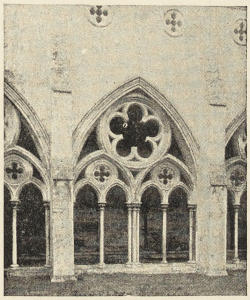
CLOISTER.
The success of the exterior of Salisbury depends, not on the littlenesses of architectural design, but on the great leading factors of any really great style—vastness of scale, yet further enhanced to the eye by multiplicity of parts; bold handling of the masses, combined nevertheless into a symmetrical whole: unity, harmony, proportion, shadow-effects. Beside these elemental factors, sculptured ornament is but “mint and cummin.”
Straighten out Salisbury cathedral, in imagination, till Lady chapel and retro-choir and eastern transept and choir and central transept and nave are all in one long straight line. Then let it resume its shape, and you will see what is meant by “bold handling of the masses,” and the difference it makes. Nevertheless, don’t go away with the idea that the lines of Salisbury cathedral were pulled about in this way for picturesqueness’ sake—for the sake of effect. The Gothic architects—pace Peterborough west front—did not design for effect. All the parts of the building are there either for some constructional or for some ritualistic reason. A big central tower will not stand[230] without abutment to the north and south; therefore there has to be a central transept. The long stretch of clerestory wall—at Salisbury unbuttressed externally—will be all the better for the support of two transepts and a lofty porch: they are added. Transepts, moreover, are useful in providing chapel-room for various great saints of Christendom, as well as for the local saints of the cathedral. The porch is useful as providing neutral ground for various functions—half religious, half secular; the porch is added. And so with the chapter-house. Every one of the appanages which make a Gothic exterior so picturesque was built, not because it would be picturesque, but because it would be useful.
And see what pits and abysses of shadow lurk behind each projecting buttress, and still more in each deep sound that runs inland, like some Norwegian fiord, between towering precipices on either side. But these grand shadow-effects—varying from minute to minute as the sun moves round—varying from day to day as summer treads on spring, autumn on summer—were not in the designer’s first intent. The projecting masses had to be there; the play of light and shadow which ensued, he did not plan; he only welcomed it. He had little control over it; in the windows, indeed, which were within his control, he made the jambs so shallow that the windows are externally almost shadowless; almost the whole depth of the window he gave to the interior, preferring to enrich the interior of each window with an inner arcade—feeling, doubtless, that he need do nothing externally to add to the shadow-effects of the projecting buttresses.
But the life-blood of an architectural design is proportion. Unfortunately one never notices its presence. Only when a building is out of proportion does one recognise that such a thing as proportion exists. And as it is the most subtle, so it is the most important factor in design—design small or large—Salisbury cathedral, the Pandolphini Palace, a Chippendale chair, or a Wedgewood vase. Alter the shape of the vase, and see the difference. In the same way, see if you can[231] lengthen or shorten Salisbury nave for the better, or the transepts, or the porch, or the Lady chapel; or if you could heighten the Lady chapel or retro-choir to advantage; or if you could make the roofs an inch more acute or more flat. The proportions of this, as of every really great building, are subtle in the extreme; they interlock in all directions. Each part—e.g., the Lady chapel—is in proportion to the cathedral taken as a whole; each part is in proportion to contiguous parts; and each individual bit of each part is in proportion to the rest of it: e.g., in the Lady chapel the length, breadth and height of the walls, the slope of the roof, the dimensions of the windows, etc., are all in proportion to the Lady chapel taken as a whole. More than that—the proportions of the nave, choir, transepts, etc., are those which are suitable to a church 473 feet long and 404 feet high. If you built a church with a nave, choir and transepts exactly twice as large as those of Salisbury, it would not be in proportion, but out of proportion. The same lack of proportion would ensue if you copied the design of Salisbury in a parish church of exactly half its dimensions. Salisbury cathedral, like the Parthenon, cannot be copied with impunity, unless you preserve every dimension unaltered. Modern designers, not recognising this, have too often wrought themselves disappointment by unintelligent imitations of ancient work.
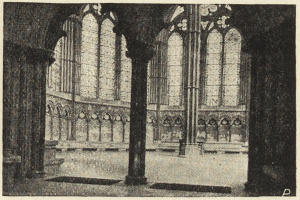
CHAPTER HOUSE.
To the north and south another charming effect is seen in the gradual growth of the ornament upward. This, again, is to the credit of Time, and not of Elias de Dereham. From 1220 to 1330 window-tracery was ever growing richer day by[232] day, and Salisbury cathedral was ever growing upward. And so the ornament culminates most rightly, yet most accidentally, in the higher stories of the transepts, in the tower and spire.
Only one criticism suggests itself before we leave Salisbury cathedral as seen from the north-east. Are not the voids in excess—two windows in the aisles and three in the clerestory, where one would produce a much more monumental and solid effect? Such single windows, filled with the opaque grisaille glass of the period, would have subdued the glare of the interior. But I have not the slightest doubt that the critics of the day infinitely preferred the uniform good lighting of Salisbury to the “dim, religious light” of Lincoln and its darksome corners and recesses. In Salisbury there is not a quiet spot anywhere where you can pray in peace; the blinding light pursues you everywhere. But good people in those days liked a cheerful church—full of light, sparkling with stained glass, brilliant with gilding and paint: religious gloom had not yet become fashionable; it did not come in till the time of the Puritans. In every respect except the fenestration, in Salisbury, as in Lincoln Minster, internal seems to have been subordinated to external effect.
The interior is, indeed, very fine. It could hardly help being fine; a nave so spacious and so proportioned could under no circumstances be a failure. It is immensely high, and is long in proportion. The proportion of height to span (2½ to 1) is better than in most English churches. The harmony of the design—practically the same from east to west, and from north to south—is unique in England, and is most impressive. The charming way, too, in which the architect has contrived that we should have a vista of another miniature church in the Lady chapel—a cathedral within a cathedral—is worthy of all commendation. But, as in Lincoln nave, to the eye every support is alarmingly insufficient for the work it has to do; the piers are too tall and slender, the walls too thin, and pierced with too many openings. The triforium is a most unfortunate design: in harmony neither[233] with the arcade below, nor with the clerestory above; its outer arches ugly in themselves and discordant with every other arch in the church; nor could it be expected that its dark marble shafts would tell against a dark background—black on black. Add to this the dreadfully new look of everything—partly due to the very perfection of the masonry, partly because Scott has been here—and the overpowering glare: one almost feels as if one were in the Crystal Palace. Of the west front it is as well to say nothing; it would take pages to contain the unkind things that have been said about it.
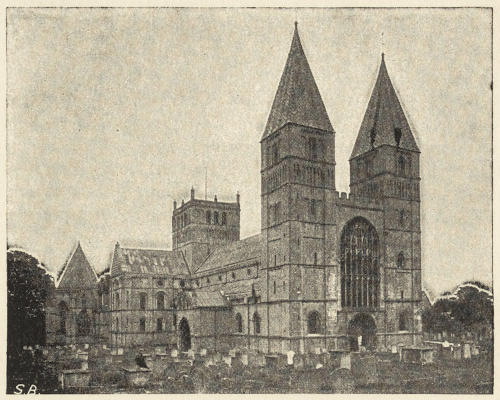
FROM NORTH-WEST.
Southwell Minster, as it is usually but incorrectly styled, was originally what is called a collegiate church. It is as if, in any parish church of unusual importance or with an exceptionally large population, there should be not one rector, as nowadays, but a dozen or so, this dozen being formed into a corporation, with a dean, precentor, chancellor and treasurer (the two first officials did not exist at Southwell). All the cathedrals of the old foundation had from the earliest time such a collegiate constitution as the above: viz., Chichester, Exeter, Hereford, Lichfield, Lincoln, London, Salisbury, Wells, and the four Welsh cathedrals. But all these were also cathedrals: i.e., they possessed a bishop’s chair (cathedra); Southwell did not become a[235] cathedral—there was no bishop of Southwell—till the present reign.
Like the other ecclesiastical colleges—those of cathedrals excepted—that of Southwell was suppressed by Edward VI.; but under Queen Mary it had the good fortune to be reconstituted and re-endowed. Its sister church, Beverley minster, also a college of secular canons—i.e., priests not living under a monastic rule—became and has remained a parish church. The only collegiate churches remaining with their original constitution are Windsor, Westminster, Heytesbury, Middleham, and St. Katherine’s Hospital, London—omitting, of course, the cathedrals of the old foundation.
Though, however, there was till recently no bishop of Southwell, yet the church up to the Reformation was practically a cathedral. Just as the Bishop of Wells had at different times other cathedrals besides that of Wells—at one time at Bath, at another time at Glastonbury; and as the bishop of the Mercian diocese had at one time three chairs—viz., at Lichfield, Chester and Coventry—so the Archbishop of the immense northern kingdom of Northumbria required and possessed four cathedrals: viz., at York, Ripon, Beverley and Southwell. The latter was especially the cathedral of Nottinghamshire, as it has become once more. The archbishops had a palace at Southwell, of which the fine hall remains; Archbishop Sandys is buried in the minster.
I. In the seventh century St. Paulinus is said to have founded a church at Southwell. But long before his time—in the third century, or thereabouts—the Romans were at Southwell. There actually survives a tesselated pavement in the south transept which may well have belonged to a Romano-British basilica.
II. Two fragments have been carefully preserved and re-used from an early Norman church—it may even have been of Pre-Conquest date. One is a fragment of a lintel over a doorway in the north transept, depicting St. Michael and the Dragon and David throttling the lion. The other is a set of[236] capitals on the eastern piers of the tower, now unfortunately covered up to make room for more organ pipes. (A mania for big organs is raging in our cathedrals: nothing short of the roar and rumble of an earthquake will bring people nowadays into a devotional frame of mind.)
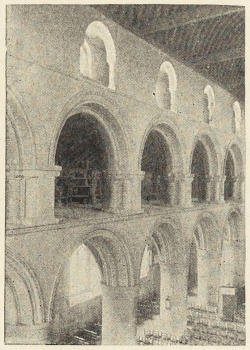
NAVE.
III. Between 1109 and 1114 a new Norman church was begun. Of this the choir has disappeared. As the choir would be built first, 1120 is given as an approximate date for the transept and 1130 for the nave. The cable-mouldings, however, of the crossing and transepts, and the carving of the nave-capitals, are so rich and effective that the work is probably somewhat later. Indeed, the whole of the ornamentation is far ahead of that at Ely, Norwich and Peterborough, Tewkesbury or Gloucester. The carved capitals may be compared with those of the nave of Hereford. The interior of the nave is low and squat, but has been vastly improved by Mr. Christian’s semicircular ceiling. The piers are stumpy cylinders; the elevation is that of Malvern, or St. Bartholomew’s, Smithfield. Here there are none of the tall compound piers of Peterborough or Ely, still less the Brobdingnagian cylinders of Tewkesbury or Gloucester. Each bay of the triforium was to have been filled with the same kind of arcade as that of Romsey choir: viz., two small arches, with a small shaft rising from their point of intersection. (Projecting stones, intended for the arches and the shaft, may be seen in each bay.) The Romsey design was not a success even in[237] the eyes of the Romsey people, for they tried five other designs in the triforium of their transept; and the Southwell canons very sensibly omitted this inner arcade. The clerestory, with its circular windows, is remarkable; the same design was worked out very beautifully, later on, in the north transept of Hereford.
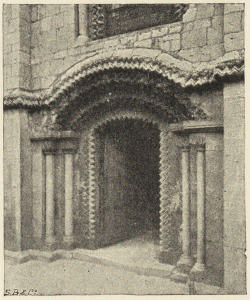
SOUTH TRANSEPT DOOR.
From each transept projected eastward a two-storied apse (cf. Gloucester), the arches into which remain, and also the very noble arcade which opened into the upper chapel of the apse. It is noteworthy that the aisles are vaulted, as at Kirkstall, in oblong compartments—another mark of late date. The square broach spires of the west front—which, as well as the conical roof of the chapter-house, were restored by Mr. Christian on the authority of old prints—give the church quite a Rhenish appearance. The two big west windows of the towers are modern shams; originally these stages of the towers were, no doubt, solid. The north-west tower has a pointed arcade, and is therefore a little later than its neighbour, which has an intersecting arcade of semicircular arches. Originally the façade was just such a one as that which remains in St. Stephen’s, Caen.
A magnificent string-course of zigzag ornament runs along the nave and round the transepts. In places it has been taken out, reinserted in a different place or copied, when the[238] Perpendicular windows were inserted in the aisle of the nave. In the south transept it takes the unusual form of a segmental arch over the Archbishop’s doorway. The great emphasis given to the horizontal lines of the Norman building is as remarkable here as at Salisbury. There are good examples of the “nebule” corbel-table with a later parapet, and of Norman pinnacles; one of these, over the porch, is hollow, and served as a chimney for the sacristan or sexton, who, it was enacted, “should lie within the church, to be at hand to ring the bells at the right time.” The gables of the transept have very effective zigzag, with interesting differences of treatment; the pinnacles of the transepts seem to have been removed at some time or other to the central tower, for which they are too small. There is a fine view of the whole exterior from the fields and gardens to the south-east.
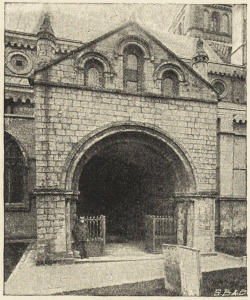
NORTH PORCH.
IV. This fine Norman church only existed in its entirety for a century. Its eastern limb was less than half the length of the present choir, which was commenced c. 1230 by Archbishop Gray, who built the great transept of York and the west front of Ripon. The plan is practically that of Worcester, (the eastern portion of which was finished c. 1218), but on a humbler scale: viz., an aisled choir for the canons, a tiny eastern transept (such a one was still in existence in the Transitional choir of York), and a long presbytery, the two[239] eastern bays of which were without aisles. Externally this gives a beautiful composition even now. Before its mutilation, the Southwell choir must have been one of the best mediæval designs in Europe. Unfortunately the roofs have been lowered, and in the flattened battlemented eastern gable a most misshapen window now appears. Originally there were no external flying-buttresses (cf. Salisbury); the clerestory wall began to bulge out; the high roofs of the eastern transepts were taken down, and external flying-buttresses were erected (c. 1355). Take these away, in imagination, raise roofs and gables to as sharp a pitch as those of Beverley and Lincoln, and you have a design as noble as it is simple. The alternation of aisled choir and unaisled presbytery with the fine projecting masses of the eastern transepts provides charming contrasts of light and shadow; the base-courses are almost as strong and emphatic as at Salisbury; the sharply chamfered buttresses, with their acute pyramidal caps—a reminiscence of Lincoln nave—are particularly effective. Contrary to Salisbury fashion, the windows are deeply recessed externally. The whole design is vigorous and original.
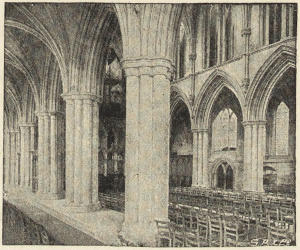
CHOIR, NORTH SIDE.
The interior of the choir is equally original and interesting. The architect seems to have thought that the vaults of the choir must rise no higher than the eastern arch of the tower. If so, he was mistaken; as may be seen at Norwich, where the choir rises much higher than the nave. His problem then was how to get the appearance without the reality of height in the triforium. The[240] same problem had troubled the Norman builders at Dunstable, Jedburgh, and Oxford; they had solved it by constructing a lofty pier-arcade, and then building the triforium beneath it. The Norman builders at Steyning, and the architects of Southwell and Pershore choirs—which were going up together—solved the difficulty in a different and more effective manner: viz., by inserting the triforium inside the clerestory. This saved the elevation. The pier-arcade was tall, the clerestory was tall, and the whole interior looked tall and not squat.
To interfere with the services as little as possible, the eastern half was built first, as at Rochester and Worcester. When this was finished, the western half was built. If the foliage of the beautiful capitals and corbels and bosses be examined carefully, it will be found to be somewhat stiff and formal in the eastern bays, and to be worked with much more crispness and freedom towards the west (cf. Worcester). The next thing was to pull down the Norman choir, the material of which is found to be largely built up in the western, but not in the eastern bays. In rebuilding the western bays, the first consideration was not to bring down the Norman tower. So the work was not continued from the east, but was started afresh from the tower. The two portions met in the fourth bay; when it was found that, owing to inaccurate setting-out, the arch on the south side of the choir and the string-course on the north side were at a different level to that of the older work to the east. The awkward junction of the arches was masked by a curious medallion. The whole of the work was done late in the Lancet period; as is shown by the frequent use of the triple roll in the bases, and by the fact that the tooth-ornament is worked on a projecting fillet, as in the north transept of Hereford, instead of being set in a hollow. The vault of the aisles and transept is quinquepartite, as in St. Hugh’s aisles and transept at Lincoln; the high vault is quadripartite; and both vaults have the wobbling longitudinal rib of the great transept of Lincoln. At the east end this rib[241] drops down somewhat fortuitously into the middle of a group of lancets. A special local note of this Southwell work is fondness for fillets; they abound everywhere.
V. A little later, the eastern apse of the north transept was replaced by a double chapel (c. 1260). The shafts have the “keel-moulding,” both here and in the chapter-house.

NAVE, LOOKING EAST.
VI. Next was built the cloister—i.e., the southern part of the Vestibule leading to the chapter-house. Notice the lovely doorway in the north choir-aisle. In this and the arcade is early naturalistic foliage, which fixes the date as c. 1280. Before the upper story was built, and when the eastern arcade was open, it must have been singularly beautiful. From the little courtyard between the cloister and the eastern transept the views are most picturesque.
VII. Then was built the vestibule and the chapter-house. If in window tracery and leafage it be compared with the chapter-house of York, it will be plain that the Southwell example is the earlier. Southwell chapter-house may be 1290, York 1300. York chapter-house is then but a copy of that of Southwell—and an inferior copy; both dispense with a central pier; but Southwell has a magnificent vault of stone, whereas York is vaulted in wood. The chapter-house of Southwell, not that of York, is “among chapter-houses, as the rose among flowers.” “What Cologne cathedral[242] is to Germany, Amiens to France,” says Mr. Street, “is Southwell chapter-house to England.” Here English stone-carvers produced their best work; nowhere will you find such capitals or crockets or spandrels, nor such portraits—all, no doubt, here and in the cloister, representing people living at Southwell 1280-1300. Photographs of this wonderful detail have been inserted in the Introduction, pages v-xiii.
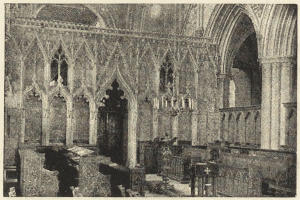
CHOIR SCREEN.
VIII. But the wonders of Southwell do not end yet. In the Curvilinear period (1315-1360) was erected quite the loveliest choir screen in England; next comes that of Lincoln, evidently by the same hand. Eastern and western sides are entirely different in design: on the western side the artist parts reluctantly with the beautiful geometrical design of the thirteenth century; on the eastern side he accepts unreservedly the reign of the ogee arch. Magnificent sedilia and stone stalls of similar character were erected, which only survive in part. Very beautiful, too, is the cusping of the reticulated windows inserted in the north transept chapel.
The upper parts of the chapter-house and the north transept chapel also were remodelled in the Curvilinear period.
For two hundred years or more, the highest and best of mediæval art found cultivated and wealthy patrons in[243] the canons of Southwell. Norman, Lancet, Geometrical, Curvilinear work are all seen here at their best. Few of our cathedrals, from the point of view either of architectural design or sculptured detail, can be mentioned in the same breath with Southwell. Nowhere will the architectural student find such a treasure of the best work of the best periods as in the sister churches of the canons of Beverley and Southwell. It is one of the greatest delights of Southwell that this lovely minster is little known and almost unvisited: one feels as if one were “the first that ever burst into this silent sea.”
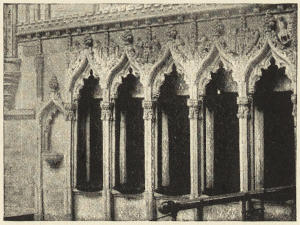
SEDILIA.
IX. Perpendicular.—Large windows were inserted in the aisles (c. 1390) and the west end (fifteenth century) to light the nave; and a doorway from the choir to the Archbishop’s palace on the south.
X. There is an alabaster monument of Archbishop Sandys (d. 1588), of unusually good design. To the same century belongs the fine Renaissance glass (French) in the east of the choir.
XI. There were originally sixteen canons or priests at Southwell in charge of the services. But as they mostly resided in their country parishes, they were allowed to appoint sixteen vicars or deputies, to do their work for them. These vicars, like the canons, formed a college or corporation.[244] The vicars also found the work hard, and were aided by paid lay-clerks and choir-boys. Besides these there was a college of thirteen chantry-priests. In later days there used to be in residence at Southwell only one canon out of the sixteen; he came into residence only once in four years, and only stayed three months. The handsome block of brick houses to the east of the minster was built in 1780: the eastern house for the canon in residence; the two houses on each side for four of the vicars (the number of whom had dwindled to six).
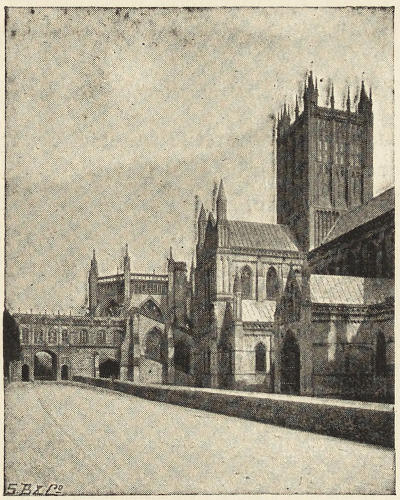
FROM NORTH-WEST.
“The traveller who comes down the hill from Shepton Mallet,” says Professor Freeman, “looks down on a group of buildings without a rival either in our own island or beyond the seas.” “From a distance,” says Mr. Peabody, “the towers and lantern of the cathedral rise above rounded masses of green foliage. When we reach its walls, we find them springing from the azure depths of crystalline pools, from emerald lawns and arching trees, the home of cawing rooks and soaring pigeons. Close to the very walls of the ancient cathedral rises one of the noblest springs in the world, to which city and cathedral owe their name; an ever-abounding and magnificent outburst of waters at the side of the Lady chapel, surging up in a boiling heap in the midst of the unfathomed depths of a translucent pool; then bounding over in an impetuous cascade, which carries it into the Bishop’s moat, to encircle palace and rampart and towers, till it rests in glassy clearness over many-coloured forests of branching or feathery or star-like water-weeds.[246] Never did a Frenchman form such harmonies of church and scenery as one sees at Lichfield, at Salisbury, and at Wells, in their setting of close and cloister and lake, of brilliant garden and clipped green lawn and immemorial elms. Above rise three gray, time worn towers; the music of the chimes vibrates and dies away:
So from hour to hour chant the bells over the peaceful beauty of the bishop’s gardens and terraces and the ancient ivy-clad palace; while within the lonely nave, as the fading sunlight shines through the western window, and casts its coloured glories on sculptured tomb and carved boss and gray stone wall, the organ notes pulsate through the stony fabric:
The great solemn place is filled with the thrilling sweetness of boyish voices, and we heartily join in their tuneful, long ‘Amen,’ as it rings and resounds down the empty nave, and echoes again and again from distant chapel and far-receding vaults.
“The Bishop’s palace is romance made tangible, even to ‘spell-bound princes oaring their way as swans among the lilies of the moat.’ In this home of peace good Bishop Ken led his simple, happy life, awaking with the sun and joining with the birds in their morning hymn, and each eventide singing to his lute—
Beyond the gardens and the moat run avenues of stately elms; hard by, to the north, are the cathedral’s triple towers,[247] and, for background, the mighty range of the Mendips; all round is meadow-grass; to the west nestles the little town, with the stately tower of St. Cuthbert’s church; and, five miles away, conical tors rise on either side of the isle of Avalon, the storied land of Glastonbury, where twice each year bloomed the sacred thorn struck by Joseph of Arimathea from a thorn in the Saviour’s crown; where, too, lies King Arthur, borne thither after the fatal battle of Camelot, and buried in an unknown grave with the inscription, ‘Hic jacet Arturus rex quondam rexque futurus.’ This land of Somerset to the Englishman should be holy ground.”

NORTH TRANSEPT.
The peculiar charm of Wells lies, as Professor Freeman remarks, in the union and harmonious grouping of the cathedral with its surroundings. It does not stand alone. On the other hand, it is not crowded by incongruous buildings, like the great cathedrals of France, rising in precipices from narrow lanes or stone paved place. Nor, again, is it isolated from those buildings which are its natural and necessary complement—the palace of the Bishop, the deanery, the residence of the Archdeacon, the Cathedral school, the Vicar’s Close, the homes of precentor, organist and architect. Nearly all the officials still live in the houses which Bishop Beckington built four centuries ago. And with the most perfect and picturesque of all these, “a double row of little ancient houses,” the Vicar’s[248] Close, the north transept of the cathedral is connected by a delightful mediæval bridge.
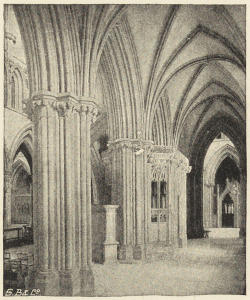
SUGAR’S CHANTRY IN NAVE.
The diocese of Wells is an offshoot of that of Winchester. When Wessex grew populous, the bishopric of Sherborne was split off from that of Winchester; and in 909 the shire of the Sumorsaetas was split off from Sherborne, and the men of Somerset got a bishop of their own. The diocese long had two cathedrals: one at Wells, served, as at this day, by secular canons; the other at Bath, served by the monks of the Benedictine abbey. The latter was suppressed by Henry VIII., and ever since the bishop has been but in name Bishop of Bath.
Of the earlier cathedrals not a trace remains. The oldest part of the present cathedral consists of the nave, transepts, and the piers and arches of the three western bays of the choir. All this was designed, and much of it built in the time of Fitz-Bohun, who became bishop in 1171. The design is what is called Transitional. It is not early Transitional; for there is none of the heaviness and massiveness of the early Transitional work of Malmesbury, Kirkstall, or Fountains. It is not middle Transitional; for the semicircular arch, which still appears here and thereat Ripon, is conspicuously absent. It is late, very late, Transitional work, done at the very end of the Transitional period (1145-1190), and therefore contemporaneous with the famous French choir of Canterbury[249] (1175-1184) and the beautiful presbytery of Chichester (built after the fire of 1187). But it is more Gothic than either Canterbury or Chichester. In fact, Wells is the most advanced of all the cathedral designs of the Transitional period. There is indeed little of the Romanesque or Norman about it; still it is there. Among the survivals of Romanesque feeling may be noticed the zigzag ornament in the doorways of the north porch, the classical character of several foliage-capitals, the retention of man-headed birds and other Romanesque monsters in the capitals, and, above all, the universal square abacus. All these, however, except the square abacus, find parallels in advanced Gothic work of the thirteenth century elsewhere. And as we find precisely the same stiff foliage-capitals in Chichester presbytery subsequent to 1187, and in St. Joseph’s chapel, Glastonbury (1180-1190), we may be certain that the design belongs to Fitz-Bohun’s episcopate, before whose death in 1191 the church was rising fast, and its style an object of universal admiration.
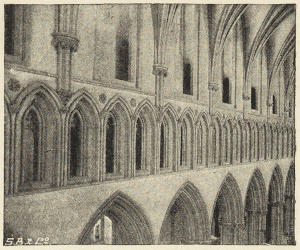
TRIFORIUM OF NAVE.
Now this is a very important matter, at any rate to Englishmen. In the first place, we are provided with another example of first-rate importance, of what architects were doing in this country just before the final plunge into Gothic, i.e., just before St. Hugh commenced his work at Lincoln. Hitherto we have had to rely on what we see in Canterbury choir; now we have Wells also. To these we may add the little-known Abbey of Dore, in the Black Mountains. In its lovely choir we go one step farther. Even the square abacus, universal at Wells, alternates there with the[250] round form, and is more and more infrequent as one proceeds to the retro-choir, where indeed the work, to all intents and purposes, is pure Gothic. And thus we get what we never had before, a bridge or series of stepping-stones to Gothic architecture. Formerly one passed at a bound, an impossible bound, from Canterbury choir to Lincoln Minster. Now we can leave out the French work of Canterbury choir altogether, and accomplish the passage from Norman to Gothic through Malmesbury, Kirkstall, Ripon, Wells, Abbey Dore. Before, it was inconceivable how Lincoln came into existence; it was an architectural Melchisedek, without father or mother; and those who did not believe in spontaneous generation in architecture were driven, in spite of their wishes, to seek out an ancestor for St. Hugh’s choir in France. Now the whole difficulty is removed, the missing link has been found, Lincoln is but the logical development of Wells and Abbey Dore. The architectural chain is complete. Lincoln is no Melchisedek we have found its parents; and, what is profoundly satisfactory, they are true-born Englishmen, not Frenchmen. Wells, therefore, deserves all the attention that the architectural student can give to it, as evidence that the Gothic architecture of England did not originate with the French choir at Canterbury of William of Sens, but is native and indigenous to the soil.
The design of the nave of Wells, however, has more than archæological interest; it has a decided artistic distinction of its own. In the first place, the interior looks taller than it is—i.e. it is the very reverse of Lichfield. It is but 67 feet high, and is thus one of the lowest of our cathedrals; but so just are its proportions, so well adjusted the tall clerestory to the stages below, that to the eye the ratio of height to breadth is entirely satisfactory. Equally remarkable is the way in which the impression of great length is produced. This is due to the obliteration of vertical divisions in the triforium and ground-story, which are not separated off, as usual, into bays by vaulting-shafts. The vaulting-shafts are stopped just[251] below the sill of the clerestory, and the triforium runs in an uninterrupted arcade, the whole distance from west to east. Such a treatment of the triforium is unusual in England, but is found also at Glastonbury and Llandaff: perhaps it hails originally from Matilda’s church, the Abbaye aux Dames, at Caen. And the free flow, east and west, of the broad horizontal band of the triforium is aided still further by designing it void of shafts, bases, and capitals alike. The central tower seems to have collapsed in 1248, and many of the capitals seem to be of this or of a still later date. The capitals, corbels and the carving generally of this part of the cathedral are most spirited and interesting; there is hardly any mediæval work in the country to excel it in spirit, variety and execution; it should be examined with the utmost care. When you have seen the carving in Wells cathedral, you will not be so much surprised at the excellence of that in the choirs of Lincoln and the west front of St. Albans. The plan of the piers should also be noted.
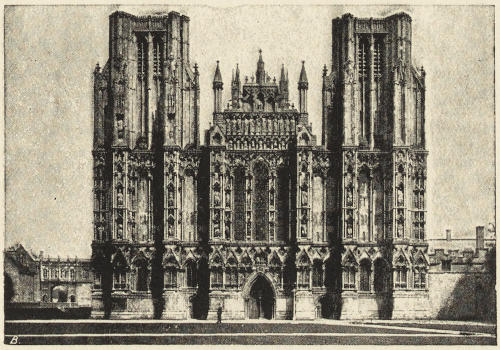
WEST FRONT.
Lancet Period. West Front.—Looking westward, we see to the south (on the left) the chapel of St. Edmund,[252] and to the north the chapel of the Holy Cross, now the Consistory Court. The west front, including these chapels, is Bishop Jocelyn’s work; it is in the purest early English Gothic, probably built after his return from exile in 1213, and finished by him before 1239. There has been, however, some rebuilding here, and a parapet added, in the fifteenth century. Passing out, we can now survey the famous façade, and its immense collection of sculpture—by far the best mediæval figure-sculpture in England, and only surpassed by the yet finer and earlier sculpture of Chartres and Rheims. The visitor will do well to study it in detail in the admirable series of photographs, taken when the scaffolding was up for the restoration of the façade. Professor Cockerell suggests that the façade is to be regarded as a Te Deum in stone.
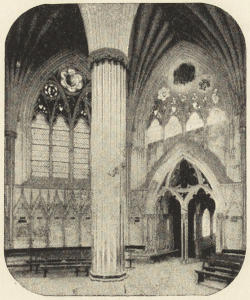
CHAPTER HOUSE
As for the composition of the west front, it has been severely criticised, but two things must be borne in mind. The first is, that the towers were probably designed for spires. Add the spires, and as Notre Dame, Paris, the squatness of the façade disappears. Secondly, it was designed for the sculpture—a sort of open-air reredos—and not the sculpture for the façade. Nevertheless, it is not good, even as a reredos. The windows are mere slits in the wall, the doorways mere “holes for frogs and mice.” It lacks variety: the six big buttresses project, but have all the same amount of projection. The arcading below the west window is confused and muddled, and cut into[253] anyhow by the central doorway. Nevertheless, its great breadth makes this façade of Wells more impressive than any other in the country, except that of Peterborough. What would it be with the spires added!
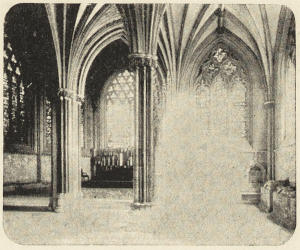
LADY CHAPEL.
Geometrical Period. Undercroft, Staircase, Chapter house.—When the west front had been peopled with statuary, the undercroft of the chapter-house was built. A similar chapter-house, two stories high, once existed in precisely the same situation i.e.—east of the north transept—at Beverley minster, the exquisite staircase to which still survives. Westminster chapter-house and that of Old St. Paul’s also had undercrofts. These undercrofts probably served as sacristies. The staircase or vestibule to the chapter-house, with simple tracery of cusped circles in its windows, is also of the early Geometrical period: its date is 1286-1320. The work here deserves the closest inspection; it is the best work in Wells cathedral, and unsurpassed by anything in Great Britain. The naturalistic foliage of the capitals and corbels is superb: especially notice the first corbels, representing a monk and a nun treading on serpents. The staircase leads by the chain bridge to the vicars’ close, as well as to the chapter-house. The chapter-house is one of the noblest in England. The long-lobed trefoils in the window tracery indicate that it is a work of the latter half of the Geometrical period (1280-1320); the profusion of ball-flower round and beneath the[254] windows, and the ogee dripstones outside the windows, would seem to indicate that it was not completed till the very end of the period. Canon Church has ascertained that it was not finished before 1320.
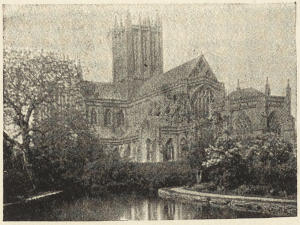
FROM SOUTH-EAST.
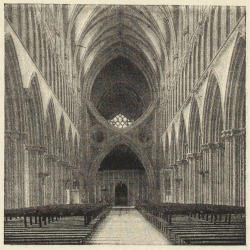
NAVE.
Curvilinear Period. Lady Chapel, Choir, Central Tower.—But a much more important work remained, which had hitherto been postponed, owing perhaps to the great expense involved in the completion of the west front and the chapter-house. It was to extend the choir eastwards. Many of the great cathedrals had finished their eastward extensions long before. Canterbury choir had been prolonged at the beginning of the twelfth century, and again about 1180. Hereford also was lengthened about 1180. The Angel Choir of Lincoln had been built about 1280. But at Wells, Lichfield and Chester, the extension of the choir was not effected till the Curvilinear period (1315-1360). As at Lichfield, the Wells architect seems first to have built the Lady chapel as a detached building, afterwards joining it up to the Transitional bays of Fitz-Jocelyn’s choir. As every one knows, it is the most beautiful east end we have in England. It may be worth while to try to see how this design was arrived at—a design as exceptional as it is effective. The simplest form of east end in English Gothic is seen at York and Lincoln: it consists merely of a low wall with a big window above it. The next improvement is to build an aisle or processional path behind the east end; at the same time[255] piercing the east wall with one, two, or three arches. This was done at Hereford about 1180; and on a magnificent scale in the Chapels of Nine Altars at Durham and Fountains early in the thirteenth century. But the French apsidal cathedrals—of which we have an example in Westminster—have not only an encircling processional aisle, but also a chevet of chapels radiating out from it; thus providing ever-changing vistas of entrancing beauty. The next step in England also was to provide our rectangular choirs with a chevet as well as with a processional aisle. An early example of this plan is to be seen at Abbey Dore, in Herefordshire, about 1190. It occurs early in the thirteenth century, on a still grander scale, at Salisbury; where one finds not one, but two processional aisles, as well as chapels to the east of them; and, in addition, a Lady chapel projecting still farther to the east, thus producing a design of great complexity and beauty. Nevertheless, at Salisbury, since the chief supporting piers of the retro-choir and the chevet are in a line with those of the choir, there is by no means the same changeful intricacy of vista that affords one ever fresh delight in an apsidal church. At Wells, however, the architect attained all the success of the Continental builder, simply because he built his Lady chapel not rectangular but octagonal. For,[256] to get this octagon, of which only five sides were supported by walls, he had to plant in the retro-choir two piers to support the remaining three sides; and these piers are necessarily out of line with the piers of the choir. He had got the Continental vista. He saw it; but he saw also that it could be improved upon. And he did improve it, by putting up an outer ring of four more piers round the western part of the octagon of the Lady chapel. It was an intuition of genius: it makes the vistas into the retro-choir and Lady chapel a veritable glimpse into fairyland; and provides, here alone in England, a rival to the glorious eastern terminations of Amiens and Le Mans. And that is not all. We saw in the chapter-house the grand effect of the central stalk branching upward and outward in all directions, like some palm tree transmuted into stone. This beautiful effect he transfers to the retro-choir, but multiplied—four palm trees in place of one; for each of the four external piers of the octagon emulates the chapter-house’s central stalk. “It is difficult to determine whether the effect is more striking in the early morning, when the ancient splendours of the stained glass, are reflected on the slender shafts of Purbeck marble and the clustered vault; or at the late winter services, when the darkened figures of saints and prophets in the clerestory combine with the few lights burning in the choristers’ stalls to add something of mystery and solemn gloom to the maze of aisles and chapels, half hidden, half revealed” (Murray). And where did the idea of having an octagonal Lady chapel come from? Possibly it came from Lichfield. If one follows the outline formed by the five walls of Wells Lady chapel and the four outer piers, which complete the octagon, it will be seen that the Wells octagon is of precisely the same elongated form—two long sides and six short ones—as the chapter-house of Lichfield. We may fairly suppose, then, that the Wells architect got the design for his east end by tacking on the elongated octagon of Lichfield chapter-house to the rectangular retro-choir of Salisbury[257]. This Lady chapel is an early work of the Curvilinear period; for it seems to have been complete in 1324. The windows have beautiful reticulated tracery of early type. There is lovely carving in the capitals, bosses, reredos, sedilia and piscina. The Curvilinear foliated capitals here and in the choir should be compared with the somewhat earlier capitals of the chapter-house, with the early Geometrical capitals of the staircase, the Lancet capitals of the west front, and the[258] still earlier ones of porch, nave, and transepts. The ancient glass here and in the Jesse window of the choir is superb in colour.
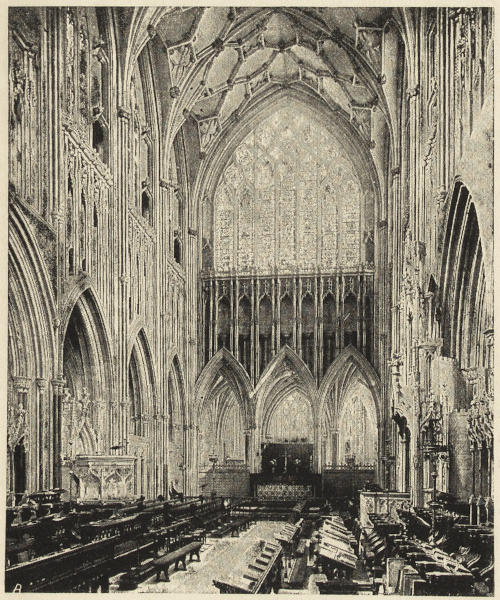
CHOIR.
Choir.—The works in the choir consist of three parts. (1) The construction of three new eastern bays, to join up the Lady chapel to the western bays, as at Lichfield and Chester. (2) The transformation of the three western bays, except the piers and arches, and of the aisles. (3) The vaulting. All the lower work is of great beauty, especially the tabernacle work which replaces the triforium. The foliage of the capitals is naturalistic, and curiously diminutive. The vault, however, is unusual and objectionable in character. It is really a reproduction in stone of a kind of vault—the wagon or barrel vault—which, executed in wood, is a special peculiarity of Somerset. This type of stone tunnel, with ill-arranged liernes, sham ribs carved on its surface, and holes cut into it to admit the heads of the clerestory windows, is fortunately confined to Wells. It is, moreover, a gross blunder in design. The pattern of the ribs would be excellent in a flat ceiling; but in perspective it comes out all wrong, because the architect has omitted to take account of the curves of the vault. The stalls, with their stone canopies, are modern, with ancient misereres. The Transitional windows of the aisles were also replaced by Curvilinear ones.
Finally, the church assumed a more dignified appearance externally, for the Central Tower was carried up to its present height between 1318 and 1321; but as yet there were no western towers. As was so often the case, the raising of the central tower “caused the four great piers, on which it rested, to sink into the ground. This, of course, tore away the masonry of the four limbs of the church from the piers, and yawning gaps began to appear between the tower arches and the main walls of the church.” The piers had to be strengthened and the gaps filled up. This was done about 1338. At Canterbury and Salisbury the central piers were strengthened by running across a horizontal stone girder; at Wells the[259] exceedingly strong and exceedingly ugly form of an arch carrying an inverted arch was adopted. This stone framework thus assumes something of the shape of St. Andrew’s Cross, by which name it is generally known. The eastern arch is not strengthened in this fashion, but by a massive screen, which is practically a solid wall, as at Canterbury, York and Ripon. What makes the St. Andrew’s crosses more objectionable still is the hugeness of their mouldings, whose vast scale dwarfs everything in the cathedral into insignificance: in this respect they compare very unfavourably with the horizontal girders at Canterbury. Probably one of the last works of the Curvilinear period was to crown the whole exterior of the cathedral with a fine pierced parapet.
Perpendicular Period.—The central tower being saved, the next thing was to carry up western towers. Of these the southern was built after the year 1386; the northern tower is later than 1424. Moreover, Perpendicular tracery was inserted in many of the Transitional windows—e.g., by Bishop Beckington in the clerestory and aisles of the nave (1443-1464). The same prelate built the three gatehouses, all of which display his rebus, a beacon in flames issuing from a barrel: viz. the Chain Gate, the Penniless Porch (opening to the Market Place), and Browne’s Gate (at the end of Sadler Street). The Early English Cloister was also rebuilt between 1407 and 1470. Of the earlier cloister the outer walls and two lovely doorways survive. As Wells was not a monastic cathedral, the cloister was a mere objet de luxe, except so far as it provided an enclosure for the cemetery and a covered way to the Bishop’s Palace. Accordingly, it is incomplete; the northern walk is wanting; and the chapter-house is on the other side of the cathedral.
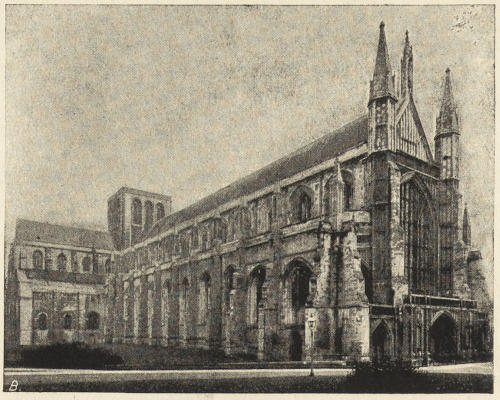
FROM NORTH WEST.
The present legal designation of Winchester cathedral dates only from the time of Henry VIII. It was originally the church of the abbey of St. Swithun; and, next to St. Swithun, its greatest patron was St. Birinus. Later on, an alternative dedication was to St. Peter and St. Paul.
It is the longest mediæval cathedral in Europe. Once it was surpassed by old St. Paul’s, London; now its only rival is St. Alban’s. But Winchester has an internal length of 526 feet 6 inches; exceeding that of St. Alban’s by 5 feet 4 inches. Vast as it is, no cathedral shows up so little. It has but one tower, and that barely overtops the roof; in outline it is depressed and monotonous; there are none of the double transepts, and lofty side-porches, which so picturesquely break up the lines of Salisbury, Lincoln, and Hereford. It has no[261] conspicuous façade to give it grandeur to the west; it lacks the wide reach of open square and verdant close that delights at Salisbury and Wells. So far from dominating the city, like Lincoln or York, it hides out of sight. You walk all the length of the High Street and never get a glimpse of it. Never was such a retiring cathedral. Generally, it is approached from the High Street through a hole in the wall; up a narrow passage, and down an avenue of obscuring elms. Slowly its huge mass uprears itself, sprawling over the ground like some stranded prehistoric monster. And, externally, it is as plain as it is huge: mainly an enormous bulk of blank wall. Once it presented a better appearance; for though the Lady chapel to the east was rather shorter, to the west the nave was 40 feet longer, and was flanked, like Southwell, by two Norman towers, forming a western transept, after the manner of Ely and of Peterborough. The present west front does anything but prepare us for an interior so vast; it seems rather the approach to some parish church of the second rank. All the more, perhaps, is one struck with the glorious interior.
The arrangement of the cathedral should be compared with that of St. Alban’s. It consists of (1) nave, (2) choir, (3) presbytery or sanctuary, (4) feretory or saints’ chapel, (5) retro-choir, (6) Lady chapel.
In the North Transept we are in presence of the earliest work in the cathedral. Much of it is the work of Bishop Walkelin (1070 to 1097); and, with the exception of some traceried windows inserted early in the fourteenth century to give more light to the eastern altars, it remains much as he left it. As his work is in the transepts, so once was the whole cathedral. As finished before the close of the eleventh century, Winchester, in vastness of scale and stern power, must have been one of the most impressive cathedrals of England: more overwhelming than Ely or Peterborough; not inferior even to Durham. I am not sure that every change and transformation that took place at Winchester between the eleventh and the sixteenth century was not a change for the worse.[262] For of the earliest temples of our race, torn as it were out of the solid rock, Walkelin’s cathedral was the most awful and the most religious. As it is one of the earliest, so it was, artistically, the grandest of our Romanesque cathedrals. The south transept of Hereford and the north transept of Chester are, in comparison, humble indeed. In colossal scale it finds one rival only—the mighty church of St. Alban. Artistically, they are miles apart: as far apart as two designs can be, one conditioned by the use of stone, the other of brick.
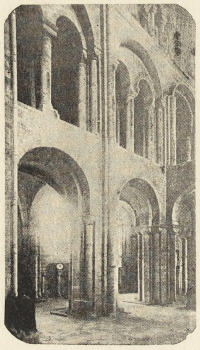
NORTH TRANSEPT.
But not all the work of the Winchester transepts is by Walkelin; it is Norman, but part of it is a rebuilding rendered necessary by the fall of the central tower in 1107. The original work is readily distinguished. Those parts of the transept which are the nearest to the central tower have fine-jointed masonry; the vaulting of the aisles has ribs; the piers are larger. The further and earlier part of the masonry is much ruder, and the joints wider; the vaulting is without ribs, and the piers are smaller. In both parts the arches are square-edged, greatly adding to the peculiar severity of the aspect of this part of the church. The pier-arches are raised on stilts in order to get their crowns on a level with the intersection of the diagonal groins or ribs; for the earlier vault-builders imagined that all the arches of a vault must rise to the same level. The cushion or cubical capitals are of a simple type, little subdivided. Both transepts have double aisles. Lanfranc, in his metropolitan cathedral at Canterbury, was content with an aisleless transept; but Winchester cathedral was built on a scale befitting the capital of the Norman realms.[263] At either end, too, of the transepts is an aisle—i.e. to the north and south; this unusual feature enabled processions to pass uninterruptedly round the triforium. We hear that in 1111, the bishop having sorely taxed the monastery to provide funds for the rebuilding of the central tower, “the monks reversed their crosses, head down, feet up, and made procession barefoot against the sun, contrary to ecclesiastical use,” round the broad triforium. Ely once had similar end-aisles, and still has both eastern and western aisles to the transepts.
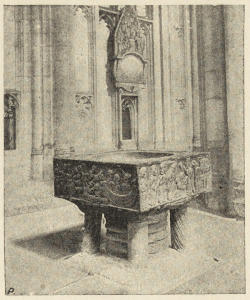
FONT.
The Crypt.—From the north transept one descends to the crypt, which is well worth a visit, when not under water. The level of the river seems to have risen since the eleventh century, causing the crypt to be frequently flooded. It extends to the extreme east end of the present cathedral, and is in three parts. The first part, the western, consists of the substructure of the original choir, showing that it consisted of four aisled bays and an apse with ambulatory. Secondly comes a very remarkable feature, of the same date—viz., a long aisleless chapel of three bays, also apsidal, beneath the present retro-choir. Whether the chapel above it was a Lady chapel is a matter of uncertainty; for Lady chapels do not seem to have come into fashion till the thirteenth century. Thirdly, to the extreme east, comes the substructure of Courtenay’s Lady chapel, built between 1486 and 1492. Most interesting of all[264] is the sacred well, immediately beneath the high altar; far older than Norman crypt or Norman cathedral; the holy central spot of by-gone Saxon and even British minsters.
South Transept.—Crossing the choir, we pass down a flight of steps to the south transept. At the top of these steps are the bolt-holes of the iron gates, which are now placed in the north-west corner of the nave, but which once stood here as a barrier to the pilgrims, who were allowed access to the north transept and choir aisles, but not to the choir itself, or to the south transept. They entered the cathedral by a doorway which may still be seen from the outside at the south-east corner of the north transept. In the south transept the same two periods of Norman work are recognisable which we saw in the north transept; but the three aisles have been shut off by walls and screens, forming chapels on the east side, and a chapter-room and treasury on the west.
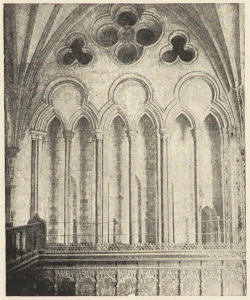
LADY-CHAPEL.
The Central Tower fell in 1107. Its fall was regarded as a judgment; William Rufus having been buried under it in 1100. The piers, as strengthened, are “most unwieldy and intrusive from their excessive size and squareness of form; the largest tower-piers in England in proportion to the span of the arches that rest upon them.” The tower-windows could formerly be seen from below, as well as a grand specimen of late Norman arcading: now hidden from view by the wooden fan-vault erected in 1634. The eastern and western arches of the tower are left wide, so as not to interfere with the principal vista[265] of the cathedral; the northern and southern arches are contracted to gain strength. The northern and southern sides of the piers were designed nearly flat, so as not to interfere with the stall-work of the monks. This is one of the cathedrals where the choir occupies, in part, its original position, and has not been moved eastward into the sanctuary. But originally the monastic choir of Winchester extended still farther to the west, occupying not one, but three bays of the nave; and was separated from the western bays of the nave by a great rood-screen. The old arrangement has been preserved at Norwich and Gloucester, and has been restored at Peterborough. Before leaving the south transept, the northern bay of the western triforium should be noticed. It has been only partially transformed into Perpendicular after the style of the nave; for the semicircular upper arch of the triforium can still be seen. This helps us to restore in imagination the original triforium of the whole Norman nave.
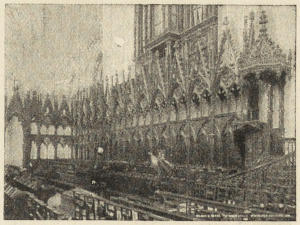
STALLS.
Of the Transitional period of our architecture, 1145 to 1190, only two traces seem to remain at Winchester. One is the doorway below the triforium-bay mentioned above. Its zigzag ornament is of Norman character, but the obtusely pointed arch shows that it is subsequent, yet not much subsequent to 1145. This doorway, with its queer fluted pilasters, may have been built by Henry de Blois (1129-1171) when he walled off this western aisle to serve as a treasury. If so, it is the only trace in the structure of this, the greatest of all Winchester’s bishops. The other is the font.
Chapel of the Holy Sepulchre.—Now we return to the north transept, which is cut off from the choir by a massive stone wall, the object being to keep the pilgrims out of the choir, and, perhaps, to support organs. At the end of the twelfth century a curious chapel was built on to this wall: it contains frescoes representing the Passion of our Lord.
Retro-Choir.—Traversing the north choir-aisle, we reach the largest retro-choir in England; it consists of three bays, with an east end originally consisting of three chapels all of the same length. The central chapel was elongated in the fifteenth century. This retro-choir was built by Bishop Godfrey de Lucy, between 1189 and 1204, and therefore, with the Chapel of the Holy Sepulchre, is the earliest Gothic work in the cathedral, and but few years later than St. Hugh’s work at Lincoln. De Lucy’s work is not very ambitious, nor very rich, nor artistically on a plane with the early English work at Lincoln, Beverley, and Ely. The great defect is that, in relation to its area, it is so miserably low. To get it high, the architect would have had to sacrifice the east windows of the clerestory of the choir; and this he was not allowed to do. The retro-choir was serviceable in providing room for processions round the high altar, and space for shrines, and in giving additional chapels and altars. Probably, also, the reversion to the favourite square east-end of English church architecture was popular in itself. Almost every Norman cathedral ended in an apse; and in the apse, high raised behind the high altar, sat the Norman bishop, facing the congregation; the hateful symbol of Norman domination. The destruction of the Norman apse may well, then, have been popular. The best part of the design is seen in the southern wall of the Lady chapel, and in the charming vaulted staircases which lead out of the side chapels to the roofs of the retro-choir and choir, and to the clerestory of the choir, from which a good view of the interior and of the interesting vault and glass of the choir is obtained. At the north-east corner of the retro-choir is an effigy in a vesica: it[267] commemorates Bishop Ethelmar or Aymer, whose heart was buried at Winchester in 1261.
The Stalls.—These are in the Geometrical style (1245-1315), and were executed about the middle of the period. “The beauty and variety of the carvings are wonderful. There is no repetition; and the grace and elegance, as well as the fidelity, with which the foliage is represented, are nowhere to be surpassed. The human heads are full of expression; and the monkeys and other animals sporting among the branches have all the same exquisite finish. Here are also interesting misereres” (Murray).
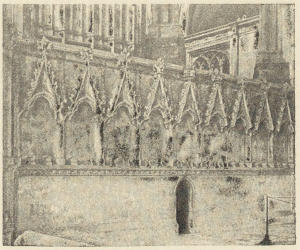
FERETORY.
The Presbytery.—The space between the central tower and retro-choir was occupied by the Norman choir, less its apse, up to about 1320, when this choir was pulled down and the present pier-arcade was built, with the clerestory; which latter, however, received new window-tracery in the sixteenth century. To the same period, the Curvilinear, but a little later, belongs the exquisite series of nine tabernacles in the retro-choir, on the wall at the back of the feretory; the naturalistic foliage of which is perhaps the best work in the cathedral. Below is an original entrance to the crypt, now called the “Holy Hole.” Above it accordingly is the inscription:
The Nave.—We now pass into the south aisle of the nave. The nave is of exceptional interest, for three reasons. In the first place, for its vast length of 12 bays of 250 feet. Norwich has 14 bays of 230 feet. Secondly, because, after the work at Gloucester, it is the earliest work we possess in the Perpendicular style. Thirdly, because its Perpendicular vesture is little more than skin deep, the solid core of every pier and every wall, from pavement to roof, being Norman. It is just this combination of the massive solidity of Romanesque with the grace and elegance of Gothic which makes it what it is, the finest nave in the country. The walls are Norman; built, in Norman fashion, of rather small and square blocks; they are thick, nearly 10 feet thick at the top; outside the south aisle may still be seen the flat Norman buttresses; hidden behind the balustrade of the clerestory are the upper arches of the Norman triforium, one of which we saw in the south transept. The vault rests on the original Norman vaulting-shafts, though they are stopped by Perpendicular capitals. They are not really stopped, however; for when we mount up to the back of the vault we find the vaulting-shaft, piercing through the vault, rising to the very top of the wall, to support, as they once supported, a wooden ceiling like that of Peterborough. Near the eastern end of the south aisle the lower part of a Norman shaft has been left; probably because it was covered up by some later shrine or altar. Crossing the nave, still clearer evidence of the character of the early work is to be seen in the second and third piers from the east of the north arcade. These were covered up by a great rood-screen, now destroyed.
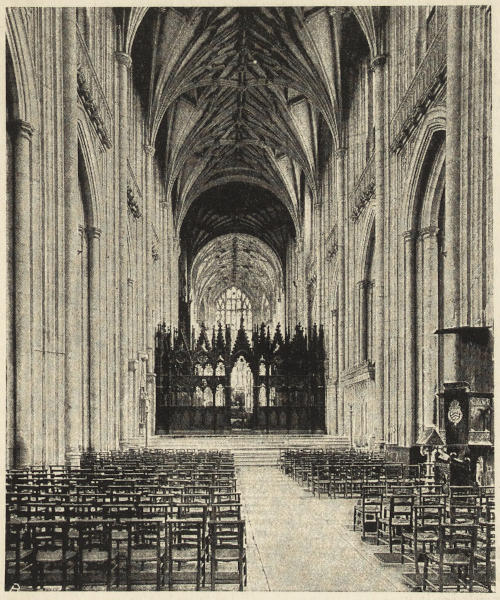
NAVE.
Putting this evidence together, it is plain that we have here a Norman nave transmogrified—Norman in core, but with a Perpendicular casing. This casing, however, is not merely skin-deep, as in Gloucester choir, where the Norman work can be seen at the back of the Perpendicular screens and panelling. The casing at Winchester goes at least one stone deep into the piers. But it was not executed all in the same way.[269] Bishop William of Wykeham’s work, in the seven western piers of the southern arcade, has the new mouldings cut in the original Norman stones. But in the rest of the piers it was found simpler and cheaper to withdraw the Norman stones one by one, and replace them with new stones with Perpendicular mouldings cut on them. The small Norman windows, of course, were destroyed altogether, and replaced by short and broad windows by Bishop Edingdon, probably about 1360,[270] perhaps under the superintendence of William of Wykeham, who was his secretary, in the extreme west of the nave; and by taller and more graceful windows in the later work of William of Wykeham and his successors. The mouldings of all this Perpendicular work are rather large and coarse; but we must remember that the architect was restricted at first to such mouldings as could be developed out of the Norman detail, and in any case they had to be in harmony with the big and heavy Norman vaulting-shafts which were retained unaltered in the Perpendicular design. About the same time forty feet of the western bays was pulled down. Edingdon’s work in the nave may be distinguished by the broad windows, two in the north and one in the south aisle; and by the cusps in the panelling, which in Edingdon’s work are foliated, and in the later work are left plain. In the new design the internal elevation consists of two parts—a tall pier-arcade, and a clerestory with a balustrade in front of the lower part of it.
How low the original Norman pier-arcade was, is shown by the Norman capitals which are left in the eastern piers of the northern arcade. The Norman triforium was exceptionally large. Its floor was on a level with the capitals of the new arches, and it reached up to the sill of the present clerestory windows. A glance round the corner into the transepts will make this clear. Again, the Norman nave had a flat wooden ceiling like that of Peterborough; this was replaced by a magnificent lierne vault of stone, completed by Wykeham’s successors, as is shown by the arms of Cardinal Beaufort and Bishop William of Waynflete on the bosses of the vault and in the string-course under the triforium. Magnificent as this vault is, it was no improvement to break the free flow of the diagonal and ridge-ribs by the insertion of these little liernes or tie-ribs. The earlier vault of Exeter is massive enough and quite sufficiently complicated without them. In the aisles the liernes are grouped into simple hexagonal or “stellar” patterns. The vault of the nave is often said to be unsupported by flying buttresses. They are there, however, between the[271] vault and the outer roof of the aisles, sheltered from the weather, as are the Norman flying-buttresses of Durham and Gloucester.
Such are the chief features of this, the finest cathedral-nave we possess, the work of Edingdon, Wykeham, Beaufort and Waynflete. We shall hardly be wrong in attributing the inception of this great transformation to Wykeham, whether as Edingdon’s secretary or as his successor to the bishopric.
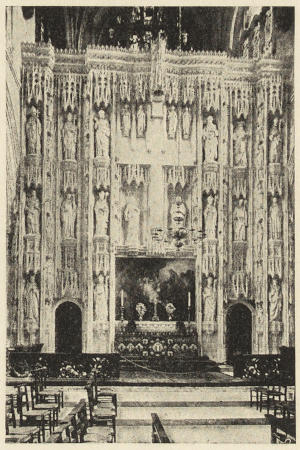
REREDOS.
We must not, however, overrate, as is often done, the novelty of the proceeding. For an even greater transformation had been wrought at Exeter before this, between 1280 and 1307, by Bishops Quivil and Bitton, who transformed the Transitional Norman choir of Bishop Marshall into the style of their day. From Exeter Wykeham borrowed the idea of the transformation, from Gloucester the style in which the transformation was effected.
From the west door there is a superb view eastwards. The grandeur of the interior of the cathedral is much enhanced by the raising of the choir. This raising of the choir is due, however, to no æsthetic preferences on the part of the architects, nor to any wish to emphasise the importance of[272] the clergy, but simply to the fact that there is a substructure below the choir. Here, as at Canterbury and York, it is a crypt. At Wimborne minster, Hythe church, and Hereford cathedral, it seems to be no more than a processional path, or else a charnel-house. Imposing, however, as this vista is, it is not so long as it might be, and it appears shorter than it really is. In the first place, out of the whole internal length of 526 feet, only 338 feet come into the vista. This is because De Lucy kept his retro-choir so low. Far nobler would have been the interior of Winchester, if, as at Ely, York, and Lincoln, retro-choir and eastern chapels had been kept as high as presbytery and nave. Indeed, the Winchester vista of 338 feet is surpassed even by that of the small cathedral of Lichfield, 371 feet. Secondly, owing to the destruction of screens, the apparent length has been greatly diminished. Formerly there were two solid screens: a rood-screen in the nave, three bays east of the tower; and a choir-screen. Thirdly, as at St. Paul’s, the great wall of the reredos is far too lofty, and is placed much too close to the east end of the presbytery, shearing off another 20 feet of the apparent length of the interior. This reredos, indeed, beautiful as its detail must have been, is a vast mediæval blunder—i.e. from an artistic point of view; which point of view, to tell the truth, the mediæval architects cared little about in comparison with the religious purposes which they wished their architecture to subserve. Still here, as at St. Saviour’s, Southwark, one cannot help wishing the reredos away; one would like to see once more behind and above the high altar, on their lofty platform, the shrines of St. Swithun and St. Birinus, and on either side of them such delightful peeps as one has at Wells into retro-choir and eastern chapels. Beaufort’s reredos has much to answer for.
In the south arcade of the nave are the two earliest of the magnificent series of chantries which are the especial glory of Winchester. They should be examined in chronological order. They are those of the following bishops: Edingdon,[273] died 1366; Wykeham, died 1404; Beaufort, died 1447; Waynflete, died 1486; Fox, died 1528; Gardiner, died 1555. Thus they form a continuous record of the growth and development of Perpendicular and Tudor architecture from 1366 to 1555.
IX. Later Perpendicular and Tudor Work.—As we have seen, the great transformation of the nave was not completed till the episcopate of Waynflete (1447-1486), having occupied not less than a century. After a short breathing-space, Bishop Fox (1500-1528) set to work to transform the presbytery; and I have little doubt that every trace of early work would have been swept away from the transepts as well, had not building operations at Winchester been brought to a stop by the Reformation. As we saw above the piers, arches and clerestory of the presbytery had been rebuilt early in the fourteenth century. These Curvilinear windows having probably got out of repair, he replaced the tracery of the clerestory windows on each side of the presbytery, and also the great clerestory window to the east, by Perpendicular tracery. Five of these windows have original glass. A second task was to rebuild the aisles of the presbytery, which, till now, had remained Norman. A third was to ceil the presbytery with a lierne vault. This is a paltry makeshift in wood. The emblems of the Passion, however, carved on the bosses, are of much interest, and should be inspected from the gallery. Fourthly, Fox built his own chantry. Indeed, most of the chantries were built during the bishops’ lifetimes. Fifthly, he erected Tudor screens of stone between the presbytery and his new aisles. These Gothic screens were plainly wrought by English workmen. Just as plainly, the pretty Renaissance frieze which surmounts them was wrought by workmen imported from Italy. Sixthly, he constructed the Renaissance chests which stand on the screen. Bishop Henry de Blois (1129-1171) had collected from the crypt, perhaps now damp, the bones of saints and kings buried there, and had transferred[274] them, cased in lead, to the presbytery. These sacred relics Fox placed in the present six chests. To this period also belongs the Renaissance woodwork now placed in the south transept.
One more structural change had taken place previously. Bishop Courtenay (1486-1492) had lengthened the Lady chapel and the crypt.
To the early years of the sixteenth century belongs the rich work in Bishop Langton’s chapel, and in the chapels of the south transept, and the pulpit in the choir.
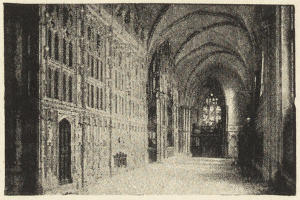
FOX’S CHANTRY.
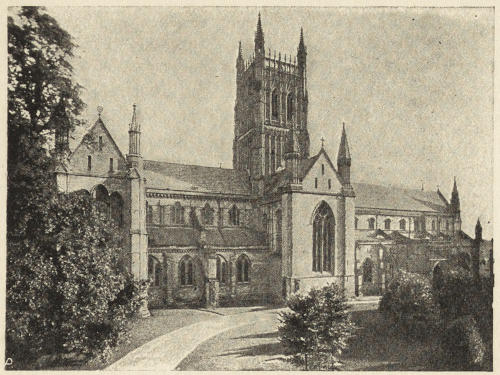
FROM NORTH.
As is indicated by the form of dedication of 1218, “The cathedral church of the Blessed Virgin and Saint Peter and of the Holy Confessors Oswald and Wulfstan,” Worcester, is one of the pre-Conquest cathedrals. With Hereford, Leicester, and Lindsey, it was carved out of the immense see of Lichfield, which was coextensive with the kingdom of Mercia, by Archbishop Theodore of Canterbury towards the end of the seventh century. Through the influence of Dunstan, who was Bishop of Worcester from 957 to 961, its secular canons were replaced by Benedictine monks by his successor, St. Oswald; and the cathedral was served by monks till the time of Henry VIII., when it was put upon the new foundation and reverted to secular canons. In 1062 St. Wulfstan became bishop. From his “great piety and dovelike simplicity” of character, he had great influence[276] in the English Church, and was allowed by the Conqueror to retain his bishopric. He repaid William by beating off Robert Courthose, Duke of Normandy, when he attacked Worcester, and retained the see till his death, at a great age, in 1095. In the year 1201 miracles commenced at his tomb, “from fifteen to sixteen per diem being cured from every kind of sickness.” In 1203 he was canonised. The shrines of St. Wulfstan and St. Oswald stood on either side of the high altar, like those of St. Dunstan and St. Elfege at Canterbury,—in front of it, not at the back, as at Winchester, St. Albans, and elsewhere.
St. Oswald, late in the tenth century, had rebuilt the cathedral in the style of his day. Of this Anglo-Saxon cathedral nothing is left, unless it be the balusters in the arcade of the slype. This work of the holy Oswald Wulfstan now pulled down, with many searchings of heart. Almost he repented of his purpose. Long he stood silent in the churchyard, deeply groaning. At last he burst into a flood of tears. “We wretches,” said he, “pompously imagining that we do better work, destroy what the saints have wrought.” Many centuries have passed since Wulfstan’s day, and there have been many “restorations” of Worcester cathedral, but there is no record that any one but Wulfstan commenced his work with tears and groans. Our modern “restorers” enter on their work with light hearts. Rather one would venture to suggest that when a restoration is resolved on, dean and chapter and eminent architect should betake themselves in sad procession to the cathedral, intoning penitential psalms with humble and contrite hearts, observing the day as a day of humiliation.
Wulfstan commenced the new cathedral in the new Anglo-Norman style in 1084, and the monks entered four years later. This, of course, does not imply that the whole cathedral was finished; but only so much of the eastern limb as was sufficient for the daily services; and even this probably not carried higher than the triforium, and provided merely with a temporary roof[277] Many fragments of the lower part of the walls and piers of Wulfstan’s church remain above ground, showing that it was coextensive with the present nave and transepts.
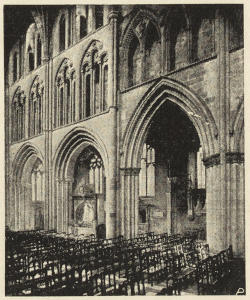
NAVE, NORTH SIDE.
Wulfstan’s crypt is almost wholly intact, and enables us to restore the plan of the eastern limb. This consisted of an apse surrounded by an ambulatory, and extended as far as the centre of the present eastern transept. On either side of the choir-aisles apsidal chapels projected eastward from the Norman transept. It is possible that this may explain the curious Norman building on the north side of the choir of Ripon. To simplify the vaulting problem, by making the compartments as small as possible, the crypt was divided into more than a hundred compartments. Owing to the curve of the apse many of the compartments are not square; yet the difficulty of vaulting triangles and trapeziums was successfully overcome, even at this early date. When nearly all the other traditions of Roman methods of construction had been lost, the architects of mediæval Christendom still retained in their crypts the traditions of Roman vaulting. Even the Anglo-Saxon crypt of the village church of Wing has stone vaulting. In the ante-room of the library are preserved the north doors of the cathedral (fourteenth century), under one of the hinges of which are authentic fragments of the skin of some poor wretch flayed alive for sacrilege. The slype, the[278] undercroft of the refectory, and the south-east entrance near it, also belong to Wulfstan’s work.
To the early part of the twelfth century belongs the circular chapter-house. Most monastic chapter-houses were constructed in a rectangular form, which best fitted on to the side of a cloister. But the cathedrals of secular canons, when they had chapter-houses, followed the Worcester precedent, except that they were built polygonal instead of circular. Such was the beauty, however, of the new form, that the monastic houses also, in later times, themselves frequently adopted the polygonal form, as at Westminster, Evesham, Belvoir (Benedictine); Margam and Abbey Dore (Cistercian); Alnwick, Cockersand, Thornton, Carlisle, Bridlington, Bolton (Canons Regular). Usually the polygonal chapter-house had a central pier; but it was dispensed with at York and Southwell. The polygonal chapter-house never appears in France; it is one of the most beautiful features in English Gothic.
In the twelfth century, about 1160, some weakness seems to have shown itself in or near the west front, and the two western bays of the nave were rebuilt in the style of the day. In the importance given to the triforium, in the semicircular arches which occur in triforium and clerestory, and in the use of the chevron ornament, the work is still Romanesque. But pointed arches also occur both in triforium and clerestory; while the ground-story, with the exception of the square abacus, is purely Gothic. The clustered piers, the rich vaulting-shafts, and well-moulded arches, together with the square abacus, all remind one of the work at Wells (1171-1191); the foliage of the capitals, however, is less advanced.
At length the turning-point was reached in the fortunes of Worcester. The body of St. Wulfstan, after lying dormant for more than a century, began to work miracles. Pilgrims came in crowds. It was the age of pilgrimages. Even King John came with offerings; and his body was brought here for burial. With the pilgrims came the need for more accommodation in the eastern limb of the church, and from the[279] pilgrims came the money to provide it. Winchester choir was not long enough to provide for the crowds who resorted to the shrine of St. Swithun, the Healer; Rochester had turned a Scotch baker into St. William of Perth, and had to provide eastward extensions; Ely had to rebuild its presbytery to give room to the votaries who came from all East Anglia to venerate St. Ethelreda; Durham erected the Chapel of the Nine Altars to accommodate those who flocked from all northern England to the shrine of St. Cuthbert; Canterbury crypt—spacious as it was—was too strait for the pilgrims who came from all over Christendom to worship the relics of its murdered archbishop; both Lincoln and St. Alban’s were crowded out, and later in the century were to build eastward in honour of St. Hugh and St. Alban. St. Wulfstan, being the newest saint, was for a time exceedingly popular.
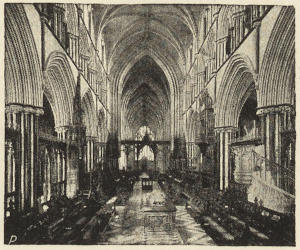
CHOIR, LOOKING WEST.
Miracles had commenced at Worcester in 1201; about 1204 the reconstruction of the eastern limb had commenced; and within the next forty years the old Norman choir had disappeared, and the present eastern arm was finished. In plan it is a sort of combination of the earlier eastern extensions at Hereford and Winchester. As at Hereford, a small eastern transept was provided, and a shallow Lady chapel; but the space between the eastern transept and the Lady chapel was three bays each way, as in De Lucy’s work at Winchester. The apsidal chapels of the Norman transept were also pulled down, that of the south transept being replaced by an early Gothic chapel. The efficacy of the saint[280] and the liberality of the pilgrims are shown not only in the scale of the new work, but in the wealth of detail. Especially beautiful was the arcading round the walls. Perhaps the only work to compare with the choir of Worcester is the presbytery of Ely; but in the proportions of its members the Ely elevation has the best of it. The Worcester architect followed the proportions of the two Transitional bays at the far end of the nave; and thus, as compared with Ely, the pier-arcade is too stumpy and the triforium too large. The crypt of Wulfstan’s church, as we have seen, only extended as far as the new eastern transept. To get the work east of the new transept on the same level as the rest, the builders would have had to extend the crypt eastward. Crypts, however, had gone out of fashion with the ritualistic need of them; therefore the builder very sensibly built the eastern part of the choir on the level, not of the western bays of the choir, but of the nave. But he has been credited with æsthetic reasons for the course he adopted. A fine effigy of William de Blois, who commenced this thirteenth-century choir, lies on his tomb in front of the Lady chapel.
What happened to the nave between 1245 and 1317 is not known. There is no work in the cathedral of that date. But between 1317 and 1327 Bishop Cobham commenced the reconstruction of the north side of the nave. It is therefore Curvilinear work. It is not, however, typical work of the period. With that tenderness for older design which one sees at Ely, St. Alban’s, Beverley and Westminster, the architect has suppressed his individual preferences, and designed his work so as to be a nice transition from the twelfth-century bays near the west front to the thirteenth-century bays of the choir; so his piers and his clerestory are a Curvilinear version of the work immediately to the west of him, while his triforium is a repeat of that of the choir. But before the new work on the north side was joined up to the Transitional bays of the nave money seems to have become scarce at Worcester. Pilgrims had begun to desert St. Wulfstan for newer if not holier[281] saints. Hitherto St. Wulfstan had had a monopoly in the West-country. There was not another saint of equal efficacy till you reached Winchester. But in 1287 Bishop Cantilupe began to bring the dead to life at Hereford; and in 1327 Edward II. was buried at Gloucester, and miracles soon followed there also. So Worcester now had rival miracle-workers on either side. The result was that it was found impossible to finish the Curvilinear work, although the pier-arcade was complete all along the north side of the nave, and there only remained to build two bays of the triforium and clerestory.
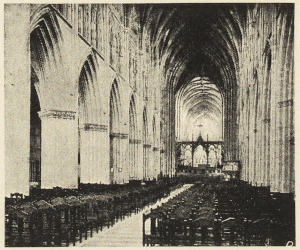
NAVE, LOOKING EAST.
Building operations seem to have halted for some thirty years; and when they were resumed, c. 1360, the completion of the north side and the rebuilding of the south side of the nave were carried out in a balder and more economical way. All this Perpendicular work, including the completion of the new tower, seems to have been completed before the end of the fourteenth century. About the same time the great transept was vaulted and panelled, somewhat after the fashion of the Gloucester work. The transept is a tangle of early Norman, late Norman, Transitional, Curvilinear, and Perpendicular work. Evidently there are breaks and lacunæ in the architectural record of Worcester which we have no materials for filling up. In the fifteenth century the monks seem to have rebuilt their cloister.
A late and interesting bit of design is to be seen in the chantry of Prince Arthur, elder brother of Henry VIII., who[282] died in Ludlow castle in 1486. The flat roof, with its fan-vault, skeleton ribs and pendant, is an anticipation of the vaulting of his father’s chapel in Westminster Abbey.
Externally the cathedral is wholly nineteenth-century work: decay of the stone had rendered recasing unavoidable. Within, much of what pretends to be thirteenth-century detail is really work of the nineteenth century, commonplace in design, coarse in execution; some of it by Perkins, some by Scott; everything is shiny and new; nothing has ever been done so bad as the “restoration” of Worcester choir and presbytery.
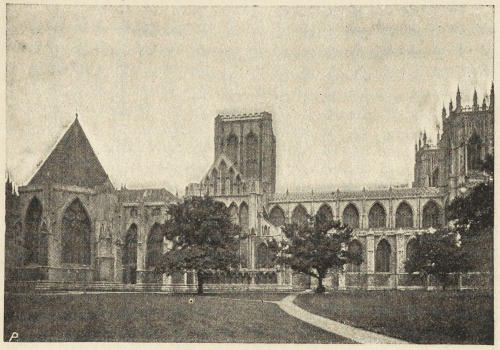
FROM NORTH.
I.
York Minster has had many predecessors—Romano-British, Saxon, Norman and Transitional cathedrals. From the two first periods nothing survives, unless it be two walls in herring-bone masonry in the crypt. Little remains of Norman work except in the western portion of the crypt. In the centre of the crypt are fine fragments of the Transitional choir of Archbishop Roger, whose work is seen at Ripon. The present cathedral is mainly of three periods. The great transept was designed in the Lancet period; the nave, chapter-house and vestibule were built in the latter part of the Geometrical period; the retro-choir, choir and towers are Perpendicular. But though the work is of three periods, it is practically of only two designs, the choir and retro-choir being only a Perpendicular version of the design of the nave.
II. As at Lichfield and Wells, the canons of York in the end[284] left not a fragment of the earlier work visible above ground. They must have had vast resources at their disposal, in addition to what they received in offerings at the shrine of the local saint, St. William of York. He died in 1154; he was canonised in 1227. It was about this latter date that the rebuilding of the cathedral commenced; and it is not unreasonable to believe that the offerings from his shrine had something to do with the vastness of scale on which the new work was planned; the new transept being not only exceptional both in height and breadth, but also in having aisles on the western as well as on the eastern side—an extravagance unknown in our Gothic cathedrals, except at Wells. It is amusing to find the double-aisled transept in the sub-cathedral of Beverley Minster. There seems to have been an internecine rivalry between the canons of Beverley and York. Both churches have double aisles to the central transepts; both continue in full height to the east end; both have western towers; and though Beverley has no central tower, it has by compensation an aisled eastern transept, where York has but transeptal bays. Moreover, the high vaults of Beverley are of stone. In beauty of proportions and of detail—in everything but scale—Beverley has much the best of it.
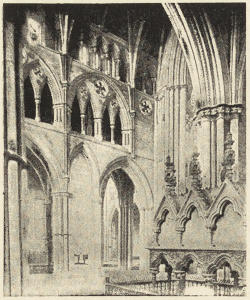
SOUTH TRANSEPT.
The south transept was built 1230-1241, the north transept 1241-1260. The façade of the south transept is confused and commonplace, overloaded with ornament, and cut up too[285] much with windows; that of the north transept—with the Five Sisters—is of noble simplicity. In the south transept is the beautiful monument of Archbishop Gray (1215-1255), the builder also of Ripon west front and Southwell choir. “The view which is presented to the visitor on entering this transept is without doubt the finest in the cathedral. The magnificent spaciousness of the transept, the majesty of the lofty lancets which nearly fill the north gable, the solemn light struggling through their ancient diapered glass, the great central tower with its unrivalled lantern, combine to produce an impression fully sustaining the great reputation of the minster.” In proportions the design of the transept is not a success; the elevation dwindles away upward, the triforium being made far too large at the expense of the clerestory. In itself the triforium is a very fine composition, only there is not room for it, nor is it in harmony either with the pier-arcade below or the clerestory above. It is the largest and most complex triforium in the country; consisting of two pairs of acute lancets below, set under two acute lancet arches, which again are set under an outer arch almost semicircular. This was the last big triforium built in England (save the exceptional one in Ely choir). There had always been a feeling in favour of the diminution of the triforium. Even in the twelfth-century naves of Tewkesbury and Gloucester the triforium had been cut down to very small proportions; in Beverley choir the triforium is greatly attenuated; and very soon afterwards the triforium was[286] to be seen nearing extinction in Exeter choir and in the nave of York itself.

SOUTH TRANSEPT.
III. At this period (c. 1260) we must think of York Minster as possessing the present spacious transept, a Transitional choir of the character of that of Ripon, and a Norman nave. When the work of rebuilding was resumed, the Transitional choir—which must have been spacious and convenient—was spared once more, and the canons proceeded to take down and rebuild the Norman nave, laying the foundation stone in 1291, and beginning at the south-east. The new nave is so exceedingly broad and lofty that it is probable that it was built round and over the top of the old Norman nave. The money came from “indulgences, penances, briefs, bequests, and offerings at the shrine of St. William.” The nave, like the whole minster, is exceedingly impressive in the vastness of its spaces: no building of such dimensions could fail to be impressive. Its proportions, however, are not good. The broadest cathedral nave in England (its span is 45 feet), and the loftiest (it is nearly 100 feet high), it ought to be one of the longest, which it is not: it is even shorter than the transept. Matters are made worse, as in Lincoln nave, by the wide spacing of the piers, the result of which is greatly to reduce the apparent length of the nave. It contains only eight bays. Had it been divided into ten or more bays, it would have looked far longer. It was designed not so much on architectural lines as a glass-house. The canons wanted the greatest possible breadths of stained glass in aisles and clerestory. The error was seen and corrected in the choir, which, though no longer than the nave, has nine bays instead of eight. It is possible that nothing but want of funds prevented the canons from continuing the nave farther westward. The exceptional height and breadth of the nave made it very costly; and the funds plainly ran short, for, though begun in 1291, it was not roofed till 1360. To make matters worse, the canons were building a new chapter-house and vestibule at the same time as the nave: so that funds may well have[287] failed. Nevertheless, at Ely, equally large works were completed before 1360, though they were not commenced till 1321, and were executed with much greater richness of detail than in York.
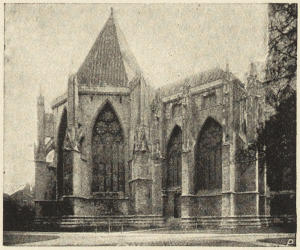
CHAPTER-HOUSE
Another feature which shows that the York canons had started their work without considering whether they would be able to finish it is the omission of a stone vault, which was plainly contemplated at the outset; the pinnacles built for the purpose of weighting the buttresses against the thrusts of a stone vault still existing on the south side. When the north side was built, the canons had abandoned hope of vaulting the nave in stone, and so did not put up big pinnacles. It is well to remember, however, that the exterior of the nave was designed originally to have flying-buttresses and big pinnacles on both sides. In the end, as in Selby choir, a sham vault of wood was put up. One cannot help regretting these shams. It would have been Gothic to recognise honestly that the ceiling was wood, and to design it in wood and not in lithic fashion. Then we might have seen an English Gothic cathedral with such a hammer-beam roof as that of Westminster Hall: very magnificent it would have been.
Side by side with the nave went up the chapter-house. It belongs to the middle of the Geometrical period, c. 1300; later in character than its sister at Southwell, and but little earlier than the chapter-house of Wells. Externally, it is[288] provided with buttresses and pinnacles and flying-buttresses and flying bridges to resist the thrusts of a stone vault. Yet no stone vault is there, but another sham vault of wood. The detail of the chapter-house, inside and outside, is of exquisite beauty.
At first the chapter-house was a detached building, but a vestibule was soon added. Parapet-mouldings of the chapter-house may now be seen inside the vestibule.
A very curious and bold specimen of mediæval engineering may now be mentioned. If the western bays of the great transept next to the central tower be examined, it will be seen that in the clerestory and in the triforium these bays are exceedingly narrow, but that in the ground-story the narrow arch corresponding to the narrow bays of the triforium and clerestory has been moved, and a wider arch substituted. The fact is, when the transept was completed, the Norman nave, which was still standing, had a very narrow aisle. Consequently the builders of the transept built a pair of narrow arches, on either side of the central tower, leading from the transept into the Norman aisle. Later on, as we have seen, the Norman nave and aisles were pulled down, and the present nave was built. Its aisles are exceptionally broad. The result was that the piers of the two narrow arches found themselves in the very middle of the new broad aisles of the nave—a most awkward obstruction to processions passing from aisle to transept, or vice-versa. So the triforium and clerestory was underpinned, the Lancet piers next to the tower were taken down and then put up again clear of the aisles, and the two arches also on either side of the tower were taken down and rebuilt with the same stones, each in the place of the other. The result is that, counting from the end-walls of the transepts, in the triforium and clerestory there are three of the bays wide and one narrow, while in the ground-story there are two wide, one narrow, and one wide bay. Similar changes took place on the eastern side of the transept when the choir was built.
Later on, when the central tower was built, its great weight[289] sank the piers on which it rests eight inches into the ground, and the adjoining masonry was dislocated. The result was that it was found necessary to rebuild the third piers on both sides of both transepts (counting from the end-walls) as well as the first pier on the western side of the north transept, and at the same time to block up all the four narrow arches with solid masonry (cf. Carlisle, and Exeter).
IV. The west front of the nave was not finished till the very end of the Curvilinear period, to which period belong also the treasury and sacristy, and also Archbishop Zouch’s chapel, unless the latter was rebuilt c. 1396.
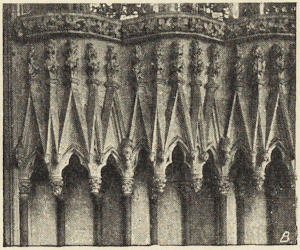
CHAPTER-HOUSE ARCADE.
V. Immediately that the nave was roofed in, the canons commenced to rebuild the eastern limb. Meanwhile architectural fashions had changed. While the York people were lingering over their Geometrical nave, a whole architectural period had passed away, leaving behind few traces at York except in the west front. When the new choir was commenced in 1361, the Curvilinear style had disappeared before the new Perpendicular style, invented at Gloucester and taken up by Bishop Edingdon at Winchester. The style, however, was still new, and though the Winchester work is purely Perpendicular, the York design still retains in the window tracery reminiscences of the flow of curve that Edingdon and Wykeham had replaced by grilles of horizontal and vertical bars.
Only the eastern part of Archbishop Roger’s Transitional work was at first pulled down, the services going on without interruption in the western bays. The four new eastern bays—designed as a retro-choir, the altar standing originally one bay more to the west than at present—may be distinguished[290] at once externally by the unusual feature of having an external instead of an internal arcade to the clerestory; this gives a fine play of light and shadow.
Then the five western bays were built, two bays as sanctuary, three as choir. Owing to the continuation of the high roofs to the extreme east end of the cathedral, there is little of the picturesqueness of the eastern terminations of Wells and Salisbury, but there is spaciousness, dignity and majesty. Here also the canons had not the money—perhaps not the courage—to put up a high vault of stone. Nave, eastern limb, and transept (the vault of which is of the fifteenth century) were all vaulted in wood. The punishment was long in coming, but it came at last. The wooden vault of the choir, the stalls and the organ, were burnt down by a lunatic in 1829; and that of the nave by a plumber in 1840. The finest feature in the choir is the tall transeptal bays, suggested by and built on the foundations of Archbishop Roger’s flanking towers. The whole eastern limb was finished c. 1420. Then came the central tower, 1410-1433; the south-west tower, 1433-1447; the north-west tower, 1465-1474; the organ screen, 1475-1505.
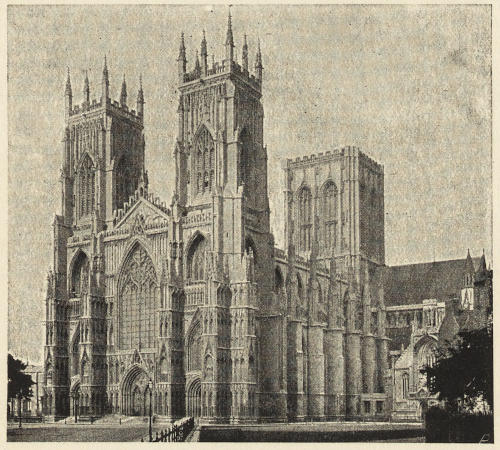
FROM SOUTH-WEST.
In 1472 the completion of the great works commenced c. 1230 was near at hand, and a solemn consecration of the rebuilt cathedral was held. The Norman and Transitional cathedral had disappeared; its successor occupied a century and a half in building.
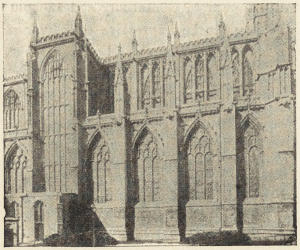
SOUTH CHOIR.
Externally, York Minster, from its vast dimensions and the fine composition of the towers, is exceedingly impressive. One realises its immensity best from the city walls, where it is seen “reflecting every change in the sky, and rising like a mountain above the parochial churches and houses of the city.” The treatment of the north side of the nave and transept is particularly grave and impressive—largely because of the absence of pinnacles. The west front, in spite of overloaded and confused ornament, is of its type the finest in the country; and to my mind the great west window, in the free and[291] fanciful flow of its intersecting ogee arches, surpasses its only rival, the east window of Carlisle. The central tower relies for effect on mass more than height, and thus contrasts strongly with the central towers of Canterbury and Lincoln. Gloucester tower alone seems to be impressive equally from height and bulk. Shorn of its pinnacles, however, York central tower has not fair play. Very beautiful, too, is the play of light and shade in the double plane of tracery in the eastern clerestory. And very characteristic is the east façade; it may be all wrong, with its strong emphasis of horizontal lines and concealment of the gable, but it has distinction; one never confuses the east end of York with that of any other cathedral—one never forgets it. The weakest point in York is what ought to be the source of the greatest beauty, the window-tracery.[292] Much of it, especially in the choir, is ugly in itself; even that of the great east window and of the windows in the transeptal bays is meagre and thin. But what is worse, this poor tracery is repeated with most wearisome iteration all over the flanks of the cathedral. Window after window of the nave, window after window of the choir, are monotonously alike. The imagination of the York people was singularly limited. What a contrast to the glorious series of windows of Exeter, contemporary with those of York nave!
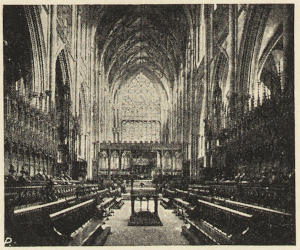
CHOIR, LOOKING EAST.
But it is not from its architecture that York holds its paramount place as an exponent of mediæval art, but because its ancient glass is almost all intact. For a detailed account of it the reader should refer to Mr. Benson’s handbook and to that of Dean Purey-Cust. I will conclude by describing it in Mrs. Van Rensselaer’s words, which are as true as they are eloquent. “Most English cathedrals have been entirely reduced to architectural bone and sinew; they lack decorative warmth and glow, life and colour, and the charm that lies in those myriad accessory things which the lingering faith of Rome has preserved in other lands. All the varied tools and trappings, altars, shrines, and symbolic trophies of the rich Catholic ritual have been banished; much of the furniture is gone, the walls are bare of paint, scores of monuments and chantries have been shattered to bits, thousands of sculptured ornaments and figures have been swept away in dust; a[293] painful cleanliness has replaced the time-stains which give tone to many Continental churches even when no actual colouring exists, and a glare of white light or hideous discord of modern hues fills the enormous windows. Columns and walls and floors are as barren at York as elsewhere; and although many tombs remain, without its glass it would seem even colder and emptier than most of its sisters, for it was built at a time when walls of glass had nearly replaced walls of stone. But it has its glass, and this means much more than that it has a richness of decorative effect which no other English church displays. It means that here alone we can really apprehend the effect of a late Gothic church, even from the architectural point of view. At York we can follow the development of the art of glass-painting through a period of fully four centuries. More delicate, clear and exquisite fields of simple colour can never have been wrought than those which fill the Five Sisters with their sea-green purity. The west window, glazed a century later (1338), is a gorgeous mosaic of ruddy and purple hues, shining in the intricate stone pattern which shows black against the light, like a million amethysts and rubies set in ebony lace. The multicoloured eastern window, and its two mates in the minor transept, seem vast and fair enough for the walls of the New Jerusalem. And wherever we look in the lightly constructed eastern limb, it seems, not as though walls had been pierced for windows, but as though radiant translucent screens—fragile, yet vital and well equal to their task—had been[294] used to build a church, and merely bound together with a network of solid stone. For the moment we feel that nothing is so beautiful as glass. After we have seen the glass of York, we never think again that stained glass was merely an adornment of Gothic architecture. The early Gothic architect demanded for his enlarged windows some filling which, as decoration, would take the place of the wide frescoes of former times, and which, from the constructional point of view, would justify to the eye that partial suppression of walls which he knew to be scientifically right. This filling the early glass-painter gave him; and it was so satisfying from the architectural standpoint, and so beautiful from the decorative, that he was ready and eager to carry on his architectural evolution to the farthest possible extreme. He felt that he could attenuate his constructional framework as far as the laws of gravity would permit, since the glazier stood ready to replace really solid wall-spaces by those which looked solid enough, and were more beautiful than any expanses of stone had ever been. No architect could have built as late Gothic architects did, if only white glass had been at his command. None would have made walls which are literally windows, unless strength[295] of colour had come forward to simulate strength of substance. A Perpendicular church was actually meant to look as the choir of York does look—like a great translucent tabernacle merely ribbed and braced with stone.” The very best glass, however, is of later date than that of the cathedral, and the visitor should round off his education in mediæval glass by inspecting the late Perpendicular glass in which the parish churches of York abound. There is a fine collection of fifteenth-century glass in St. Martin’s church, in Coney Street, near the interesting old Guildhall. Indeed, nowhere in England can stained glass be studied to such advantage as at York.
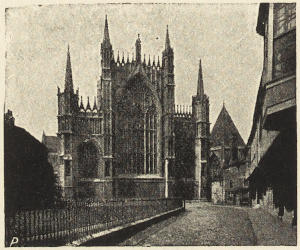
EAST END.
The following new dioceses have been formed during the present reign: Liverpool, Manchester, Newcastle, Ripon, St. Alban’s, Southwell, Truro, Wakefield. Of these Ripon Minster, St. Alban’s Abbey, and Southwell Minster have been described already. In only one diocese, Truro, has a new cathedral been commenced. The bishops of Liverpool, Manchester, Newcastle, and Wakefield, are housed in parish churches.
The see was founded in 1880. A fine design for a domical cathedral was prepared by Mr. Emerson in 1885, but the church of St. Peter remains the “provisional cathedral.”
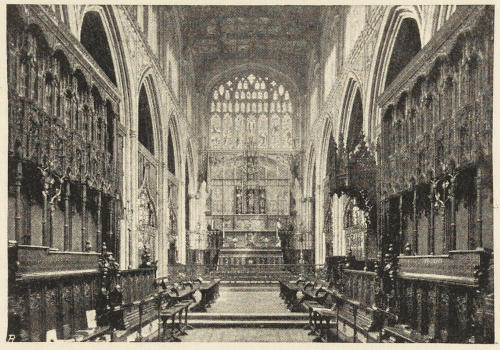
CHOIR, MANCHESTER CATHEDRAL.
The see was founded in 1847. Externally and internally the cathedral is but a magnified parish church. The single western tower, the absence of a central tower, the extraordinary breadth of the interior, the absence of a triforium, the wooden roofs, all stamp it with parochialism. Indeed, the nave and aisles are still the parish church of Manchester, the cathedral proper being confined to the choir and its aisles. Looked at as a parish church and a collegiate church—for from 1426 it was both—it is a magnificent specimen of late English Gothic, dating from 1426 to 1520, when the ambition of architects was to make of their churches “stone-lanterns.” In the same accidental way as Chichester cathedral it has become possessed of picturesque double aisles, by the incorporation on either side of sets of chantries. The south aisle of Dorchester priory church had a similar origin. It has been so thoroughly “renovated” that it is practically a modern church. But it is very impressive. There is no jarring of styles. And the colour effects, externally and internally, are superb. Its woodwork, too—rood-screen, choir-screens, tabernacled stalls, misereres, and roofs—is of great richness and fine design. The whole church in its fortuitous picturesqueness appeals to one much more than the icy regularity of such churches as St. Mary Redcliffe, Bristol, or Bath Abbey.
The see was founded in 1882. The church is Curvilinear work of the fourteenth century, to which a Perpendicular tower and spire, east window and font were added about 1450. The spire, with its pinnacle supported on converging flying buttresses, is a bold and effective composition. Spires of similar construction occur in the Cross Steeple, Glasgow,[298] and King’s College, Aberdeen, and formerly existed at Linlithgow and Haddington. London has a fine example by Sir Christopher Wren in St. Dunstan’s-in-the-East. There is a fine Jacobean monument, pulpit-shaped, to Henry Maddison, and another to William Hall.
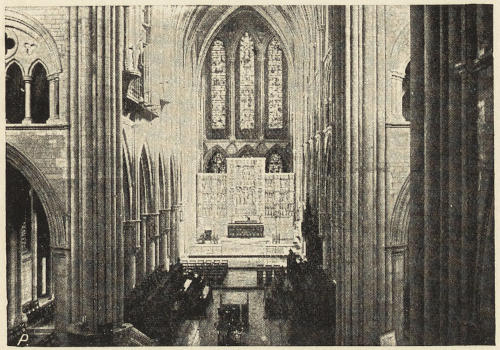
CHOIR.
Truro cathedral, consecrated in 1887, is the first entirely new cathedral designed in England since St. Paul’s. The nave, towers, spires, chapter-house, and cloister are still to build. In dimensions it ranks with Norwich and Wells; in plan it is as complex as any of the greater of our cathedrals. It is intended to have three towers and spires, a south porch, western porches, an aisled nave of nine bays, a central transept with eastern and western aisles and baptistery, a choir, sanctuary, and eastern processional aisle, a square east end, and an unaisled eastern transept, projecting slightly beyond the aisles. Below the choir is a crypt, appropriated to vestries. The crypt is supposed to be in the massive style of the latter years of the twelfth century. The choir is supposed to have been commenced in the early years of the thirteenth century; but since, as in the transepts of Salisbury, the aisle windows are lancets, while those of the clerestory have early plate-tracery, the upper part of the choir is supposed not to have been finished before the middle of the century. So again, in the half-century or so which is supposed to elapse between the commencement and the completion of the cathedral, the design is supposed to have been altered here and there as it passed through different hands; hence the rose-windows, which are unusually plentiful, are all different; the transept ends are differently treated; the arches of the choir are narrow, those of the nave are wide; the latter has coupled bays, the choir has not; the quadripartite vault of the choir becomes more complex in the nave, just as it does at Lincoln. And just as the Lincoln architect[299] dropped down fortuitous chapels at the west end of the nave, so Mr. Pearson purposely forgot to leave room for a baptistery, and tacked it on, in a carefully casual manner, to the south transept. The cloister, too, is to be three-sided and lop-sided, as at Chichester. Internally, the cathedral is picturesquely beautiful, and admirably adapted for the ritual of the Church of England as it was in the thirteenth century. The south side of the choir has the remarkable peculiarity of having three aisles; so has that of Oxford cathedral. But it got its three aisles in a different way from Oxford. Mr. Pearson was instructed to leave standing a piece of genuine mediæval work, late and good—viz., the south aisle of the old church of St. Mary’s. The cathedral was placed to the north of it, just so far off as to barely admit the buttresses supporting the flying-buttresses of the choir vault. These buttresses Mr. Pearson pierced with arches, and, roofing over the space from buttress to buttress, got a narrow intermediate aisle between the choir-aisle to the north and St. Mary’s aisle to the south. Thus on the south side of the choir there are[300] three ranges of piers and three ranges of arches, and the changing vistas and perspectives and mysterious distances are delightful. In this instance the architect was mediæval in spirit as well as in the letter.
The see was founded in 1888. Like Manchester cathedral, the church is thoroughly parochial in appearance, inside and outside. But, archæologically, it is of exceptional interest. It is one of those numerous churches, every stone of the exterior of which is of late Gothic date, but which internally in their arcades reveal the existence of much earlier building epochs. Like many others, though now a vast parallelogram, it was once a cruciform church in plan; and though now it has a western tower, its tower once stood above the crossing. Once its nave was aisleless; then it had narrow aisles; later on, these narrow aisles were replaced by broad ones. The piers and arches of the first aisles were low; afterwards they were heightened or rebuilt. Originally it had no clerestory; this was not added till the fifteenth century. When the central tower fell, the new tower was built ten feet west of the nave, so as not to interfere with the services. When it was finished, it was joined up to the nave by the addition of a new westernmost bay. The Norman chancel and its successor were short, and had neither aisles nor clerestory; the present chancel, the third, is long, having absorbed the space originally covered by the central tower; and it has a clerestory and aisles, and these have absorbed the transepts. Finally, the font, choir-screen, and sounding-board are Jacobean. Wakefield cathedral is a typical embodiment of the history of the Church of England, with a personal identity undestroyed by its many transformations, like the boy’s knife which had a new blade and a new handle, but was still the same old knife.

BANGOR, FROM SOUTH.
The work at Bangor falls into four periods.
I. Originally the cathedral was a small Norman church, probably without aisles, with nave, transept, choir of one bay, and apse. Of this building nothing is visible except a buttress and window on the south side of the choir. It seems to have received great damage in 1247.
II. Between 1267 and 1305 the cathedral was practically rebuilt by Bishop Anian. The Norman apse was demolished, and the choir was extended two bays farther to the east, and ended square. The transepts also were lengthened half a bay each. A chapel was added to the north of the choir; and aisles, either now or not much later, to the nave.
III. In 1402 the cathedral was burnt by Owen Glendower. Between 1500 and 1532 Bishops Dene and Skevynton rebuilt the eastern part of the presbytery, the nave arcade and the clerestory above it, the two windows on the south side of the[302] choir—set high because the lower part of the wall was blocked with the stall-work—the western tower, and the stump of a central tower.
IV. In the restoration of 1866 many fragments of Anian’s cathedral were found in the walls, and were used up by Sir G. G. Scott in rebuilding the transept after what he imagined to be Anian’s design. The choir-chapel was also rebuilt as organ-chamber, library and chapter-house. The aisles also, and the central tower, were almost wholly rebuilt.
Llandaff, though practically but a suburb of the busy town of Cardiff, still remains picturesquely environed by woods and meadows and hills and the Taff. Externally it adds one more to the endless varieties of English cathedral architecture. No central tower is here, and the position of transepts is inadequately occupied by the chapter-house on the southern side. One unbroken roof, as at Dorchester abbey church, extends for the whole length of the cathedral, the Lady chapel excepted. Its west front, indeed, is cathedral-like, now that a south-west tower and spire, in French Gothic, has been added. Internally, the absence of a triforium gives it a parochial appearance. Indeed, both externally and internally, it has the appearance rather of a magnified parish church than the seat of one of the most ancient bishoprics in the country. Nevertheless, as at Wakefield, and Dorchester, it is quite possible that, though now it is a vast oblong, 200 feet by 70 feet, it was originally a Norman cruciform church. But whether it had originally a central tower, or towers flanking the choir, somewhat after the fashion of those of the old cathedral of Como or those of Exeter, it is impossible to ascertain. The architectural record of Llandaff is incomplete, and the evolution of the ground-plan is a puzzle not to be disentangled. Of Norman work there are[303] two sets. One is to be found in the presbytery: it consists of the east wall and its arch, and of fragments of an arch and window in the south wall. This seems to be the work of Bishop Urban, c. 1120. The nave was probably not completed till late in the twelfth century; the only visible remains are the north and south doorways (Transitional).
It would seem that it was determined subsequently to rebuild not the whole eight bays of the nave and choir, but only the interior of them. The walls of the low Norman aisles, with their doorways and windows, were left untouched. But a new set of piers and arches carrying a clerestory were put up in place of the Norman work. It is possible that the nave was not given a triforium, because there still survived low unvaulted Norman aisles on either side of it. All this is excellent Lancet work, done between 1193 and 1229. To this period also belongs the fine west front and the vaulted vestibule to the chapter-house.
Between 1244 and 1265 a little southern transept was built to serve as a chapter-house. Below, it is square, but nevertheless has a central stalk like the octagonal chapter-houses at Salisbury and Westminster. The upper story is octagonal, and has a steep octagonal roof.
Then it was determined to have a large eastern Lady chapel. Not to interfere with the services, this was probably built completely detached from the cathedral, as at Lichfield and elsewhere. When it was finished the Norman apse would be pulled down, and the Lady chapel joined on to the presbytery. Two chapels also were built, one on each side of the westernmost bay of the new Lady chapel. This work was probably done c. 1280.
The next step was to continue the northern of these chapels eastward, so as to provide the presbytery with a northern aisle of two bays, and to pierce the north wall of the presbytery with a couple of arches. No doubt they would have liked a couple of arches in the southern wall; but unfortunately the bay of the aisle on the other side of it had been vaulted,[304] and so only one arch was inserted, leaving as much wall as possible to support the vault. Under this arch the sedilia were placed.
Soon afterwards the outer wall of the south aisle of the presbytery was rebuilt. But the presbytery was very dark, having no windows to the east, and being much blocked on the south side by the sedilia and by the mass of Norman walling which it had been necessary to retain. So it received a clerestory and very large aisle-windows. Nor were the nave and choir well lighted. In the clerestory and west front they had only lancet windows; and, if the low Norman aisles still remained, they could contain but very diminutive windows. There was nothing for it but to rebuild the whole of the eight bays of each aisle. This rebuilding probably went on between 1315 and 1360, for the windows have ogee dripstones and ogee patterns in the tracery. When the aisles had been rebuilt the whole cathedral had been reconstructed, with the exception of two Norman doorways and two or three Norman arches in the presbytery. To us it may seem a topsy-turvy mode of procedure to first rebuild the inside—the pier-arcade and clerestory—of a church, and the outside walls afterwards; but it is the mode of procedure adopted in scores of parish churches, even the humblest. One constantly finds the aisles, as at Wakefield, of later date than the pier-arcade, and that pier-arcade a rebuilding of something older.
After this great reconstruction, first of the interior, then of the exterior, there remained only to complete the west front. The south-west tower seems to have become ruinous or to have collapsed, and the materials of it helped to build a new north-west tower erected at the cost of Jasper Tudor, uncle of Henry VII. Then came the Reformation; and the south-west tower was not rebuilt till the present century. Since 1843 nave, choir, and presbytery have been almost wholly rebuilt.
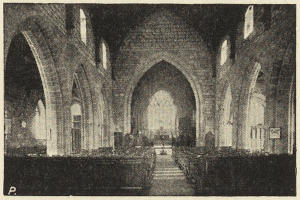
NAVE, LOOKING EAST.
This is the smallest of the Welsh cathedrals, and consists of an aisled nave of five bays, an aisleless transept, a central tower, and a chancel. The chancel was built by Sir G. G. Scott in 1868; the rest between 1284 and 1352. The arcade and clerestory of the nave are exceptional in character. The piers have no capitals; so that the mouldings run uninterruptedly round the arch; they consist simply of chamfers with a wave moulding. These continuous mouldings are not uncommon in late work—e.g., in Antwerp cathedral; but are seldom found in early Gothic, though a thirteenth-century example occurs in the vestibule of Chester chapter house. The clerestory windows are square, but cusped. The central tower is massive and effective. The cathedral is finely situated, on elevated ground, above the beautiful valley of the Clwyd; and may be seen from the London and Holyhead railway. There are good stalls (1471-1495), and an interesting effigy of a bishop (c. 1300).
Far away in the extreme west of Pembrokeshire, sixteen miles from the nearest railway station, Haverfordwest, is one of the most interesting cathedrals in the British Isles. Dedicated to the great patron saint of Wales, it is as complex[306] in plan as Winchester or St. Alban’s, and abounds in lovely detail of the Transitional and Curvilinear periods.
The earliest work belongs to the episcopate of Peter de Leia (1176-1198), and comprises parts of the presbytery, the western walls of the transept, the western piers of the tower, and the whole of the nave except the outer portion of the west front (Sir G. G. Scott), and the south porch and the exterior of the south aisle (1328-1347). Though built quite late in the twelfth century, when Gothic architecture had got good hold in Ripon, Canterbury, and Wells, St. David’s—partly perhaps from its remote situation—is still sternly Romanesque. The pier-arcade is low, the piers massive and squat; their arches are semicircular, as also the windows of the clerestory; there is a profusion of Norman zigzag ornament. On the other hand, pointed arches appear in the triforium, the bases have the water-holding hollow, and there are all sorts of beautiful varieties of Transitional capitals—from the early cushion-capitals, much subdivided, in the pier-arcade of the choir, to the later foliated capitals, of great beauty and diversity of design, which abound in the nave. The triforium and clerestory, formed into a single member by a containing-arch of zigzag, are a charming anticipation of the design of Southwell choir.
Early in the thirteenth century, c. 1220, the central tower collapsed, as at Winchester, Ely, Lincoln, etc. It fell towards the east, and seems to have broken down the arches of the presbytery. The Transitional piers were retained, more or less altered; but new pointed arches were built, and lancet windows were inserted in the new clerestory and east wall. In the aisles may be seen the low shafts of a Norman vault, and the corbels of a higher Lancet vault; it is uncertain whether either was ever executed. To this period belongs the very remarkable shrine of St. David: a very plain structure, designed for use—for very strange uses. Down below in each side are three openings, allowing three sick people at a time to lie beneath. (Perhaps they lay there all night, waiting for the Saint to come and touch them, as was the case in[307] some shrines of Pagan Greece.) On the side next to the aisle are two large and shallow upright openings, and three small circular openings—the latter, perhaps, as in St. Alban’s shrine, to allow the patient to insert a diseased arm. A parallel to the lower openings may be found in the remains of the shrine now inserted under the effigy of Lord Stourton at Salisbury. When the restoration of the choir was completed (c. 1248), the next task seems to have been to build a processional aisle. The eastern walk of this was built fifteen feet east of the eastern wall of the cathedral, thus leaving a little open courtyard between the back of the east wall and the east walk of the new processional aisle. In the east wall there was a lower range of three tall lancets, which gave much light to the high altar beneath them. The authorities may then have left the little open courtyard to preserve the light of these three windows. But at Winchester and elsewhere the lower lights were sacrificed without demur; and the space between the east wall of the presbytery and the processional aisle, instead of being wasted, was utilised as a saint’s chapel or feretory, where—in the most honoured position in the church, close to the high altar—the shrine of the patron saint of the church was placed: shrines of St. Swithun and St. Birinus at Winchester, that of St. Werburgh at Chester, of St. Ethelreda at Ely, of St. Wulfstan at Worcester, of St. Cuthbert at Durham, of St. Chad at Lichfield. Now the shrine of St. David is artistically rude and uncouth, and occupies a by no means specially honourable position. May one conjecture that the original intention was to open arches in the east wall of the presbytery, and to build a new shrine for St. David, placing it above and behind the high altar, where it would be conspicuous to the very farthest end of the nave,—and that Welsh conservatism refused either to have a new shrine or to change the position of the old one? Before commencing the south walk of the processional aisle, the Lady chapel was erected (1290-1328). Its buttresses are late Gothic.
Then came the great building-prelate of St. David’s, Bishop Gower (1328-1347). (1) He completed the processional aisle, building the whole of the south walk and completing the north walk. (2) Like Abbot Thokey, at Gloucester, he transformed the Norman south aisle of the nave into the style of his day (Curvilinear), and built a south porch. (3) East of the north transept he built a three-storied building, the lower part as a chapel to St. Thomas of Canterbury, the upper part as a chapter-house. (4) He raised the tower one stage above the roofs. (5) He raised the walls of the aisles, and inserted Curvilinear windows. (6) He separated the presbytery from the choir, which as at Gloucester is beneath the central tower, by a parclose screen—a very rare feature. (7) He built the wood throne of the bishop; it seems, however, to have been reconstructed in the fifteenth century. (8) He built for himself the magnificent palace, and another at Lamphey, besides Swansea castle and church. (9) His most beautiful work is the magnificent choir-screen, one of the grandest examples of mediæval art. It consists of three compartments of stone, surmounted by a coved cornice of wood. The southern compartment has two pointed arches, with compound cusping and rich crockets; and within, the tomb and effigy of the bishop. The central compartment is occupied by the doorway and vaulted vestibule leading from the nave to the choir; on either side of the vestibule are effigies of priests. The northern compartment seems to consist of thirteenth century arcading, which has been worked up to serve as a reredos to an altar.
To the Perpendicular period belong the stalls, which have good misereres (1460-1480); the elaborate wooden roof of the nave (1472-1509) and that of the presbytery, which is a little earlier.
Early in the Tudor period Bishop Vaughan (1509) added another story to the tower, and built himself a chapel in the empty space between the east wall of the presbytery and the east walk of the processional aisle, vaulting it with fan-tracery.
Externally, the cathedral is simple and plain, in harmony with its bleak and wild surroundings. Internally, like Canterbury and Winchester, it gains dignity from the greater height of the choir. The whole floor of the nave slopes upwards from west to east, and the choir is elevated eight steps above the level of the nave.
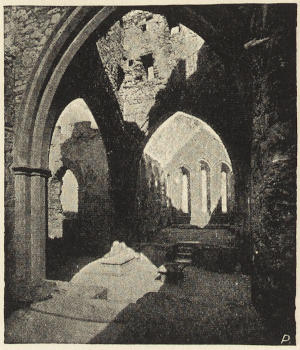
PEEL, ST. GERMAIN, INTERIOR.
Printed by Hazell, Watson & Viney, Ld., London and Aylesbury.
“A short introduction sets out the plan followed in describing the churches. This plan is quite the most valuable feature of the book, the several structures being examined as architectural organisms which were slowly built up during centuries of developing ritual and strenuous constructive effort. We are first given the principal historic facts as to foundation and early history, and are then taken to the vestiges of the earliest church of which any part survives. The constructive evolution is then briefly followed through the centuries—in some cases, one thousand years and more—during which each great church was developed into its state of greatest glory and passed into the era of decline, mutilation, and—worst of all—modern restoration.”—W. R. Lethaby (University Extension Journal).
“A practical, sensible, and well-informed book, beautifully illustrated. Its method is clear, rational, and helpful.”—Bookman.
“It is an easily portable conspectus of the whole subject. Furnished with this we may go over England and Wales and gain a fair working knowledge of all the cathedral churches.”—Spectator.
“He writes with knowledge, clearness, and vivacity, and the result is a fascinating book on a subject which has engrossed many learned but tedious pens.”—The Speaker.
“Should be found helpful and illuminating both to the stay-at-home reader and to those who carry the book with them on pilgrimage to the famous English minsters.”—Scotsman.
“A clear, emphatic, and vigorous statement of the ordinary facts illustrating the architectural history of every building that is at the present day of cathedral rank in England and Wales. It is copiously and usefully illustrated. The style is always direct and forcible, and Mr. Bond steers so carefully clear of fads that his general views can, as a rule, be trusted as well as his particular details.”—Manchester Guardian.
“It is an extremely interesting book about a familiar though still unexhausted subject. The illustrations are many and good.”—Record.
The Library of Useful Stories.
PRICE ONE SHILLING EACH.
THE STORY OF BIRD LIFE. By W. P. Pycraft. With Illustrations.
THE STORY OF THE ALPHABET. By Edward Clodd. With nearly 100 Illustrations.
THE STORY OF LIFE’S MECHANISM. By H. W. Conn. With 50 Illustrations.
THE STORY OF THE WANDERINGS OF ATOMS. By M. M. Pattison Muir, M.A.
THE STORY OF ICE IN THE PRESENT AND PAST. By W. A. Brend. With 37 Illustrations.
THE STORY OF ECLIPSES. By G. F. Chambers, F.R.A.S. With 19 Illustrations.
THE STORY OF THE BRITISH RACE. By John Munro. With 4 Maps.
THE STORY OF THE MIND. By Prof. J. M. Baldwin.
THE STORY OF GEOGRAPHICAL DISCOVERY: How the World Became Known. By Joseph Jacobs. With 24 Maps, etc.
THE STORY OF THE COTTON PLANT. By F. Wilkinson, F.G.S. With 38 Illustrations.
THE STORY OF RELIGIONS. By the Rev. E. D. Price, F.G.S.
THE STORY OF PHOTOGRAPHY. By A. T. Story. With 38 Illustrations.
THE STORY OF LIFE IN THE SEAS. By Sydney J. Hickson, F.R.S. With 42 Illustrations.
THE STORY OF THE BRITISH COINAGE. By G. B. Rawlings. With 108 Illustrations.
THE STORY OF THE POTTER. By C. F. Binns. With 57 Illustrations of Ancient and Modern Pottery.
THE STORY OF GERM LIFE: BACTERIA. By H. W. Conn. With 34 Illustrations.
THE STORY OF THE EARTH’S ATMOSPHERE. By Douglas Archibald. With 44 Illustrations.
THE STORY OF THE WEATHER. By G. F. Chambers, F.R.A.S. With 50 Illustrations.
THE STORY OF FOREST AND STREAM. By James Rodway, F.L.S. With 27 Illustrations.
THE STORY OF THE CHEMICAL ELEMENTS. By M. M. Pattison Muir, M.A.
THE STORY OF EXTINCT CIVILIZATIONS OF THE EAST. By R. E. Anderson, M.A. With Maps.
THE STORY OF ELECTRICITY. By J. Munro. With 100 Illustrations.
THE STORY OF A PIECE OF COAL. By E. A. Martin, F.G.S. With 38 Illustrations.
THE STORY OF THE SOLAR SYSTEM. By G. F. Chambers, F.R.A.S. With 28 Illustrations.
THE STORY OF THE EARTH IN PAST AGES. By H. G. Seeley, F.R.S. With 40 Illustrations.
THE STORY OF THE PLANTS. By Grant Allen. With 49 Illustrations.
THE STORY OF PRIMITIVE MAN. By Edward Clodd. With 88 Illustrations.
THE STORY OF THE STARS. By G. F. Chambers, F.R.A.S. With 24 Illustrations.
London: GEORGE NEWNES, Limited.
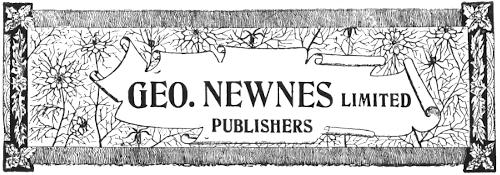
GEO. NEWNES LIMITED
PUBLISHERS
7-12 SOUTHAMPTON STREET,
STRAND, W.C.
Publications of
George Newnes Limited
By HANS CHRISTIAN ANDERSEN.
Fairy Tales.
With upwards of 400 Illustrations. By Helen Stratton. 4to, cloth extra, gilt, 12s.
The Arabian Nights Entertainments.
Demy 4to, with upwards of 500 original Illustrations. Printed on Superfine Art Paper. Price 15s.
By the Rev. WILLIAM ADAMS.
The Shadow of the Cross and the Old Man’s Home.
Two Allegories. With Frontispiece to each Allegory. Cloth gilt, 16mo, 8d.
The King’s Messengers and the Distant Hills.
Two Allegories. With Frontispieces. 16mo, cloth gilt, 8d.
By GRANT ALLEN.
What’s Bred in the Bone.
Crown 8vo, cloth, 3s. 6d.
The Story of the Plants.
With 49 Illustrations. Cloth, 1s.
“A brightly written, clear and accurate summary of the functions and habits of plants.”—Daily Chronicle.
Flashlights on Nature.
With 150 Illustrations by Frederick Enock. Crown 8vo, cloth extra, 6s.
“Charming and romantic scientific facts.”—Review of Reviews.
By R. E. ANDERSON, M.A.
The Story of Extinct Civilizations of the East.
With Maps. Cloth, 1s.
“An admirable compendium of a department of knowledge which has been greatly advanced by the research of recent years.”—Aberdeen Free Press.
By DOUGLAS ARCHIBALD, M.A.
The Story of the Earth’s Atmosphere.
With 44 Illustrations. Cloth, 1s.
“One of the best of the Story series that we have read ... the author is frequently able from his wide travels to illustrate his remarks from his own personal experience in climates where meteorological manifestations can be witnessed on a grander scale than in our own country.”—Nature.
The Art Bible.
Comprising the Text of the Old and New Testaments, printed in entirely new type, specially selected for its[4] clearness and sharpness of outline, and with 850 Illustrations, Maps, &c.
In one volume, 1360 pp. super royal 8vo, handsomely bound in cloth, gilt leaves, 12s.; French morocco, bevelled boards, tooled in gold and blind, gilt leaves, 16s.; plain Persian morocco, gilt leaves, 18s.; Persian morocco, antique scroll in gold, gilt leaves, 21s.; limp morocco, Yapp style, flexible back, solid gold leaves, 30s.; Turkey morocco, hand-tooled in gold, solid gold leaves, 38s.
OLD TESTAMENT, with 660 Illustrations, handsomely bound in cloth, gilt leaves, 9s.
NEW TESTAMENT, with 190 Illustrations, handsomely bound in cloth, gilt leaves, 5s.
By Professor J. M. BALDWIN.
The Story of the Mind.
Cloth, 1s.
“We have seldom read a more thoughtful and suggestive little production. It can be strongly recommended to students of psychology, to the general reader, and to all who take an interest in the study and mental upbringing of the young.”—Lancet.
Edited by J. G. BARTHOLOMEW, F.R.G.S.
The Citizen’s Atlas.
Comprising 100 Maps and Gazetteer. Crown folio, cloth extra, 16s. net; half-morocco, 18s. 6d. net.
The Royal Atlas of England and Wales.
140 Pages of Plates with Topographical Index and Statistics. Crown folio, cloth, 16s. net; half-morocco, 18s. 6d. net.
The Hub Cycling Map of England and Wales.
Printed in colours and folded in pocket case, 6d.; mounted on linen, 1s.
By CONSTANCE BEERBOHM
A Little Book of Plays, for Professional and Amateur Actors.
With 22 Illustrations of Scenes. Paper covers, 1s.
“An excellent collection of short dramatic sketches, suited to the requirements of amateurs.”—Black and White.
By C. F. BINNS.
The Story of the Potter.
An Account of the Rise and Progress of the Principal Manufactures of Pottery and Porcelain. With 57 Illustrations. Cloth, 1s.
“We can recommend the whole volume to all who care to know something of one of the oldest and most universal of human arts.”—Guardian.
By Mrs. BISHOP.
Unbeaten Tracks in Japan.
With Map and 56 Illustrations. New and Revised Edition.
[In course of publication.
By AMY E. BLANCHARD.
Two Girls.
With Illustrations by Ida Waugh. Cloth extra, 3s. 6d.
“A delightful addition to the girl’s bookshelf.”—Gentlewoman.
Photographs by GAMBIER BOLTON, F.Z.S., and others.
All About Animals.
260 Illustrations of Animal Life. With explanatory text. Oblong 4to, cloth extra, gilt leaves, 10s. 6d.
“Not a dry and scientific work, but brightly written and well illustrated. Well illustrated it certainly is. Mr. Gambier Bolton’s photographs of lions, tigers, leopards, and other feline creatures have never been surpassed, and hundreds of such pictures are to follow. It is really a wonderful production.”—Army and Navy Gazette.
By FRANCIS BOND, M.A., F.G.S., Hon. A.R.I.B.A.
English Cathedrals Illustrated.
With 180 Illustrations from Photographs. Crown 8vo, cloth extra, 6s.
“A practical, sensible, and well-informed book, beautifully illustrated. Its method is clear, rational, and helpful.”—Bookman.
By GEO. BORROW.
Lavengro: The Scholar—The Gypsy—The Priest.
Crown 8vo, cloth extra, 2s. 6d.
“A marvel of cheap excellence.”—Weekly Sun.
By W. A. BREND, B.A.
The Story of Ice
In the Present and Past. With 37 Illustrations. Cloth, 1s.
By CHARLOTTE BRONTË.
Shirley.
Crown 8vo, cloth, 1s. 6d.
Jane Eyre.
Crown 8vo, cloth, 1s. 6d.
By FRANCES BURNEY.
Evelina; or, The History of a Young Lady’s Entrance into the World.
With 16 Full-page Illustrations by Arthur Rackham. Crown 8vo, cloth extra, 2s. 6d.
The Captain.
A Magazine for Boys and “Old Boys.” Vol. I. Profusely Illustrated. Cloth extra, gilt, 6s.
The Century Book of Gardening.
A Comprehensive Work for every lover of the Garden.
[Now in course of publication.
Celebrities of the Stage.
A Series of Coloured Portraits of celebrated Actors and Actresses.
[Now in course of publication.
By PAUL DU CHAILLU.
The Land of the Midnight Sun.
With all the original Illustrations, and some additions. Super royal 8vo. Handsomely bound in cloth, with gilt edges. Price 10s. 6d.
By G. F. CHAMBERS, F.R.A.S., Author of “Handbook of Descriptive and Practical Astronomy,” &c.
The Story of the Stars.
With 24 Illustrations. Cloth, 1s.
“Beginners in astronomy who wish to acquaint themselves merely with the outlines of a noble science will find this volume of real service.”—Speaker.
“Told in a pleasing and attractive manner.”—Athenæum.
The Story of the Solar System.
With 28 Illustrations. Cloth, 1s.
“His descriptions possess the double quality of simplicity and attractiveness.”—Nature.
The Story of Eclipses.
With 19 Illustrations. Cloth, 1s.
The Story of the Weather.
With 50 Illustrations. Cloth, 1s.
“An interesting volume about weather, and especially English weather, and presents facts, ideas, and suggestions which ordinary people will be glad to know.”—St. James’s Budget.
By EDWARD CLODD, Author of “The Story of Creation,” &c.
The Story of Primitive Man.
With 88 Illustrations. Cloth, 1s.
“Well printed, well bound, profusely illustrated, and in every respect capital material, on one of the most progressive of sciences.”—Daily Chronicle.
“Confound that Boy!”
A Manual of Book-keeping and Office Routine. Crown 8vo, cloth, 1s.
By H. W. CONN.
The Story of Germ Life: Bacteria.
With 34 Illustrations. Cloth, 1s.
“Though a popular work, the Story of Germ Life, as told by Prof. H. W. Conn, is so admirable for its lucidity, terseness, and the author’s grasp of the subject, that it may be recommended to any one who is desirous of becoming acquainted with the general features of bacterial life and the baneful and beneficial results of microbic growth and development.”—Journal of Royal Microscopical Society.
The Story of Life’s Mechanism.
With 50 Illustrations. Cloth, 1s.
By FENIMORE COOPER.
The Last of the Mohicans.
Crown 8vo, cloth, 1s. 6d.
Country Life Illustrated.
The Journal for all interested in Country Life and Country Pursuits. Profusely Illustrated. Vol. 5, folio cloth, gilt leaves, 21s. each; half morocco, 25s. each.
[Vols. 1, 2, 3, and 4 are out of print.
By ROBERT CROMIE, Author of “The Crack of Doom,” &c.
The King’s Oak, and Other Stories.
Sewed, 1s. Cloth, 2s.
“A capital collection of short stories.”—Black and White.
The Lost Liner.
Crown 8vo, cloth, 3s. 6d.
By the Hon. ROBERT CURZON, Jun. (Baron de la Zouche).
Visits to Monasteries of the Levant.
With Sketch Maps and Illustrations. Crown 8vo, cloth extra, 2s. 6d.
“One of those fascinating books of travel which have taken a place in permanent literature.”—Times.
By WORDSWORTH DONISTHORPE.
Down the Stream of Civilization.
With 104 Illustrations from Photographs. Crown 8vo, cloth extra, 6s.
By A. CONAN DOYLE.
Adventures of Sherlock Holmes.
With 25 Illustrations by Sidney Paget. Crown 8vo, cloth, 3s. 6d. Also a cheap edition, 6d.
Memoirs of Sherlock Holmes.
With Illustrations by Sidney Paget. Crown 8vo, cloth, 3s. 6d. Also a cheap edition, 6d.
The Sign of Four.
An Earlier Adventure of Sherlock Holmes. Crown 8vo, cloth, 3s. 6d. Also a cheap edition, 6d.
“For those to whom the good, honest, breathless detective story is dear, Dr. Doyle’s books will prove a veritable godsend.”—Athenæum.
The Exploits of Brigadier Gerard.
With 24 Illustrations by W. B. Wollen. Crown 8vo, cloth, 3s. 6d. Also a cheap edition, 6d.
“In these days of pessimistic problem novels, when the element of romance seems to be fading out of fiction, it is delightful to come upon these tales and glories of a soldier’s life. They are buoyant, vital, steeped in the stir and freshness of the open air, abounding in tragedy and gaiety.... It is a fascinating book, and one to be read.”—Daily News.
By Mrs. EGERTON EASTWICK (Pleydell North).
The Rubies of Rajmar; or, Mr. Charlecote’s Daughters.
A Romance. Cloth, 3s. 6d.
“Throughout the plot is well conceived, its treatment is terse and vigorous, and the series of exciting incidents by which the dénouement is reached form a narrative well worth reading.”—W. Le Queux. The Literary World.
Edited by C. B. FRY.
The Book of Cricket.
A Gallery of Famous Players. 256 pages, crown folio, cloth gilt, 12s. 6d. net.
By W. C. GANNETT.
A Year of Miracle.
A Poem in Four Sermons. With 4 Illustrations. 16mo, cloth, 8d.
By Mrs. GASKELL.
North and South.
Crown 8vo, cloth extra, 2s. 6d.
“Capital edition of a charming story.”—Manchester Courier.
By Mrs. ALFRED GATTY.
Parables from Nature.
Illustrated. 16mo, cloth, 8d.
By W. E. GLADSTONE.
The Impregnable Rock of Holy Scripture.
A Series of Old Testament Studies. 6d.
By E. J. GOODMAN.
New Ground in Norway.
Ringerike—Telemarken—Sætersdalen. With numerous Illustrations. Demy 8vo, cloth extra, 10s. 6d.
“Full of information as to the less frequented parts of Southern Norway.... Well printed and capitally illustrated.”—Pall Mall Gazette.
By MAXWELL GRAY.
The Silence of Dean Maitland.
A Novel. 6d.
By Mrs. GOODWIN GREEN.
Raiders and Rebels in South Africa.
With 14 Full-page Illustrations by the Author. Crown 8vo, cloth extra, 5s.
By Major ARTHUR GRIFFITHS.
Wellington and Waterloo.
With an Introduction by Field-Marshal Viscount Wolseley. Profusely Illustrated. Demy 4to, cloth extra, 10s. 6d.
“Pen and camera have worked well together in this handsome quarto volume.”—Daily News.
By H. RIDER HAGGARD.
Jess: A Story of the Transvaal War of 1880-1.
6d.
She: A History of Adventure.
6d.
By BEATRICE HARRADEN.
Ships that Pass in the Night.
6d.
By HENRY HERMANN.
Hearts of Gold and Hearts of Steel.
Cloth, 3s. 6d.
By SYDNEY J. HICKSON, D.Sc., F.R.S., Professor of Zoology In the Owens College, Manchester.
The Story of Life in the Seas.
42 Illustrations. Cloth, 1s.
“Such books as these lay the reader under a deep obligation to writers of Dr. Hickson’s eminence in the scientific world.”—Spectator.
By G. LACY HILLIER.
Wrinkles for Cyclists.
Small crown 8vo, 1s.
Edited by EDWIN HODDER.
The Life of a Century, 1800-1900.
With numerous Illustrations.
[Now in course of publication.
The Home Magazine.
Vols. 2 and 3, cloth, 5s. each.
[Vol. 1 is out of print.
By Mrs. HORSFALL.
Pretty Homes.
With 60 Illustrations. 8vo, cloth, 3s. 6d.
By N. L. JACKSON.
Association Football.
With 20 Illustrations. Crown 8vo, cloth, 6s.
By JOSEPH JACOBS.
The Story of Geographical Discovery.
With 24 Maps, &c. Cloth, 1s.
“A very readable little book.... The author has collected his material with discrimination, and has evidently devoted much time and care to the preparation of this inspiring little volume. The recent marked development of imperial instincts should insure the book the popularity it merits.”—Nature.
By Mrs. JAMESON.
Shakspeare’s Heroines: Characteristics of Women—Moral, Poetical, and Historical.
Crown 8vo, cloth extra, 2s. 6d.
“The most charming of all the works of a charming writer.”—Blackwood’s Magazine.
By JOHN KEBLE.
The Christian Year.
Thoughts in Verse for the Sundays and Holy Days throughout the Year. Crown 8vo, cloth extra, 2s. 6d.
By A. W. KINGLAKE.
Eothen.
With 40 Illustrations by H. R. Millar. Crown 8vo, cloth extra, 2s. 6d.
By RUDYARD KIPLING.
Departmental Ditties, and Other Verses.
Crown 8vo, cloth extra, 6s.; also a cheap edition, 6d.
By JOHN K. LEYS.
At the Sign of the Golden Horn.
Crown 8vo, cloth, 3s. 6d.
By FRANCES H. LOW.
Queen Victoria’s Dolls.
With 40 Full-page Coloured Illustrations and numerous Sketches and Initial Letters by Alan Wright. Cheap Edition, crown 4to, 5s.
“No one who has not perused this entertaining record can in reality appreciate the diligent, alert child-life of Britain’s truest gentlewoman. The full-page coloured illustration, showing the dolls in their gorgeous costumes and wooden attitudes, are almost as naïve as they are excellent.”—The Gentlewoman.
By CHARLES J. MANSFORD.
Shafts from an Eastern Quiver.
With 25 Illustrations by Alfred Pearse. Cloth, 3s. 6d.
“Mr. Mansford has the gift of a story-teller, and he uniformly writes like a scholar.... The illustrations, though small, are admirably executed, and enhance the piquancy—though that was hardly needed—of the letterpress.”—Spectator.”
By Captain MARRYAT.
Mr. Midshipman Easy.
Crown 8vo, cloth, 1s. 6d.
By E. A. MARTIN.
The Story of a Piece of Coal.
With 38 Illustrations. Cloth, 1s.
“Explains in simple and delightful fashion what coal is, whence it comes, and whither it goes, and in the concluding chapters shows how intimately it is connected with the interests of the botanist, the geologist, the physicist, the chemist, and the merchant.”—Bradford Observer.
By L. T. MEADE & CLIFFORD HALIFAX, M.D.
Stories from the Diary of a Doctor.
With 24 Illustrations by A. Pearse. Cloth extra, 6s.
“Cleverly-planned and brightly-told stories.”—Bradford Observer.
“They are well told and salient in every feature.”—Leeds Mercury.
By GEORGE MEREDITH.
The Ordeal of Richard Feverel.
6d.
Edited by HUGH ROBERT MILL, D.Sc., F.R.S.E.
The International Geography.
By Seventy Authors. With 488 Illustrations. Demy 8vo, cloth, 15s.
“Interest is maintained throughout the text-book before us, and the work may be taken as the only adequate exposition in English of the principles of the new Geography and their application to the facts which are embraced in the subject. Until a better enters the field this ‘International Geography’ must remain the standard text-book of the subject in our language.”—Times.
By MIRANDA.
Aids to Health and Beauty.
A Complete Toilet Guide. Second Edition. Long 8vo, 1s.
By the Rev. EDWARD MONRO.
The Combatants.
An Allegory. With Frontispiece. 16mo, cloth, 8d.
By H. S. MORRISON.
A Yankee Boy’s Success.
Being an Account of how an American Lad worked his way through Europe. With Seven Illustrations, and an Introduction by Chauncey M. Depew. 6d.
By J. E. MUDDOCK.
For God and the Czar.
A Story of Jewish Persecutions in Russia. Cloth, 3s. 6d.
Only a Woman’s Heart.
The Story of a Woman’s Love: A Woman’s Sorrow. Cloth, 3s. 6d.
“Has an air of heartiness about it, and its plot is well worked out.”—Academy.
By M. M. PATTISON MUIR, M.A.
The Story of the Chemical Elements.
Cloth, 1s.
“One of the most perfect popular introductions to science extant.”—British Medical Journal.
The Story of the Wanderings of Atoms.
Organic Chemistry. Cloth, 1s.
By Miss MULOCK.
John Halifax, Gentleman.
Crown 8vo, cloth, 1s. 6d.
By J. MUNRO.
The Story of Electricity.
With 100 Illustrations. Cloth, 1s.
“Just the kind of book to give the general reader more correct views of the subject than many a pretentious tome.”—The Electrical Engineer.
The Story of the British Race.
With 4 Maps. Cloth, 1s.
“The first attempt to bring the important results and views of anthropologists before the general public in familiar language, and to a certain extent it is a correction of the traditions.... If the author seems to put the claims of anthropology too high, he has written a book that ought to stimulate inquiry and will guide the uninitiated to the lines on which anthropological research is being pursued.”—Aberdeen Free Press.
By Dr. NANSEN and Lieut. JOHANSEN.
Farthest North.
Being the Record of a Voyage of Exploration of the ship Fram, 1893-96, and of a Fifteen Months’ Sledge Journey. Popular edition. In 2 vols., royal 8vo. With about 120 full-page and 90 text Illustrations. Coloured Plate and Map, cloth extra, 17s.
“The narrative of one of the most remarkable and adventurous voyages of discovery that have been made.”—Scotsman.
“A masterpiece of story-telling.”—Times.
The Navy and Army Illustrated.
Vols. 2 to 5, bound in cloth extra, gilt leaves, 12s. each.
Vols. 6, 7 and 8, 18s. each.
[Vols. 1, 4 and 6 are out of print.
By EDWIN A. PRATT.
Pioneer Women in Victoria’s Reign.
Being Short Histories of Great Movements. Crown 8vo, cloth, 5s.; paper covers, 1s.
“His chapters on Women’s Work in Emigration and in Medicine are admirable.”—Pall Mall Gazette.
A Woman’s Work for Women.
Being an Account of the Philanthropic Work of Miss L. M. Hubbard. Small crown 8vo, cloth, 2s. 6d.
By E. D. PRICE, F.G.S.
The British Empire Dictionary of the English Language.
To which are added selected lists of proper names, with phonetic pronunciation, and abbreviations in common use with their meanings. Crown 8vo, cloth extra, 3s. 6d.
The Story of Religions.
Cloth, 1s.
“The author’s brief summaries of the different creeds are excellent. We have tried to find any sect not mentioned in the book, and have failed. This is the highest tribute we can pay to its completeness.”—Irish Church Times.
By G. B. RAWLINGS.
The Story of British Coinage.
With 108 Illustrations from Coins in the British Museum. Cloth, 1s.
“An excellent little handbook of a subject which should have an attraction for many Englishmen, even though they are not very ardent students of numismatics in general.”—Times.
By JAMES RODWAY, F.L.S.
The Story of Forest and Stream.
With 27 Illustrations. Cloth, 1s.
“Contains a short description of a tropical forest, together with some elementary lessons which can be learned by studying the incessant struggle for existence of its varied flora.”—Academy.
By LOUIS DE ROUGEMONT.
Adventures of Louis de Rougemont, as told by Himself.
With 46 Illustrations. Crown 8vo, cloth extra, 6s.
Round the Coast.
An Album of 284 Pictures from Recent Photographs of the Watering Places and Resorts in the United Kingdom, with descriptive text. Oblong 4to, cloth extra, gilt leaves, 10s. 6d.
“We know nothing at anything like the price that can be compared with these for giving to the sedentary traveller veracious glimpses of what the world or his own seashores contains that is interesting and picturesque.”—Times.
Round London.
An Album of 284 Pictures from Photographs of the Chief Places of Interest in and around London, with descriptive text. Oblong 4to, cloth extra, gilt, 10s. 6d.
“The illustrations are taken from photographs, of the most notable and characteristic of the metropolitan sights. Few quarters of London or aspects of London life are neglected; its business and its pleasures, its architecture and its street traffic receive illustration in all their phases. The photographs have been admirably reproduced.”—Scotsman.
Round the World, from London Bridge to Charing Cross, via Yokohama and Chicago.
An Album of 284 Pictures from Photographs of the Chief Places of Interest in all Parts of the World, with descriptive text. Oblong 4to, cloth extra, gilt leaves, 10s. 6d.
“We are taken through all the principal cities and picturesque and historic places from Calais to Brindisi, we mentally travel up the Nile, we go through all the great commercial and historic scenes in India, Malaysia, China, and Japan before crossing to the American Continent; we are given views of the forests, rivers, and mountains of the New World, the cities that are dotted over its bosom, and all the sights from the Falls of Niagara down to the silver mountain of Potosi and the streets of Buenos Ayres.”—The Stock Exchange.
By H. G. SEELEY, F.R.S.
The Story of the Earth in Past Ages.
With 40 Illustrations. Cloth, 1s.
“A simple and popular summing up of the results that have been reached by geological science.”—Scotsman.
“Told plainly and pleasantly for a popular audience.”—Bookman.
By GEORGE R. SIMS.
Memoirs of a Mother-in-Law.
Cloth, 2s. 6d.
“This is a pleasant sample of ‘Dagonet’s’ semi-humorous writings. He has a peculiar talent of finding amusement in experiences relating to dwellings, servants, shopkeepers, tradespeople, and other folk connected with the domestic household, and the ‘Mother-in-Law’ in his new book deals in a very masterful way with all the foregoing subjects, and many more besides.”—Freeman’s Journal.
The Stratford-on-Avon Shakespeare.
The Works of William Shakespeare.
With Glossarial Side-notes. Complete in 12 vols., cloth extra, with cut edges, 12s., or limp lambskin, 18s. net.
“We can unhesitatingly say that the Newnes edition is quite the most handy and readable edition which we have as yet seen—and the number of editions with which we are acquainted is legion. A wise discretion has been exercised as to the size of the volume, which is not too small—as is the case with many existing ‘pocket’ editions—whilst the semi-antique ‘laid’ paper, and the absolutely perfect typography, reflect great credit both on the firm which initiated the work and on the printers who produced it. It is not encumbered with notes, but all needful glossarial explanations are ingeniously embedded in small type in the text.”—Broad Arrow.
By JOHN SKEAPING.
Light, Shade, and Shadow.
With Model Drawing. With 155 Illustrations. Cloth, 3s. 6d.
It is the object of this book to give students an immediate acquaintance with the principles of Light, Shade, and Shadow, by explanation, analysis, and illustration. By this process of analysis and demonstration the knowledge gained is confirmed and enlarged, and permanently established, so that the student may, in any branch of the art, apply the principles with equal success, from the least even to the greatest.
By Sir H. M. STANLEY.
Through the Dark Continent.
With a New Introduction by the Author, and all the Original Illustrations and a Map. In 2 vols. Super royal 8vo, cloth, gilt edges, 15s.
By HERBERT GREENHOUGH SMITH.
The Romance of History.
292 pp., crown 8vo, cloth, 3s. 6d.
“Pre-eminently interesting, bright, clear and attractive.”—Daily Chronicle.
By A. T. STORY.
The Story of Photography.
With Illustrations. Cloth, 1s.
“Mr. Story does not profess to give instructions in the art: but his history of its progress, his description of the various forms of apparatus and the various processes, and his statements of the relation between photography and the finer arts cannot but impart an intelligent interest in this versatile handmaiden of science.”—Scotsman.
The Strand Magazine.
An Illustrated Magazine. Vols. 14 to 18, cloth extra, gilt leaves, 6s. 6d. each. [Vols. 1 to 13 are out of print.]
By CARLTON STRANGE.
The Beechcourt Mystery.
Cloth, 3s. 6d.
“A novel and well-constructed plot.”—Liverpool Courier.
Edited by A. G. TEMPLE, F.S.A.
England’s History, as Pictured by Famous Painters.
An Album of 256 Historical Pictures, with descriptive text. Oblong 4to, cloth extra, gilt leaves, 10s. 6d.
“Notable scenes in our history as realised by artists of good standing.”—Birmingham Daily Post.
By W. M. THACKERAY.
Christmas Books.
Mrs. Perkins’s Ball, Our Street, Dr. Birch and his Young Friends, Rebecca and Rowena, The Kickleburys on the Rhine, The Rose and the Ring. In 1 vol. Crown 8vo, cloth extra, 2s.. 6d.
“Another welcome reprint.”—Morning Post.
The Thames Illustrated: A Picturesque Journeying from Richmond to Oxford.
164 Large and 170 Small Photographic Plates, with descriptive text, 4to, cloth extra, gilt leaves, 10s. 6d.
“ ... A marvel at the price. The illustrations are very numerous and exceedingly beautiful, every picturesque nook and cranny having been sought out, and no such charming souvenir of the Thames or incitement to enjoy its beauties is in existence.”—Army and Navy Gazette.
By Mrs. HUMPHRY WARD.
Robert Elsmere.
6d.
The History of David Grieve.
6d.
Wide World Magazine.
Vols. 1, 2 and 3, cloth extra, gilt leaves, 6s. 6d. each.
By MARY SPENCER-WARREN.
The Princess of Wales: A Biographical Sketch.
With Portraits of the Princess at various periods, and Illustrations from Photographs taken in Denmark, and at[26] Sandringham, Marlborough House, &c. With 53 Portraits and Illustrations. Crown 8vo, cloth extra, 5s.
“An excellent biography ... narrated with admirable simplicity and lucidity.”—Westminster Review.
By H. W. WEGUELIN, F.R.H.S.
Carnations and Picotees for Garden and Exhibition.
With a Chapter concerning Pinks. Crown 8vo.
By F. WILKINSON, F.G.S.
The Story of the Cotton Plant.
With 38 Illustrations. Cloth, 1s.
“All that is known of the origin of the cotton plant, of its cultivation and plantation life, of the pests that infest it, and the countries where it is reared.... The survey is wide and complete, and the story evolved therefrom is throughout most interesting.”—North British Advertiser.
THE LIBRARY OF USEFUL STORIES.
PRICE ONE SHILLING EACH.
The Story of Life’s Mechanism. By H. W. Conn. With 50 Illustrations.
The Story of the Wanderings of Atoms. By M. M. Pattison Muir, M.A.
The Story of Ice in the Present and Past. By W. A. Brend. With 37 Illustrations.
The Story of Eclipses. By G. F. Chambers, F.R.A.S. With 19 Illustrations.
The Story of the British Race. By John Munro. With 4 Maps.
The Story of the Mind. By Prof. J. M. Baldwin.
The Story of Geographical Discovery: How the World Became Known. By Joseph Jacobs. With 24 Maps, &c.
The Story of the Cotton Plant. By F. Wilkinson, F.G.S. With 38 Illustrations.
The Story of Religions. By the Rev. E. D. Price, F.G.S.
The Story of Photography. By A. T. Story. With 38 Illustrations.
The Story of Life in the Seas. By Sydney J. Hickson, F.R.S. With 42 Illustrations.
The Story of the British Coinage. By G. B. Rawlings. With 108 Illustrations.
The Story of the Potter. By C. F. Binns. With 57 Illustrations of Ancient and Modern Pottery.
The Story of Germ Life: Bacteria. By H. W. Conn. With 34 Illustrations.
The Story of the Earth’s Atmosphere. By Douglas Archibald. With 44 Illustrations.
The Story of the Weather. By G. F. Chambers, F.R.A.S. With 50 Illustrations.
The Story of Forest and Stream. By James Rodway, F.L.S. With 27 Illustrations.
The Story of the Chemical Elements. By M. M. Pattison Muir, M.A.
The Story of Extinct Civilizations of the East. By R. E. Anderson, M.A. With Maps.
The Story of Electricity. By J. Munro. With 100 Illustrations.
The Story of a Piece of Coal. By E. A. Martin, F.G.S. With 38 Illustrations.
The Story of the Solar System. By G. F. Chambers, F.R.A.S. With 28 Illustrations.
The Story of the Earth in Past Ages. By H. G. Seeley, F.R.S. With 40 Illustrations.
The Story of the Plants. By Grant Allen. With 49 Illustrations.
The Story of Primitive Man. By Edward Clodd. With 88 Illustrations.
The Story of the Stars. By G. F. Chambers, F.R.A.S. With 24 Illustrations.
⁂ Other Volumes in the Press.
THE SIXPENNY SERIES OF COPYRIGHT BOOKS.
By RUDYARD KIPLING.
Departmental Ditties, and other Verses.
BY H. RIDER HAGGARD.
She. A History of Adventure.
Jess. A Story of the Transvaal.
By Mrs. HUMPHRY WARD.
Robert Elsmere.
The History of David Grieve.
By A. CONAN DOYLE.
Adventures of Sherlock Holmes.
Memoirs of Sherlock Holmes.
The Sign of Four.
The Exploits of Brigadier Gerard.
By BEATRICE HARRADEN.
Ships that Pass in the Night.
By MAXWELL GRAY.
The Silence of Dean Maitland.
By GEORGE MEREDITH.
The Ordeal of Richard Feverel.
With an Introduction by CHAUNCEY M. DEPEW.
A Yankee Boy’s Success. Being an Account of how an American Lad worked his way through Europe. By H. S. Morrison. With Seven Illustrations.
By the Late W. E. GLADSTONE.
The Impregnable Rock of Holy Scripture. A Series of Old Testament Studies.
ADOPTED BY THE SCHOOL BOARD FOR LONDON
Tit-Bits Copy Books. In Fifteen Books, containing 24 pages. Price 2d. each.
A New Series of Copy Books designed to produce a clear, bold, and rapid writing. There are no flourishes or fanciful peculiarities. The style is simple, uniform, and entirely without exaggerations. The slope is 15° from the vertical. There are at least two headlines on every page, so that the risk of the scholar copying his own writings is reduced to a minimum.
Great care has been taken in the preparation and arrangement of the headlines. In the earlier books the elements and combinations of letters have been carefully graded. In the higher books the headlines are “Tit-Bits” from the Code Subjects: Interesting Facts; Memorable Dates; Useful Information. The interest in what is being copied will thus be kept alive, and the style of writing will consequently be improved.
The Golden Rule Readers: Manners and Morals.
Illustrating and enforcing by means of Proverbs, Maxims, Stories, Examples and Poems, the necessity for habits of punctuality, of good manners and language, the importance of cheerful obedience to duty, of consideration and respect for others, and of honour and truthfulness in word and act, the relation of conduct, thrift, temperance, &c., to success in life.
In Two Books for Standards III. to VI. Book I., 1s. 3d. Book II., 1s. 6d.
Flashlights on Nature. By Grant Allen. With 150 Illustrations by Frederick Enock. Crown 8vo, cloth extra, 6s.
England’s History, as Pictured by Famous Painters. Edited by A. G. Temple, F.S.A. Oblong 4to, cloth extra, gilt leaves, 10s. 6d.
Round the World, from London Bridge to Charing Cross, via Yokohama and Chicago. Oblong 4to, cloth extra, gilt leaves, 10s. 6d.
Round the Coast. Oblong 4to, cloth extra, gilt leaves, 10s. 6d.
Round London. Oblong 4to, cloth extra, gilt leaves, 10s. 6d.
All About Animals. 260 Illustrations from Photographs by Gambier Bolton, F.Z.S., and others, with explanatory letterpress. Cloth extra, gilt leaves, 10s. 6d.
THE
STRAND MAGAZINE.
Announcements for 1900.
TWO
GREAT
HUMORISTS!
If you
want to
LAUGH
as well
as to be
interested
and
instructed
read the
STRAND
MAGAZINE
during
1900.
Several important arrangements have been made for the coming year, especially in the Department of Fiction.
MR. W. W. JACOBS, whose “Master of Craft” has provided so much genuine amusement, will follow up his serial with a series of short stories written in his most entertaining style. We are happy to be able to state that we have acquired the entire serial rights in all the fiction which Mr. Jacobs may produce during the next three years.
MR. F. ANSTEY, the well-known author of “Vice-Versâ,” &c., will commence in the January Number a Serial entitled “A Brass Bottle”—a story of the most delightful and fantastic humour.
MR. H. G. WELLS has written one of his most characteristic serial stories under the title of “The First Men in the Moon.” The wonderful machine which carried the voyagers to the moon, together with description of the planet and its inhabitants, form one of the most absorbing stories which its ingenious writer has produced.
DR. CONAN DOYLE will also appear as a humorist. He has written for the January Number a “Last Adventure of Brigadier Gerard,” in which the Brigadier appears, in a vastly entertaining manner, in the character of a fox-hunter.
Numerous Articles of the greatest interest have been specially arranged for.
A Field to Itself.
No Fiction but
True Personal Narratives.
Photos of the Characters.
Unique Articles.
Strange Phases of Life
In all parts of the World.
Astounding Photographs.
Thrilling Adventures.
Has Friends in Every Clime.
You must see a Copy.
Government Officials,
Missionaries and Traders,
Naval and Military Officers,
Travellers on Business and Pleasure,
All Contribute.
Narratives and Photos.
Many Magazines But
Only One
WIDE WORLD.
Published on the 22nd of each month.
6d. Price Sixpence. 6d.
The peculiar and absolutely distinctive character of “The Wide World Magazine” is well known to hundreds of thousands on both sides of the Atlantic.
No monthly magazine ever bounded into widespread popularity—and such popularity!—in anything approaching the time. This is the best test of excellence in these discriminating and fastidious days.
You are requested to examine a copy and then compare “The Wide World” with all other magazines published in point of SHEER HUMAN INTEREST.
“The Wide World” shows you that “Truth is Stranger than Fiction.”
You don’t read Magazines?
Then you are certain to like “The Wide World.”
The Only Magazine of its kind in the world. More fascinating than a novel.
More informing than a Text-book.
Remember the 22nd of the Month.
6d. THE WIDE WORLD MAGAZINE. 6d.

“THE KING.”
In news photographs, THE KING will be found ahead of its contemporaries. Nothing of importance will happen during the week which will not be fully and strikingly illustrated in its pages—often many days in advance of other sixpenny weeklies. In war, its photographers and correspondents will always be found at the front, and no expense will be spared by THE KING to provide its readers with the earliest obtainable photographs of the actual fighting—not fancy drawings, but real photographs.
Not a man or a woman will spring into note who will not be pictured and written about in THE KING. It will be live, interesting matter, full of anecdote, crisp and newsy, specially prepared by gossipy and able writers. The pages of personal gossip in THE KING will, in short, be a complete guide to men and women of note throughout the year, not only fascinating but reliable, and the attractive way in which the matter is being prepared will appeal to everybody on account of its novelty.
One of the great features of THE KING will be a striking department called “The King’s Jester,” in which will be found funny drawings on all sorts of funny subjects by the funniest artists of the day. In it the best work of English, American, and Continental draughtsmen will be represented, at an expense never before undergone by any illustrated paper. Yet “The King’s Jester” is but one department of many in this enterprising paper. It is a “Punch” or a “Pick-Me-Up” thrown in gratis for the amusement of our readers.
In fact, THE KING will be found a paper of to-day for the people of to-day. Photographs of current events, smartly published while people are talking of them—photos, and gossip about people in the public eye—stories and articles on new and interesting subjects—and pictures that people want to look at crowded between its two covers. It is the most remarkable sixpenny weekly ever offered to the public, and no money will be spared in the attempt to make it the most graphic, briefest, and most attractive compendium of the world’s doings, week by week.
“THE KING”
Will be Published on or about Nov. 23, by
GEORGE NEWNES LTD.,
7-12 Southampton Street, Strand, W.C., London.